






TRAVEL LIFESTYLE GASTRONOMY ARCHITECTURE DESIGN SPORT
FALL 4/2016
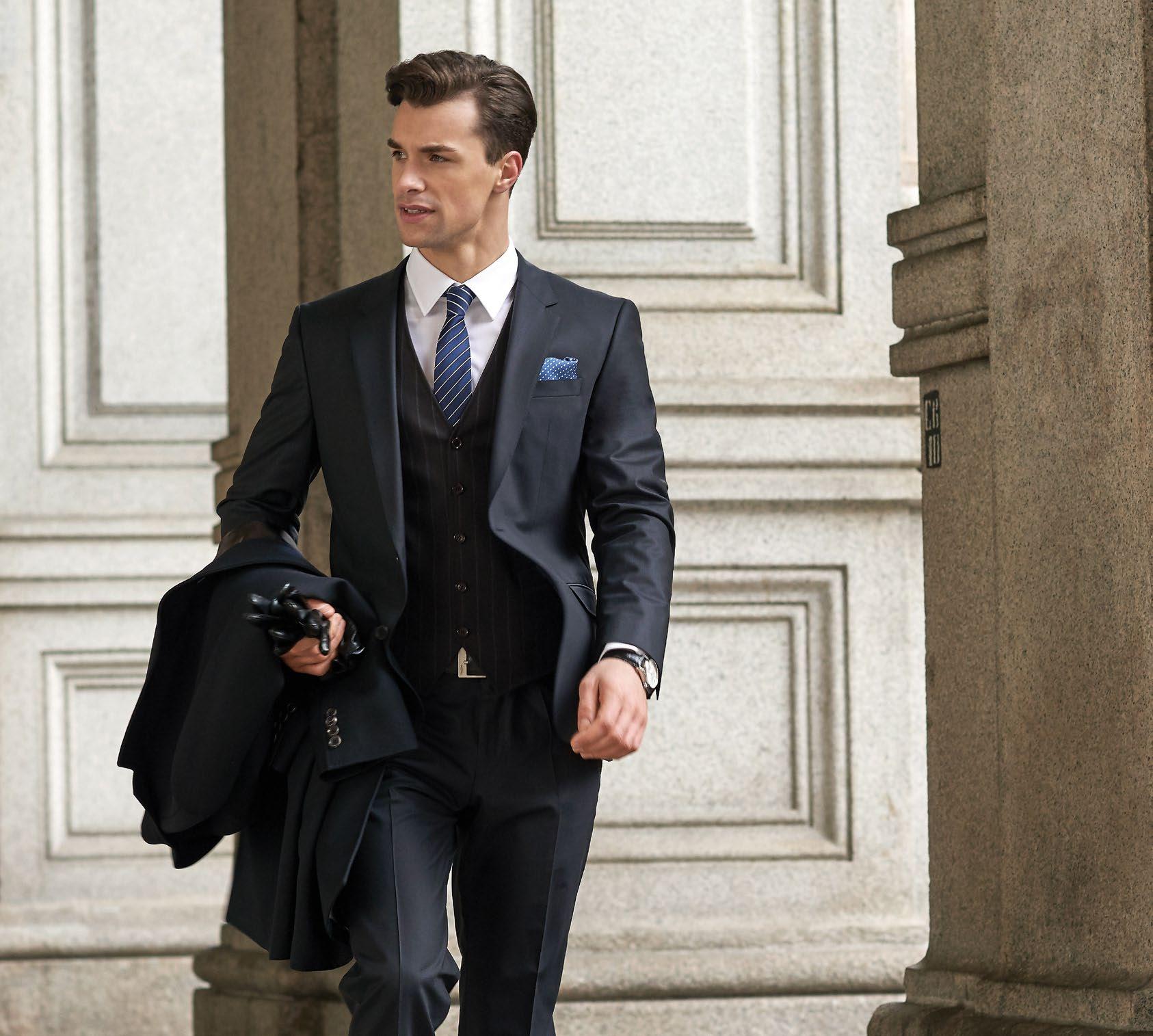




smartwatch.frederique-constant.com LINKED TO MOTION The beautiful Swiss watch is now smart and connected, powered by MotionX® .
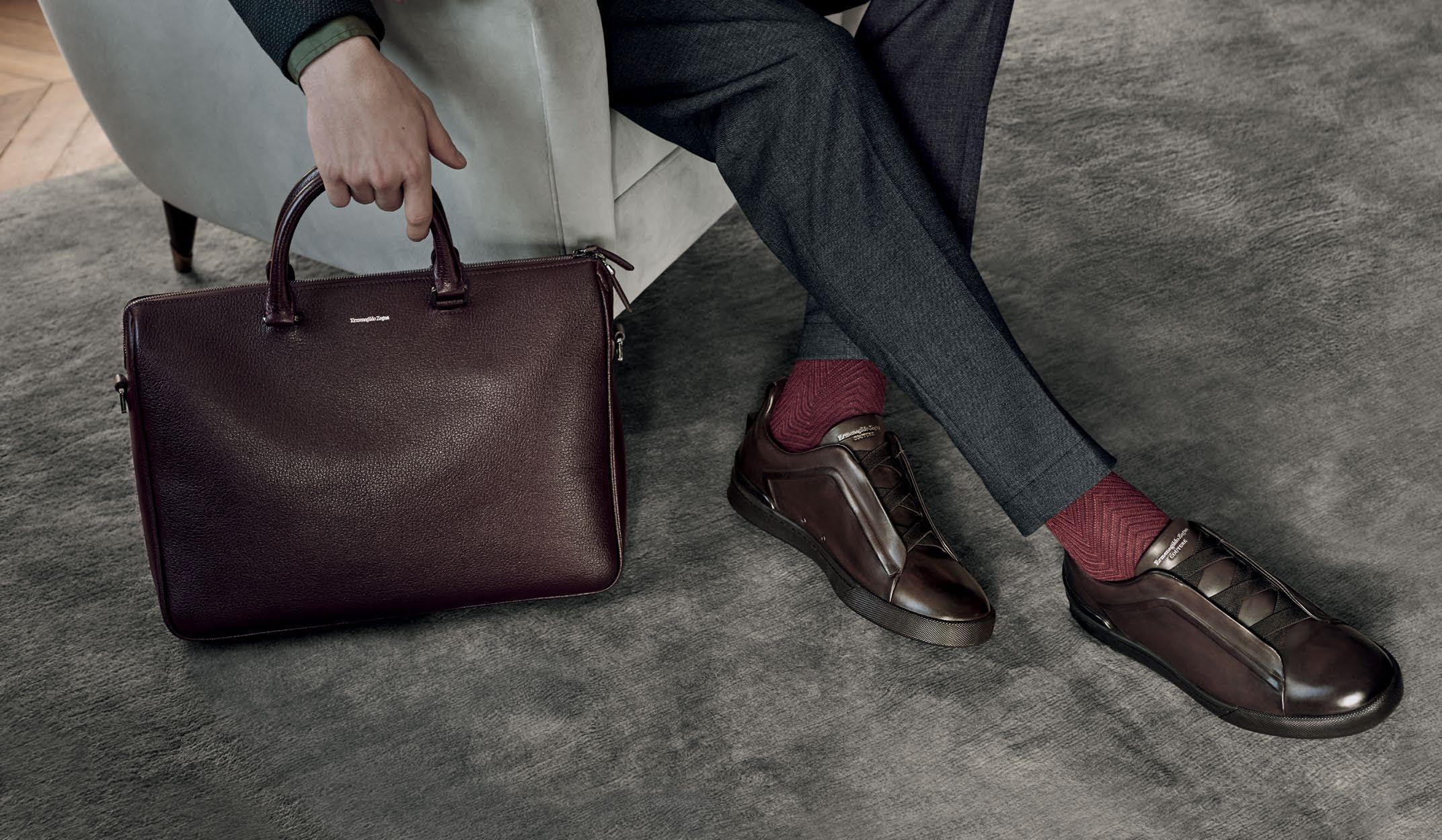

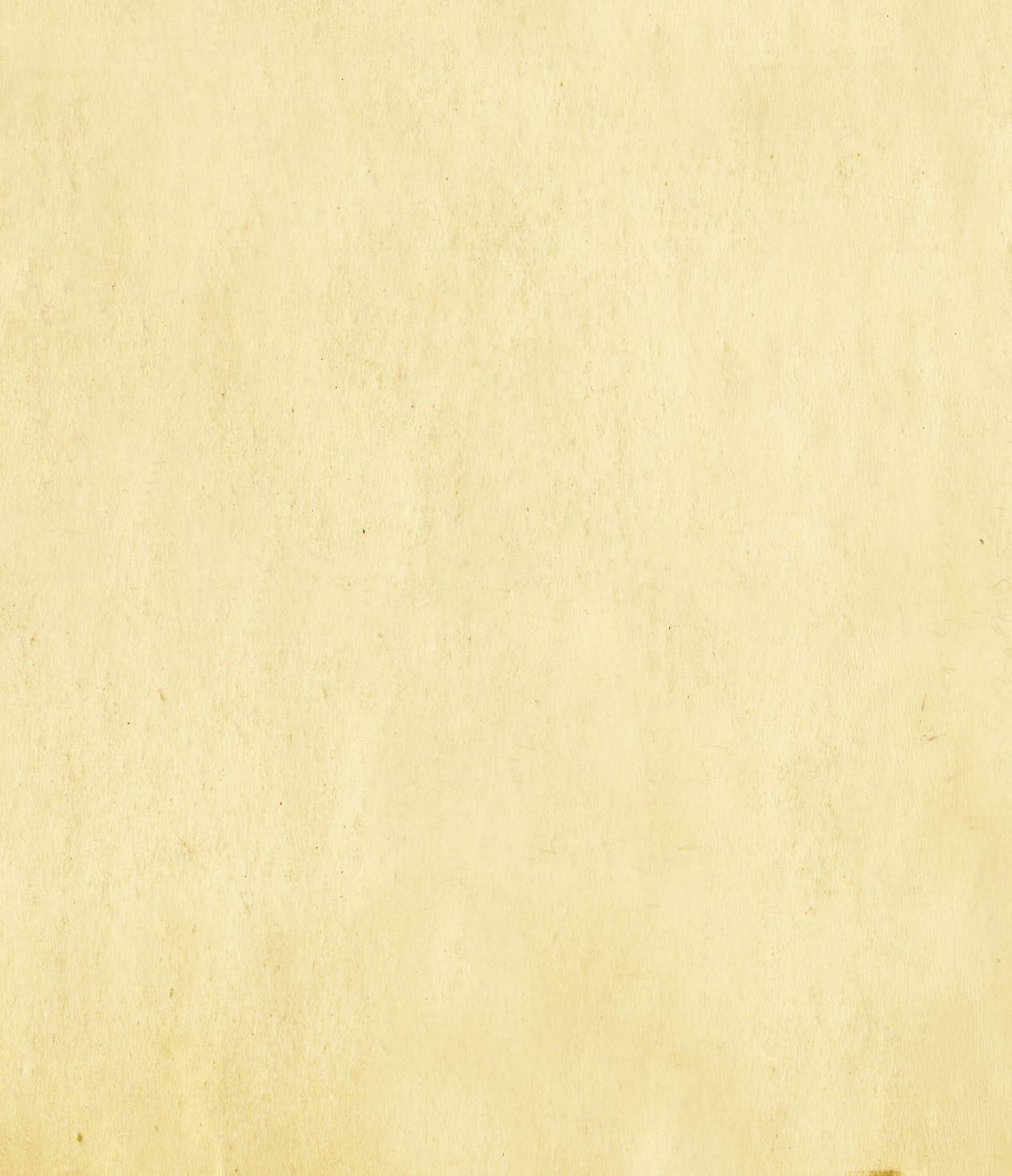
4 VOYAGER 4/2016 4 dro CONTENT
Earl Grey Classics/ Fortnum and Mason
Crocket and Johnes Johnstons of Elgin
Guiness 12 13 15 16 17 18 19 14 11 10 9 1 6 8 7
4
The Glenrothes Burberry Duck Handle Walking Umbrella qolga Hendrick’s Gin
5
3 2
Wedgwood Floris Hunter Lock & co Mulberry
Jimmy Choo Dege and Skinner Beef Wellington
Full breakfast plate
Taxi Imperial State Crown S L mogzaurisaTvis LONDON Cai
Cutler and Cross
Cais finjani parfiumi botebi qudi qalis CanTa
mamakacis fexsacmeli Sarfi
viski jini
tradiciuli
ludis kaTxa O O LONDON ONE WEEK IN LONDON HOTELS MUSEUMS BETWEEN THE RAIN AND THE FUN TRADITION 32 FIVE O'CLOCK TEA / CLOSED CLUBS GASTRONOMY ENGLISH BREAKFAST / RESTAURANTS RECOMMENDATIONS OF THE HEAD SOMMELIER AT THE RITZ LONDON NIGHT CLUBS/BARS WHISKY/BEER/GIN PUBS GRAMMAR OF ENGLISH ARCHITECTURE 66 CHURCHILL, WINSTON CHURCHILL 72 ALL HAIL THE QUEEN! 76 ENGLISH MUSIC 80 DANDY 84 ENGLISH SUIT 86 SHOPPING FOR MEN CARRYING A ROYAL SIGN FRAGRANCES AUCTION FOR CHILDREN TOM STOPPARD’S COLD 106 FOOTBALL PASSIONS ON THE ISLAND 108 KINGDOM OF SPORT 110 BRITISH EDUCATION 112 CITIES 118 BATH / SCARBOROUGH / LIVERPOOL / BRISTOL / CAMBRIDGE / OXFORD
qalis fexsacmeli pijaki 36 / 59
britanuli sauzme dedoflis gvirgvini 12 / 31 88 / 105
saTvale
RADO DIAMASTER GRANDE SECONDE PLASMA HIGH-TECH CERAMIC . METALLIC LOOK . MODERN ALCHEMY.






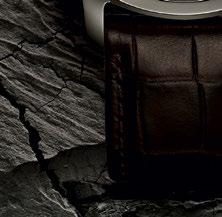




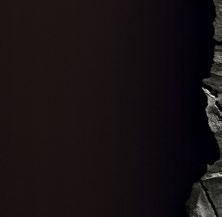









TIME IS THE ESSENCE WE ARE MADE OF















RADO.COM
How can one measure and fit a country into a single magazine when this country has given the world the best of civilization, science, museums, art, history and sport and all of its best??
The UK always knew the meaning of the word “best”.
The UK did not build the pyramids but studied them; it did not built the Parthenon but placed the best part of it in its own museum; it did not possess great lands but ruled the seas.
The UK invented and discovered many of the scientific and technological advances that have been pivotal in human progress.
The whole world followed the footprints of its bare children, from the Valley of Nimrod to Persepolis. A tiny island created an empire and was able to retain its dignity even after losing it.
Foggy Albion gave the world football and rugby. The wild yet controlled energy in these sports resembles the British character.
Nowhere in the world are people so carelessly loud; nowhere else do they fight so passionately or appreciate art so sensitively.
Very few countries have given world history so many wonderful queens. This unusual gender equality statement has not vanished without a trace – British women today continue to resist patriarchal society, just like Elizabeth I resisted marriage.
Britain creates phenomena easily.
English fashion _ eccentric, just like its citizens, free and open to novelties.
English weather _ say no more.
English breakfast _ requires a special definition, just like the mysterious English cuisine, which, after careful examination, proves to be more than the proverbial fish and chips.
English clubs _ often unattainable, coveted spaces where people with secret ties spend time together.
English gardens _ unforgettable in their beauty and philosophy, they manifest the closeness to nature that these islanders carry in their blood.
We tried to fit all of these elements into this magazine. You can judge how well we have accomplished this goal. The main point is that this magazine is just the beginning of an adventure in this wonderful country...
6 VOYAGER 4/2016
EDITOR’S NOTE

Editor-in-Chief Tea Skhirieli
Designer
Nino Kavelashvili
Illustrations by Maia Sumabdze
Translation by Lika Barabadze
Art - Director
Nino Daraseli
Authors:
Aka Morchiladze
Margarita Antidze
Bidzina Baratashvili
Nikoloz Chkhaidze
Marika Shalikashvili
David Sakvarelidze
Zaza Chiladze
Mzia Chikhradze
Marina Kipshidze
Lasha Bughadze
Publisher: LTD SOLO

Phone.: +995 32 2 44 44 00
ISSN: 2346-8130
Printed by: Bauer Medien Productions & Handels Gmbh
Adress: Baumannstrasse 3/19, A – 1030 Vienna, Austria
e-mail: office@bauermedien.at www.bauermedien.at Advertising:
Editor Salome Dadunashvili
Administrative Assitant
Giorgi Vasadze
Advertisement Manager
Nazi Goshadze
We would like to thank Maia Sharashidze, Nato Kancheli, Mako Abashidze, Lasha Kiziria, Tea Endladze and the British-Georgian Chamber of Commerce.
Project Manager / SOLO DIRECTOR
Eka Duchidze
Project Consultant
Nino Gegeshidze
SOLO Brand Manager

Keti Nikoleishvili
Print Management: Ctrl P
Address: Tbilisi 0186, Kavtaradze 27a
Phone: +995 32 2 381 908
8 VOYAGER 4/2016
Photo - Shutterstock
330 364 / Published material owned by LTD SOLO. Written Consent of the Company necessary for use of any material published in this magazine.
+995 599
4, 2016

TBILISI SOLO LOUNGE MTASTMINDA 11 Chitadze Str.

TBILISI SOLO LOUNGE ABASHIDZE 70, Abashidze Str.
TBILISI SOLO LOUNGE PALIASHVILI 23, Paliashvili Str.
TBILISI SOLO LOUNGE TSINTSADZE 12, Tsintsadze Str.
TBILISI SOLO LOUNGE Chavchavadze 29, Chavchavadze Ave.
TBILISI SOLO LOUNGE KAZBEGI 24G Kazbegi Ave.
TBILISI SOLO LOUNGE TSERETELI 73 Tsereteli Ave.

TELAVI SOLO LOUNGE Telavi 3 Cholokashvili Str.
KUTAISI SOLO LOUNGE KUTAISI 5 Q. Tamar Str.
BATUMI SOLO LOUNGE Batumi 22 Rustaveli Ave.
www.solo.ge Tel: +995 32 2 44 44 00
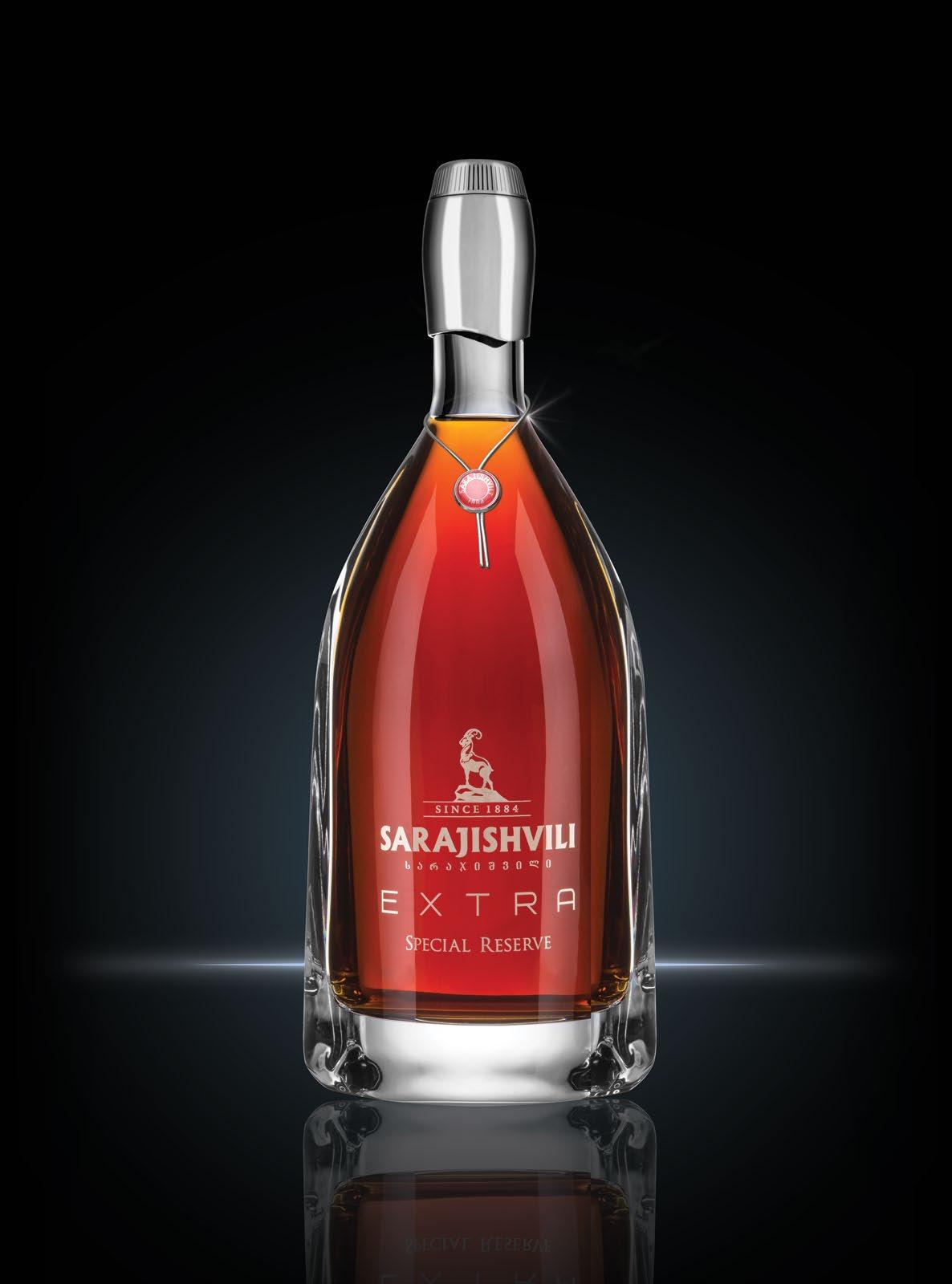
LONDON
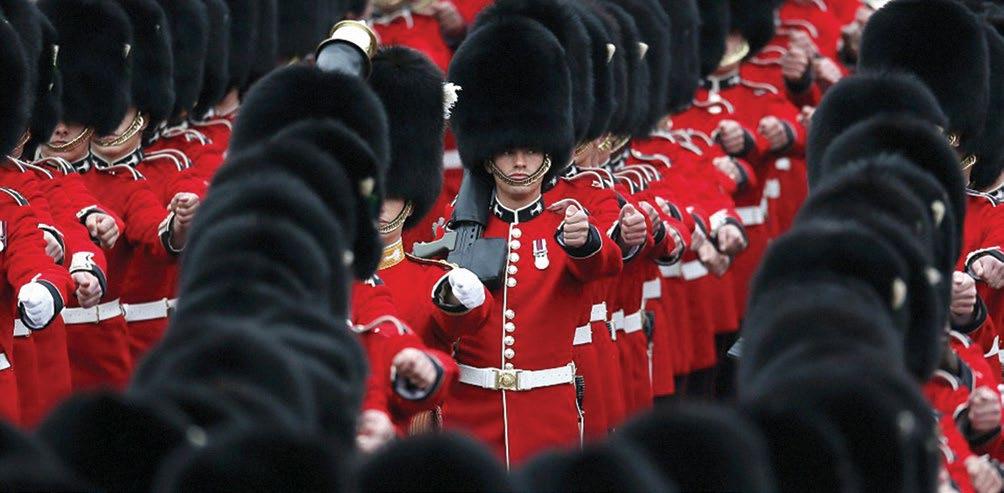
The London air is transparent like an April morning and tinkles like Mary Poppins’ bell. A row of lacquered doors shine behind the black metal gates along the columns of white houses in the arched streets. All of these doors lead to a world of wonders. Alice lives behind all of these doors; she is married now, with children who dream. In her backyard, her children hold huge magnifying glasses and observe tadpoles living in upside down umbrellas.
That’s not how it is at all, but I really want it to be this way. This is what I dream about, as I walk on the crescent-moon shaped streets in the morning, when the April air vibrates with thousands of blooming tulips.
Eccentric London-dwellers head to work. Of course, with umbrellas in their hands. Their blue business suits hide dry bodies and wildly-striped socks. When such a businessman sits next to you in the tube, all you can hear from his iPod headphones is rock and roll.
Where is the fog in London?!
The London we know from books is the Fall London.
Fall makes for a perfect time to sit by a window in one of the city’s tall buildings, located in a well-like yard, watching how the water streams in the black pipes, so shamelessly displayed by the houses, like Jack’s knife cutting open their brick bellies.
Everything is upside down in this city. The cars drive on the wrong side of the road, the faucets (which they call ‘taps’) turn the wrong way, and the traffic lights signal in the wrong order. How would you make tea with milk? Would you add milk to the tea? These islanders do it the other way round.
Something strange is in the air here, something that makes people sing and dance, makes people stand for hours in ancient theaters and wooden pubs, something that could not be destroyed by the plague or the infamous fire. Something conjured up by Macbeth’s witches – something wicked this way comes... You realize that Peter
Pan flew over this city when you look up at the glowing windows at night-time. Alice went down the rabbit hole here and Sherlock Holmes lived here too.
It is ironic that the lost and found office is located on Baker Street. Nothing surprising there. People, dazed by the city, loose hats, glasses, books and minds… if you lose your mind, London won’t return it, just like it won’t give you back your lost umbrella. This is the city of eternal umbrella circulation. You lose an umbrella, somebody else finds it just to lose it again, and on it goes until the end of time. And that’s how it will be as long as it rains in London.
Celebrities sit side by side with poor actors in noisy pubs in Soho. Nobody bothers them; everyone is equal, and everyone is part of the guild. Bars are chaotic until the first theatre bell rings and then both the front row and the tier are united, as if they have been swallowed by a whale. They laugh and whistle, yell and stomp their feet together.
I don’t know why I get so sentimental when a waiter calls me “dear” or a store clerk becomes my friend for 2 minutes and eternity.
I can’t get used to this city, to its amazement and grandeur. Yes, that’s the word. I can’t get used to its youthful energy, the colorful houses of Notting Hill, and the glowing white Mayfair.
I will never get used to the red buses rushing by and their crazy turns; they get me every time: I am afraid that they will tilt over and land on the umbrella passing banker.
That’s how it is and that’s how it is going to be, until cherries bloom by the brick houses that surround Holland Park, and the Notting Hill streets are covered with a million of costly items at the weekends. And that’s how it is always going to be, because nothing is so everlasting and nothing changes as fast as London.
However, where’s the fog in London?!
12 VOYAGER 4/2016
SALOME DADUNASHVILI
London, the UK capital, was founded by the Romans, who called it Londinium. London's first maps were drawn up in the XVI century, during the Tudor dynasty period. The maps depict a 5 km long city with only one bridge across the River Thames. Now there are 33 bridges across the Thames. London occupies 1,572 square kilometers. It includes the City of London and 32 other districts.
MAKA ANTIDZE
MAYFAIR / ST. JAMES’S
Mayfair is Central London's most prestigious district. Regent Street borders it to the east, Hyde Park to the west, Oxford Street to the north, and Piccadilly to the south. Palaces, three-century-old houses and modern buildings are juxtaposed here. Today this area is primarily a place of business, which houses head offices, hedge funds, real estate agencies and embassies.
You will not encounter noisy pubs or nightclubs in this aristocratic, privileged neighborhood and local restaurants will offer only the best whiskey and wine. Impressive architecture, slick streets and a quiet environment makes Mayfair an excellent choice for evening strolls.
Mayfair galleries have formed London’s art center for more than 90 years. The Royal Academy of Arts is located nearby. We strongly recommend visiting it.
The most famous brand stores – Chanel, Prada, Miu Miu, Alexander McQueen and Louis Vuitton – are located on the famous Bond Street Saville Row is here too, where world-famous men's clothing is tailored to individual orders.
The luxury shopping center, Burlington Arcade, has always been known for the finest quality leather goods, jewelry, watches and antiques. You can order a pair of shoes at the centuries-old Royal Arcade and taste amazing artisan chocolate.
Visit the restaurant at Claridge’s to relax after some pleasant but exhausting shopping. Here you can taste chef Gordon Ramsay’s culinary achievements.
The St James’s district, located south of Piccadilly is famous for the oldest closed English clubs and royal palaces. Three royal parks are located here.
The world-famous department store, Fortnum & Mason , is located here too. The royal family purchases tea seats in this store. As for Jermyn Street , this is the main address for men who want to shop in London.
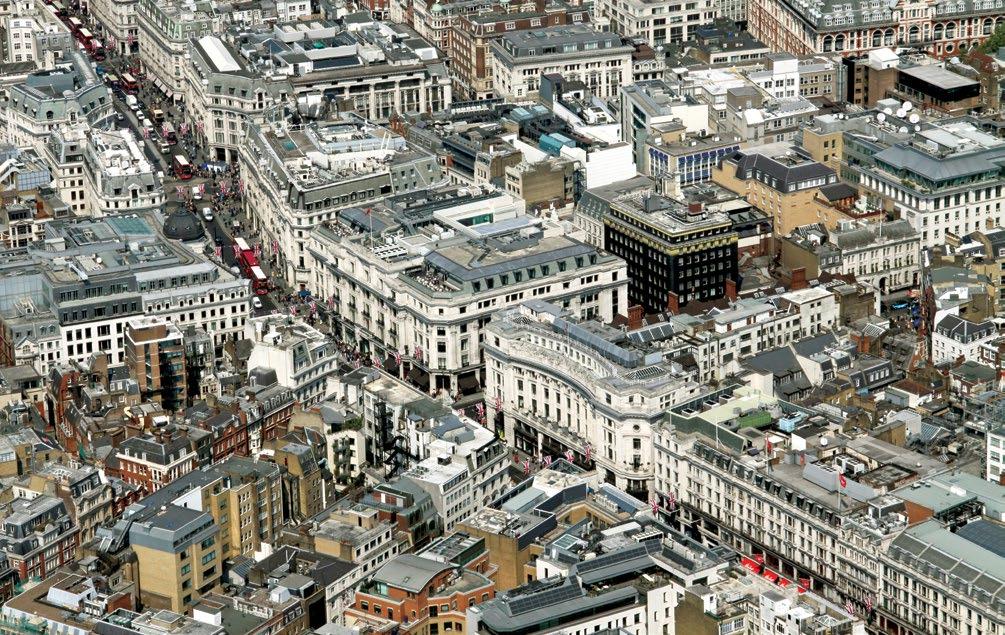
13 VOYAGER 4/2016 LONDON
WESTMINSTER
Westminster offers important sights on every step, as it is the center of London’s political and cultural life. Big Ben, Parliament, Westminster Abbey and Buckingham Palace are located here.
You can easily walk to all of the other London sights from this district: the Thames embankment, Tate Britain Museum, Michelin-starred restaurants in Belgravia, Chelsea, St. James Park and the West End.
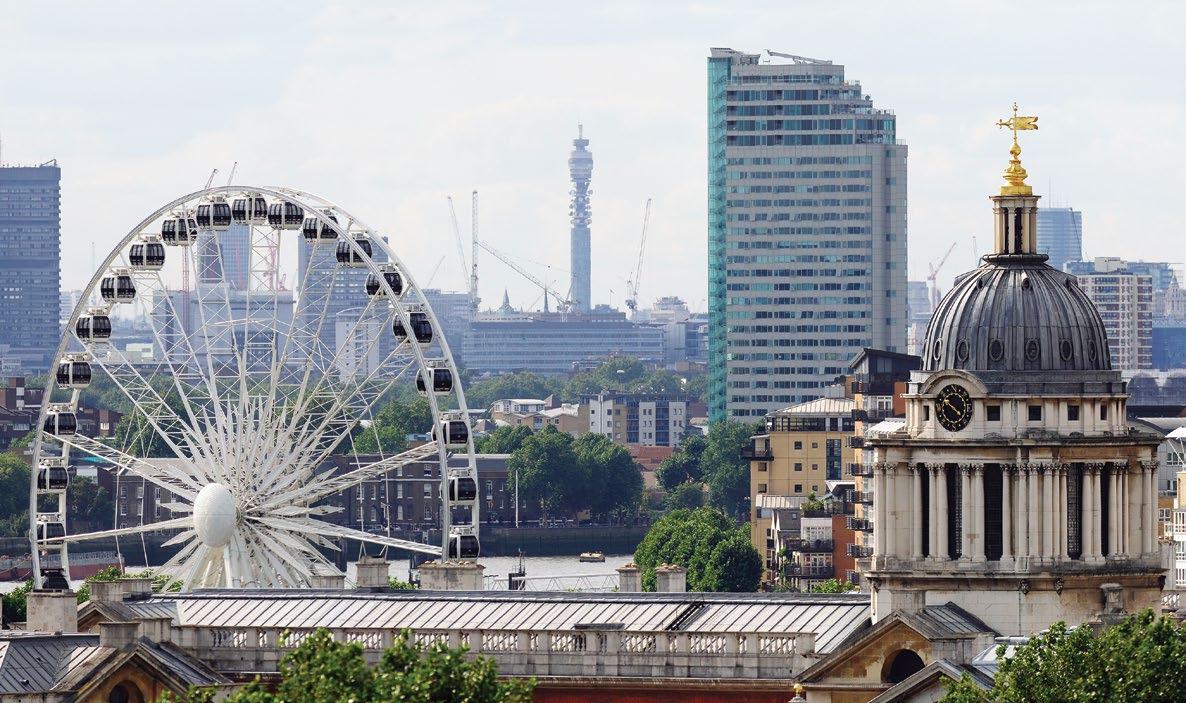
WEST END / SOHO / COVENT GARDEN
Soho – London’s glamorous, fun district. Not so long ago, Soho was famous for its strip clubs and red lights while today it is the most fashionable district in London, where popular bars, cafes and restaurants are located. London’s Chinatown is nearby, housing Chinese restaurants and shops.
The famous fountain "Eros” is erected in Piccadilly Circus Square, the heart of the West End. Leicester Square, which is located nearby, is a favorite meeting and resting place for locals. The square houses the most famous movie theaters that screen world premieres. Two statues adorn the square - William Shakespeare and the legendary Charlie Chaplin, who was born in London.
Charing Cross Road is known for its multiple-story as well as boutique bookstores. The West End houses wonderful museums: the National Gallery and National Portrait Gallery are found in the famous Trafalgar Square, where Nelson’s Column also stands.
Covent Garden district is called after a fruit and vegetable farmers’ market that was historically held here.
The market moved to the south of the Thames and expanded in the 1980s. Several trading stands are now tourists' favorite shopping spots. Lots of galleries and clothing stores are located here.
Covent Garden is the center of Britain’s theatrical life. It houses the world-famous Royal Opera House, which offers the best opera and ballet performances.
CITY
This oldest district of London is the biggest financial center of the world economy. The Bank of England and the London Stock Exchange are located in the City. The City is the oldest part of London and is reminiscent of a giant hive, where hundreds of thousands bankers, brokers and clerks are busy Monday to Friday. Every local restaurant, bar and club is open for them till late.
This district boasts beautiful medieval winding streets, architecture and many other sights, including: St Paul’s Cathedral, the Museum of London, the Tower of London and Tower Bridge.
BELGRAVIA
Belgravia is London’s most expensive district. Classicist architecture, luxurious palace facades and beautiful churches give it a majestic atmosphere. Living in such an aristocratic environment is extremely expensive, but nowhere else can you find such houses and exquisite gardens.
This district’s architecture is associated with Thomas Cubitt. He started construction of Belgravia in 1825 and worked on it for 30 years. Belgravia Square is mostly surrounded by the houses of different ambassadors.
CHELSEA
Chelsea is the most famous London district in the world. Bankers and brokers working in the City invest in Chelsea real estate.
It is known for its bohemian nature. The Rolling Stones, The Beatles and other famous musicians used to visit its night clubs.
However, businessmen in suits gradually took over from the hippies and punks.
14 VOYAGER 4/2016
Mark Twain, Oscar Wilde, Jonathan Swift and Agatha Christie all lived in Chelsea. The Saatchi Gallery of Modern Art offers diverse exhibitions and emphasizes the work of young artists.
Follow Sloan Street and the King’s Road for shopping at designer stores and famous brands, such as Harvey Nichols, Louis Vuitton, Miu Miu, Versace, Chanel, Prada, Jimmy Choo, and Cartier.
KENSINGTON/ KHIGHTSBRIDGE
Kensington’s green streets house many high-quality restaurants and famous designer shops. The Albert Hall and Hyde Park – Londoners’ favorite relaxing spots – are located here. Princess Diana lived in Kensington’s palace; this is where people brought flowers after she tragically died.
Knightsbridge district also boasts expensive properties. It has been considered London’s most fashionable area since as early as the Victorian era.
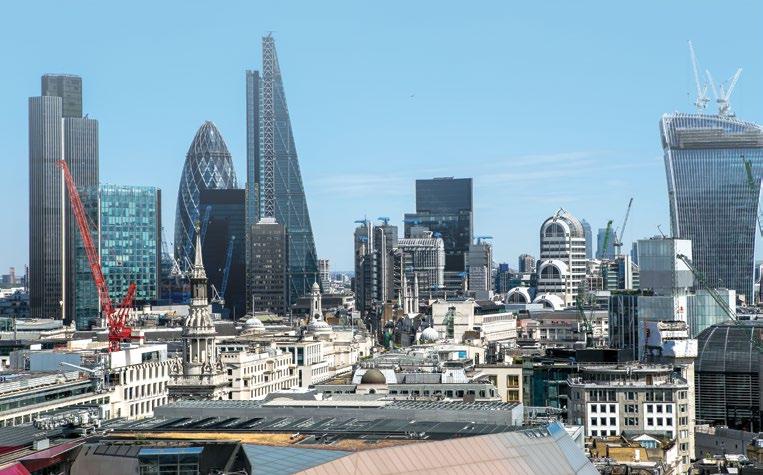
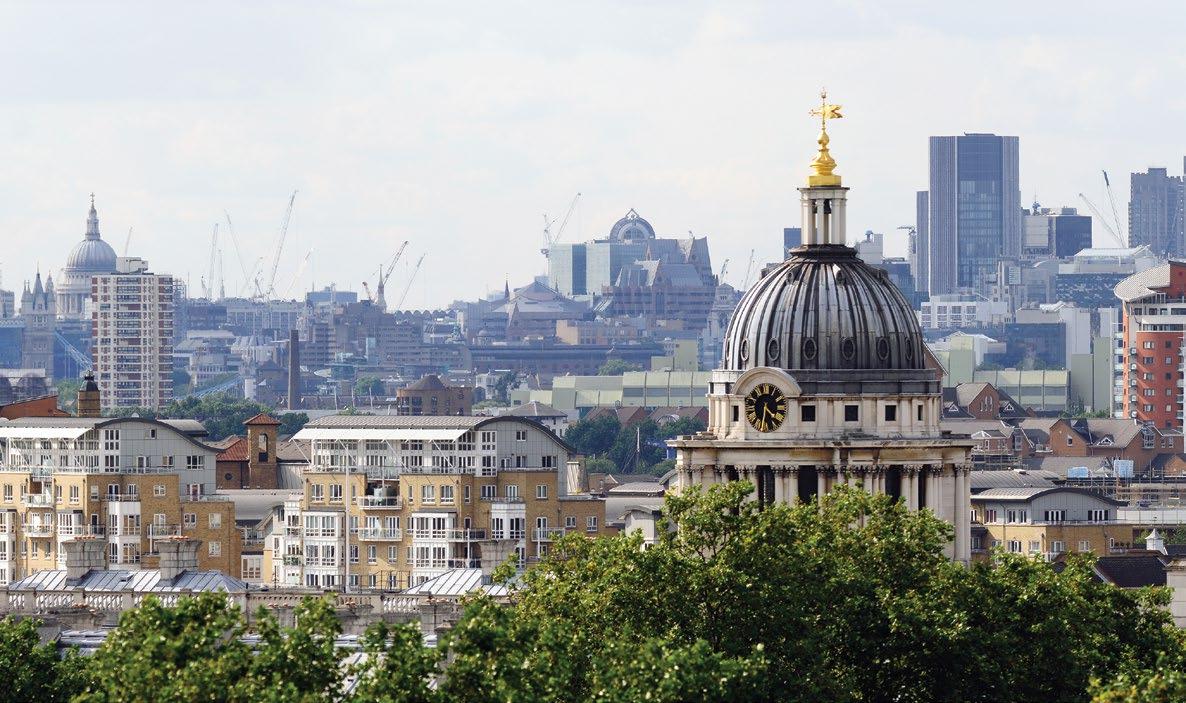
The world's most famous department store, Harrods, is located here, as well as embassies and cultural centers. A number of museums are also housed here: The Science Museum, The Victoria and Albert Museum and The Natural History Museum.
NOTTING HILL / SHOREDITCH
Londoners love Notting Hill for its idyllic, paved streets, design and antique stores, its Victorian-style architecture, the houses, and the former stables or replicas of the stables. It is crowded and noisy, especially during the Portobello flea market and the Notting Hill Carnival.
We recommend that you visit the Notting Hill Arts Centre, which brings
together young performers, artists, playwrights and future theater stars. Shoreditch's old district of warehouses and buildings has been turned into a gallery district. It is London's creative center and start-up hub – a new generation analog of Silicon Valley, full of creative people.
Locals aim high here, where dreams can come true.
15 VOYAGER 4/2016 LONDON / AREAS
ONE WEEK IN LONDON
NINO DARASELI
I BELIEVE THAT SEVEN DAYS AREN’T ENOUGH TO TRULY EXPERIENCE LONDON, BUT IF YOU CAN’T STAY FOR LONGER MAKE SURE TO TAKE THE LONDONERS’ ADVICE AND GET A FEEL FOR THE CITY BY TRAVELLING ABOVE GROUND RATHER THAN ON THE UNDERGROUND.

THE NUMBER 23 bus goes west from Liverpool Street to Westbourne Grove. It passes by the city’s main attractions including ST PAUL’S CATHEDRAL, Nelson’s Column at Trafalgar Square and THE MARBLE ARCH. If you take this route, you will get to travel with London-dwellers going about their busy everyday lives, and you will get to feel the city’s pulse.

When you arrive at the bus’s final stop in west London, take the Golborne Road and have a cup of coffee and a pastéis de nata (egg tart) in one of the Portuguese cafés or treat yourself to a Margherita pizza with buffalo mozzarella at Pizza East.
This street is home to numerous antique and vintage stores that are open all week. The TRELLICK TOWER, a brutalistic, cult architectural building designed by ERNO GOLDFINGER, is also located on this street. At the foot of this building, you can sometimes see Madonna, Kate Moss and other local celebrities at its famous vintage store.
If you want to enjoy a traditional English breakfast, I’d recommend the restaurant "202" (202 WESTBOURNE GROVE) – and do not be surprised if you are served by a Georgian waiter. If you remain in the district until lunchtime, you can taste amazing dishes made by the Australian chef Bill Granger at GRANGER & CO. it is located at number 175 on the same street (don’t let the queue scare you, it moves quickly). A delicious cocktail at BEACH BLANKET BABYLON (45 Ledbury Road) with its beautiful interior is also a good choice.
WESTBOURNE GROVE offers the latest collections of popular European brands such as ZADIG & VOLTAIRE, JIGSAW or BIMBA & LOLA.
ST PAUL’S CATHEDRAL
The Anglican cathedral of the Diocese of London is located at the city's highest point, Ludgate
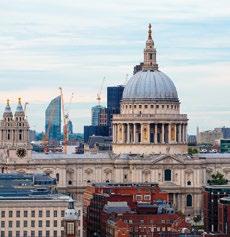
Hills. It has been a symbol of greatness and pride for more than 1,400 years. Climb the 528 stairs to the top of the dome. A round golden balcony circles the done –the Golden Gallery – offering some of the finest panoramic views of the city.
This impressive cathedral has always been associated with London's most important events. For example, the wedding ceremony of Prince Charles and Lady Diana Spencer and the diamond anniversaries of Queen Victoria and Queen Elizabeth II all took place here.
Since we’ve mentioned vintage, don’t leave London without visiting the PORTOBELLO Road flea market, if you are in London at the weekend. It is located in the NOTTING HILL district. Here you will see the bookshop where Hugh Grant and Julia Roberts first met in the film “Notting Hill”’."
THE SHARD
Europe's tallest building provides a different perspective; the digital telescope located on its roof will give you the opportunity to discover the surroundings in incredible detail.
Tower Bridge, with its glass floor, is one of the city’s most impressive structures, offering spectacular views over London. The bridge was constructed in 1894 on the River Thames and is considered one of the world's most famous landmarks.
Artificial grass and deck chairs form an open space that is the best place in London to drink champagne.

16 VOYAGER 4/2016
TOWER BRIDGE
If you are interested in contemporary art, you should definitely opt for a well-known art route, such as The Line.
This is the best way to get acquainted with London’s contemporary art and the city's lesser-known wildlife and cultural heritage, from the Queen's Olympic Park to the Greenwich meridian. In 2016, the route presents 13 works by Martin Creed, Damien Hirst, Eduardo Paolozzi and Thomas Price. This entire dynamic exhibition is situated along the pedestrian and cycle routes. You’ll need three hours to see it all.
For more information, visit the site: www.the-line.org

Do not miss the little cafés and shops in Soho: check out MAISON BERTAUX for tea and cakes and NEAL'S YARD for holistic medical innovations. Visit BODEGA NEGRA for new impressions and Mexican dishes. I will intrigue you by telling you that the restaurant's main entrance is disguised as a sex shop.
Central London boasts many green places. Therefore there’s no need to point out the parks – you’ll see them as walk around. You can find cozy places in regular streets. Just follow the road from the LLOYD’S building to MICHELIN HOUSE.
I was not impressed by the East London icicle-like building that has been included in all of the recent tourist routes. However, if you don’t want to feel left out, visit one of Europe's tallest buildings: THE SHARD. An artificial green platform is located at the top, offering spectacular views of the city.
Enjoy London's wide open spaces for relaxation. Start the day in North London at HAMPSTEAD Heath then have a coffee on the veranda at GINGER & WHITE cafe
For a different sort of day, find out about secret film sessions. SECRET CINEMA is held in London for a few days in different spaces. A carnival atmosphere is created during the event; costumes and environments are set up matching the film being screened. Dress accordingly and travel to an alternate reality.
TRAFALGAR SQUARE
Trafalgar Square is one of the most famous squares in the world. Its name comes from the Battle of Trafalgar, where the British, under

the command of Horatio Nelson, defeated the French and Spanish fleet in 1805. Nelson's column, erected in the center, is surrounded by four large statues of lions.
HAMPTON COURT PALACE
Hampton Court Palace is known as the home of King Henry VIII. The building consists of two parts: Henry VIII’s Tudor mansion and the more baroque palace of William III, which dates back to the XVII century. Visitors can inspect apartments, galleries, the
You may choose a traditional and very popular route; it was created to commemorate the Queen’s silver jubilee in 1977. It has been repeatedly tried. A 15-mile route covers five areas and includes London's most important sites.
Visit a small antique shop on Kensington Church Street. Once you have finished browsing, walk to number 119 and enjoy a most beautiful pub, THE CHURCHILL ARMS, where beer is served with Thai dishes. Winston Churchill's grandfather and grandmother were regular patrons of the pub thus it was renamed The Churchill Arms after World War II.
One day, take an early morning walk to the center of London, and visit the ROYAL ACADEMY OF ART, which constantly hosts new exhibitions. We also recommend that you check out any of the world-famous dance performances at the Sadler's Wells Theatre, and, if you have time, watch a film in the
PRINCE CHARLES CINEMA
A week is not enough to tour all of London’s museums, so I advise you to go directly to the Museum of Modern Art – the Tate Modern. THE TATE MODERN building used to be an oil-fired power plant before it was converted. A new building has been added since July – a stunning construction that looks like a pyramid-shaped spinning tower.
HANDEL HOUSE MUSEUM is another attraction that is unknown to most tourists; it caters especially for music lovers. Two musical geniuses used to live in the Mayfair district in adjourning buildings: Handel at 25 BROOK ST in the 18th century and rock legend Jimi Hendrix at number 23 in the 20th century.
Do not leave London without visiting the theater. THE ALMEIDA THEATER is currently presenting a new performance of Shakespeare’s “Richard III” starring Ralph Fiennes and Vanessa Redgrave. Book your tickets in advance, although you might get lucky and be able to buy one from a re-seller. Visit SHAKESPEARE’S GLOBE for an unforgettable experience; you could even see a performance in the Sam Wanamaker Playhouse theatre.
DEVIATE FROM YOUR PLANNED ROUTE, STOP ALONG THE WAY, CHANGE DIRECTION AND GO WITH THE FLOW; REMEMBER, YOU ARE NOT IN A HURRY. LOOK AT THE LOCAL LIFE AROUND YOU, FIND YOURSELF IN THE STREET, AND BY THE END OF THE WEEK YOU’LL BE SURPRISED AT THE NUMBER OF WONDERFUL THINGS THAT HAVE HAPPENED TO YOU.
Royal Chapel and the medieval hall named the Great Hall. The palace is known for its gardens, which features a vineyard planted in 1768.
BUCKINGHAM PALACE
Buckingham Palace became the residence of the British monarch when Queen Victoria ascended the throne in 1873.
works by Rembrandt, Vermeer, Poussin and Canaletto; Canova sculptures; a rare porcelain tea set; and sophisticated English and French furniture.
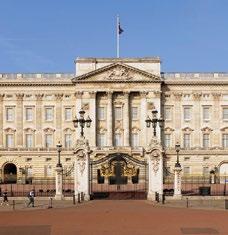
17 VOYAGER 4/2016 LONDON
Visit its ornate ceremonial halls, which house many of the Crown’s most precious artefacts, including
KATIE MELUA’S LONDON
NINO DARASELI
Which restaurant in London would you recommend?
I seldom go to restaurants as my mother is an excellent cook –she makes particularly good Georgian dishes. My friends have recommended several restaurants though and I remember going to this Chinese place called “Silk Road” (address: 49 Camberwell Church St, London SE5 8TR).
Where do you recommend for a cup of coffee?
I like the little cafe in Hyde Park called LIDO. It is very cute and located by The Serpentine. The food is nothing special or Micheline award-worthy but it is cozy and has a nice atmosphere (Hyde Park, by the Diana Princess of Wales Memorial Fountain).
And where would you recommend for drinks?
If I want to go out for drinks, I go to Camden where lots of young bands perform. My friends and I go to the pubs there. I also recommend a pub called The Daf; it’s in my home district and has a great history.
Where do you shop?
I like Liberty (address: Regent Street London W1B 5AH) for shopping. They have special buyers and I really like their collection. I like it because it is not as crowded as the other shops so you are free to browse in peace. Shopping is stressful for me – I have hard time making decisions, especially when things are expensive. However, I feel comfortable at Liberty. The building is wonderful in its own right.
What music do you associate with London?
I listen to so much music that it is hard for me to specify. When I am entertaining at home, I always put one album on. It might not be directly affiliated with London but I really like it. It is a male/female duo called “Elis and Tom”. Tom Jobim was a famous Brazilian composer and Elis Regina was a wonderful Brazilian singer. It’s a very cool Portuguese album.
KATIE MELUA was born in Georgia and is a popular British musician. She has sold 11 million albums and 1 million concert tickets and as a result was named one of the most successful artists of the millennium. Katie has received

56 PLATINUM AWARDS.
KATIE, HOW WOULD YOU DESCRIBE LONDON’S STYLE?
Eclectic and experimental. All of the young people make it new and experimental and there is always something interesting happening here.
As for the style, I like all of the uniforms in London. I like to see the guards at Buckingham Palace in their pretty red uniforms and black hats. And I love all of the different school uniforms too.
Where in London do you work best?
I mostly work at home, where I write my music. I live in Barnes, by the river. I like working there.
AS FOR THE SMELLS THAT REMIND ME OF LONDON, I’D HAVE TO SAY THE SMELL OF HOLLAND PARK, WHERE MY PARENTS LIVE. THERE’S A JAPANESE QUARTER THERE SO LONDON FOR ME SMELLS LIKE GREEN, FISH AND A SMALL WATERFALL.
What is the strangest thing you’ve ever seen in London?
Richmond Park. It is located half an hour from Holland Park, in the district where I live; it is different from Holland Park and looks like a real forest. Animals live in the park and you can get up close to them. The nature looks like something out of a Jane Austen novel. Hampstead is also unusual – people bathe in the cold. I tried it once but couldn’t take it. Women and men swim in separate places and can do so naked.
What is the London quality?
The best London quality is its energy and diversity of choice. You can do so many things here in any area, for example, music, galleries, classics and the theatre.
18 VOYAGER 4/2016
What would you change about London if it were up to you?
I’d like the shops to stay open later like they do in Georgia –for example, the corner stores that sell everyday items.
What is the latest London trend?
Online shopping. Entertainment has moved online too. You get information on style and ideas through websites and blogs. For example, I like the portal MAN REPELLER. I like their humorous way of presenting information. Stores in London are also more than stores too, more than brands. They are constantly organizing different events, such as yoga classes.
Where is a good place to get lost in London?
The streets behind Noting Hill and Holland Park. When the sun goes down and people light up their homes, you can wander around and see how they live.
What surprises you in London?
I am surprised and inspired by the Tube. I like watching people. You encounter many interesting and amazing people there. I like the way the wind is always warm, and despite the fact that people walk around stressed, I feel romantic here. I don’t have an office job, so unlike others, I am at liberty to avoid rush hour; I’m not in a hurry. I hate car travel and traffic.
What’s a chilled out place in London for you?
There’s no better place to chill out than at home! I am renovating my apartment now. I also like visiting my friends.
London has some wonderful libraries too. I’d recommend the British Library by King’s Cross (Address: 96 Euston Road; Subway: By Underground King's Cross/St Pancras, Euston and Euston Square). I can get lost in the bookshop and come out a different person. I like literature. This city gives you the opportunity to meet many writers, ask them questions and just talk to them.
Which museum would you recommend for “Solo” readers?
I think that Dennis Severs’ House in East London (18 Folgate Street, Spitalfields, London) is the most interesting one. It is located in a Georgian period building. The collector rebuilt the house as it was. I especially like it at Christmas.
Which cultural event have you remembered the most?
The first year that Punchdrunk Productions staged its immersive theatre. (Punchdrunk is a British theatre company that was formed in 2000; they created pioneering "immersive" theatre where the audience is free to choose what to watch and where to go). The performance was presented in a big factory. We were escorted to the elevator and given masks, while the actors’ faces were open. This factory was on the third floor and you had to walk around and find the scenes.
Why should we visit London?
For the architecture, music and fashion, of course.
19 VOYAGER 4/2016
BLACK CABS
London taxis are often called Black Cabs. Cab is a short version of carriage (horse-drawn carriages, which were hailed in the streets in the 1800s).
The British Black Cab is well-known around the world for its unusual appearance and phenomenal reliability.
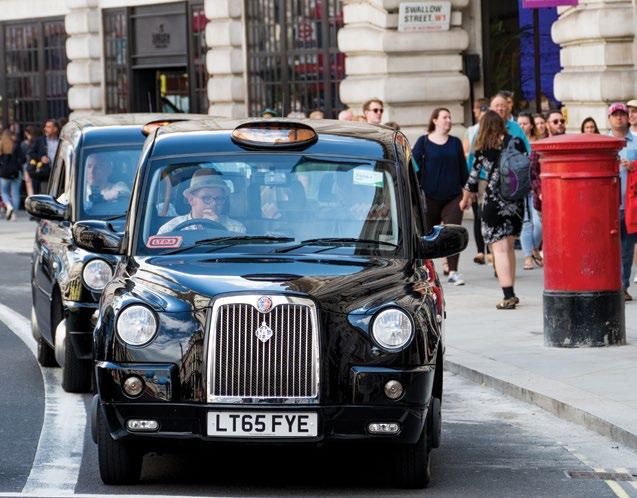
REMEMBER THAT ONLY BLACK CABS CAN BE HAILED IN THE STREETS OF LONDON. IT IS BETTER TO CALL OTHER TAXI SERVICES IN ADVANCE.
DRIVING IN THE UK IS ONLY ALLOWED ON THE LEFT SIDE OF THE ROAD.
SAVOY COURT IS THE ONLY STREET WHERE VEHICLES ARE REQUIRED TO DRIVE ON THE RIGHT, WHICH LEADS TO THE SAVOY HOTEL. THE SPEED LIMIT ON THE HIGHWAYS IS 70 MILES PER HOUR (112.65 KPH). ON MOST OTHER ROADS, THE SPEED LIMIT IS LOWER.
The first model was produced in 1929, in accordance with the requirements developed in 1906 by the London Public Carriage Office. According to the standards, only a car with a turning circle diameter of 7.62 meters can serve as a London cab. London cab models have changed several times over the years; the newest is the TX4, which has been produced since 2007.
The design of the cab has remained unchanged since the end of the 1940s. There is a large space for rear-seat passengers (some may even be able to stand up and stretch in the car). The latest model TX4 is fully compatible with “Euro4” emission norms. All cars are equipped with modern safety systems and are pram and wheelchair-adapted. Black Cabs cost £25,000 pounds ($40,000) – no more, no less.
The exploitation period of a Black Cab, in continuous busy working conditions, is 10-12 years with a mileage of 800,000 km; however, in actual fact, English cabs can run for millions of kilometers. Many of them have served passengers for over 25 years without interruption.
In order to acquire a license, London Black Cab drivers have to pass a test called “The Knowledge” to test their knowledge of the geography of London streets and important buildings. It takes two to four years to learn this information.
Private licenses are issued by the police for a period of three years. The number of passengers
that can be carried at the same time in a cab is also determined. A private license allows drivers to pick up passengers in the streets. Other companies cannot do this as a phone-order taxi license is cheaper and therefore preferable for most companies.
Most cabmen know the city so well that they do not need to use GPS navigation systems (only 2-3% are equipped with GPS).
Nowadays not all cabs are black. One can find blue, green or pink versions of the traditional taxi in the streets of London but color does not affect price or quality of service. Passengers can ask the driver to charge their phone since the majority of them have chargers for different models. It’s not recommended to use taxis during rush hour as the journey might get very expensive and you might even be late to your appointment.
However, traveling in the center of London can cost from 7 to 20 pounds in the morning or evening.
WHEN PAYING, IT IS PREFERABLE TO STEP OUT OF THE CAR AND HAND YOUR MONEY TO THE DRIVER THROUGH THE WINDOW. TAXI DRIVERS OFTEN CALL YOU “DARLING” OR “LOVE”. DO NOT WORRY; IT IS NOT A SIGN OF FLIRTATION, NOR OF EXCESSIVE FAMILIARITY – RATHER IT IS A COMMON WAY TO ADDRESS PEOPLE IN THE UK.
20 VOYAGER 4/2016
HOW AND WHEN TO HAIL A CAB
If a cab has a light on, it usually means that it is available for business. If the light is not on, it means that there is someone in the cab or the driver has finished his work for the day.
The bright yellow light on cabs is eye-catching and means that you can hail the car: stand on the sidewalk and stick your arm out.
BEFORE YOU GET INTO THE VEHICLE
You should stand in line at the taxi rank and when your turn comes, approach the nearest cab. It is better to go to the front window and explain to the driver where you want to go.
Most of the front and rear seats are separated and passengers get in behind the driver. If you sit beside the driver, he may even consider it a violation of his personal space.
TRAVEL COSTS
English cab fares are considered the most expensive in the world. The government even had to adopt a law on maximum rates a few years ago.
The base rate is 2.60 pounds, with 20 pence for every 281 yards (256 meters) or 55.5 seconds until the amount reaches 8.60 pounds. 20 pence are then added for every 188 yards (170 meters) in 37 seconds. On weekdays from 8:00 pm to midnight, 60 pence are added to the principal amount and a further bonus of 60 pence is added during Christmas and New Year.
TIPS
Adding 10-15% to the travel fare is appreciated. Most passengers simply round up the amount and tell the driver to keep the change. In the case of a long-distance trip or if the driver helps you with language, you may even pay 5 pounds.
CAB RIDE
If you decide to talk to the driver while you sit in the back seat, choose light conversation topics and avoid thorny issues such as religion or politics.
LONDON UNDERGROUND
The London Underground was the world's first subway. The first line opened in 1863. The network now has 275 stations across 12 lines. It opens at 5:30 am on weekdays and Saturdays, and at 7:00 am on Sundays. The last trains are between 11:30 pm and 12:30 am.
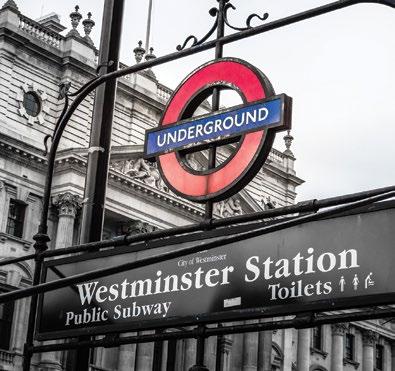
All of the stations are divided into 6 areas: the first area is the center of London; the sixth zone is in the suburbs.
Ticket prices depend on the number of zones traveled. For the first zone, if you pay with an Oyster travel card, it costs £ 1.50 for adults and £ 0.70 for children; without a card it is £ 3.00 and £ 1.50 respectively.
If you do not have to travel often, it is better to buy a ticket for the first and second zones, which costs £ 12. If you need to take a bus, do not forget to buy a transfer ticket. Tourists usually do not move beyond the first zone.
This is the historic center of London. Ticket prices change considerably according to the zones, so pay attention to your route and do not get any extra zone tickets.
If you plan to travel on the London Underground a few times, it is more convenient to buy a Travelcard or use Oyster. Oyster is a multi-use card, which can be useful during multiple rides. A weeklong ticket for journeys within the first and second zones will cost you £ 43.
Do not forget to tap your smart card before leaving the London Underground, otherwise you will be charged the maximum. The fine for ticketless travel is £ 20. The London Underground is very hot in the summer as most lines do not have air-conditioning; do not forget to bring water.
RED BUSES
London has more than 18,000 bus stops, where you will have wait no more than 5 minutes for the next bus. Buy tickets before boarding using a ticket machine – there are no conductors and the driver does not take money.
You may purchase a six-pass book called a Saver. One ticket is valid for one ride. If you use the Saver, enter the bus via the front door and show the ticket to the driver.
A single ticket costs £ 1.50 in cash; a One-Day Bus Pass: £ 3.50; a Seven-Day Bus Pass: £ 13.50.
LONDON'S RED DOUBLE-DECKER BUS, ROUTEMASTER, IS A SYMBOL OF LONDON. IT WAS CREATED IN LONDON IN 1954 AND RAN FROM FEBRUARY 8, 1956 TO DECEMBER 9, 2005.


21 VOYAGER 4/2016
TRANSPORTATION
HOW TO TRAVEL FROM THE AIRPORT
HEATHROW AIRPORT GATWICK AIRPORT
Gatwick Express is the fastest way to get from Gatwick Airport. The route from the South Terminal to Victoria Station takes half an hour. An adult tickets cost £ 17.90; children cost £ 8.95.
You can travel the same route using a regular train. It takes 5-10 extra minutes but the ticket price is considerably lower (£ 10.90). The train runs every 20 minutes, and once an hour at night.
There are other ways to get to the city from the airport: from London Bridge station or Kings Cross St Pancras station. The fares are the same and the trains runs every 15 minutes; travel time takes 40-45 minutes.
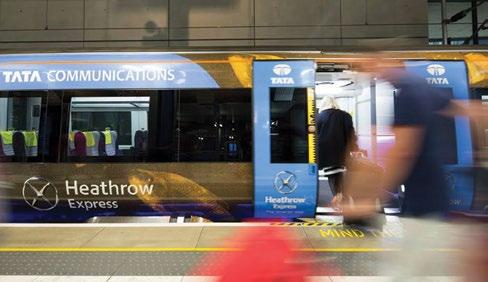
More than 500 domestic and long-distance buses leave directly from the terminal or from the central bus stations.
HEATHROW IS ONE OF THE MOST MODERN AIRPORTS IN THE WORLD. IN ADDITION TO COMFORT, THIS ALSO MEANS THAT THE PASSENGERS PERFORM ALMOST ALL OF THE ACTIONS INDEPENDENTLY. FOR EXAMPLE, YOU BOOK YOUR OWN TICKETS, SELECT YOUR PREFERRED SEATS THEN PRINT YOUR OWN BOARDING PASSES –YOU ONLY HAVE TO GIVE STAFF YOUR LUGGAGE.
Licensed taxis stand outside the terminals. If someone inside the terminal offers a taxi service, we strongly recommend that you turn them down. A taxi trip to the center of London takes approximately one hour and will cost 50-80 pounds.
Black Cab services from the airport are so expensive that there are now excellent alternatives. Pay attention to Viator travel . Pay in advance online and book a car. You can rent a luxury car with a driver, which will cost up to $150 (a fixed price in USD) , or split the fare among the other passengers (maximum of 3) and travel from Heathrow for $20 and from Gatwick for $40. It is also possible to book a car for the trip back to the airport; do not forget to confirm your reservation by phone.
You will find a number of drivers holding signs with customer names. If you cannot find your name, dial the company’s number and the driver will turn up. In this case, knowing the phone number and a little English is essential.
Most buses leave from Gatwick’s South Terminal (Easybus ЕВ3 to Victoria Station and ЕВ4 to Fulham Broadway- up) every 20 minutes, 3:00 pm to 1 am. The journey will last 60 minutes; tickets cost £ 2 when purchased in advance.
Buses leave every hour from the North Terminal. National Express will take you to Victoria Station. Operating hours: 15: 30-22: 15.
An hour and a half trip will cost you £ 6.60.
Checker Cars is Gatwick airport’s official partner company. The journey lasts 60-70 minutes and costs between £100-150 . In addition, a congestion charge of £5.00 is added on weekdays. You can pay with cash or credit card (in this case you will pay 10% more).
You can book a taxi online. Generally, this is the most comfortable way to travel, but the journey can take a lot longer because it is quite likely that you will get stuck in traffic.
RECOMMENDS
If you plan to get a tax-free refund, arrive at the airport a little earlier, but the percentage of the refund is quite low (about 10 percent).
Also, if you want to take the money directly, 3 pounds will be deducted from each purchased item. If you have not bought a lot of things, it is more favorable to get refunded on your card to avoid additional costs.
22 VOYAGER 4/2016
The Heathrow Express arrives at London Paddington station in 15 minutes. Trains from Heathrow take 25 minutes.
TAXI
BUS
TRAIN


THE CONNAUGHT, MAYFAIR
Since 1897, this architectural beauty has been more like a luxury residence than a typical, traditional hotel. Wedgwood fine china and old-fashioned service gives the place that truly British atmosphere. However, the charm of antiquity and its majestic appearance are mixed with the necessary contemporary elements.
The renovated hotel has 121 rooms, a spa, a swimming pool without chlorine, a gym,
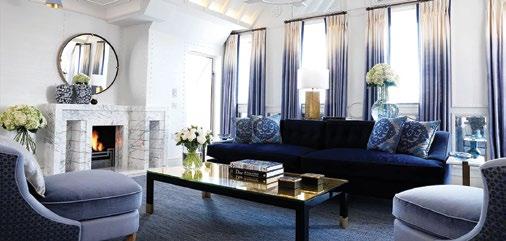
and the so called "Presidential" suites with two spacious terraces that were designed by the late David Collins. The world's most famous female chef, Helen Darroze’s, twoMichelin-star restaurant offers an exquisite menu. You can have cocktails in two different bars.
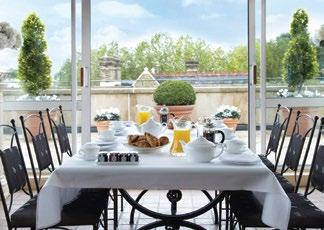
One of them is designed by Collins, where martinis are served by waiters in white gloves, and the whiskey bar offers a diverse selection of alcoholic beverages.
Carlos Place, London
THE BEAUMONT, MAYFAIR

Jeremy King and Chris Corbin are associated with the last three decades of acclaimed restaurants in London, such as The Ivy and Le Caprice. However, the Beaumont is the pair’s first attempt to combine a restaurant and a hotel. The hotel is located at the heart of Mayfair in a former garage that is part of the heritage list. The hotel has 73 rooms in a 1920s style.
The classic Art Deco style of the interior is nevertheless reminiscent of the Robitaille statues. This building is the work of the British artist Antony Gurley and it features a very unusual space called "rooms": a darkcolored, oak-wood-decorated hall with a ten-meter-high ceiling where guests can gather and mingle.
The hotel offers more traditional services as well, such as a spa placed on the first
floor. The grill and American bar are styled to reflect the crazy 1920s. Guests can taste gourmet dishes here.
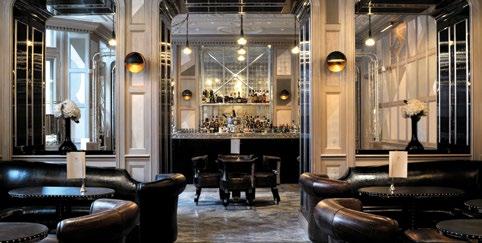
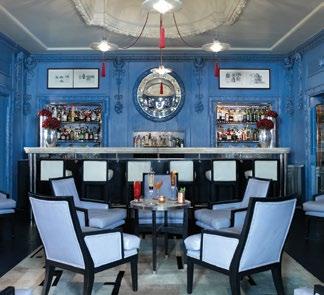

Prices start at £ 415
Brown Hart Gardens, London
THE BERKELEY, KNIGHTSBRIDGE
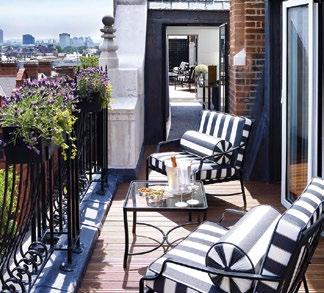

Notice David Collins’ "Blue Bar", which is the best place to drink a cocktail in the evening among Knightsbridge society. The barman, Stefano Zampieri, mixes legendary drinks.
Prices: starting at £400
Wilton Place, London
24 VOYAGER 4/2016
HAM YARD HOTEL, SOHO
Ham Yard Hotel is located in the middle of the Soho district, just a few steps from Mayfair. The hotel building stands in a lush garden, with a bronze statue by Craig.
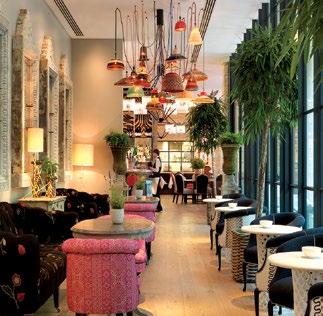
The hotel has 91 differently designed rooms, 24 luxury suites, 13 multi-purpose shops, a restaurant and a bar (both have open-
air seating). You may also use the salon, library, spa, gym, cinema, bowling and playing rooms for private events. They are designed in the style of the 1950s.
The interior designer Kit Kemp created modern, British-style artwork and received a special award for it.

1 Ham Yard, London
ACE HOTEL, SHOREDITCH
Businessmen, artists and people of “free professions” dressed in sportswear spend their mornings in the hotel’s sleek new hall. They talk, argue, occasionally send e-mails and sip beer and switch to cocktails after 5 in the afternoon. This hotel is located in the busiest district of the city.
SOHO HOTEL, SOHO

Cinema, theater and music stars who work in the Soho district arrange their meetings in the hotel’s cozy restaurant. The hotel’s 96 rooms are all different.
Prices: starting at £500
4 Richmond Mews, London
Shoreditch’s galleries, theaters and design studio hubs attract artists from around the world.
Today it is a place where art, design, culinary innovations, culture and technology unite for inspiration and future success.
100 Shoreditch High St, London
CLIVEDEN HOUSE, BERKSHIRE
Cliveden House estate's first building was erected in 1666 for the Duke of Buckingham who loved hunting. Since then, this place has suffered two fires and centuries later was owned by the Duke, Count and the Crown Princes. William Waldorf Astor finally brought the property and thus broke Queen Victoria’s heart. Since then, this house has always hosted crowded and noisy parties.
Many famous guests have come here over the years such as Charlie Chaplin, Winston Churchill, "The Beatles" and so forth.
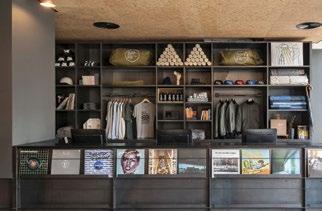
This distinguished British historic building now offers the best French cuisine for foodies. The hotel has a wonderful view of the River Thames and Berkshire. It contains a spa pavilion, gym, billiards room, indoor and outdoor tennis courts, a wharf, a helipad and a library. Its beautiful, elongated garden
has been designated a national treasure. This Italian-style historical building perfectly unites flawless Edwardian sophistication and modern luxury, excellent cuisine and sincere hospitality.
Cliveden is about 45 minutes’ drive from London. Double room price: starting at £ 250
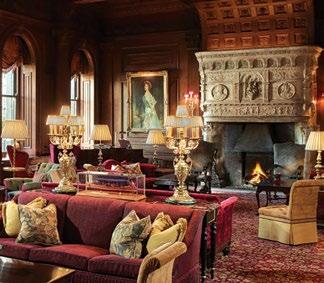
Cliveden House, Taplow, Berkshire

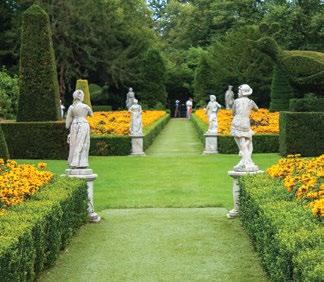
25 VOYAGER 4/2016 HOTELS
THE BEST THING ABOUT THE MAJOR BRITISH MUSEUMS IS THAT THEY ARE FREE. THIS WONDERFUL PRINCIPLE, WHICH ACCURATELY DESCRIBES THE BRITISH APPROACH TO MASS EDUCATION, WAS NOT AFFECTED BY THE FINANCIAL CRISIS OR SUBSEQUENT CUTS TO PUBLIC FUNDING. ON THE CONTRARY, BRITISH MUSEUMS CONTINUE TO HOST COUNTLESS VISITORS.
THE MAIN GOAL NOW IS TO ENGAGE VISITORS AND REVIVE THE MUSEUM SPACE. DUE TO ITS IMPERIAL PAST AND SCIENTIFIC AND INTELLECTUAL ADVANCEMENTS, BRITAIN’S MUSEUMS HOUSE INCREDIBLY RICH COLLECTIONS.


LONDON ALONE CONTAINS INNUMERABLE IMPORTANT HISTORICAL, ARTISTIC AND NATURAL ARTIFACTS THAT HAVE BEEN CRUCIAL IN THE DEVELOPMENT OF HUMAN SOCIETY AND CIVILIZATION.
V&A MUSEUM
The Victoria and Albert Museum (V & A) is wellknown to fashion fans: remarkable fashion exhibitions take place here. You can browse the museum for free. Only temporary exhibitions are ticketed; however, the main collections are so interesting that it would not be a compromise.
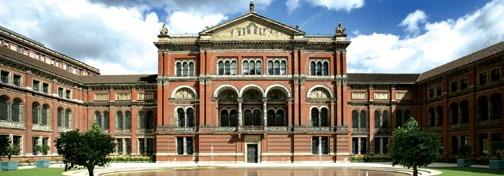

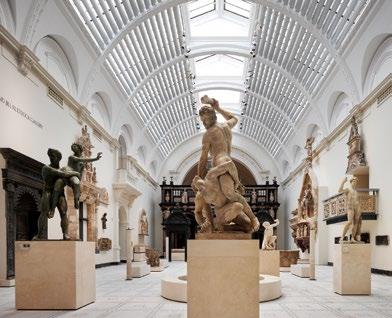
Here you can find superb collections on the history of clothing and Indian and Oriental decorative arts. It is one of the most fascinating museums in London. An unusual cafe is located outside, where you can relax after exploring the museum.
Open: 10: 00-17: 45
Friday 10: 00-22: 00; Closed on December 24, 25 and 26.
Cromwell Road, London, SW7 2RL
THE NATIONAL GALLERY
The National Gallery houses one of the best collections of Western European paintings in the world. Visitors may come here 361 days a year, free of charge. Make sure to visit Rembrandt’s "Self-Portrait" first (Hall 24).

This masterpiece competes with Van Gogh's "Sunflowers" (Hall 45), Jan van Eyck's “The Arnolfini Portrait” (Hall 56) and Piero Della Francesca’s "Baptism of Christ" (Hall 66). There is also a highly interesting un-
finished Michelangelo painting, “The Entombment of Christ" (Hall 8). It has been recently discovered that Michelangelo deliberately did not finish his work. He got a better offer, returned the payment and began a new sculpture. Art critics regard it as one of the sculptor’s drawings, so take a look at the sketch of the statue.
Open: 10: 00-18: 00 Friday 10: 00-21: 00; Closed on January 1 and December 24-26.
Trafalgar Square, London WC2N 5DN
26 VOYAGER 4/2016
"Ambassador", 1533. Hans Holbein
BY SALOME DADUNASHVILI
THE BRITISH MUSEUM
The Rosetta Stone and Parthenon sculptures are sufficient reasons to visit the British Museum, but its unbelievably rich collection could take a year to explore.
You will definitely change your ideas of perfection after seeing the Parthenon sculptures up close. Interestingly, centuries of historical and artistic developments are evident in the sculptures (Egypt’s influence on Ancient Greece, Greece’s influence on Ancient Rome, and so on).

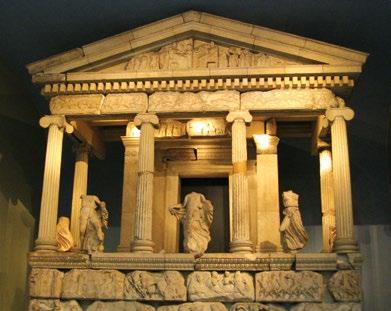
Great Russell St, London, WC1B 3DG
Open: 10: 00-17: 30, Friday 10: 00-20: 30; Closed on January 1 and December 24, 25, 26.
THE ROSETTA STONE IS MUCH MORE THAN A BILINGUAL INSCRIPTION. IT PLAYED A KEY ROLE IN DECIPHERING EGYPTIAN HIEROGLYPHS. THE TEXT ON THE STONE WAS SCRIBBLED BY PRIESTS AND CONTAINS UNIVERSAL HIEROGLYPHS. THE STONE WAS THE SOLUTION TO THE EGYPTIAN MYSTERY – WHICH WHY IT OCCUPIES THE MOST HONORABLE PLACE IN THE EGYPTIAN HALL.

London's Natural History Museum is a true miracle. Where else can you find such a wealth of collections?

The grand entrance area is almost entirely occupied by a huge dinosaur skeleton, which makes a lasting impression on children and inspires them to venture further. Here you can find the amazing gallery of evolution and a room that lets you feel earthquakes up to a magnitude of 9 on the Richter scale. To reach the core of our planet, you will have to passall of the many layers and unique
collections of minerals. There are all kinds of animal fossils and dinosaur skeletons, mollusks fossilized million years ago, huge whales and giant extinct animals ... this museum is a source of endless discoveries for children. The gallery of human evolution is the new attraction. It is very successful.
Open:10:00-17:50; 10: 00-17: 50; The museum is closed on December 24-26.
Cromwell Road, London SW7 5BD
SCIENCE MUSEUM

London's Science Museum is located over seven floors and offers educational and entertaining exhibitions. It is interesting for children and adults alike. Any child will find subjects that interest them and witness what he/she has previously only seen in books. Children may see firsthand one of the first diesel locomotive trains and the kind of capsules that the "Apollo 10” astronauts used.
The museum has an I-MAX theatre and 4D experience, where your children will be able to experience the space or even go down to the ocean depths to see a variety of rare species. These experiences are so real that they make lasting impressions.
Open: 10: 00-18: 00; permanent collections are free.
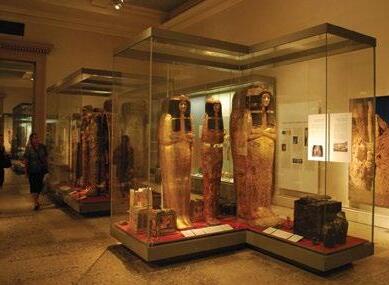
London Underground: South Kensington
Exhibition Rd, London
27 VOYAGER 4/2016 MUSEUMS
THE NATURAL HISTORY MUSEUM
DENNIS SEVERS HOUSE
An interesting experience awaits you near the City of London, where the pavements are congested during peak hours. 18 Folgate Street is very exciting. The original owner, Dennis Severs, managed to retain the property’s 18th-century atmosphere. Thus, it is in fact an opportunity to time travel.
The atmosphere is so authentic that the rules of the Dennis Severs’ House become reality. You enter the house of a Huguenot silk manufacturer, Jervis Hughes. A fire burns in the fireplace on the first floor, the powdered wig of the house owner sits on the bench,
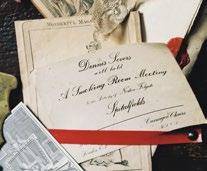
Open: Monday, Wednesday, Friday 17: 00-21: 00; price: £15. Book tickets in advance. Sunday 12: 00-15: 15; Price: £ 10 Monday 12: 00-13: 15; Price: £ 10 Booking not required.
18 Folgate street, Spitalfield, London
and his half-finished dinner is still on the table. Heavy drapes create the illusion that someone is hiding behind them. A beautiful dress prepared for wearing is spread in the bedroom, while a black cat enjoys a nap on the bed this is the only live character in the museum.
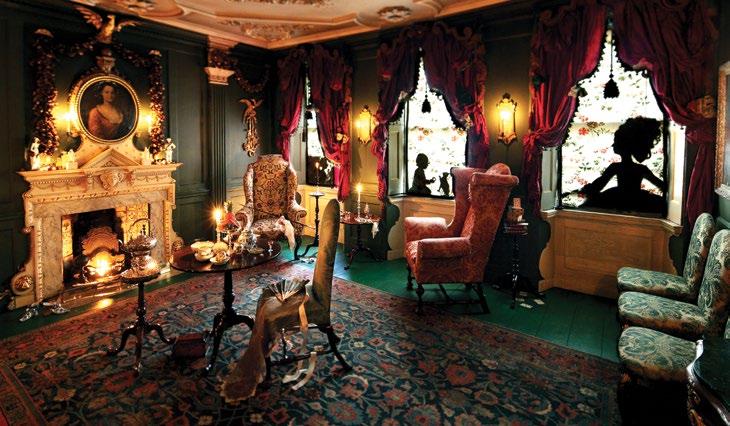
While you have to book an evening ticket in advance online, we still recommend a visit to the museum at this time. The house is lit only by the light of the lanterns and the fireplace, which makes it particularly effective. You may think of yourself as a hero
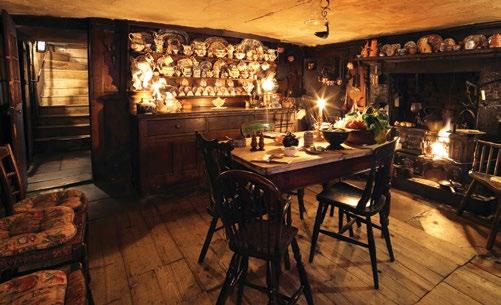
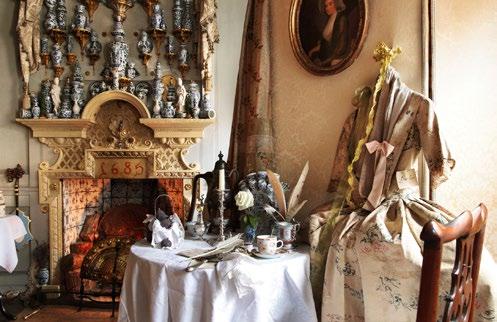
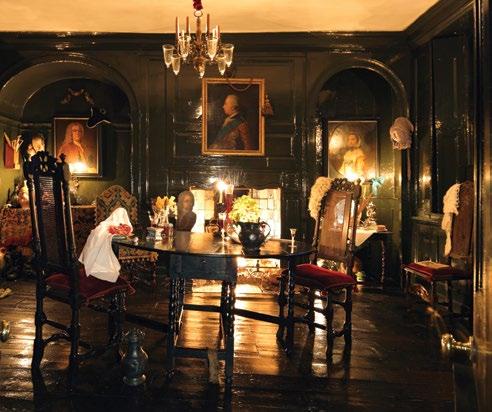
28 VOYAGER 4/2016
LONDON’S MUSEUMS ARE DOUBTLESSLY AMONG ITS GREATEST ATTRACTIONS; HOWEVER, SMALL MUSEUMS, WHICH ARE OWNED BY PRIVATE INDIVIDUALS OR FOUNDATIONS, ARE INTERESTING AS WELL.
LEIGHTON HOUSE MUSEUM
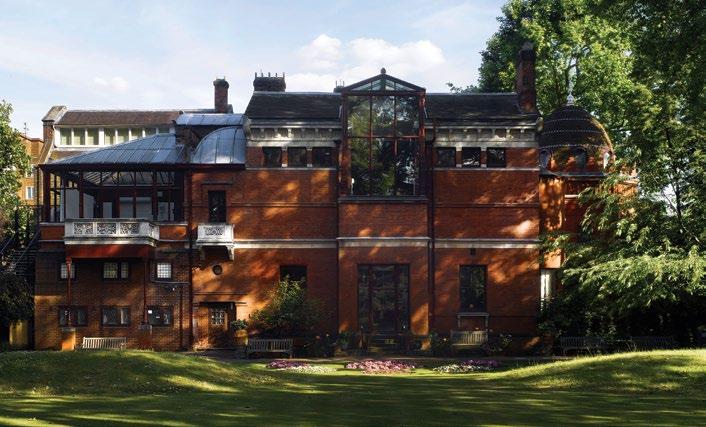
Holland Park has always been home to rich and aristocratic residencies, so a stroll through the gardens and surroundings will help you to get good overview on how London’s high-class society used to live and what their current lifestyle is like. Visit the house of Leighton, an artist with incomparable taste and a traveler with a mysterious personality, which will allow you to travel beyond the high brick fence and partake in the aristocratic life for at least half an hour.
Lord Frederic Leighton was one of the most famous artists and figures in the late Victorian era. London’s elite used to spend time at his immaculately designed house. Lord Leighton was fascinated with Eastern culture and collected Persian, Indian and Arabic art. He has an amazing collection of glazed tiles imported from the East decorating part of the large reception room. A small pool echoes with voices and niches carved in the beautiful oriental
wooden throne which occupies this space. It is impossible to convey the value of this house. It is a must-see for people who are interested in arts and crafts and interior design.
In addition, it is possible to hold receptions and dinners here. This wonderful space is highly in demand and must be booked in advance.
The museum is open every day (except Tuesday), 10: 00-17: 00
12 Holland Park Road, London
Lord Leighton was fascinated with Eastern culture and collected Persian, Indian and Arabic art. He has an amazing collection of glazed tiles imported from the East, which decorates part of the large reception room.



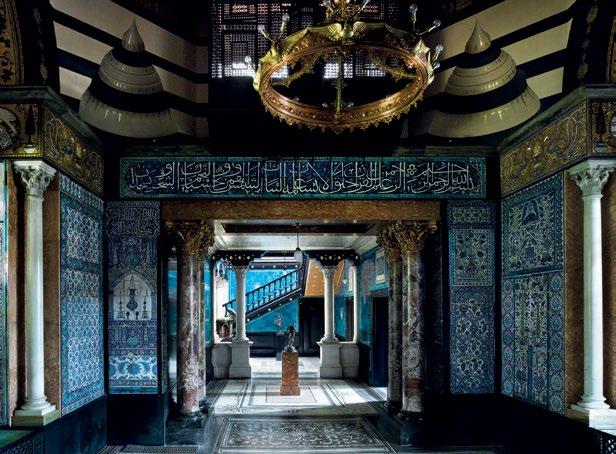
29 VOYAGER 4/2016
MUSEUMS BY SALOME DADUNASHVILI
BETWEEN THE RAIN AND THE FUN
AKA MORCHILADZE
A famous yet mysterious island, strange and firm, is located a boat ride away from the European continent. The biggest and most colorful city of this island is London – Londinium of the Roman times.
Everyone knows about this city: so many people have seen it that they can describe its attractions easily: a tall clock tower erected on the bank of the Thames beside parliament called Big Ben after its bell; red double-decker buses cruising the streets and left-hand drive cars; people lying on the grass looking at the airplanes above in the sky.
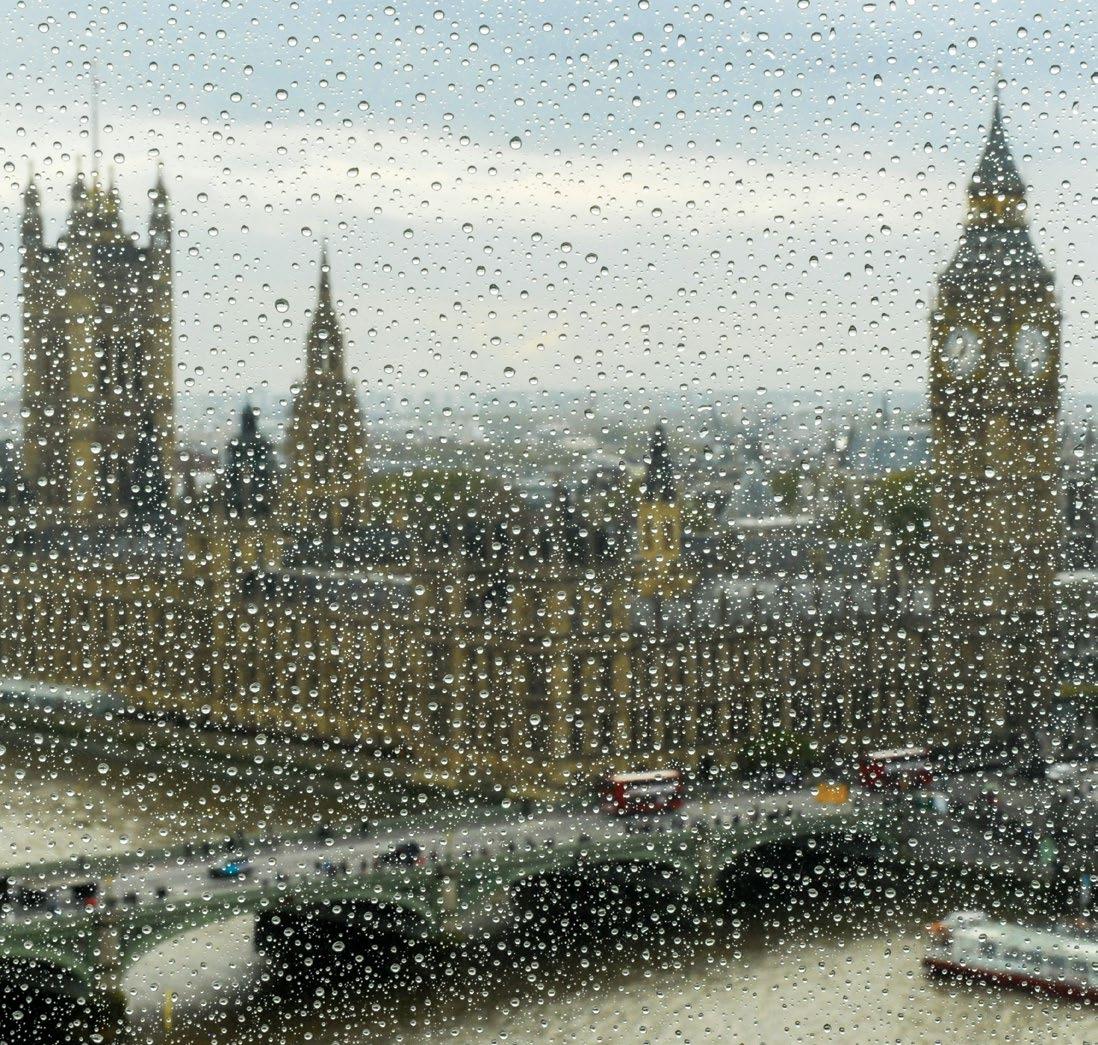
One airplane overhead is no big deal. You need to see two, or better yet, three planes to feel the real London rhythm and sense its constant motion.
People will also recall the overcrowded Tube and all of the pubs (short for public houses) adorned with flowers and lit with an antique, pink glow. These pubs have strange names: The Rooster and Horse, The King’s Head, The Seven Bells, The Crazy Bishop, The Bishop and Bear, etc., stemming from old fairy tales.
People will tell you what they’ve heard: that the city is covered in fog; it rains constantly; that the dampness gets inside your bones. Some will also say that it is the solemn capital of a shattered empire, an old monster with smog and statues of
CITY
30 VOYAGER 4/2016
kings, lords and generals covered with factory soot. They will tell you a thousand other things but when you get there you’ll see that the stuff you learned in school wasn’t true and that you must forget it. Some 400 years ago, the great writer Samuel Johnson claimed that “When a man is tired of London, he is tired of life”.
That is the truth that hits you right in the face: fun and simple things make the day here.
Samuel Johnson was smart. He was bright and educated – a man of passion. The London of his time was a place for travelers and guests, just like it is today. Obviously the numbers were different (fewer zeroes) but the city’s main theme was the same: get immersed in it and have some fun. It seems that that’s how it has been from the beginning.
It is probably surprising that a place with such a soul could existed in “that” old England. Today, everyone knows that London is different from the rest of the UK.
This became especially apparent in the UK’s recent referendum, where the majority of the UK voted to exit the European Union while London voted to remain. This was not because London simply benefits from being part of the European Union; no, it’s because London is a city of the world, and has been for centuries. Only a handful of such cities exist.
This is the strange and incomprehensible position that London occupies, probably based on its history and economics. We could debate at length how much of Britain is in London or vice versa but it is easier to just admit: both. Generally, Britain is a mix of cultures and nations and London is a British cocktail comprised of many cultures, languages and nationalities. It is like a drink with lots of peaches, cucumbers and strawberries, which goes so well with the London summer, especially if you’re watching the cricket or a polo match.
The main thing about London is the hope that this is a good day, good relations and good environment. Europeans don’t really like the British, often claiming that they hate their pragmatic, business-oriented and snobby – in other words superior, closed and stuck up – manner. The British often in turn criticize the continent but nonetheless never leave. Why won’t they go away then?
Such statements are usually followed by musings about the British Empire, the weirdness of this little isolated island state… You can be forgiven for believing all of these claims – that is, until you give yourself to the streets of London. Then you will forget everything.
Generally, nowhere else can one find such good manners, humor and interesting conversation. They know how to turn ordinary words into extraordinary sayings here. Call it cold and closed up all you want but there is no other big city that offers so much warmth.
It is hard to find another place where strangers meet and greet each other. London has a unique quality of language, color, fun and, what’s more, infinity.
London is interesting everywhere: Buckingham palace; Richmond Park; the house that used to be a church, then a synagogue and is now a mosque; by the riverside; in a small, dusty theatre; in the flea market; and in a Hackney cab. Tourists usually stick to the attractions in Westminster, Mayfair and the West End, which is more than enough, but London is interesting in its entirety.
It is a special city where old roads have turned into streets; an old city created around the East and West End. It gradually adopted more than a hundred villages in the south embankment and has (cautiously) turned them into its famous districts. It did not destroy their forests or the taverns but united all of the different spaces with railroads. The villages also merged with the city slowly but stubbornly as well, with foxes running, birds singing, flowers blooming and a countryside peace settling in the backyards. This is why the city unites urban and rural yet somehow they are together rather than apart.
Everything starts to look alike in the modern world and relations are simplified and colder, though this city somehow manages to retain peaceful and passionate fun, from the city’s crazy sunrise to a tranquil evening in Kew Gardens. Everything is united and harmonious here.
Is this a simple city? It’s a complicated and expensive city, with a tiresome workweek and people fighting for survival. However, it remains a place where strangers still talk to each other, and this meaningless chatter sets the tone for further action.
In the end, London has one natural and quiet rule you better learn now rather than as a result of trial and error: Whoever you are, wherever you are from, never try to impress Londoners.
All of the proverbial coldness, snobbishness etc. comes down to this: nothing surprises them.
This is a result of either life or history. This is a result of the city’s life for centuries, amazing in its own right. You will be surprised by the city’s soul where nothing is separated or ranked.
The city was re-built by Sir Christopher Wren after the Great Fire of 1666. More buildings were erected during Victoria’s reign, with strange smells coming from the sunbaked wet cobblestones, the East End’s shantytowns and the expansive parks.
London is a glass of ale and an enormous serving of fish and chips, sharp-tongued elderly folk, mountains of oysters and all the gold in the world hauled by the mariners to the Treasury over centuries; it is unexpected clothes and the freedom of a thousand colors; everything together is unified. This is a mixed town.
BRITISH FOOD AND DRINK IS RIDICULED ON THE CONTINENT, WHICH IS ONLY SEPARATED FROM THE ISLAND BY A STRAIT. THUS, A COCKTAIL NAMED LONDON WAS BORN, THE ONE AND ONLY. BEST ENJOYED FROM A BOTTOMLESS CUP.
31 VOYAGER 4/2016
Five o’clock Tea
Five o’clock tea is a centuries-old tradition. While regular British people regard afternoon tea or five o’clock tea as a light dinner, the nobility pays special attention to this ritual. We recommend that travelers find time to join in with this tea ceremony.

Tea was brought to England in the XVII century: The English East India Trading Company gave it as a gift to King Charles II. Queen Catherine turned it into the official drink of the palace. This is the origin of the English tradition of pouring the milk first and then adding the tea: the exquisite china that was used for the tea ceremony was so fine that it could be damaged by the boiling water. Thus, room-temperature milk was poured before adding the tea.
Ana, the Duchess of Bedford, turned it into a national tradition.
Ana got very hungry between lunch and dinner, since the evening dinner commenced at 8:30-9:00pm. The Duchess ordered tea with bread and butter and cakes in between the two meals. This initiative soon became fashionable amongst the nobility and turned into the solid tradition of the Victorian era. The best hotels have arranged tea ceremonies for the elegant London society and foreign guests since 1880.
TRADITIONAL TEA VARIETIES SERVED AT TEA CEREMONY: ASSAM, CEYLON, LAPSANG, KENYAN, DARJEELING, ENGLISH BREAKFAST, ENGLISH AFTERNOON, EARL GREY, ROSE POUCHONG, RUSSIAN CARAVAN, ETC. TEA CEREMONIES ALSO INCLUDE ADDITIONAL GREEN, WHITE, RED AND HERBAL TEAS, AS WELL AS DECAFFEINATED TEA.
The classic tea ceremony includes the following triangular or rectangular finger sandwiches: cucumber and butter; cheese and smoked salmon; hard boiled eggs, cress salad and mayonnaise; and shrimp and Marie Rose sauce.
The tea table always includes the following fresh pastries: fruit cake, Victoria sponge cake, chocolate cake, ginger bread, and finger biscuits. Fruit baskets are also necessary. Carrot cake, cheesecake and other cakes are added nowadays.
5 O'CLOCK 5 O'CLOCK TEA IS ONE OF THE MOST PREVALENT UK STEREOTYPES. TEA TIME WAS NEVER STRICTLY ORDAINED HERE; RATHER IT IS ENJOYED SEVERAL TIMES A DAY, DURING FREE TIME. THE TRADITIONAL AFTERNOON TEA MAY BE SERVED ANY TIME BETWEEN LUNCH AND DINNER.
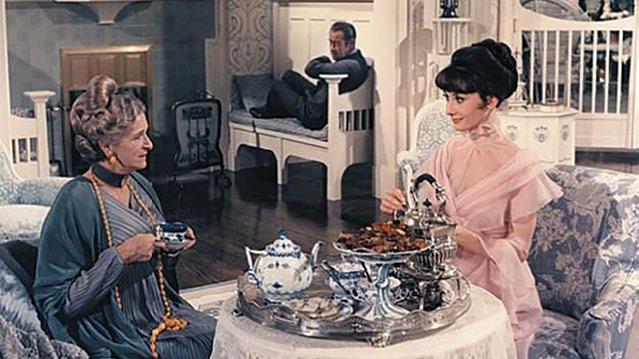

32 VOYAGER 4/2016
THE LONDON EDITION
This hotel maintains the XIX-century tradition of “Scandal Water”, when London's aristocracy gathered here to taste exotic tea and hear the local scandals. The tea ceremony is held on Friday and Saturday 15: 00-16: 00; Price: £ 35
10 Barnes St, London
THE RITZ HOTEL
The Ritz has been offering afternoon tea since 1906. The tea-drinking etiquette is emphasized (jeans and sportswear are not recommended; men are required to wear a jacket). You can enjoy the best sandwiches in London with tea here.
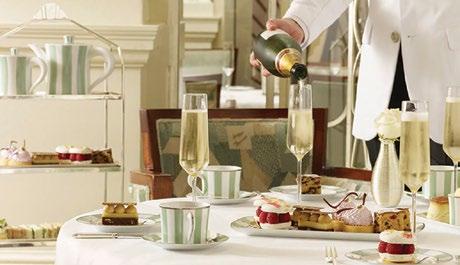
Palm Court (Ritz hotel) can be regarded as London's most famous tea ceremony. A strict dress code is in place; bookings must be made six weeks in advance.

Open: 11: 30-19: 30; Price: £52; with champagne: £68
150 Piccadilly, London
HOTEL CAFE ROYAL
Taste perfectly prepared tea in the Oscar Wild Room and, at the same time, listen to the truly immortal phrases of this London celebrity writer, voiced by an elegantly dressed MC.
Open: 12: 00-16: 00; Price: £ 42,
With champagne: £ 55
68 Regent St, London
FORTRUM & MASON
Fortnum & Mason has been importing and brewing 82 varieties of tea since 1707.
The Diamond Jubilee Tea Salon offers the best traditional tea in London with delicious pastries and sandwiches.

Open: 12: 00-19: 00; Price: £ 44/48
181 Piccadilly, London
CLARIDGES HOTEL
Visit this hotel for a unique experience: the extremely elegant and, at the same time, informal space will offer you 150 years of hotel experience developed to perfection. Try the Second Flush Muscatel Darjeeling tea.
Open: 14: 45-17: 30; Price: £ 58
With champagne: £ 68/78
55 Brook St, London
SKETCH
Enjoy a traditional afternoon tea with a Comté cheese panini in the famous club and gastronomic art center, in the eccentric interior designed by David Shrigley.

Open: 12: 00-16: 30 (after 21: 00 for club members only).
Price: £ 45, With champagne: £ 57.
9 Conduit St, London
BROWN'S HOTEL
Agatha Christie set her "At Bertram's Hotel" in this legendary hotel. Here you can taste the first true "English tea" (harvested on English soil in Cornwall). Brown's Hotel was Queen Victoria’s favorite spot for afternoon tea; the place is still popular in high society today. The famous kitchen focuses on healthy meals. Reservations recommended.
Open: 12: 00-18: 30; Price: starting at £ 47.50 With champagne: starting at £ 55.
33 Albemarle St, London
33 VOYAGER 4/2016 TEA HOUSES
POSTCARD TEAS
The store sells teas that are produced in small amounts, on land plots less than six hectares in six Asian countries (India, Japan, Korea, China, Taiwan, and Vietnam). Here you can buy handmade pottery and accessories for tea.

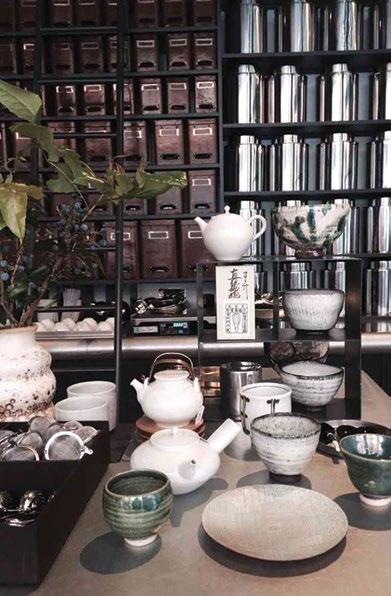
Open: 10: 30-16: 30
The tea house has two addresses: 9 Dering St, London; New Bond St, London
TREGOTHNAN TEA
Earl Gray was the British prime minister in the 1830s. He discovered the famous tea flavor "Earl Gray”. His descendants own a tea plantation in England, Cornwall, where the Tregothnan tea is produced. You can buy the tea in shops or online.
MY CUP OF TEA
You will find yourself in a fragrant fairy tale when you step into the Ausraburg tea shop, located on the first floor of the Ham Yard Hotel. Boxes of different colors and sizes crowd its shelves.
Therapeutic tea blends are sold at the back of the store. The tea is sold by weight. Here you can witness the whole process of brewing. Tea is sold in white canvas bags. Here you can buy tea cups, kettles, dishes and accessories.
Open: 10: 00-19: 00
5 Denman Place, London
BISCUTEERS
If you want to make your children’s dreams come true, you will definitely want to take them to the Biscuteers. It's a little pastry shop that creates differentshaped pastries, like umbrellas, doubledecker buses and Notting Hill Street. Make reservations in advance to involve your child in this activity.
TAYLORS OF HARROGATE
Taylors of Harrogate is located just three hours away from London by train in Yorkshire. Prince Charles awarded the company his royal warrant in 2009, since
LANKA
Japanese confectioner Masaiuki Hara makes delicious green-teainfused pastry and bakes the best pastries in a London. It melts in your mouth.

Open: 10: 30-18: 30; closed on Mondays.
Finchley Road, 9 Goldhurst Terrace, London 194 Kensington Park Road, London
FORTNUM & MASON, PICCADILLY
The bergamot-flavored "Earl Grey" is spectacular and, apparently, is the reason why the store has operated for three centuries.
Fortnum & Mason in the unique shopping center of Piccadilly is an ideal place to choose a gift. Its shops are also located at Heathrow International Airport and in St Pancras’ railway station.
The store supplies the Royal Family. The trading location was established by two lackeys of King George III. Fortnum & Mason is famous for its tea and was the first shop to sell roasted coffee beans.
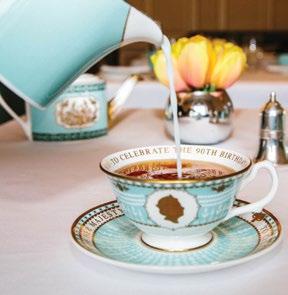
181 Piccadilly, London
this tea or coffee comes from different regions of the world and is of premium quality. The firm also owns a well-known network of tea houses called Betty's.
www.bettysandtaylors.co.uk
PRIMROSE BAKERY

If you are tired and longing for something sweet, visit Primrose Bakery. This bakery is so vivid and well-known for its cupcakes that you will feel better before you’ve even had your dose of sugar.
42 Tavistock St., London
MAISON BERTAUX
The oldest confectionery in London is located in Soho. It offers the best rolls and coffees with milk, under a bluewhite striped marquee.
28 Greek St., London
34 VOYAGER 4/2016 TEA HOUSES
Only7%oftheBritishrichareself-made men. Three-quarters of the rich have inherited between 25 and 250,000 pounds; the rest have inherited even more. They form three elite groups: the traditional aristocracy who own land; descendants of XIX-century financiers, who subsequently launched big businesses; and descendants of North England entrepreneurs, who got rich via the textile industry.
Old money is more respected in the UK. Wealth is not an end in itself, rather it opens access to high society and a characteristic lifestyle. British high society is a closed caste, unified by family ties, marriages and joint financial interests. Proximity to high society is symbolized by membership of privileged clubs.
IT IS ALMOST IMPOSSIBLE FOR A STRANGER TO ENTER THIS WORLD. WEALTH ALONE DOES NOT GUARANTEE ENTRY; IT IS NECESSARY TO BE BORN INTO THE RIGHT FAMILY, AND THEN BE EDUCATED AT ETON THEN CAMBRIDGE OR OXFORD; THIS WILL DETERMINE ONE’S FINANCIAL AND SOCIAL STATUS.
BOODLE’S (1762)
The club was founded by the British Prime Minister, Lord Shelburne. It remains one of the most prestigious venues in London. To get into club, you will need to pass a strict screening process. Winston Churchill and Ian Fleming were among its members. The fee is set in accordance with the requirements of the members.
28 St James's St., Mayfair
THE GARRICK CLUB (1831)
Here you can dine, enjoy the benefits of its rich library or rent a room. The precious wooden interior, fireplace, terrace and wine cellar are among its attractive features. Women are rarely allowed into this perfect place. Charles Dickens and HG Wells were among the members of the club. The fee is unknown to the general public.
15 Garrick St., Covent Garden
BLACKS (1764)
This bohemian place is considered to be the antipode of White's. Its fireplace, coziness and Italian style attract writers and journalists. To be admitted to the club, you should be "extraordinarily interesting". The membership fee is secret.
67 Dean St., Soho
WHITE’S (1693)
Former Prime Minister David Cameron, Princes William and Prince Charles currently visit this little aristocratic cozy club. Its private hall for dinner, and its billiards and reading rooms create a unique atmosphere. There is also a small bar. A wild bird meat sausage is among its famous dishes. The annual fee is 850 pounds.

SAVILE CLUB (1868)
This club has an ideal setting for celebratory dinners. The Duke of Edinburgh is the owner of the club. Its members have included Robert Louis Stevenson, HG Wells and Rudyard Kipling. The annual fee is 1,061 pounds.
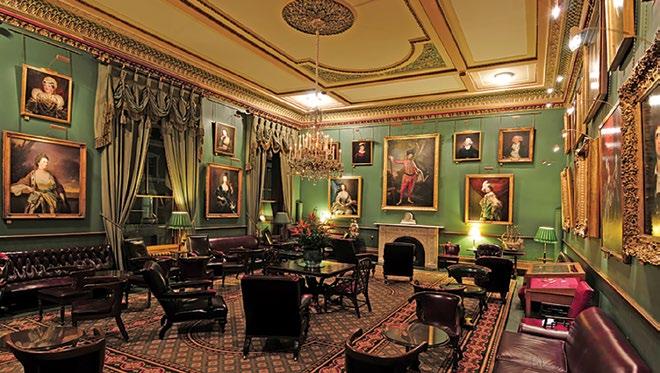
69 Brook St., Mayfair
THE GROUCHO (1985)
Significant members of society gather at this club founded in honor of the silent era film comedian, Groucho Marx. Apparently, Bill Clinton once played the piano here. If you befriend a member of the club, they can invite you as a guest. The initial deposit is 695 pounds, and membership will also cost you 695 pounds.
45 Dean St., Soho
THE ARTS CLUB (1863)
The creative elite of London meet here; subsequently, gin and tonic flows like a river. The club has recently updated and transformed into a modern exhibition and concert area. The initial joining fee is 2,000 pounds.
40 Dover St., Mayfair
THE MARK'S CLUB (1973)
Women are allowed in this club. Formal attire remains a necessary rule. Its refined interior design and cuisine are tailored to the taste of guests. The fee is 2,000 pounds.
46 Charles St., Mayfair
35 VOYAGER 4/2016 CLOSED CLUBS
The Garrick Club
37 St James’s St., Mayfair
ENGLISH BREAKFAST
THE TRADITIONAL, OR FULL, ENGLISH BREAKFAST IS SERVED ON A HUGE PLATTER AND INCLUDES SCRAMBLED OR FRIED EGGS, FRIED BACON, DIFFERENT TYPES OF SAUSAGES (INCLUDING BLACK PUDDING –SAUSAGES MADE FROM BLOOD), MUSHROOMS, TOAST WITH BUTTER AND JAM, GRILLED TOMATOES AND PERHAPS BAKED BEANS IN TOMATO SAUCE.

THE BEST BREAKFAST PLACES IN LONDON
BREAKFAST CLUB
price: £10
33 D'Arblay St, Soho
HAWKSMOOR
GUIDHALL
price: £16
10-12 Basinghall St, City
CARAVAN KING'S CROSS
price: £10.50
1 Granary building, Granary
THE RIDING HOUSE CAFÉ
price: £14.50
43-51 Great Titchfield St, Fitzrovia
REGENCY CAFÉ
price: £20
17-19 Regency St, City of Wensminster
The full English breakfast is truly a remarkable phenomenon and given its size, we conclude that it was designed for men. One can imagine the residents of the castles scattered on the green hills of England having such a breakfast before they left to hunt.
Neighboring farmers would have had a similar meal, in the same quantity, but with more modest ingredients. It is truly a shared event with the only difference being the quality of the ingredients or the standard of the cook.
It may not look very impressive, but if you have a long day ahead of you and want to avoid pangs of hunger, a full English breakfast is just the thing.
However, it is very important to know where to get it. Your choice of venue might make you
THE WOLSELEY, Piccadilly
This former car showroom was renovated as a café in the European tradition in 2003 and is redesigned in a way that transports visitors back several centuries. The main dish, eggs benedict, satisfies every taste. Don’t be alarmed by the grandness of its name, the environment is very cozy and suitable for business meetings.
Open from 7.00 am price: £17.50
160 Piccadilly, London
fall in love with the meal or you will be completely disappointed. The Wolseley, an art deco style café/restaurant next to the Ritz Hotel is one excellent option. If you are not in the mood for the full breakfast option, you can choose different versions from the menu. Breakfast for two will cost you around £70.
If you are in a whimsical mood and Alice in Wonderland is your favorite book, you should definitely visit Sketch. This famous restaurant was founded 10 years ago and retains its freshness. We advise you to order porridge or oatmeal. This is also a very typical English dish, though the normally boring porridge is elevated to another level at Sketch. The oatmeal is cooked with coconut milk and sweetened by caramelized banana that can make even an anti-porridge skeptic surrender.
EVERY GOOD RESTAURANT AND CAFÉ IN LONDON GETS BUSY AROUND BREAKFAST, LUNCH AND DINNER; HENCE, IT IS ADVISABLE TO RESERVE TO AVOID DISAPPOINTMENT AND LONG QUEUES.

YOU SHOULD ALSO BEAR TIMING IN MIND.
BREAKFAST IS ONLY SERVED UNTIL 12 PM.
36 VOYAGER 4/2016
RECOMMENDS
SKETCH
When Sketch first opened its doors to the citizens of London, getting a table was almost impossible for the first couple of months. The design of the club is as uncommon as the art that is displayed on its walls, floor, foyer and bathrooms.
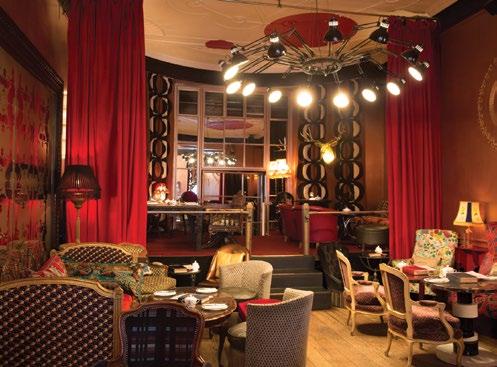
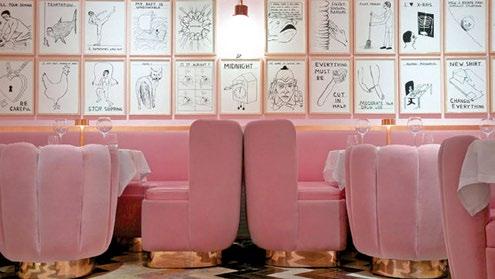
The Sketch is truly a gallery of modern art; there you can see a chandelier by our compatriot Tamar Kvesitadze. The chandelier is on sale, just like the works of other artists that are exhibited in the gallery. If you are interested in any of the artwork, you can inquire about the price.
Each step in Sketch is a journey. The egg-shaped bathrooms have become legendary but the rest of Sketch is worth visiting as well.
The club is open from morning until late. Monday-Friday it is open from 8.00 am to 02.00 am and on weekends from 10.00 to 02.00 am.
In the morning you can have a very comforting breakfast but you should be aware that Sketch appears to have been designed by Alice’s friend, the mad hatter. You can have tea in the Chinese hall around 5 pm where all walls are painted in Chinoiserie style. In the evenings, the hall is transformed into a bar from 18.00 until 02.00 and leaves you a feeling of being in the 1920s in the US, sitting in a velvet-covered, shellshaped couch.
From 21.30, only members of the club may enter.
9 Conduit St, London
DARK SUGARS CHOCOLATERS
Don’t miss this amazing chocolate shop. The delicious chocolate is prepared with passion and unusual ingredients such as vodka and orange cider, strawberry and champagne, lemon and tea.

The only shortcoming of the place is the risk of becoming addicted.
141 B rick Lane, London
CHIN CHIN LABORATORISTS
This café is for ice-cream lovers. The ice-cream is prepared by molecular technology and the place resembles a laboratory. Magical fat-free desserts are created in a whirlwind of liquid nitrogen generated steam, with ingredients as exotic as bergamot or sea salt.
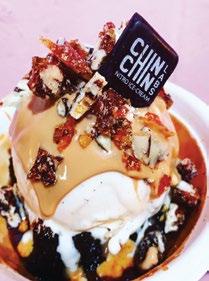
49-50 Camden Lock Place, London
SCOOP
KAFFEINE
Apart from various types of strong coffee, here you can find a huge variety of pastry, biscuits, exotic spices, jams, cookies and sweets, all of which are prepared in the shop.
66 Great Titchfield St, London
TALKHOUSE COFFEE
Here gourmands are offered a high-quality coffee that is ground in an aero press mill and served with a side dish of hackberry jam pancakes with maple syrup.
275 Portobello Road, London
The ingredients for icecreams are brought from all around the world to this famous café. Cacao from Ecuador, wine from Sicily, walnut nougat from Piedmont, vanilla from Madagascar and French Polynesia, and cinnamon from Sri Lanka. The ice cream has the gorgeous taste of the world.
40 Short's Gardens, London LICK
This is the best place to buy the most delicious icecream and eat it as you walk through Soho. Whatever taste you choose, whether classic vanilla or lavender, they will blend it into a gelato on your request or serve it with Belgian waffles.
55 Greek St, London
37 VOYAGER 4/2016 GASTRONOMY
OYSTERS AND MEAT PIES; PUDDING AND JELLIED EELS
STRANGELY ENOUGH, OVER THE YEARS BRITISH CUISINE HAS SIMPLY BEEN KNOWN AS DULL FISH AND CHIPS WRAPPED IN OILY PAPER. IF YOU WANTED A BIT MORE VARIETY, YOU HAD TO VISIT AN INDIAN RESTAURANT. HOWEVER, EVERYTHING HAS SINCE CHANGED, AND NOW THE UK, ESPECIALLY LONDON, IS RESTAURANT MECCA.
Martin Blunos is a Michelin-starred chef, famous not only for his restaurant but for his frequent TV appearances. He moves forward with surprising optimism in his highly competitive industry, especially in England where the best chefs around the world offer a wide range of cuisines.

It’s surprising that a nation of islanders surrounded by water has so few fish dishes...
Yes that’s true. Due to the power of the aristocracy for centuries, all foods that were difficult to obtain and required hard work to prepare were considered unworthy – that was the fate and the food of the poor. For example, only the poorest people ate oysters, as oysters were much cheaper than beef. Think of a traditional meat and oyster pie: a small amount of beef blended with quite a lot of oysters (cooked oysters have a meaty texture), thus saving money. The English did not previously eat a lot of fish; most of it was exported to France and Spain.
The popularity ascribed to chefs over the past 20 years and the healthy approach to food being championed in the industry have changed British cuisine considerably. You could not find lemongrass 20 years ago but now it is everywhere. People want to eat more fish and healthier foods.
TRADITIONALLY, BRITAIN IS A MEATEATING COUNTY. BEEF, PORK AND LAMB ARE EXTREMELY POPULAR. WONDERFUL SHEEP GRAZE IN THE WELLS FIELDS AND IN SCOTLAND, WHICH IS ALSO FAMOUS FOR ITS BEEF.
Frequent rain results in excellent grazing grass. Traditional sorts of beef were under threat for a time due to intensive farming, with cows being raised too fast. This approach has changed too – many small farms now provide traditional varieties of beef that are tender and juicy.
The same goes for cheese. In fact, Britain did lose cheddar, while the French took special care of their cheese. The real cheddar had to be cultivated anew in Britain. Almost forgotten cheeses are
38 VOYAGER 4/2016
SALOME DADUNASHVILI
Beef cooked with traditional vegetables is the main dish in Britain. Roast beef or Beef wellington is a good choice.

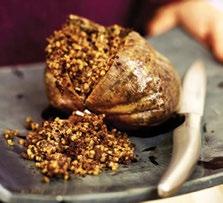
now being re-established – for example, the famous soft cheese from Bath, reminiscent of camembert.
What about fruit and vegetables?
The potato is the queen of British cuisine. Not chips but mashed potato. Early potatoes are extremely popular in Jersey County. Green asparagus is wonderful here too. It grows longer due to the bad weather and is more flavorful.
British apples and strawberries must be mentioned. Strawberries and cheddar with whipped cream used to be a wonderful traditional dessert. Cream and strawberries are two of the UK’s key natural resources. Scottish raspberries are amazing, and “Victoria” plum is world-renowned. These fruits have been growing in Britain naturally for a long time and have always been part of British cuisine.
What traditional dishes come to mind?
ROAST BEEF, OF COURSE. IT IS THE COUNTRY’S MOST FAMOUS DISH. I’D ALSO LIKE TO MENTION THE GRAVY MADE FROM THE JUICES THAT DRIP FROM THE ROASTED MEAT.
It’s the gravy that makes the dish; it is not a case of the sauce masking the meat. Add a bit of flour and butter to the meat juice and you have an excellent gravy. Cider can also be used.
It is very hard for us to understand what pudding is. It may be sweet or savory. Could you please explain to us what pudding is?
Pudding is just another word for dessert. Most puddings are sweet. A pudding may look like a cake, or contain cream or fruit jelly layers. For example, the posset pudding is made of cream, sugar and lemon juice. We heat up the cream, add sugar and lemon and it gets that jelly-like texture once it cools due to the lemon and the fat in the cream.
BEEF WELLINGTON

SIMPSON'S IN THE STRAND
Open: 7:15-10:45; 12:00-14:45; 17:45-22:30
Price: £32.50
100 Strand, Covent Garden
THE HEMINGWAY
Open: 12:00-24:00
Price: £38 (meal for two)
84 Victoria Park Road, South Hackney
TO
TASTE TRADITIONAL BRITISH DISHES, VISIT:

THE RITZ
Open: 12:30-14:00; 17:3018:30; 19:00-22:00
Price: £80 (meal for two)
150 Piccadilly, London
39 VOYAGER 4/2016 GASTRONOMY
Sugary desserts are our imperial heritage. We used to sweeten desserts with honey before that. British life has changed since the emergence of sugar. Did you know that ladies used to paint their teeth black? It was fashionable because teeth blackened by sugar meant a big income and high social status. Sugar was a royal privilege. I think we went crazy for sweet things after that (laughs). Ale was also created with honey. It was the most common drink for centuries. This was because the water was so bad; water made you sick, while ale and beer did not.
HAWKSMOOR KNIGHTSBRIDGE
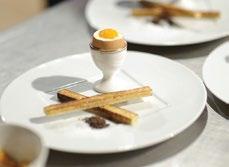
Best place to taste British roast beef – a real paradise for meat lovers.

Open: Sunday - 12:00-21:30
Monday-Saturday: Lunch 12:00-15:00
dinner: 17:00-22:30
3 Yeomans Row, London
M.MANZE
Best place to try pie, mash and green liquor
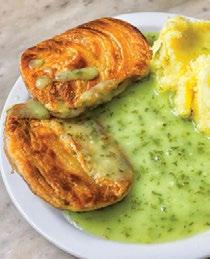
87 Tower Bridge Road
105 High St, Peckham
226 High St, Sutton, London
Potato is the queen of British cuisine. Not chips but mashed potatoes.
Court doctors are credited with the creation of the famous British lamb with mint sauce dish. Every disease was cured according to the four types of temper – sanguine, choleric, melancholic and phlegmatic. The medieval recipes of this dish show us that it aimed at balancing the tempers. Thus, some recipes were invented by doctors.
Religion prohibited meat-eating on Fridays so eel dishes became popular. Eels are hard to manage, so they were placed pots of wine. The poor eels drowned but the acidity rid their skin of its natural sliminess and marinated them. Afterwards, the eels were roasted or boiled and aspics were made.
Many recipes call for entrails.
This was, of course, because a good housewife used every part of an animal and nothing was thrown out. Even bone marrow was cooked. Today we thoughtlessly throw away food and buy more than we need whereas everything was more costly in the past. Food changes with the centuries. We use less energy than we did in the 19th century. People used to work harder and needed more energy.
We would probably die if we ate what the 19th century farmers ate. That’s a Full English breakfast for you: scrambled eggs, sausages, black pudding (blood sausage), bacon, mushrooms, beans— this is a wonderful combination if you need to stay physically active all day.
Please recommend dishes that we have to try in Britain to understand British cuisine.
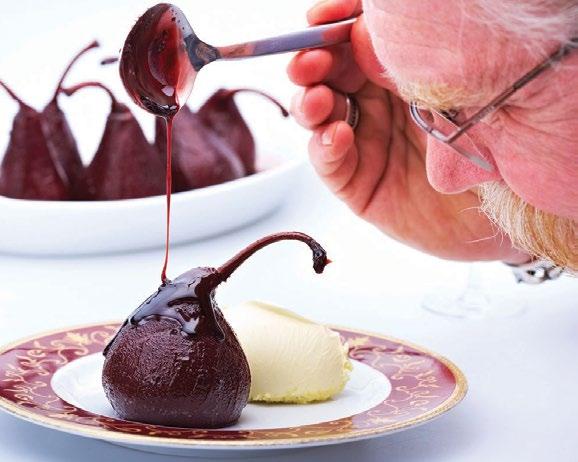
Beef cooked with traditional vegetables is the main dish in Britain. Roast beef or Beef wellington is a good choice. Try real, good-quality cheddar and apples. It seems like a simple combination but it is a real English dessert.
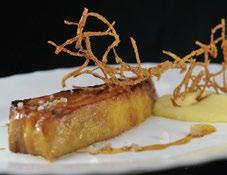
Fish and chips are poor people’s food so if you serve lemon with it, it’s not authentic. Only vinegar could be afforded with this dish. So if you want to taste real fish and chips, ask for vinegar.
Haggis is a national Scottish dish. Nowadays half of Scotland has never tried it. Boiled sheep's pluck (heart, liver and lungs) with black pepper encased in mutton stomach is simply not attractive
40 VOYAGER 4/2016
EVERYTHING HAS CHANGED, AND NOW THE UK, ESPECIALLY LONDON, IS RESTAURANT MECCA.
The River Thames provided eels for ordinary people. It was, in fact, a free product, so its preparation is an old tradition. Jellied eels is a traditional dish.

anymore. However, if you’re in Scotland, try some real haggis with mashed local sweet parsnip and real whiskey.
Pie, mash and green liquor is one of the most famous dishes of British cuisine. If meat and game were the aristocratic food, the lower social strata ate this simple but satisfying food.
The River Thames provided eels for ordinary people. It was, in fact, a free product, so its preparation is an old tradition. Eels produce an abundance of jelly during boiling. The jelly and broth are placed in the containers. Jellied cubes were formed after cooling which were then used to make the green liquor – a sauce made with coriander.
Pudding is just another word for dessert. Most puddings are sweet. Puddings may look like a cake, may contain cream or fruit jelly layers. For example, posset pudding is made of cream, sugar and lemon juice.
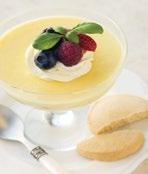
FISH & CHIPS
POPPIES
Open: 11:00-24:00; price: £7.00
30 Hawley Cres, Camden, London
THE GOLDEN UNION FISH BAR

Open: 10:30-22:00; price: £9.50
38 Poland Rd, Soho, London
KERBISHER & MALT
price: £6.00
164 Shepherds Rd, London
COCKLES
BOROUGH MARKET
Open: 10:00-17:00
Southwark St, London
TOAD IN THE HOLE
The Windmill
Open: 10:45-22:30
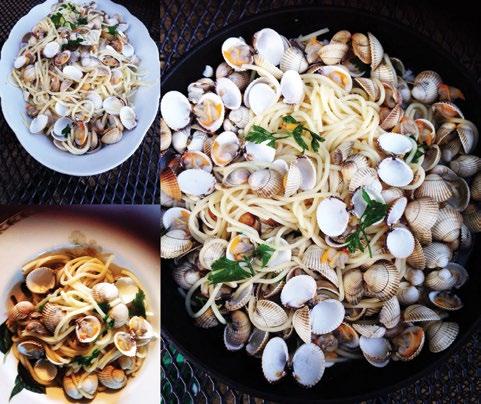
6-8 Mill St, Mayfair, London
BANGERS AND MASH MOTHER MASH
Open: 8:30-22:00
26 Ganton St, London
PIE AND MASH
PIEMINISTER
price: £6.50
56 Gabriel's Wharf,
56 Upper Ground, London
YORKSHIRE PUDDING

ANCHOR & HOPE PUB
Open: 17:00-23:00
price: £12
36 The Cut, Newington, London
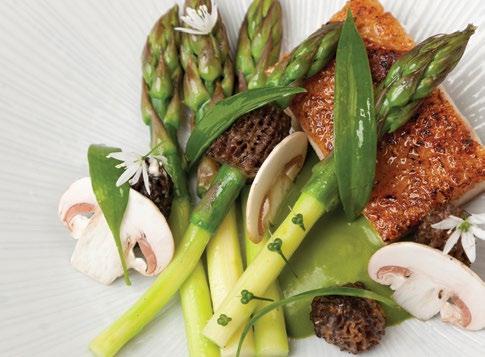
SHEPHERD'S PIE

THE IVY RESTAURANT
Open: 8:00- 23:30
1-5 West St, Covent Garden, London
THE WINDMILL
Open: 11:45-11:00
6-8 Mill St, Mayfair, London
TOM'S KITCHEN
27 Cale St, Chelsea, London
THE THREE STAGS
67-69 Kennington Rd, London
THE WINDSOR CASTLE
Open: 11:00-24:00
114 Campden Hill Rd, Kensington, London
41 VOYAGER 4/2016 GASTRONOMY
LONDON’S BEWITCHING CHARM ATTRACTS MANY PROMISING CHEFS AND RESTAURATEURS FROM AROUND THE WORLD. WE HIGHLIGHT THE VARIOUS CULINARY MASTERPIECES THAT HAVE DIFFERING REQUIREMENTS.

THE LEDBURY, NOTTING HILL
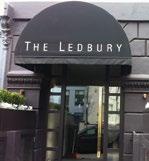

Australian Chef Brett Graham began cooking at the age of 15, and became famous early on. He worked at Sydney restaurant Banc, where he won the prestigious Josephine Pignolet Award. He was then given opportunity to travel to the UK.
The chef tries to use natural British ingredients as often as possible, especially when it comes to the vegetables. He believes that his winning dish is grilled fish and smoked eel with Celtic Mustard. Graham Recently started implementing so-called probiotic techniques to utilize the kitchen waste fully. He packs food in special 5 kg bags that customers may use at home for their plants and gardens.
The a la carte menu costs £90, while the lunch menu costs £45.
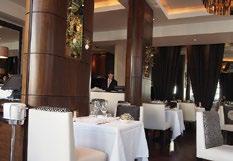
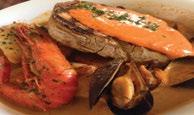
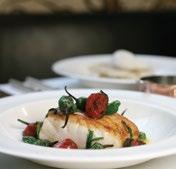
127 Ledbury Rd, London
SCOTT’S, MAYFAIR

This beautiful, slightly old-fashioned restaurant is famous for its seafood. Irish Chef Dave McCarthy prepares delightful mollusks and crab dishes. If the weather allows, we recommend tasting these dishes outside under the famous black Marquee.
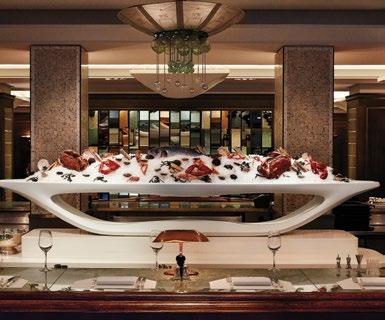

20 Mount St, London
THE COW, WESTBOURNE PARK
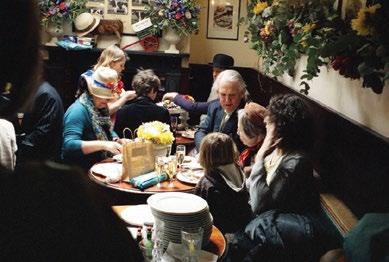
This is neither Ireland nor the coast, though you may suspect it is when you tastes Guinness and oysters at this traditional tavern in west London. Your appetite will be whetted as soon as you see the neon sign, and you will feel at home as soon as you enter, on the ground floor. As for the fish restaurant on the second floor, it is operated by the owner Tom Conran. He prepares mollusks, shellfish and escargot. The Cow is beloved among the locals, so book a table on the on the top floor if you want to avoid sharing a table with others downstairs. Open: Monday-Saturday 07: 00-23: 00; Sunday 12: 30-23.30
89 Westbourne Park Road, London W2 5QH
SOME BARS, CLUBS AND HIGH-CLASS RESTAURANT HAVE A DRESS CODE, WHICH INCLUDES PROPER SHOES, AND MEN'S SHIRTS WITH COLLARS (PREFERABLY WITH A TIE), WHICH ARE OFTEN RENTED OUT (NO JEANS OR SNEAKERS!).
42 VOYAGER 4/2016
: THIS RESTAURANT OFFERS LUNCH, DINNER AND A SPECIAL SUNDAY EVENING DINNER MENU. RESERVATIONS ARE NECESSARY FOR DINNER, THOUGH YOU CAN TRY YOUR LUCK FOR LUNCH. DINNER FOR 2 WITHOUT DRINKS WILL COST £210.

MILOS, ST JAMES'S
This restaurant has just opened in London, and has gained fame not only for its Greek cuisine, but for its delicious natural products, which are transferred directly from Greek farms to your plate. Renowned Chef Costas Spiliadis has elevated Greek cuisine to unprecedented prominence, and presents it to Londoners who are spoiled for choice of high-quality restaurants.
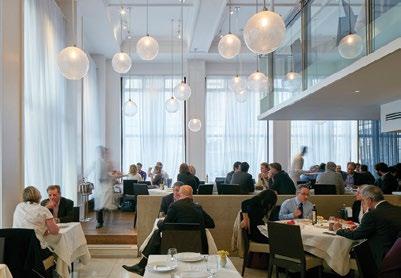
The fish corner is the main attraction, with fresh fish and other sea creatures put on ice daily.
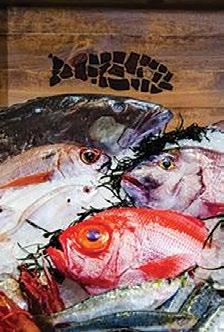
1 Regent St, London
KHAN’S, NOTTING HILL
Hedonistic nights at this West London landmark are now in the past. Actors used to come here for cheap beer and good curry. However, this spirit is not entirely lost: the walls are painted with scenes from Indian fairy tales. Palm trees glow with overlaid gold. As for the roast chicken baked in dough, it is the most delicious in London. We recommend non-alcoholic cocktails instead of cheap beer. The perfectly spiced curry is always in demand.
Open daily 12: 00-23: 00
13-15 Westbourne Grove, London
BONNI GULL, FITZROVIA
CHOP HOUSE, FARRINGDON
Take several steps form the Exmouth Market and find this restaurant, which opened in 1869. Many things have changed over that time, but the charm of the Victorian era is still in the air. The dining room is divided into booths, though you may prefer a table.

The menu features lamb, delicious cutlets, Longhorn beef dishes, roast rabbit heart and fish baked in dough. Wonderful wines are also on offer.
LONDONERS HAVE ADORED CURRY SINCE 1810, WHEN LONDON'S FIRST INDIAN RESTAURANT OPENED. THEY LOVE TO MUCH THAT MANY CONSIDER THESE SMALL PIECES OF CHICKEN WITH RICE AND UNLEAVENED BREAD TO BE A NATIONAL DISH.

Fish & chips may not not sound like much of a culinary marvel compared to many other dishes, but this kitchen makes amazing golden perch cooked in beer with tasty chips and peas. It will remove any doubt about this dish.
Alex Hunter and Danny Clancy opened a popup restaurant in Islington in 2013, which became the most popular eatery in the district. a second branch of Bonni Gull was opened at Exmouth Market in 2014, where guests may taste the best oysters in the UK.

Lunch: Last Order 14:45 (Monday-Friday) and 15:45 (Saturday-Sunday)
Dinner: 18:00 pm (last order 21:45)
21a Foley St, London
RECOMMENDS
TIPS USUALLY CONSTITUTE 10-15% OF THE MEAL PRICE, BUT RESTAURANTS OFTEN CHARGE A SERVICE FEE (TYPICALLY 12.5%), AS THEY INDICATE BEFOREHAND.
FAST FOOD OUTLETS, SELF-SERVICE PLACES OR MEALS DELIVERED TO THE HOME DO NOT REQUIRE TIPS.
43 VOYAGER 4/2016 RESTAURANTS
88-94 Farringdon Road, London
MIN JIANG, Kensington
Min Jiang is a perfect place for those who want to taste special Chinese cuisine and enjoy excellent views of the English garden. This is one of the best Chinese restaurants in London, so table reservations are essential.
2-24 Kensington Hight St, London
VIET GARDEN, Shoreditch
There are many good restaurants in Shoreditch, but if you want to eat reasonably priced, delicious meals, and if you like Vietnamese cuisine, visit Viet Garden.
207 Liverpool Road, london
OSLO COURT, St John’s Wood
Guests may feel as though they have travelled back in time at this restaurant, due in part to the menu. We recommend the steak Diane, veal schnitzel Holstein and crabs a La Rochelle.
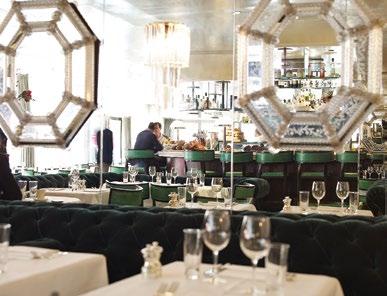

Charlbert St, London
HIX, Soho

When leaving the theater in the late evening, avoid the overcrowded, neon-lit West End restaurants. I recommend heading towards Chef Mark Hicks’ institution and knocking on his wooden doors on Brewer Street. Be assured that the menu is perfect for an after-show dinner.
Nowhere else is British cooking better represented. Here you can taste delicious veal sausage and a slice of Bakewell cake.
66-70 Brewer St, London
CECCONI’S, Mayfair
Cecconi's is a classic Italian restaurant. It offers breakfast, lunch and dinner daily.
It all began in Venice. Ever since, the homemade pasta, seafood dishes and northern cuisine has been cooked to perfection.
The restaurant also has branches in Hollywood and Miami, and a fourth restaurant recently opened in Istanbul.

5A Burlington Gardens, London
BAO, Soho
Getting into Bao for lunch or dinner has been virtually impossible since it opened. Queues form for the Taiwanese chicken and pork rolls.
The Soho restaurant is a project by Erchen Chang, Shing Tet and Va Ting’s, and originated from the Netil Market stands.
The menu offers famous steamed roles with blood sausage, egg ‘glaze’ and fried ice creamsandwiches.
53 Lexington St, London
HARDY’S, Marylebone
This old-fashioned French-style place seats 36 people and is the best place for nighttime meetings.

Chef Sam Hughes’ menu includes a variety of British fish, fried potatoes, shepherd’s pie and French dishes; a selection of the best French wines is also available.

Hardy’s, 53 Dorset St, London
LA FAMIGLIA, Chelsea
Late Alvaro Maccioni opened a family restaurant in the Chelsea district in 1966. It remains a top choice. The menu offers a long list of delicious Tuscan dishes. Everything is Italian here, including the quality and atmosphere. Enjoy lunch or a pleasant evening, especially during the summer months, when tables are set up in the open yard.
7 Langton St, London
BARTENDER NICK STRANGEWAY, MASTER MIXOLOGIST, OFFERS EXPERIMENTAL COCKTAILS; YOU DECIDE WHETHER THE COCKTAIL IS A PERFECT ENDING TO DINNER OR JUST AN APPETITE-INDUCING APERITIF.
44 VOYAGER 4/2016
TABERNA DO MERCADO
Following the success of last year's Chiltern Firehouse, celebrity Chef Nuno Mendes returned to his roots and opened Taberna do Merсado in Spitalfields Market.

Guests are offered traditional Portuguese dishes using local ingredients for the best results: canned fish with herbs, beef sandwiches, smoked meat, and so forth. The ‘Pao de Lo’ patty with olive oil and sea salt deserves special attention.
Old Spitalfields Market, 107B Commercial St, London
WILTONS, Piccadilly
Wiltons opened in 1742 as a modest oyster tavern, and gradually became a favorite of the Whitehall nobility and aristocracy.
Open: for lunch 12: 00-14: 30, dinner 17: 30-22: 30
55 Jermyn St, London
THE IVY, Covent Garden
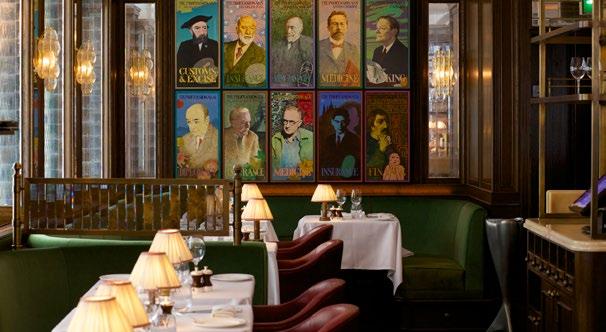
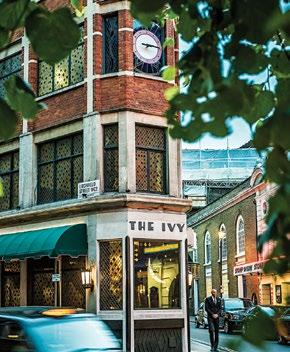
The restaurant, bar and club located in Covent Garden is famous worldwide.
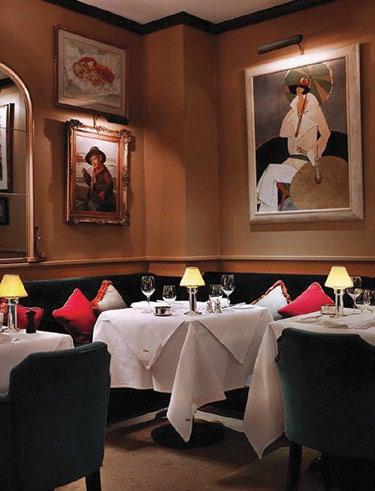
The bar counter and colorful glass windows, oak panels and tasteful collection of contemporary art immediately commands attention. Many visit to see the collection. Theater visitors are The Ivy's regular patrons. Art and media representatives feel at home here. Flawless service and the cozy atmosphere attract people, reflecting well on host Fernardo Peires.
RECOMMENDS
PORTERHOUSE STEAK from Hawksmoor
Taste delicious New York-style steak at five restaurants in London and one in Manchester.

North Yorkshire Beef Tenderloin is best enjoyed with roast potatoes and spinach.
The French-style menu offers dishes from around the world, including Sashimi and Pacific Thai perch. As for the British cuisine, you can taste diverse grilled and fried dishes, as well as the celebrated shepherd’s pie.
The menu consists of the standard two or three dishes, costing between £21.75 and £26.25.
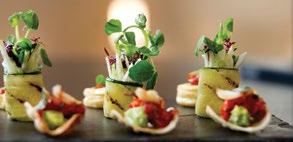
Reservations are recommended, especially if you plan to visit at peak times.
1-5 West St, London
1. Hawksmoor Air St, 5a Air St, London

2. Hawksmoor Spitalfields, 157a Commercial St, London
3. Hawksmoor Seven Dials, 11 Langley St, London
45 VOYAGER 4/2016
RESTAURANTS
MICHELIN
The Michelin Guide has been published; 17 restaurants in Britain received starts for their kitchens. Two new Japanese restaurants, Araki and Umu, which opened in London’ Mayfair district received two stars.
It is a true honor for London that famous sushi master Chef Mitsukhiro Araki closed his three-star restaurant in Tokyo and moved to the UK to experience a different cultural space.
THE RIVER CAFÉ Hammersmith
Ruth Rogers’ Cafe, which was planned as a diner close to her architect husband's studio, has been the best Italian restaurant on the Thames, in south-western Hammersmith, since opening in 1987. The self-taught chef of this place received a Michelin star in 1997.
I recommend making reservations. The colorful and cheerful interior seats 120. Everything in the interior, including the pale pink tiled kitchen oven, is made by Ruth’s husband, famous British architect Richard Rogers. The menu here changes daily, and everything is exceptionally tasty.

Overall, another 15 other restaurants across the UK were awarded stars: The Cellar in Scotland, as well as Eipic and OX in Belfast, Northern Ireland's capital; In addition to the award-winning stars, 25 Bib Gourmands prizes were issued. This award is given to institutions that serve quality food at affordable prices. It embodies the traditional UK approach of competitive, less restrictive and more flexible service. Winners of this award include: The Dunsforth in Yorkshire, London Dehesa in Soho (famous for its cold meats and appetizers), Seaview on the Isle of Wight and Square in Cornwall.
Michelin's guide lists three-star restaurants in the UK capital: Restaurant Gordon Ramsay in Chelsea, Alain Ducasse at The Dorchester in Mayfair and Waterside Inn in Bray.




ST JOHN, Faringdon
20 years on from its launch, Fergus Henderson's nose –to-tail eating revolution still influences cuisine in Britain and across the world. Even menu the is pure enjoyment: no repetition, only the author’s dishes!
St. John has a universally admired minimalist interior. There is always a delicious snack, even if it is just fruit and vegetables. However, Henderson knows how to prepare meat well.
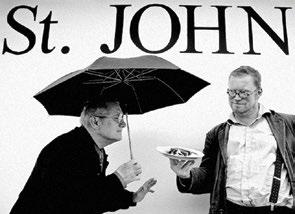
Lunch 12:30; Dinner 19:00; bottles of wine start at £ 24.00
Thames Wharf, Rainville Rd, London
DINNER FOR 2: STARTING AT £90
The famous bone marrow is highly recommended.
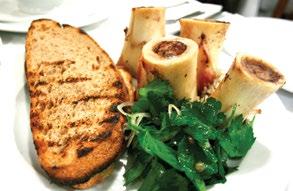
A bakery is located by the restaurant where you may enjoy the best burgers.
26 St John St, London
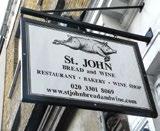
46 VOYAGER 4/2016
GIRCEVT
OTTOLENGHI / SESAME
The Ottolenghi team opened two new restaurants simultaneously. One is Ottolenghi at Spitalfields, where specialty dishes are inspired by Mediterranean and North African cuisine. You may enjoy Georgian wine or try lemon pie.
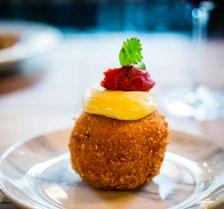
The second restaurant, Sesame, opened in Covent Garden. Ottolenghi’s partner Noam Barr developed a menu of grilled meat and vegetables, salads and oriental sweets specifically for Sesame.


Ottolenghi, 50 Artillery Lane, Sesame, 23 Garrick St, London
JOSÉ PIZARRO BROADGATE
London based Spanish cuisine pioneer Jose Pizarro has opened his third (and biggest) restaurant in the City business center next to Yautcha and The Botanist.
Enjoy potato omelet with chorizo for breakfast, cool plancha steak with onion for lunch and jamon iberico with glass of wine on the terrace for dinner.
36 Broadgate Circle, London
THE KEEPER’S HOUSE, Royal Academy of Arts
The Keeper's House has not always been open to the public. The building was designed by architect Sydney Smirk in 1860, and was the residence of the Royal Academy’s supervisors.
The Keeper's House restaurant opened here in 2013; it is open only to RA members during the day, and to the general public in the evening. The Keeper's House has a bright café and relaxation area on the ground floor and a restaurant and bar in the basement, and a garden in the inner courtyard. The garden is especially pleasant on warm days. It offers sanctuary from the Piccadilly tourist crowds.
Keeper's House chefs Olivier Peyton and Ivan Simeoli emphasize seasonal food and modern British cuisine. The menu offers: venison tartar, partridge with pears and nuts, and veal with beats.
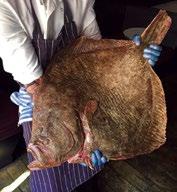
Burlington House, Piccadilly, London
NOBLE ROT RESTAURANT & WINE BAR
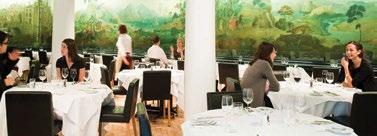
Noble Rot Restaurant & Wine Bar is a joint project between the eponymous magazine and The Sportsman gastropub (a Michelin star restaurant). The Sportsman (a Steven Harris project) is located on the Kent coast and is a favorite place for gourmets who take at least some in modern British cuisine.
Paul Weaver is responsible for the Noble Rot Restaurant & Wine Bar menu; he previously worked with Harris at The Sportsman, for five years. Weaver emphasizes fish and seafood, especially oysters, snails and eel. In addition to the wine selection, try the rye, Italian bread and Irish soda bread.
51 Lamb’s Conduit St, London
REX WHISTLER, Tate Britain
Rex Whistler is the restaurant of the Tate Britain. Its history began in 1927, when young artist Rex Whistler painted its walls. Chef Nathan Brewster, who previously worked at the Tate Modern, cooperated with an historian to create a menu based on mid-20th century British dishes.
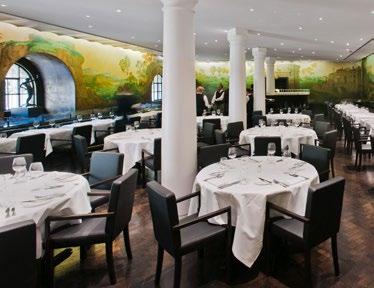
Tate Britain, Millbank, London
THE MENU OFFERS: CHICORY CHEESE (WITH STILTON), PEARS AND WALNUTS; FRIED ARTICHOKE WITH MUSHROOMS; GOOSE BREAST WITH PLUMS, FIGS AND NUTS; AND MARQUISE CHOCOLATE DESSERT WITH CHESTNUTS. THE 40-PAGE WINE LIST DESERVES SPECIAL ATTENTION.
SIX PORTLAND ROAD
Oli Barker and Chef Pascal Wiedermann chose Notting Hill for their new Six Portland Road restaurant project.
They have previously worked together at French wine restaurant Terroirs, which is similar in concept to the new restaurant: seasonal French cuisine and an impressive wine list focusing on natural wines served by the glass.
6 Portland Rd, London
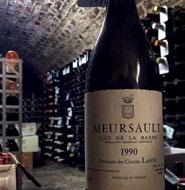
47 VOYAGER 4/2016
RESTAURANTS
RECOMMENDATIONS OF THE HEAD SOMMELIER AT THE RITZ LONDON
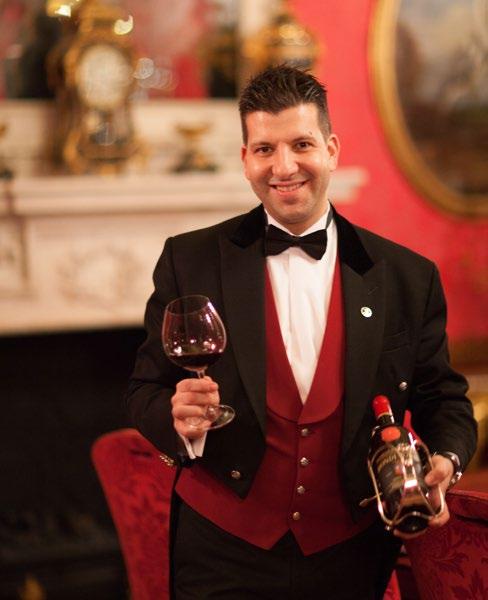 SALOME DADUNASHVILI
SALOME DADUNASHVILI
The Ritz London restaurant offers traditional British cuisine with a light French influence, as a tribute to the well-known former chef, Auguste Escoffier. The restaurant’s excellent wine cellar is set up to pair with the hotel’s traditional, famous dishes. Giovanni Ferlito, the Head Sommelier at the Ritz London, tirelessly searches the world, looking not only for the best-known wines or whiskeys, but for something new to offer his guests. Not so long ago, Georgian wine was added to the cellar; it is very popular.
Giovanni Ferlito: John Williams is the best chef continuing the Ritz London restaurant’s tradition of offering classic British dishes. If you order a beef wellington, he will bring the whole meat on a cart and carve the best piece right for you right in front of you. If you prefer a lighter dinner, sea bass with sea salt is a perfect choice. It will be peeled from its salt sarcophagus right before your eyes before serving. The restaurant’s modern, highend kitchen often employs such entertainment techniques to impress guests. Service is our passion. You will not find such service anywhere else in London. We are prepared for everything and want to know what our clients want. If the client orders beef wellington, we will pair it with Italian Barbaresco or Barolo. They go together very well
One of our most popular starters is sweet breads with Madeira sauce. I suggest to clients to pair it with a Georgian wine. Riesling is our first choice for lobster.
The Ritz London’s menu did not list British wine for 110 years due to the hotel’s policy. We only offered Champagne as a sparkling wine. Recently, we opened our doors to a number of British wine producers, for example, Nyetimber and Gusbourne. These are sparkling wines produced with classic champagne methods.
Bacchus is an excellent white wine from Cornwall. Cornwall is a very important region for the production of wine in the UK, since the weather is ideal for a good white wine grape. A'bakusia tastes like Sauvignon Blanc; it is a very dry wine with a light, fruity and green notes.
We have a diverse selection of 800 alcoholic beverages in the cellar;
We serve rosé and red Gusbourne. British wine has one characteristic: almost all of the regions are rather cold, so the grapes never reach a very high sugar content. Consequently, British wine is light and dry and amazingly lively. Traditionally, the United Kingdom has not been spoiled for wine, but beer. This is a country of ale, cider, and, of course, whiskey. Our restaurant offers an amazing whiskey selection; it is with great pride that we present a digestif trolley at the end of dinner – all sorts of single malt whiskey, light and strong, bitter and smoky.

48 VOYAGER 4/2016
We pay attention to beer, such as the Green and Pleasant beer we serve. This organic beer company also produces cider. These beverages are produced in small quantities. Guests order these drinks at the bar, as an aperitif, rather than at the dinner table.
Pairing meat with beer us not always a compromise; for example, oysters and black beer are a winning combination. People often consider oysters as a "partner" of champagne or white wine, but oysters, with their naturally salty flavor, pair very well with the creamy texture of a black beer.
Beer with a fruity taste compliments langoustines. A number of interesting small breweries offer only natural and organic products. I believe that Green and Pleasant is the best.
Whiskey is the king of the British drinks, of course, due to its sophistication, complexity, tradition and history. It is very difficult to choose one variety. Irish and Scottish whiskey producers have long argued whose product is the best. We have all kinds of good whiskys, even Japanese whisky. It is getting very popular and is distilled according to the traditional Scottish method, therefore the manufacturer has the right to label it as a "whisky". You might have noticed that this drink is spelled in two ways, whisky or whiskey; the first is Scotch whisky. All the rest are Irish or American whiskeys. Only Japanese whisky has earned the right to carry the name of Scotch whisky.
In my opinion, Scotch whisky is the best because of its harsh taste and the bit of smoke in it. Talisker is my favorite brand. It is made on a small island called Skye, located off the north of Scotland. This is the only distillation plant on the whole island. I was so impressed with this whisky that I visited the island. It is distilled in extreme conditions. The cold ocean surrounds the island, and the place where the whisky is aged faces it directly – hence, its salty flavor. You feel the scent of the sea when you drink it. All whiskeys have complex flavors and histories. Turf is used for all heat processes in Scotland, and the only turf used is extracted there – that’s why Scotch whisky is unique.
Taste several brands to grasp the essence of whiskey. Dalwhinnie has a very soft, soft, delicate taste and the ladies like it; Lagavulin, by contrast, has a rigid, powerful flavor – it is a very masculine drink.
Keep in mind that many manufacturers sell special whisky at the distilleries only. These beverages are excellent gifts for whisky lovers, as only limited amounts are produced. Oban produces the perfect whiskey. This is a small town and you can combine sight-seeing with a trip to the factory. If you want a more impressive adventure, visit the Isle of Skye. Talisker whisky really is an amazing beverage.
The Ritz London experience is not limited to food or drink but includes the service. People visit it for the service alone. I strongly recommend the so-called surprise menu. This, in fact, is a tasting menu, but the six dishes and paired drinks are a surprise for the client.
Friday and Saturday evenings are very popular. You can visit, have dinner and dance to the BBC orchestra in the Ritz London hall. This is a continuation of an old tradition as Sunday dinner was never just a meal – it was an extraordinary event. People wore their finest outfits and headed to the restaurant for dancing and entertainment. Such evenings are still popular today.
Georgian wines in the Ritz London menu:


ORANGE WINE:
GEORGIA KARTLI
Chardakhi Chinuri, Iago Bitarishvili 2014; £65
IMERETI KUTAISI
Tsitska, Lagvinari 2013; £85
GEORGIA KAKHETI
Bakurtsikhe Saperavi “Gvino”, Lagvinari 2011; £60
49 VOYAGER 4/2016 BEVERAGES
NOTE THAT THE RITZ LONDON HAS A DRESS CODE: SPORTS CLOTHING IS NOT PERMITTED. IN ADDITION, RESERVATIONS HAVE TO BE MADE IN ADVANCE. DINNER FOR TWO PERSONS WILL COST YOU AT LEAST 350 POUNDS.
THE GAELIC LANGUAGE.
HIGH PROOF PHILOSOPHY
Two countries – Ireland and Scotland –consider whiskey their national heritage, and their lands as the birthplace of whiskey. The Irish say that St. Patrick used to make whiskey, and the Scotch refer to Crusades-era historical documents for their whisky source.
According to classical methods, Scotch whisky is made from barley malt and grain, while in Ireland they add rye to the barley malt to get Irish whiskey.
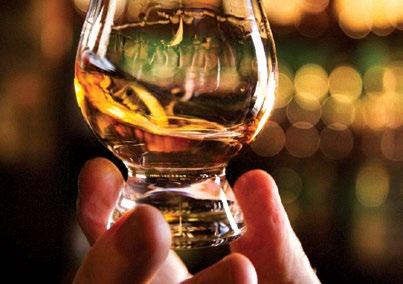
In US and Canada, they use corn (Bourbon), rye (rye whiskey) and wheat (wheat whiskey) as raw ingredients. Bourbon, unlike classic European whisky, is made from corn and is aged in specially made oak casks, which are burnt on the inside.
In Japan, they use corn and millet as raw ingredients for whiskey, adding a small amount of rice and other grains.
Traditionally, a Scotch whisky is an alcohol drink distilled from barley malt and other grains containing no less than 40% alcohol. Whisky is aged for at least three years in 700 liter oak casks. It must be distilled and stored in Scotland otherwise it will not be considered Scotch.
They distill two basic types of whisky in Scotland: malt and grain. Other varieties are interpretations of these two. Barley malt is distilled in copper pot stills, with old cubes yielding a purified and aromatic alcohol. Malt whisky passes through two stages during distillation (three in some distilleries, as in Ireland).
At the first stage, the barley is dried over a peat fire; hence, all brands of Scotch whisky have a peat flavor and aroma. This characteristic distinguishes Scotch from most Irish and American whiskeys.

Malt whisky production requires several components: barley, water, yeast and peat. The taste of the Whisky depends on the type of barley used. Scottish barley, Golden Promise, is characterized by its nut tones.
Another major component is water. The amount of water used is ten times the amount of alcohol distilled – this is why distilleries are built near fresh-water springs. Some Scottish plants (Glenmorangie, Glenkinchie, Highland Park) use only hard water, which gives the drink a pleasant taste. Sometimes so-called peat water is used, which has passed through soil with a peat surface.
50 VOYAGER 4/2016
TEA SKHIERELI NINO GEGESHIDZE
THE WORD “WHISKY” COMES FROM “UISGE BEATHA”, WHICH STANDS FOR “WATER OF LIFE” IN
WHISKY TASTES BEST AT 18-20°C
Scotch whisky made from grains emerged much later and is considerably faster and easier to make. It is used to make blended whisky, which is made by blending aromatic expensive whisky with cheaper varieties.

All producers keep the proportions of their blends a secret. More than 1,000 brands of such whisky is produced in Scotland annually and is the most popular type of Scotch whisky in the world. The De Luxe blend is the highest category of blended whisky, which contains 12 per cent malt and is aged for 12 years.
THE SCOTS HAVE THE “5S” RULE:
• SIGHT
• SMELL
• SWISH
• SWALLOW
The most distinguished of them include Chivas Regal, Dimple and Johnnie Walker Black Label.
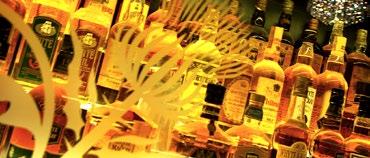

• SPLASH WHISKY CAN BE KEPT FOR AS LONG AS A HUNDRED YEARS IN A SEALED BOTTLE BUT ONLY MAINTAINS ITS PROPERTIES FOR FIVE YEARS ONCE THE BOTTLE IS OPENED.
LAPHROAIG

HOW TO DRINK WHISKY
It's better to drink whisky in the second half of the day. Ice may be added only to a low-quality whiskey, as whisky that has been aged for a very long time loses its oak-cask flavor when mixed with ice. You may add only a little water to the drink. A chilled bottle should be carefully wiped with a dry cloth and set on the table. To fully enjoy the aroma, the whisky glass is filled to one third and is consumed in small sips. The whisky flavor is fully felt when keeping the drink in your mouth for a few seconds. Whisky is not paired with food; cigars are instead considered to be the “companion” for this drink.
RECOMMENDS
It has been more than 200 years since a complex, single malt whisky with a multi-faceted taste was first made in the Scottish island of Islay. It has repeatedly been named the world's best-selling whisky. It should be noted that Laphroaig was sent to America even during the Prohibition period; it has a slight scent of iodine which allowed it to pass as medication.
In 2005, Laphroaig received highest award of the Champions of Whisky Competition - The best of the best. In the same year, the company changed ownership to the Fortune Brands corporation, which had previously already owned numerous whiskey, bourbon, vodka and sherry plants. Currently, Laphroaig is producing more than 10 varieties of a high-quality malt whisky, with aging periods from 10 to 40 years.
In 1994 Prince Charles visited the place. He ordered a solid batch to replenish the royal family stock and even contributed to preparation of malt. Laphroaig is the only holder of Prince of Wales's Royal patent, which he personally handed to the distillery during the 1994 visit. This 15-year-old brand is considered to be the Prince's favorite Scotch whisky.

სასტუმრო / სპა 51 VOYAGER 4/2016
WHISKY
WHISKY IS PRODUCED IN MANY COUNTRIES BUT SCOTCH CAN ONLY BE PRODUCED IN SCOTLAND, AS FROM THE VERY BEGINNING IT WAS DISTILLED AND AGED HERE, FOR AT LEAST THREE YEARS.
THE MALT WHISKY CLASSIFICATION, AS A RULE, IS MADE ACCORDING TO THE MAIN TYPES LISTED BELOW: HIGHLAND, LOWLAND, SPEYSIDE, ISLAY, ISLAND WHISKY, CAMPBELTOWN - WHICH, IN TURN ARE DEFINED BY THE GEOGRAPHICAL LOCATION OF THE WHISKY DISTILLERY. DISTINCTIVE FEATURES OF WHISKY ARE LARGELY DEFINED BY THE LOCATION AND CLIMATE OF EACH RESPECTIVE REGION.
ISLAND WHISKY
"The island's whisky" is distilled on the small islands of Jura, Skye, Mull, Arran and Orkney. Closeness to the sea sometimes gives locally produced drinks a salty, smoked flavor, however attaining a perfect balance between the tart and the mild taste requires true mastery.
1. JURA 10 (Isle of JuraWhyte & Mackay Ltd)
2. TALISKER 18 (Isle of Skye - Diageo)
3. ARRAN 14 (Isle of Arran - Distillers Ltd)
4. HIGHLAND PARK 21 (Isle of Orkney - Edrington Group)
5. LEDAIG 18 (Isle of Islay - Burn Stewart Distillers)
6. TUBERMORY 15 (Island of Mull, Tobermory - Burn Stewart Distillers)
ISLAY MALT
Islay is a small island on the west coast of Scotland, often attacked by masses of storms coming from the Atlantic. Apparently this humidity gives the local peat a distinctness which is positively reflected in the flavor and aroma of the malted barley. A single malt Scotch whisky distilled on the island has a stronger peat aroma and a more tart taste compared to other whiskys. In the south, peat fumes are more saturated and the local water is mineral-rich. In the north, on the other hand, the influence of peat is less tangible and the whisky has a smoother and more refined taste.
1. Ardbeg Uigeadail (Glenmorangie Co Ltd)
2. Bruichladdich The Laddie Ten (Bruichladdich Distillery Company)
3. Bunnahabhain 18 (Burn Stewart Distillers Plc)
4. Caol Ila 18 (Diageo)
5. Kilchoman Machir Bay (Kilchoman Distillery Co Ltd)
6. Lagavulin 16 (Diageo)
7. Laphroaig Quarter Cask (Beam Suntory)
CAMPBELTOWN MALT
The local whisky has a very strange combination indeed: the main characteristics are its distinguished dryness, tartness, peat aroma and high mineralization. This single malt whisky often serves as a good aperitif.
52 VOYAGER 4/2016
ARRAN MULL SKYE JURA O U T E R H E B R I D E S SOUTH UIST NORTH UIST LEWIS ORKNEY Berwickupon-Tweed Coldstream Kinross St Andrews Aberfeldy Pitlochry Blairgowrie Ballater Carnoustie Arbroath Montrose Banchory Stonehaven Inverurie Huntly Rothes Elgin Forres Aviemore Nairn Dingwall Invergordon Tain Brora Wick Thurso John o'Groats Lossiemouth Banff Buckie Macduff Fraserburgh Oldmeldrum Auchterarder North Berwick Melrose Castle Douglas Wigtown Stranraer East Kilbride Prestwick Troon Helensburgh Brodick
Tarbert Lochgilphead Mallaig Portree Kyle of Lochalsh Torridon Ullapool Lochinver Fort William Fort Augustus Glen Coe Oban Inveraray Dunblane Callander Crieff Tobermory Port Askaig Port Ellen Moffat Biggar Dufftown Tomintoul Hawick Ayr Kilmarnock Dumbarton Falkirk Perth Dumfries GLASGOW Stirling Glenrothes Dundee Aberdeen Stornoway Kirkwall Inverness Ben Nevis 1343 m Loch Ericht Loch Rannoch Loch Tay Loch Awe Loch Lomond LochNess Tay Dee Spey Tweed Beauly 10 11 17 36 4 5 114 31 37112 113 24 109 42 26 27 25 20 12 34 23 19 39 47 45 29 28 85 38 30 15 41 48 33 46 22 111 32 18 21 40 43 35 82 54 53 93 58 90 69 60 78 89 86 71 77 87 74 88 62 64 97 84 83 96 79 80 81 95 75 67 72 57 73 91 70 51 59 68 52 100 56 94 76 98 99 61 63 65 49 8 7 1 2 3 Greenock EDINBURGH 9 6 Cape Wrath Keith Craigellachie Lindores Islay Grantownon-Spey Kingussie Highland Lowland Speyside 101 13 92 115 44 50 Annan Bonar Bridge 110 104 14 16 55 66 102 103 106 108 107 105
Campbeltown
1. Kilkerran Work In Progress 7th Release (Glengyle J & A Mitchell & Co Ltd)
2. Glen Scotia 15 (Glen Scotia Loch Lomond Group)
3. Longrow 11 (Springbank J & A Mitchell & Co Ltd)
HIGHLAND MALT
The Scottish Highlands is a very general term, but the local whisky is equally famous around the world. For its part, the Scottish Highlands are divided into four regions: the whisky distilled in the northern part is characterized by a sharper, saturated taste; Southern Highlands whisky is relatively dry with a fruity aroma; Eastern Highlands whisky has a richer taste, is drier and has a more distinct fruit aroma; and whisky distilled in the Western Highlands is characterized by the intensity of peat fumes and its relatively rigid taste.
1. Glenmorangie 18 (Louis Vuitton Moet Hennessy)
2. Old Pulteney 21 (Inver House Distillers Ltd)
3. Oban 14 (Diageo)
4. Glendronach 21 (Benriach Distillery Co)
5. Royal Lochnagar 12 (Diageo)

6. Glengoyne 25 (Ian Macleod Distillers Ltd)
7. Ben Nevis 21 (Ben Nevis Distillery (Fort William) Ltd)
8. Tomatin Cu Bocan Virgin Oak (TheTomatin Distillery Co Ltd)
9. Aberfeldy 12 (John Dewar & Sons Ltd)
10. Teaninich 10; Flora And Founa (Diageo)
11. Fettercairn Fior (Whyte & Mackay Ltd)
12. Edradour Caledonia 12 (Signatory Vintage)

13. Blair Athol 12 (Diageo)
14. Balblair 1990 (Inver House Distillers Ltd)
15. Brora 37 (Distiller Company Ltd)
16. Dalwhinnie 15 (Diageo)
17. Tullibardine 228: Burgundy Cask Finish (Tullibardine Ltd)
SPEYSIDE MALT
Most of the Speyside borders the Spey on the east side of the Scottish Highlands. The local whisky is a lighter and relatively sweet drink. Water coming from the granite hills and passing through peat swamps adds refinement to many types of malt whisky. Their sweet taste is mild and very pleasant. Peat is rarely used in the distillation processes here.
1. Aberlour A’Bundach Batch#48 (Chivas Brothers Ltd)
2. Balvenie 21 (TheWm Grant & Sons Ltd)
3. The Macallan 12 (The Edrington)
4. Glenfarclas 15 (Glenfarclas J & G Grant)
5. BenRiach 16 (BenRiachDistilleryCo)
6. Glen Morey 25 (GlenTurnerDistilleryLtd)
LOWLAND MALT
This whiskey is made in south Scotland and has all of the characteristics of this part of the country – a soft, saturated, and refined taste.
Peat is rarely used here, therefore the drink that comes out after the triple distillation process is always soft and pleasant, with low mineralization and a highly fruity aroma.
1. Auchentoshan 21 (Beam Suntory)
2. Ailsa Bay Single Malt (Wm Grant & Sons Ltd)
3. Glenkinchie 2000 (Glenkinchie)
4. Girvan 21 (Girvan)
5. Cameron Brig (Cameron Bridge)
6. Littlemill 21 (Littlemill)
7. Tamdhu 10 (Ian Macleod Distillers Ltd)
8. Macallan 25 (Edrington Group)
9. Craigellachie 13 (John Dewar & Sons Ltd)
10. Aultmore 25 (John Dewar & Sons Ltd)
11. Cardhu 12 (Diageo)
12. Glen Elgin 12 (Diageo)
ROYAL LOCHANGAR ‘12 (DIAGEO)
Thanks to extremely fine ingredients, this distinctive blend with a velvety taste is aged in oak casks for 12 years. Color: Light Amber. Scent: sawn wood, sweetmeats, and wood varnish with a slight acid aroma of moss and flax oil. However, diluted with water, the acidity declines and the aroma becomes sweeter. Strength: average .The taste: pleasant with slight tartness after the initial sweetness; in the end you will have a slightly dry, strangely pleasant, sandalwood aftertaste.
CRAIGELLACHIE ‘13
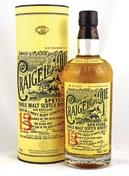
Craigellachie is a single malt distilled beverage which stands out both through its taste and composition. Production started in 1891 and each bottle is aged for at least 13 years, while the alcohol content reaches 46%. Initially you will feel the aroma of tropical fruit, mango and pineapple, which will be followed by the sweet and rich aroma of smoked ham. Taste: Sweet and fruity combined with a smokey intensity; appetizing and refreshing.
TUBERMORY ‘15 (BURN STEWART DISTILLERS)
EXPORT
1.2 Billion bottle a year
SCOTCH WHISKEY EXPORTS VOLUME 324 MILLION LITERS , COST 3.8 BILLION POUNDS (LPA)
This single malt whisky was produced in a limited amount; it leaves an unforgettable impression.
38 bottle Every Seconds
It is distinguished by its complex structure and flawless elegance - in the last year of the aging process, it is aged in handmade, Gonzalez Byass Oloroso sherry casks. Even the packaging underlines its distinctiveness: each bottle is individually made and is kept in a special oak shrine.
£120 Every Seconds
YOU CAN BUY THESE VARIETIES OF WHISKY IN SOLO LOUNGES.
სასტუმრო / სპა 53 VOYAGER 4/2016 Inverurie Fraserburgh
WHISKY
(JOHN DEWAR & SONS LTD)
HOW TO READ THE LABEL
THE NAME OF THE WHISKY OFTEN REPEATS THE NAME OF THE MANUFACTURING PLANT, E.G. THE BALVENIE IS A MALT WHISKY LINE, CREATED BY DAVID STEWART. THIS COMPANY IS KNOWN FOR WHISKYS WITH A HONEY AROMA. THE DEFINITE ARTICLE "THE" INDICATES THAT THE BOTTLING PROCESS WAS STRICTLY CONTROLLED BY THE LINE OWNER.
DOUBLEWOOD – THIS MEANS THAT THE WHISKY WAS AGED IN DIFFERENT TYPES OF CASKS (PREVIOUSLY BOURBON AND SHERRY CASKS). THE NUMBER 12 PRINTED IN A LARGE FONT INDICATES THE AGING PERIOD.
• The word malt indicates that the whisky is produced from barley malt, yielding a sweet aroma; single malt indicates that this is a malt Scotch, produced in the The Balvenie Distillery.
• Pure malt, blended malt or vatted malt indicates that several varieties of malt whisky have been blended together.
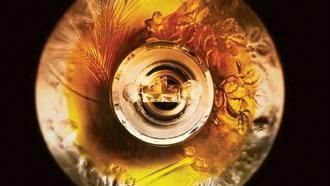
• Blended whisky indicates a drink made of malt and other grains; grain whisky means a whisky made of grains, used for blending, and Bourbon is an American-made whiskey, which includes corn as one of its ingredients.
• Sky, Jura, Mall and Orkney are varieties of whisky saturated with smoke and peat aromas.
WHISKY IS THE DRINK FOR TRUE GOURMANDS OF ALCOHOL. ITS PRICE INCREASES FROM YEAR TO YEAR – AN INITIAL PRICE CAN INCREASE BY UP TO 250 PERCENT OVER THREE YEARS.
WHISKY PURCHASED AT A SPECIAL CERTIFIED EXCHANGE IS CONSIDERED A GOOD INVESTMENT. THIS IS AN IMPORTANT FACTOR IN THE UNIQUENESS OF THE DRINK AND THE AMOUNT OF BOTTLES PRODUCED IN THE SERIES.
MACALLAN 64 YEARS OLD IN LALIQUE
According to the official information, this is the only crystal vial, which holds the oldest Scotch, aged for 64 years. At the 2010 auction, dedicated to the memory of Rene Latikis, it was sold for a surprising price of 460,000 USD. With this, the Macallan Company paid tribute to the crystal manufacturers, as all around the world whisky is associated with thick bottomed crystal whiskey glass –the tumbler.
WHISKY OR WHISKEY? BOTH ARE CORRECT, BUT THE FORMER INDICATES A SCOTCH WHISKY (WHICH WILL BE FURTHER ASSURED WITH ANOTHER WORD, SCOTCH, PRINTED ON THE LABEL), WHILE THE LATTER INDICATES AN IRISH, AMERICAN OR CANADIAN PRODUCT.
THE LABEL SHOULD INDICATE THE PRODUCING COUNTRY AND THE EXACT REGION, THE PRODUCING COMPANY, WHISKY TYPE, THE AGING METHOD AND PERIOD, THE INGREDIENTS USED AND THE ALCOHOL CONTENT. IF THE LABEL INDICATES 10 YEARS OF AGING, IT MEANS THAT THE WHISKY WAS DEFINITELY AGED IN OAK BARRELS.
WHISKY ALCOHOL CONTENT IS INDICATED IN THE LOWER RIGHT CORNER OF THE BOTTLE, WHILE THE BOTTLE VOLUME IS ALSO INDICATED IN THE LOWER CORNER BUT ON THE RIGHT.
GLENFIDDICH 1937

This is the oldest bottle, from the ones produced as a single copy. The Scottish company Glenfiddich ages whiskey in oak casks and its products are famous for their fruity aroma. These bottles were sold at auction in 2006 but so far no one knows what kind of taste they have.
THE MOST EXPENSIVE WHISKY
Whiskey
Macallan M
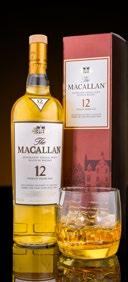
Macallan 64 Years Old in Lalique Cire Perdue
Glenfiddich Janet Sheed Roberts Reserve
Springbank 50 Year Old
Macallan
Glenfiddich
Dalmore 62 Single Highland Malt Scotch
Matheson
Balvenie 50 Year Old
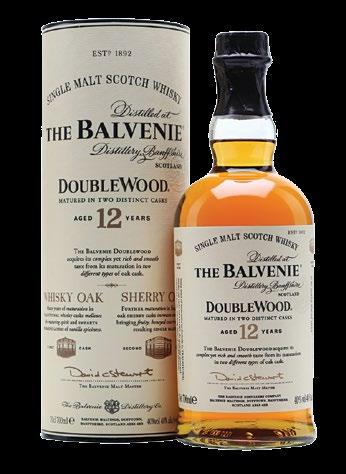
Dalmore Selene 58 Year Old
Macallan 50 Year Old
Year Price
1939 $628,205
1946 $460,000
1955 $94,00
1919 $78,000
1926 $75,000
1937 $71,000
1942 $58,000
1912 $42,000
1951 $35,000
1949 $32,000
54 VOYAGER 4/2016
WHISKY
CHINAWHITE
Chinawhite has been one of the world's most exclusive nightclubs for almost two decades. Members and their guests are constantly offered novelties, while the fascinating modern interior and exotic, high-quality service are the background for world-renowned artists and DJs.
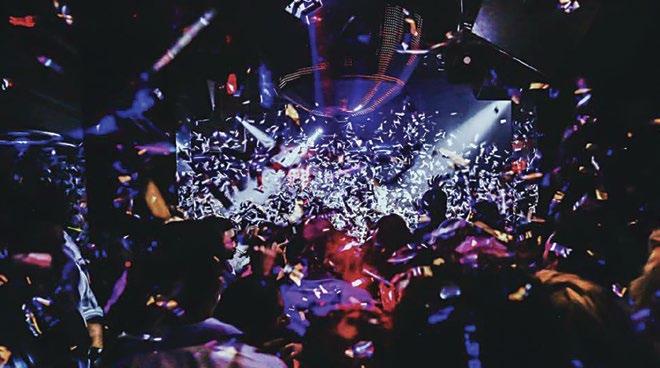
When visiting Chinawhite you will listen to world-famous artists and DJs. The following artists have played there: Drake, Jason Derulo, Pia Mia, Ciara, Rae Sremmurd, Miguel, Royce Da 5'9, Big Sean, Steve Aoki, Pete Tong and Nelly.
Here you may find seated next to you, celebrities who you had previously only seen on the screen. The club’s VIP list has included: Leonardo DiCaprio, Kate Moss,
Tom Cruise, Cara Delavigne, Rhianna, Drake, One Direction, Kendall Jenner, Idris Elba, Ciara, Lewis Hamilton, Naomi Campbell, Jordan Dunn, Rita Ora and Usain Bolt.
4 Winsley St, London W1W 8HF Phone: +44 20 7290 0580
EGG LONDON
Exceptionally popular, Egg London is London's most interesting multimedia space. The club has a very large open area comprising five dance scenes where the latest upcoming DJs play. Young, energetic and friendly guests are ready to spot new stars.
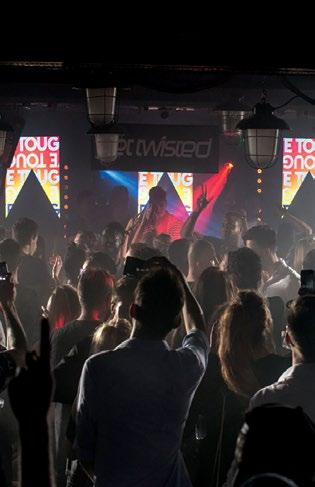

International superstar DJs perform house and techno on Saturdays. A good time is guaranteed until 9 a.m. Egg London is famous as the world's best multi-functional arena.
The club has a 24-hour party license, which is not typical of other clubs in London.
200 York Way, London N7 9AX Phone: +44 20 7871 7111
THE ZETTER TOWNHOUSE
The light blue door of The Zetter Townhouse may look like an ordinary London house, but this hotel is a breath of fresh air amongst a raft of similar looking, minimalist hotels. A hall full of strange antiques attracts the eye. In the evenings, the place transforms into a cocktail bar.
Bartender Tony Coliano and chef Rene Redzepi are masters of their craft. Coliano’s martinis are very popular.
49-50 St John’s Square, London
CHILTERN FIREHOUSE
Hotel owner Andre Balazs turned this Gothic-style fire station into a wonderful bar with the help of Michelin star chef Nuno Mendes and the outdoor terrace.
The marble counter is the best place to observe celebrities, veiled with sunglasses.
1 Chiltern St, London
DUKES
Visit Ian Fleming's favorite bar to taste a true martini. Waiters in white jackets serve pricey drinks that are well worth the price.
Dukes Hotel, 35 St James’s Pl, London
UPSTAIRS AT RULES
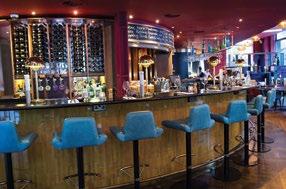
London's oldest restaurant, opened in 1798, with its velvety-furnished bar on the top floor, is frequented by members of the royal family and other nobles. Bartender Chris Lacey does not reveal the secret to his success.
35 Maiden Lane, Covent Garden, London
55 VOYAGER 4/2016 NIGHT CLUBS / BARS
THE BEER GUIDE
BRITISH BEER IS FERMENTED IN KEGS (METAL BARRELS) WITH SUGAR ADDED TO GET BEER WITH NATURAL CARBONIZATION. BITTER IS THE MOST POPULAR VARIETY OF BEER IN BRITAIN. AT PRESENT, IT ACCOUNTS FOR THREE QUARTERS OF ALL OF THE ALES PRODUCED IN THE MISTY ALBION.
Arthur Guinness started to brew a dark, almost black, strong stout in Dublin in the XVIII century. Guinness beer, which has become a symbol of Ireland, is produced in many breweries around the world today. Due to its high popularity, as well as being sold ‘on tap’ (which is traditional for ales), it is also available in bottles and cans.
PORTER/STOUT
Wadworth Swordfish, Fuller’s London Porter, St. Peter’s Porter
Porter is a typical London beer for “porters” – people who are engaged in heavy physical labor. Initially it was a mix of dark, light and aged ales.
A separate type of porter made from roasted malt started being brewed in the middle of the XIX century. Stout is a darker version of porter, which is made from a highly roasted malt.
BARLEY WINE
Whitbread Gold Label, Fuller’s Vintage Ale, Fuller’s Golden Pride
Beer with the alcohol content of wine (8-12%). Brewing started during the war with France for patriotic reasons (you can’t drink your enemy’s wine!)
This strong beer is aged for 1.5–2 years; it is characterized by its very rich bouquet of fruit, chocolate, coffee, herbs and floral notes.
There are about 70,000 pubs in the UK. Pubs are as necessary for beer as the breweries (usually the breweries own the pubs). In pubs, beer is poured from porcelain or wooden ornamented hand pumps. The pumps bear small plates showing the brands of the beer that you can order.
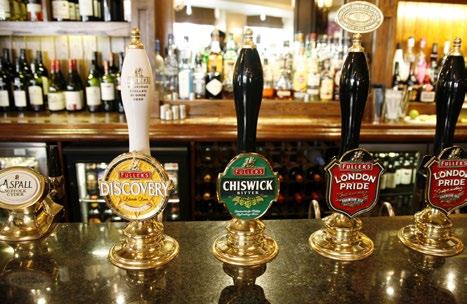
MILD
OLD ALE
Theakston Old Peculier, Gale’s Prize Old Ale, Thomas Hardy’s Ale
This is the classic beer of provincial pubs and the most popular British choice; it comes in dark brown or golden varieties with chocolate and coffee flavors. Almost no or no hops are used to make it.
This beer is a pre-Victorian-era retro ale; using natural leaven, it is barrel aged for several months;
Not too strong, not too dark, it is highly aromatic with tones of dried fruit, coffee, leather and tobacco.
GOLDEN ALE
Exmoor Gold, Hop Back Summer Lightning
This is very similar to lager. It was invented in the 1980s to resist the penetration of lager beer into the English market.
In order to produce this dense, golden ale, rice, corn and mash are sometimes added.
BITTER
ESB от Fuller’s, Greene King Abbot Ale
Bitter is basically a variety of IPA for the inner market, created at the end of the XIX century. Slightly darker and aged for a shorter period than light ale, its bouquet is highlighted by bitter herbs, nuts and dried fruit notes.
It was first made in the XIX century for the British Army and the colonies using a large amount of hops.
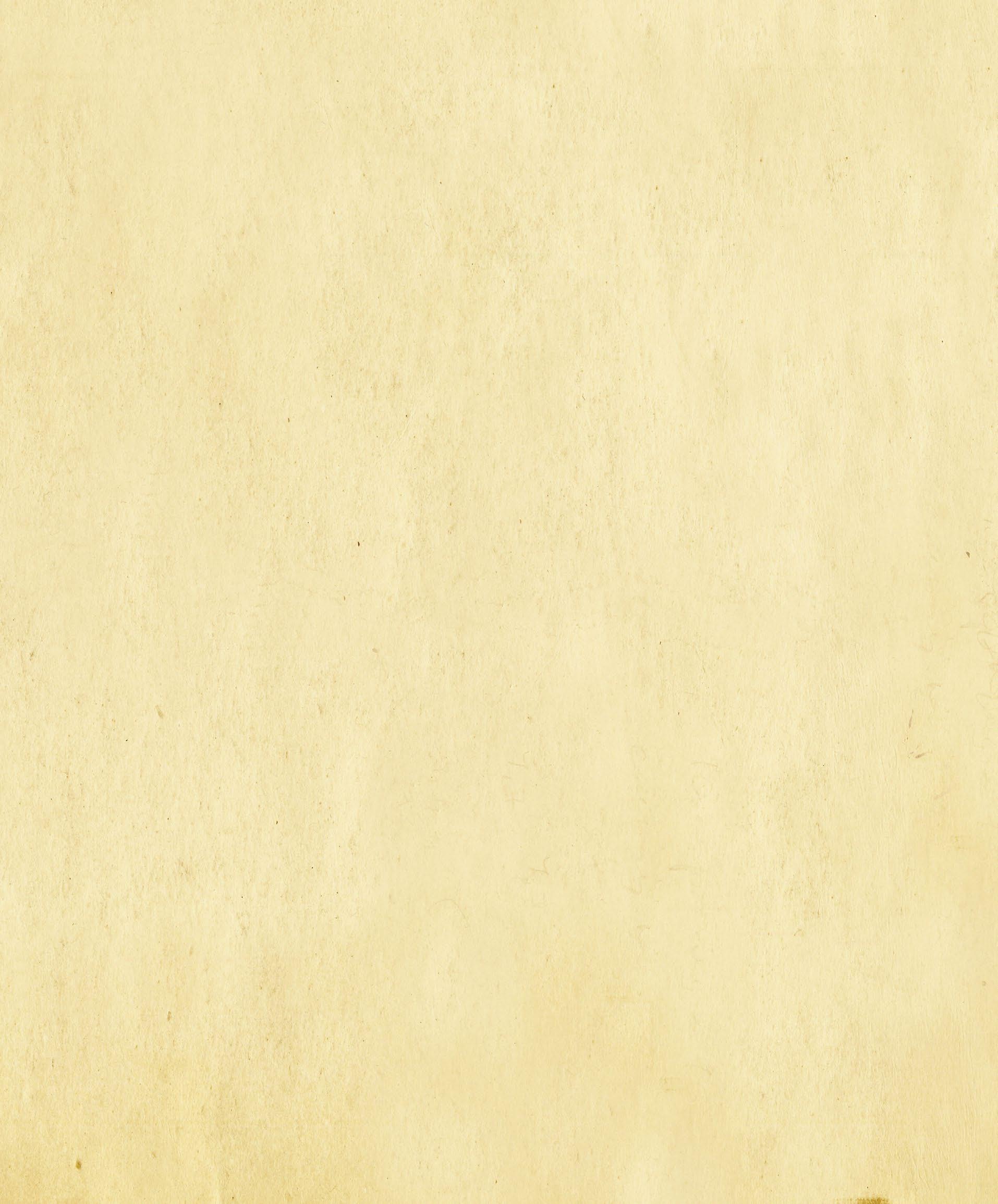
The latter served as a preservative: products were transported to India and had to remain unspoiled for a long time.

56 VOYAGER 4/2016
ALE Greene King XX, Timothy Taylor’s Golden Best, Banks’s Original
BEER
IPA
Marston’s Pale Ale, Marston’s Old Empire
COLD AS METAL
Gin was first distilled in the Netherlands in the 17th century; Dr. Francis Silvius is often credited with this invention. The drink was reintroduced to England during the "Glorious Revolution" (1688 -1689) when a Dutchman became king of this country.
RECOMMENDS:
FIVE BEST
BRITISH
GINS: HENDRICK'S SQUARE
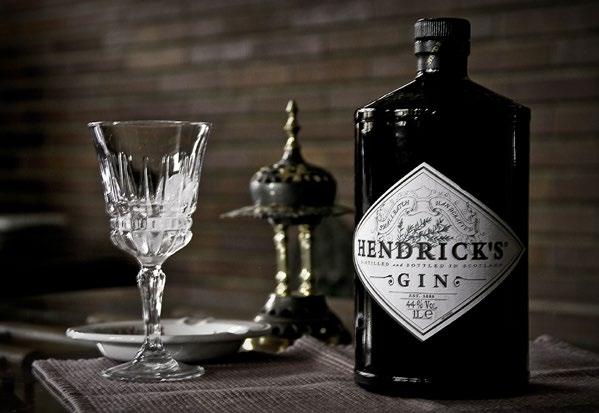
MILE GIN
COLONEL FOX'S THE LONDON NO.1 PORTOBELLO ROAD GIN

Gin rapidly gained popularity in England following its introduction with hundreds of stores selling it across the country. In 1740, gin production volume was six times larger than that of beer. Its cheap price (the government imposed a levy on foreign beverages, and allowed markets to sell low-quality wheat, which produced gin) made it especially popular among the poor.
The vertical distillation method was invented in 1832, and later, in the 19th century, production of London dry gin began. Thus, it became a more respectable drink and competed for the title of the most popular beverage of the Anglo-Saxon countries, though lost to whiskey.
Gin O’clock
When cocktail hour strikes in London, visit the Churchill Bar in the Hyatt Regency Hotel. Sit on the outdoor terrace, puff a cigar, order the specialty martini and enjoy looking at Sir Winston’s bronze statue, which is inexplicably called "An Interview".
Gin may be enjoyed in its pure form, in cocktails and for medical purposes (in fact, that’s why it was made). It is usually used in the preparation of various cocktails. The most popular and well-known cocktail is gin and tonic. It was invented by British soldiers serving in India during the colonial era. It not only clenched the soldiers’ thirst but also helped to fight malaria. Quinine tonic was prepared to protect soldiers from malaria but the taste of the quinine had to be neutralized – gin served this purpose very well.
If you decide to drink gin neat (on its own), serve it cold. Pair it with hot meat, according to English tradition. Gin is usually used in cocktails, and every bartender can successfully mix gin-based drinks. Gin perfectly suits vermouth, lemon, olive, fruit juices and soft drinks as well. Basically, gin is a perfect aperitif.
A STRONG, COLD TASTE REMAINS AFTER DRINKING GIN.
THE ALCOHOL CONTENT IS NEVER LESS THAN 37.5% (A LAW WAS PASSED IN EUROPE IN THE 1960S, ACCORDING TO WHICH GIN COULD NOT BE LESS THAN 37.5%).
GIN IS MADE FROM GRAIN ALCOHOL DISTILLED THROUGH THE ADDITION OF SPICES: JUNIPER BERRIES, CORIANDER, ANGELICA, ALMOND AND SO FORTH. GIN HAS A VERY WELL-PREPARED, DRY, HARMONIOUS TASTE, A STRONG CHARACTER AND A DISTINCT FLAVOR OF JUNIPER.
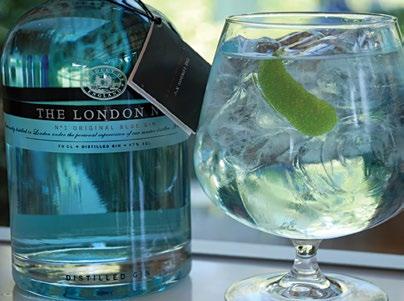
57 VOYAGER 4/2016 GIN
The UK is the biggest exporter of gin in the world. The European Union imports London gin as the highest quality variety of this spirit.
PUBS FOR BRITISH PEOPLE MEAN NOT ONLY A PLACE TO DRINK BEER, BUT ALSO A TYPE OF CLUB AT WHICH TO MEET FRIENDS AND ENGAGE IN INTERESTING GAMES AND LONG CHATS.
The Romans introduced the concept of the tavern, a place where you are served food and wine simultaneously. Taverns turned into places to drink beer after the 16th century as wine became a luxury. During the industrial revolution, the water from the Thames River became very contaminated, and pubs really prospered.
The interiors of pubs often look very similar: heavy wooden furniture, big windows, old chandeliers, photos in gold frames, torches, a curved bar in the middle of the room, and big screens to watch football, rugby or cricket.


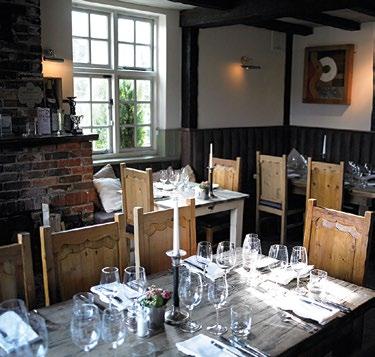
The main drink in pubs is various types of beer, though you can also try whiskey, wine, champagne, fruit cider and others.
PUBS IN THE UK ARE NONSMOKING; TO SMOKE, YOU NEED TO GO OUTSIDE. YOU CAN GENERALLY ORDER FOOD ONLY UNTIL 9-10 IN THE EVENING.
PUBS HAVE BECOME A TRADITIONAL BRITISH INSTITUTION. THE NAME ITSELF COMES FROM THE WORDS “PUBLIC HOUSE”.
THE PRICE OF BEER (0.56 L), 50 ML OF WHISKY OR A GLASS OF WINE CAN RANGE FROM £3-5, AND ONE DISH COSTS AROUND £5-10.
Finding a free spot during a football or rugby match can be a challenge. You should order and pay at the bar.
It is uncommon to tip in pubs. Sometimes the barman leaves your change on a tray, but it is up to you whether to take the money or leave it.
PROSPECT OF WHITBY
This is the oldest pub in London, having opened in 1520. A while back, it was known as the “devil’s tavern” as it was located outside the city near the harbor and attracted people of suspicious repute. Only the stone floor remains from that period. In 18th century, after a fire, the owners decided to improve the pub’s reputation: they renovated the building and called it the Prospect of Whitby, after a boat that had recently dropped anchor.
ACCORDING TO DATA
GATHERED BY THE CAMPAIGN FOR REAL ALE, BRITAIN HAS 52,750 PUBS.
THE ROYAL OAK
This small, cozy pub with two rooms is an ideal place for long chats and friendly gatherings. The patrons especially enjoy Harvey’s Best Ale, brewed in Sussex. In winter, the menu includes hot drinks.
44 Tabard St, London
THE HAND AND FLOWERS IS THE FIRST PUB IN THE WORLD TO RECEIVE TWO MICHELINE STARS.
126 West St, Marlow
The interior of the pub is decorated with cables, mast lanterns and helms, and you can see the coast from the open terrace.
57 Wapping Wall St, Katharine's & Wapping, London
THE LAMB AND FLAG
Several London pubs compete for the title for being the oldest. The Lamb and Flag is one of these, being the oldest in Covent Garden. The pub received a license to sell alcohol in 1623.
In the past, the pub was called a “blood bucket”, as street robbers, card players, gamblers and hired killers would often cause strife inside.
Today, the pub is a crowded place with an honorable reputation. Its pine floor and original ceiling covering makes it striking and interesting.
33, Rose St, Covent Garden, London
58 VOYAGER 4/2016
PUBS ARE GENERALLY OPEN FROM MIDDAY UNTIL 11PM, WITH SOME STAYING OPEN UNTIL MIDNIGHT ON FRIDAY AND SATURDAY).

THE BARMAN RINGS A BELL TO SIGNAL THAT THE PUB IS CLOSED.
NAGS HEAD
Don’t mistake it with a disgraced place for ribald guys with the same name – this place will remind you more of a low ceiling hut, with dozens of old rarities and lot of ale.
53 Kinnerton St, London
PRINCE ALFRED
Its room with mirrors finished with embossed red wood makes this Victorian style pub one of the most remarkable places in the whole of northwest London.



5A Formosa St, London
CARPENTERS ARMS

The famous gangster twin brothers Ronnie and Reggie Kray used to own this pub.
The place has moved on from its tenebrous past, and now its friendly hosts offer 50 different types of Ale.
73 Cheshire St, London
YE OLDE CHESHIRE CHEESE

The chronicles of London reveal that Horn Tavern was opened in 1538. After the fire of 1666, the renovated tavern gained popularity and changed its name. Ye Olde Cheshire Cheese has attracted writers and intellectuals. It was frequented by Charles Dickens, Arthur Conan Doyle, Oscar Wilde and Mark Twain. You can order a traditional breakfast here.

The vibe of the pub is excellent: polished table stalls, mysterious arches (the ceiling was preserved from the 13th century monastery of Carmelite) and a chimney that brings a feeling of amenity.
48, Crutched Friars, London
THE SPANIARDS INN
In the 18th century, this pub was located outside London, two hours from the city. Now it is within the city, though it still has the feel of being in a suburban area. The pub has a huge green garden where you can enjoy sitting with a glass of beer. Opinions about the food in the pub are very diverse, though the dishes may well be to your taste. Dogs are welcome here.
Spaniards Road, Hampstead, London
59 VOYAGER 4/2016 PUBS
Sentimental journeys are no less important than physical movements through space. It has been proven that a chipped cup can take you to a more distant place in space and time than any vehicle. People visit Portobello Road not only in search of grandmothers’ silver spoons and jeweled earrings, but to find something of their own, to detect what is missing.
PORTOBELLO
Well, what else is the point when you spend your time bent over an old wooden stand full of a thousand knick-knacks?!
Here you can find antique furniture, amazing fabrics, old aircraft drawings and the wings of a dead butterfly. This is the key to happiness!
This spot is favored by tourist and locals alike.
Portobello Road market was established in the 19th century, but since 1950 has become famous for its antiquities. The vintage market hosts more than 1,000 stalls. Many people look for antique items, posters, and vintage clothing.
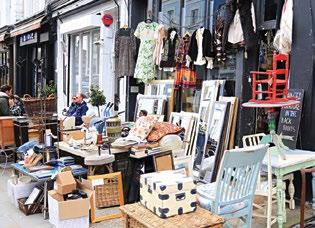


Visit the market on Saturday when the usual stalls are joined by private collections. The Portobello stores are open on other days as well.
Portobello Road, London London Underground : Ladbroke Grove or Notting Hill Gate
CAMDEN
This is an open-air type of market with stalls, shops, and restaurants and pubs. Historical market stalls are located in London's historic canal around the lock. Everything is sold here: crafts and home furnishings and clothing. Stroll around to feel the vibrations of Camden’s unique, eclectic mix of subcultures that coexist for a common purpose.
An average of 100,000 visitors come to Camden at weekends.
SPITALFIELDS
This market was established 350 years ago. Spitalfields Market is a popular place for locals to spend time.
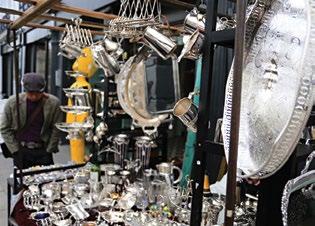
Fashionable clothes and works of art are sold here.
Saturday Style Market is special for fashion lovers. You can encounter works of still unknown but very talented designers.
CABBAGES & FROCKS
London Fashion Week organizers founded this popular market. Here, fashion and delicious natural products form an unusual combination. Vintage clothing and handmade items are exhibited by craftsmen, tailors and various textile weavers.
We recommend tasting the delicious bread and cheese on offer with olive oil, or buy it to go. Try local pork for an interesting experience.
60 VOYAGER 4/2016
WHEN A CHIPPED CUP OR A FADED BUTTERFLY WING IS MORE PRECIOUS THAN THE QUEEN OF ENGLAND'S THRONE.
56-56 Camden Lock Place London Underground : Camden Town
Brushfield St E1 6AA London Underground : Liverpool St Station
St Marylebone Parish Church grounds London Underground : Baker St
THE POPULATION OF LONDON WILL REACH 10 MILLION BY 2030 BUT THE CITY IS STILL NOT FULLY USING SUPERMARKETS. TRADITIONAL MARKETS SUCH AS, FOR EXAMPLE, THE FAMOUS SMITHFIELD MEAT MARKET, FARRINGDON MEAT MARKET OR BILLINGSGATE FISH MARKET ARE STILL VERY POPULAR. MANY OTHER MARKETS OFFER FRESH PRODUCE IN THE CITY.

BOROUGH
This place was already famous back in the 18th century. It was known as one of the main shopping centers of the city. At the time, it was a natural exchange arena, and now is the testing ground for the food industry. More than one hundred stalls offer many goods on display: hot bread, a variety of home-marinated meats or freshly prepared meat. There are all kinds of oriental snacks, and the sweetest and most delicious cakes. The question is, how much can you eat?
The following three stalls are a must-see: Brindisa offers only Spanish cuisine, Gingerpig sells sausages straight from the butcher; and Kapakaseini sells unrivaled grilled cheese sandwiches.


GREENWICH
Greenwich is famous for many things: It is the home of the Royal Observatory and National Maritime Museum. London merchant vessels used to depart from here (that is why the time standard is calculated from Greenwich). However, Greenwich is also famous for its markets. The London district of Greenwich Village is historic, established in 1700.
Today it is a World Cultural Heritage Site and the perfect place to have fun and see the history of London. Here you can buy antique, old books, eccentric bags and small handicrafts.

5B Greenwich Market SE10 9HZ London Underground : Liverpool St
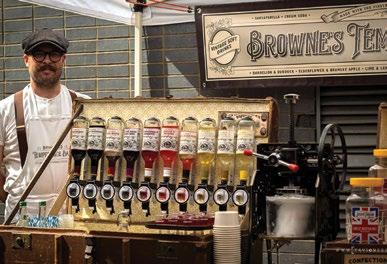
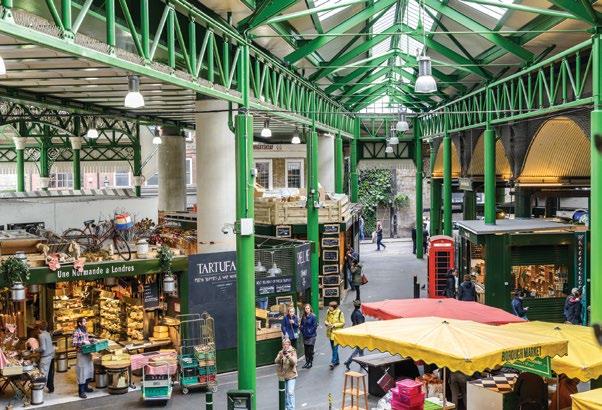
BOROUGH MARKET
8 Southwark St, London Open:
Monday-Thursday _ 10:00-17:00; Friday-Saturday _ 08:00-17:00
NATIONAL DIVERSITY HAS LED TO A WIDE RANGE OF CUISINE. 48 REGIONAL DISHES CARRY THE "PROTECTED" STATUS. THEY INCLUDE WELSH LAMB, MELTON MOWBRAY PORK PIE, KENT ALE, CORNISH CREAM PRODUCE AND WHITSTABLE OYSTERS.
MALTBY STREET
This area located in South-East London was once covered in oily garages and warehouses.
Now it is a must-see for food lovers.
Although the old-era arches still retain a kind of industrial look, things are different: all sorts of delicacies are offered at the counters, like honey and locally produced Swiss cheese, honey vodka, Herman German Pates and sausages.
61 VOYAGER 4/2016 GOURMET MARKETS
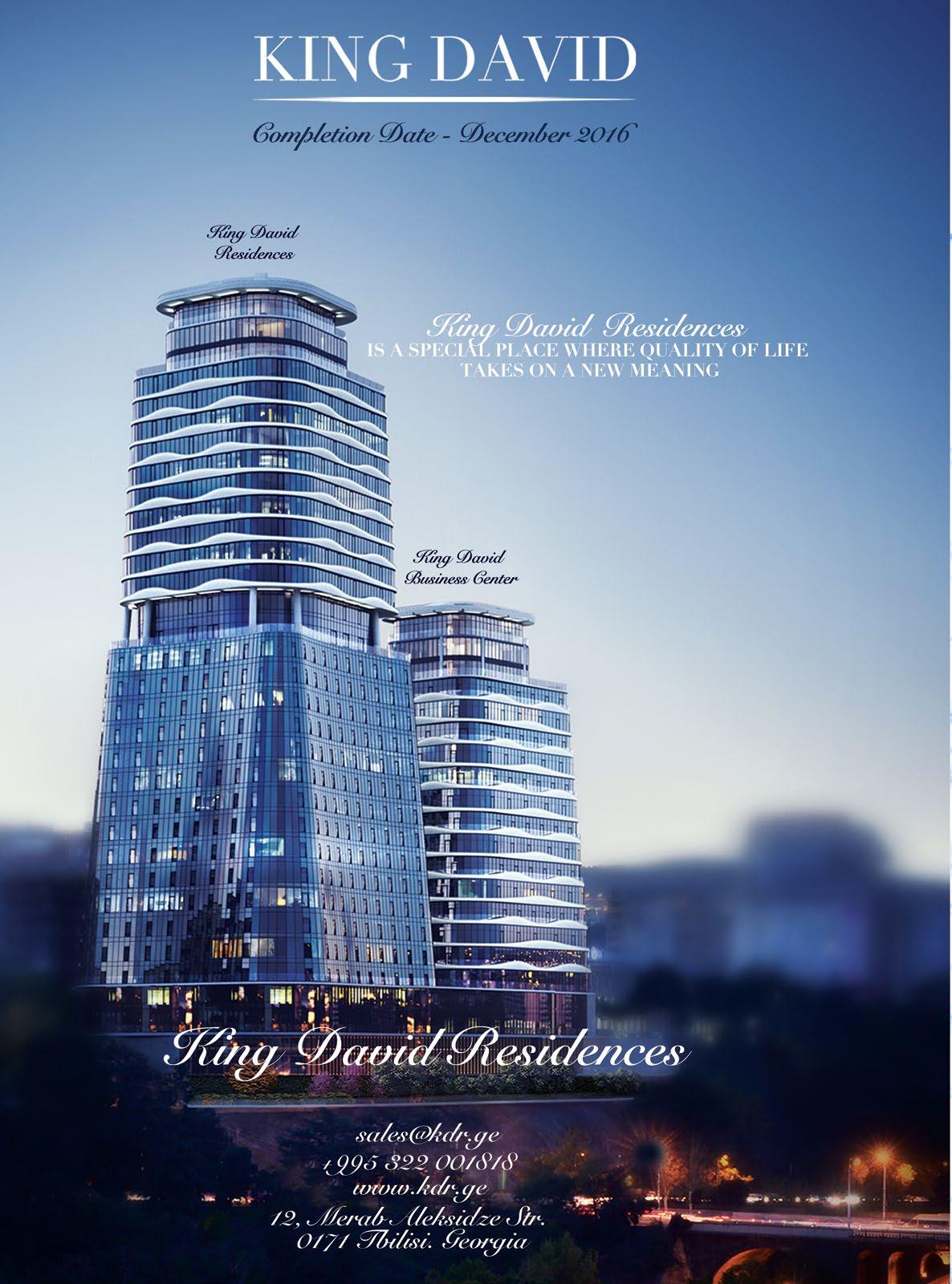

London Fashion Week is one of the world's big four fashion weeks (Milan, New York, Paris and London). The runways in London present the world's best designers. Fashion Week is held on September 16-20.
Open House London is an amazingly popular architecture festival, which takes place on September 17-18. During the festival, visitors can see hundreds of closed buildings: homes, public buildings, historic buildings, educational institutions and many others.

Grand Designs Live is held on 19-23 October, in the Birmingham NEC. The show offers recent trends in design and home interiors.
Trooping the Color is an annual celebration of the Queen's birthday. A parade is held in honor of the Queen; it includes Her Majesty’s personal army and the royal divisions.
London Film & Comic Con is hosted at the London's Olympia; here you have the opportunity to meet famous comedians and TV celebrities. You can talk to them, interview them and take photos with them.
The Proms, known formally as the BBC proms, or The Henry Wood Promenade Concerts, is an eight-week season of daily orchestral classical music concerts and other musical events. The Proms are held annually in August, mainly in London’s "Royal Albert Hall".
The Portobello Film Festival screens more than 700 new films, including documentary, fiction, music, short films and animated films. The festival will be held on September 1-16.
The Ideal Home Show, which is held annually at the Olympia, presents the world's best home appliances. Here you can find everything for your house, kitchen, bedroom and living room, as well as household appliances and other equipment.
London’s Design Festival presents featured works, both old and modern. Previously, leading British artists Paul Smith, Mark Wallinger, Tom Dixon and Zaha Hadid created an amazing golf course at Trafalgar and a moving walkway at the V & A's tapestry gallery.
The Bloomsbury Festival includes performances and live music and displays the rich heritage of this area. The 2016 theme is "Language", which will be presented in various forms.
The London Jazz Festival is held in November. One of the world's best jazz festivals, it lasts 10 days and is known for its diverse performances, which includes concerts, club music, conversations and master classes.
Hackney One Carnival fills the streets of Hackney with lively, noisy carnival parade on September 11. Dancers dressed in feathers and glitter perform to steel-band rhythms. Hackney Square hosts young musicians.
London Flower Show is held on September 8-11, from 11 am. The Osterlo Park hosts a garden, flower and plant four-day festival. You can visit 20 gardens, trade stands, flower exhibitions, and the children’s corner.
The Carnival del Pueblo is the largest Latin American festival in Europe, which is held in Burgess Park on the first week of August. This is a carnival of exotic costumes, musicians, dancers, and a wonderful show. Participants pass through London Bridge, Barrow Hill Street via Walworth Road to Burgess Park. The event combines elements of Latin American culture; musicians appear on four different stages among the dance rhythms, music, and food.
London Boat Show is held annually in January and promises a great show with lots of boats and entertaining performances occupying the whole of the ExCeL venue.
64 VOYAGER 4/2016
CALENDAR
Remember, remember the fifth of November! Mark the bonfire night and watch the fireworks! This is a British tradition which commemorates the gunpowder plot in 1605, when the Catholic conspirator Guy Fox attempted to set King James I and the Parliament building on fire. The fifth of November is celebrated with fireworks and bonfires.
If you love grilled meat, beer and loud music, then you should be at Grillstock on September 5-6. Try smoked ribs and live music on at the weekend and listen to more than 25 bands; there’s even a barbeque competition. If you have the relevant skills, participate in a hot dog eating competition.
London's Olympia celebrates the world famous chocolate festival on October 1416. Enjoy chocolate in all its forms: chocolate truffles, biscuits, ice cream, cocktails, and sculptures. Tasting, masterclasses and the famous fashion show are part of the festival.
London’s St. Patrick's Day Parade is a breathtaking sight. Participants march towards Piccadilly, passing London’s places of interest – the Ritz, Piccadilly Circle and Trafalgar Square, and arrive at Whitehall.
The St. Patrick's Day Festival is held in Trafalgar Square. This is one of the best Irish celebrations and includes a market, comedy and film festivals, music and dance shows. You can visit the London Irish pubs and bars, where you can taste traditional Irish drinks and have a good time.
Surrey County Mercedes-Benz World exhibition offers something interesting for the whole family. You can try driving on the first circuit racing track, Brooklands Drive. Visit the world-famous Northamptonshire track, which has been functioning since 1949.
Wimbledon began in 1877 when the first competition was held. This is a Grand Slam tennis tournament, which has millions of viewers and fans around the world. It maintains many old traditions, such as the strict dress code, strawberries and cream, and royal patronage. Typically, members of the Royal Family visit the two-week tournament at Wimbledon.
The Royal Greenwich Tall Ships Regatta Parade of Sail is held on September 14-18. You will see more than 50 tall ships along the east of the Thames. This is a chance to imagine how vital the Thames was as a trade route. Participate in a breath-taking performance and watch these huge ships sail back from the past.
If you love speed, visit the Goodwood Festival of Speed, which is held in West Sussex. Goodwood House in an old estate. You can meet Formula 1 stars, enjoy the show and learn about the latest technologies; why not enjoy a ride in the Cotswolds suburbs in a classic car, MGB or mini E-type Jaguar. Cover the distance from Broadway to Stone-on-Wold: it is one of the top ten UK routes.
Totally Thames Festival is held in September on the banks of the Thames. Forget the usual boat trips and wait for the festival's artistic performances, regatta, river competitions, coastal archeology and environmental activities.

The International Horse Show is held annually at London's Olympia and is considered the best event of the Christmas season. This year, the show will be held on December 13-19 and will present all kinds of equestrian events: riding, jumping and dressage.
Virgin Money London Marathon is a competition in long-distance running and is among the most important marathons in the world. In 2017, it will take place on April 23.
BY MZIA CHIKHRADZE
65 VOYAGER 4/2016
GRAMMAR OF ENGLISH ARCHITECTURE
The recent Brexit vote in the UK has once again reminded us of the peculiar character of the British people. Everyone has been talking about it. Some have criticized the action, while others believe it to be an expression of British uniqueness and success. I therefore decided to look at the country’s architecture from this perspective and observe how it reflects the British character.
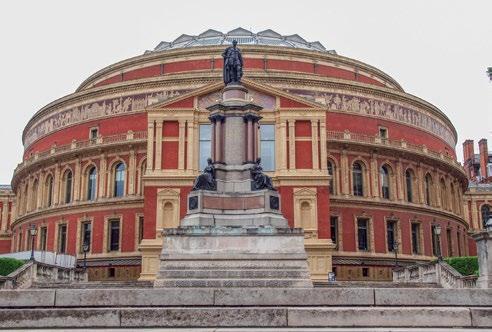
“A home is our tower and fortress against violence, it is secure, and a human life carries superior value and is protected by the law" – this quote by British politician Edward Cocks clearly reflects the British attitude towards their houses and the British islands in general. He expresses that a house is a fortress filled with comfort; the same is true of the UK. Strangers from outside should not enter – especially those from the continent!
This principle is visible in the urban structure of the British capital. London was built around two centers – the Palace of Westminster and the City – while other European cities have spread out from monumental focal points and historical centers. London has therefore remained committed to the above-mentioned citation.
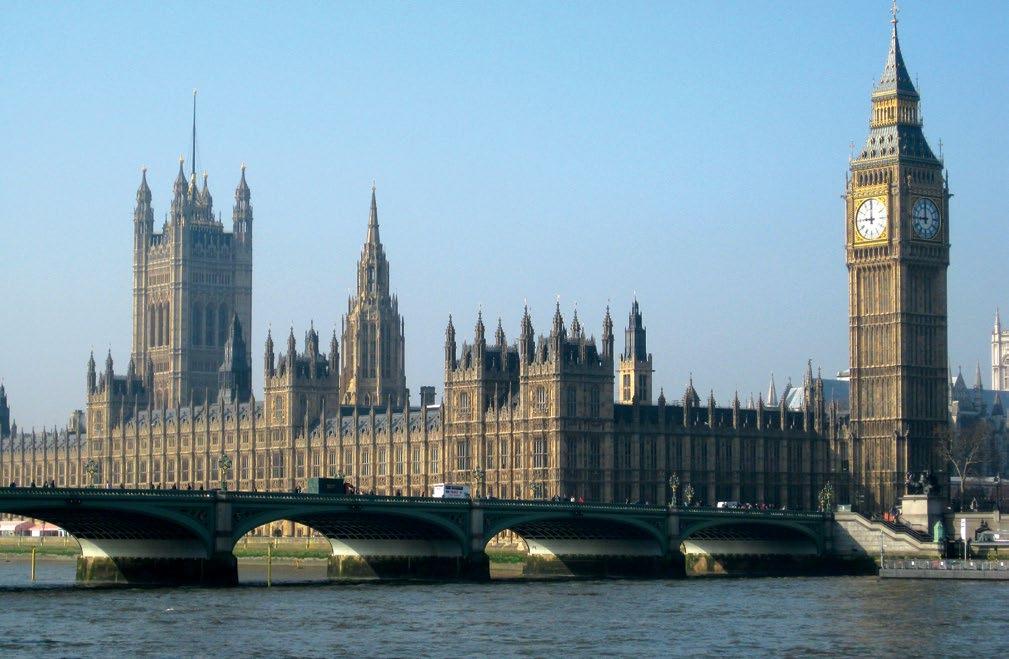
The city was formed district after district to keep it comfortable and secure. Quarters were formed according to housing alignments with a public square often in the center. Only the quar-
ter dwellers had access to the square gate; this arrangement simultaneously provided public space publicitynd safety.
A city is rarely the result of pre-planning and monumental unity but the development of residential districts (inner spaces). Therefore, in London, as well as in other British settlements, the city is for “living”. Despite the catastrophically high land prices, London has retained its airy atmosphere; the architecture of this city is not oppressive, which makes for a pleasant life for its inhabitants.
ARCHITECTURE
66 VOYAGER 4/2016
NIKA CHKHAIDZE
Architectural Styles and their Creators
Britain developed its own trendy architectural movements just like other European countries; however, British peculiarities have emerged again and again. We will look at British architecture from a "top-down" perspective; we will not discuss the latest architecture or future design possibilities. The city’s post-war reconstruction provides an interesting example of classical modernism. It reveals the character of modern London.
1920s architecture is an early example of the classic Modern style. Home interiors were like those described in Agatha Christie novels, in the days when Rolls-Royces paraded around the streets.
Edwardian era architecture encompasses the period of Edward VII’s reign (1901-1910). Ordinary buildings were decorated with fewer ornaments while monumental buildings remained loaded with “Edwardian Baroque" characteristics.
The Arts and Crafts style flourished between 1880 and 1910. This style of architecture was based on the ideas of John Ruskin, William Morris and Augustus Pugin, who exerted a powerful influence on British design. Their theory that traditional craft had to accommodate deocrative forms resulted in softer ornamentation. This style was anti-industrial in its form and, therefore, not economically feasible; however, it has not disappeared altogether and is still used for exclusive high-budget projects.
Victorian Era Architecture
Victorian era architecture is also known as the Charles Rennie Mackintosh Revival style. This kind of cocktail is exceptionally interesting and I will describe it separately. It covers more than the period of Queen Victoria's reign (1837-1901). The "revival" and "confusion" styles had started earlier.
The phenomenon clearly shows key features of British architecture and peaked during the Victorian period. It was developed during Britain’s heyday as one of the most influential and wealthy states in the world, sustained by its political and economic conditions.
Georgian Architecture
Georgian architecture developed in 1714 -1830 during the reigns of Kings George I, George II, George III and George IV. It also includes the revival style but is "strange" and mainly based on classical Greco-Roman architectural principles. At this time, Classical style completely took over from the previously dominant "vernacular" (traditional folk) architecture.
Gothic architecture
Gothic architecture followed the principles of European Gothic style but in Britain gained a more sophisticated appearance and developed some key differences from its European contemporaries.
1. Royal Crescent, Georgian architecture pattern.The city of Bath.

2. St. Paul's Cathedral (1708). Architect Christopher Wren.

3.The Royal Pavilion in Brighton (1787).
Architect John Nash.This amazing building combines the style of all of the British colonies.

3 1 2 67 VOYAGER 4/2016
Tudor architecture
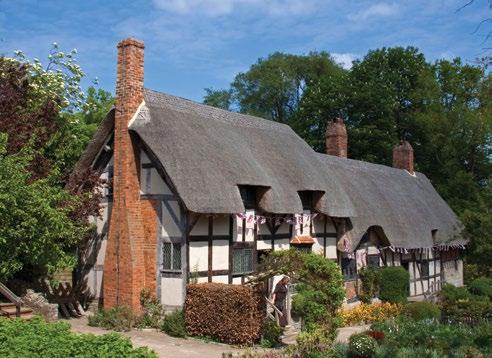

The Tudor period (1485-1603) saw the last stage of the development of medieval architecture, not only in England but throughout the UK. It encompasses the period where attempts to introduce Renaissance principles took place. This style of development climaxed in 1500-1560, after the late Gothic style, and into the reign of Queen Elizabeth I. The residential buildings of this time are unpretentious, built with "folk" traditional methods and recognized by their wood structure facades and straw roofs. Military and monastic architecture was ascetic and robust. While obviously becoming essential to later building styles, bricks were rarely used in construction at the beginning of this era.
You will encounter many architectural mysteries in Britain and London despite what appear to be distinct timelines and styles. You will find buildings that look Classical, Gothic, Renaissance, Oriental and Egyptian though they have been built in the XVIII-XIX centuries. As I have mentioned above, the Revival Style, which coincided with the dominance and prosperity of the British Empire, diversified and significantly improved the country's architecture.
This period was preceded by the British Baroque. It should be noted that the three architectural stars of this period – Sir Christopher Wren, John Vanbrugh and Nicholas Hawksmoor – cannot be considered solely Baroque architects. Their output included Neoclassical, mixed eclectic or any other style of working, at their own discretion.
Wren was an intellectual and erected the culmination of British architecture – St. Paul's Cathedral. Vanbrugh was a Frank mason, and his buildings (mostly churches) are often depicted in mystical and horror films or literary works. Hawksmoor was not an architect but had a refined taste and considerable authority among high society, hence he received many orders.
Thus, in spite of their European origins, British architectural styles have unique national characteristics, especially in the period when Britain was at the peak of development and was established as a trend setter in every domain.

The Revival Style
I'd like to especially touch upon the Revival Style, which was very important in the development of British architecture. Thomas Cole’s painting “The Architect’s Dream” clearly reflects the general attitude of the XVII-XIX centuries: the creator faces several historical and architectural directions and structures; he considers, hesitates, and like a barman or a chemist mixes, dissolves, and shakes the styles.
Why was British architecture developed in this way and what brought it on? Researching the tastes of the XVII-century British aristocracy helps us answer these questions. This was the time when "high aristocracy" general aesthetics began to be established. New residential districts flourished and the aristocracy assigned to them their own names (e.g. Southampton). The high society adored ancient philosophy and literature; they studied Latin and ancient Greek, cited Virgil and knew works of Homer by heart. It is therefore no surprise that Neoclassical style became prevalent.
 AnneHathaway'sCottage,Shottery,Warwickshire
1. "Architect's Dream", Thomas Cole
2. Strawberry Hill, 1747, Twickenham
3. William Shakespeare's wife, Anne Hathaway’s cottage
AnneHathaway'sCottage,Shottery,Warwickshire
1. "Architect's Dream", Thomas Cole
2. Strawberry Hill, 1747, Twickenham
3. William Shakespeare's wife, Anne Hathaway’s cottage
ARCHITECTURE 68 VOYAGER 4/2016 1 3 2
DeaneryTower,Hadleigh
However, the style that took hold was not actually classical Greek or Roman but based on the work and late Renaissance style of the Italian architect Antonio Palladio.
If we compare the structure of London to Palladio’s villa "Rotonda", we will recall that Palladio’s architecture did not consider buildings as separate units but designed them in accordance with the environment. That's why he was British aristocrats’ main choice; Palladianism began its “reign”.

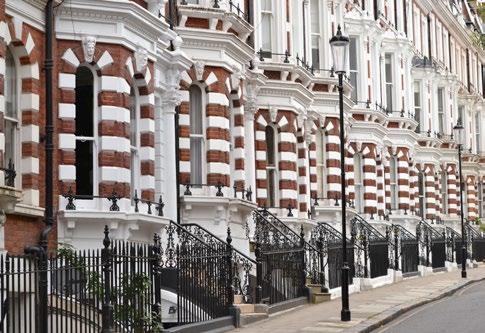
All of this was changed when a young aristocrat, Horace Walpole, son of the Prime Minister, decided to build a house in 1747.
When he was faced with the style decision, Walpole opposed the established order and decided to erect a Neo-Gothic building instead. Due to his superior social status, Walpole was not concerned by the possible negative reaction from critics.
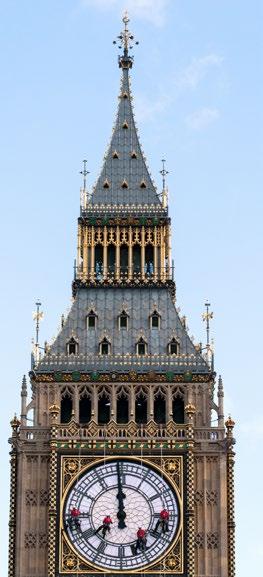
He instead united significant details and characteristics of classic British Gothic buildings and added many details of his own taste. The result was the legendary Neo-Gothic palace, Strawberry Hill.
The building caused such a fuss in society that tickets were sold to the viewing public. This experimental Neo-Gothic style used in estate projects gradually became adopted in public buildings and became extremely popular. It was widely used for both private and public facilities.
Parliament had to be rebuilt in the 1830s after a fire. The decision to build the British Parliament building in the Neo-Gothic style of Charles Barry and Augustus Pugin was highly controversial.
Supporters of the Classical Greek style argued that their preferred style rather than a Renaissance design would be much better, especially given the new archaeological discoveries being made in Greece at the time. This was followed by suggestions from advocates of Neo-Roman, Neo-Byzantine, Oriental, Chinese, Swiss and other styles of design. Everything was possible, including a mixture of styles.
The aristocracy were gradually replaced by the new bourgeoisie. This new class was not interested in philosophy or literature. Tasteless buildings consequently “conquered” the island. The same process took place in Europe but Britain was its undisputed leader.
For example, in one particularly humorous story, a wealthy couple in Northern Ireland decided to build a house. The husband loved Classicism while the wife adored the Gothic style. After a long debate, the architect of the project offered a compromise: the front facade could be Classical and the back Gothic; such a division also took place in the interior design.
Members of the Arts and Crafts movement attempted to regulate this chaotic situation; however, architecture based on synthesis of art and craftsmen’s skills was so expensive that only a few could afford it.
This process did not stop all at once. Progress provided the answers. Industrialization and the development of technologies turned construction leaders into pragmatic engineers. They regarded decorations as a useless novelty. Philosophy, art and architecture moved towards progress and modernity.
Cast iron and glass was used to build the Crystal Palace and chaos slowly disappeared from history. A new era in British architecture commenced.
Big Ben
Big Ben is a massive bell, which weighs more than 13 tons and hangs in the clock tower. The clock rang for the first time on May 31, 1859. In June 2012, the House of Commons ruled that the clock was to be renamed the Elizabeth Tower in honor of the Queen’s diamond anniversary.
Westminster Abbey
The Gothic cathedral of Westminster Abbey is a UNESCO World Heritage site. Here you can see wonderful art, beautiful stained glass windows and other religious artefacts. Charles Dickens, Charles Darwin, Dr. Samuel Johnson and Geoffrey Chaucer are buried in the Abbey. It has been the site of the coronation of British monarchs since 1066.
69 VOYAGER 4/2016
GALLERY OF LONDON PARKS. GREEN PARK AND ST JAMES'S PARK ARE THE BEST OF LONDON’S TOP FIVE PARKS. THE OLDEST PARK IS IN WESTMINSTER. VISIT REGENT'S PARK, VICTORIA PARK AND THE FAMOUS HYDE PARK. THE PARKS STAY GREEN ALMOST YEAR ROUND DUE TO THE MODERATE CLIMATE.
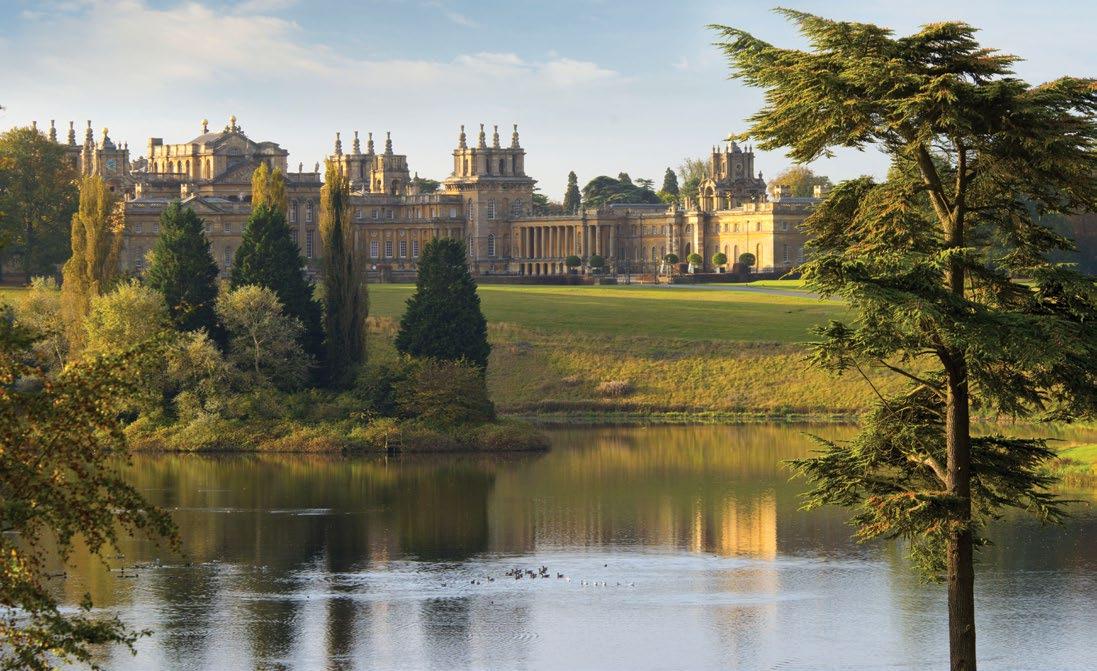
ENGLISH GARDENS
It is said that the whole of England is a magnificent garden, planted by a master gardener. It is light in like a woman and speaks to you, with undertones and hints. English gardens are different from the pompous French, wealthy Italian or exotic Spanish ones. Effortless, free and natural – these are three main features of the English garden.
so-called French park style became popular, and was soon replaced by the English garden. Its creator was Lancelot Brown.
Brown was responsible for the emerald green meadows, small hills and disorderly planted trees of the English garden. He became the royal gardener in 1764.
2016 MARKS
WELL-KNOWN BRITISH GARDENER LANCELOT
BROWN'S 300 BIRTHDAY ANNIVERSARY.
There was a time (1066-1500) when English gardens had only utilitarian purposes (providing food). However, they then came to include flowers; the Tudor era is often mentioned as the beginning of the landscaping era, when symmetry, shaped shrubs and evergreen plants were merged with utilitarian functions and parks began including statues of animals or depictions of nymphs.
Dutch and oriental plants were imported in the XVII century, during the Huguenot era. Gardening societies were established, botanical gardens were planted and orangeries set up. The
He created the new ’landscape style’ and destroyed all of the established French garden trends: rectangular alleys, mazes, floral shrubs; Brown dried up artificial ponds, dug up puddles and grouped trees to achieve an intimate landscape.
He tried to copy nature, building with a poet’s senses and artist’s eyes. ’There are no straight lines in nature’ was the main principle of his work. He improved contrasts and views, placed borders between parks and surrounding forests and fields, turned paths into pleasant places for walking, and put in seating with panoramic views.
70 VOYAGER 4/2016
If the French park was the firstborn of absolutism, Brown’s English garden was a decedent of democracy. This is why I advise visiting old English gardens and enjoying the synthesis of natural and manmade landscapes.
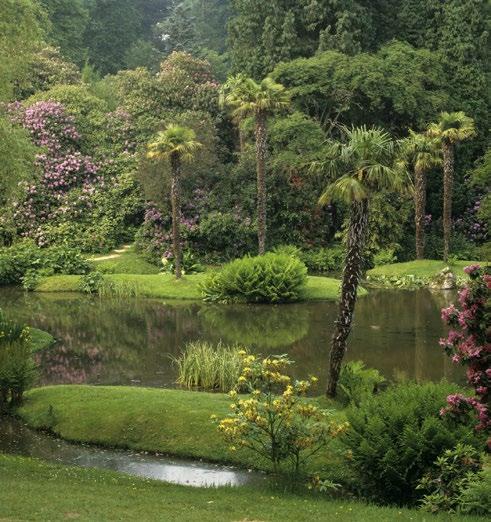
Blenheim Palace Park stands out among the best. Spread over 800 hectares, it took Brown 11 years to complete. He did not touch the XII-century oak stand. The park contains 60 oak trees that are 900 years old. Brown also built a waterfall, the Grand Cascade, which is one of the most beautiful in England. The estate is located in Oxfordshire, and half an hour by car west of London. Tickets cost £22.
Burghley House has a park that surrounds Count Exeter’s residence. Brown remodeled it in 1755-79. He tilted straight alleys, built the lake and planted the orangery. He also constructed the summer house and the so-called ’lion’s bridge’, which is considered a landmark of this old estate. It is located in Lincolnshire, 2 hours and 40 minutes north of London. Tickets cost £14.
A charitable organization has owned Compton Verney estate and park since 1990. It includes 3,000 oak, cedar, elm and ashfall trees, planted by the genius Brown. It houses a wonderful art gallery. It is located in Yorkshire, an hour and 50 minutes north of London. Tickets cost £8.
The resort town Harrogate is located in North Yorkshire County; it includes Brown’s special gardens. It is one of Britain's most beautiful cities. Brown created dozens of gardens here. Brown's sketches and paintings, depicting the gardens, are exhibited at the Mercer Art Gallery. The town is 3 hours and 20 minutes north of London. Tickets to the gallery cost £19.
CHELSEA FLOWER SHOW
The Chelsea Flower Show is considered a major European gardening event. It signals that summer is coming to foggy Albion, with the exhibition held every spring at The Royal Hospital Chelsea exhibition center. It is the largest display of flowers, landscape design and gardening; it defines the trends of this art.
The first exhibition was held in Kensington in 1862, and has been held annually ever since; the Royal Horticulture Society started an international exhibition in 1913 in the beautiful surroundings of the Royal Hospital in Chelsea.
Participation in the Chelsea Flower Show is highly prestigious; hundreds of thousands of visitors come to see the successful designs. The English consider garden maintenance to be very important.
Gardeners and designers from Australia, Japan, South Africa and others gather to participate in the exhibition. They present their work to a panel of strict judges. The exhibition theme is changed every year, and is announced in advance. This year's exhibition commemorated the 300th anniversary of the birth of Lancelot Brown, England's greatest gardener, while the theme was a Jurassic Park landscape. The organizers were inspired by the Natural History Museum.
Just like the Ascot races, the Chelsea Flower Show is distinguished even among the country’s elite events. It is visited by members of high society and famous people, including the Queen and other royal family members; Kate Moss and Benedict Cumberbatch are diehard gardeners.
The Chelsea Flower Show has an unwritten dress code: for gentlemen, light cotton trousers and a linen jacket; for ladies, a floral or pastel dress. And most importantly, do not forget a flower hat and picnic basket with champagne and strawberries.
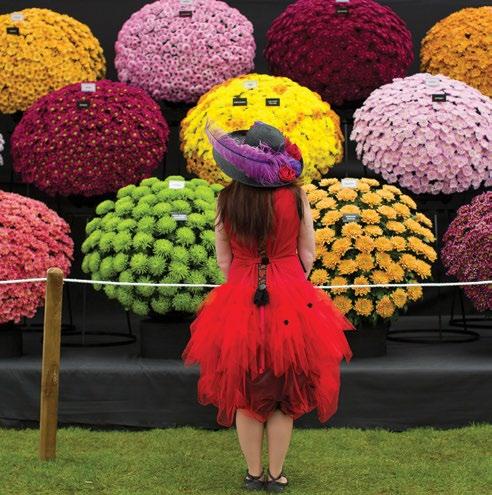
71 VOYAGER 4/2016
GARDENS
IN 2002, BBC TELEVISION LAUNCHED A SURVEY AIMING TO FIND THE 100 GREATEST BRITONS.
SIR WINSTON CHURCHILL WON WITH 447,423 VOTES OUT OF THE 1 MILLION CAST. THE REST OF THE TOP TEN INCLUDED ISAMBARD BRUNEL, LADY DIANA, CHARLES DARWIN, WILLIAM SHAKESPEARE, SIR ISAAC NEWTON, JOHN LENNON, ELIZABETH I, HORATIO NELSON AND OLIVER CROMWELL.
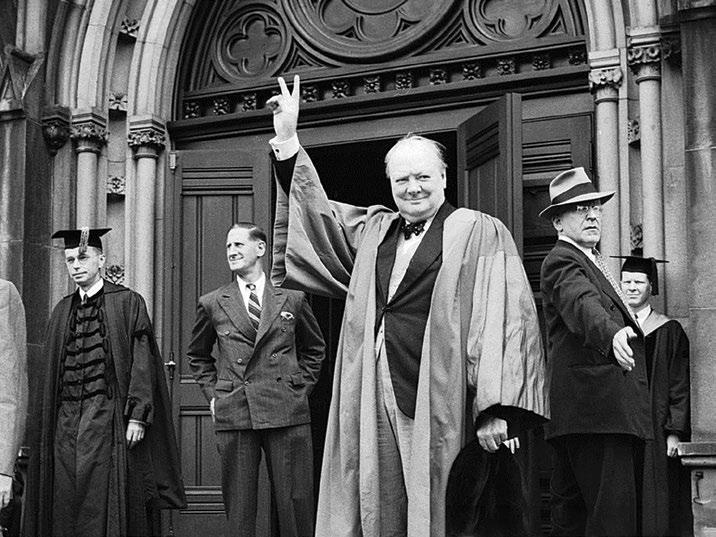
CHURCHILL, WINSTON CHURCHILL!
BIDZINA BARATASHVILI
Churchill's birth announcement was printed on the front page of “The Times” on the second day after his birth. It describes that Lady Randolph ignored the doctors' advice, danced a lot at Blenheim Palace and gave birth to her baby prematurely – two months before the due date – in the dressing room!
The first legend was born here: Winston Churchill is not the Duke of Marlborough's son! Source: the couple's relationship was far from perfect. The husband was often ill and spent most of his time on his political career. His wife, surrounded by numerous admirers, was engaged to Winston's father three days after they met. Soon after, they got married, and they had a child 7.5 months later. There is no doubt that the mother was pregnant when Randolph proposed. Bertie, the Prince of Wales, was named as the alleged father.
MOTHER
Jenny Jerome, the daughter of an American millionaire, according to some theories, was distantly related to the American president, Franklin Roosevelt, and according to others was of Iroquois ancestry, while some researchers combine both stories. One thing is clear: Clarissa Wilcox, Jerome’s mother, and the future grandmother of the famous Prime Minister, was dark-skinned and distinctively not Anglo-Saxon, though she claimed to be half-Irish.
Lady Churchill was famous for her infatuation with young men. Her second husband, George Cornwallis West, was Winston’s age, while the third, Montagu Phippen Porch, was three years younger than Winston!
FATHER
Randolph Spencer-Churchill, 7th Duke of Marlborough, was the youngest son of John Spencer-Churchill, whose name can be traced back to William of Normandy. The family became poor over time and the son received no inheritance from his father. Britain's reigning premier Benjamin Disraeli even joked that they were not dukes anymore as they were too poor. However, Randolph managed to become Queen Victoria’s Indian Affairs Minister and then Chancellor the Exchequer. The cause of his death was unclear. Harris, based on Jengins’ accounts, reports that friends had left Randolph with an ugly prostitute, who had syphilis. He was infected and died.
Winston was raised by a nanny – the usual arrangement for the time. Rumor has it that one aristocrat complimented his children in the park on their good looks and was very surprised to hear that they were his own! The Prime Minister once admitted after a dinner that he had spent more time with his son Randolph, Jr. that evening than his father had spent with him his whole life.
HISTORY
72 VOYAGER 4/2016
EDUCATION
Young Churchill received his elementary education in Ascot, where he was often flogged for disobedience. Ascot was followed by Harrow and the Royal Military Academy Sandhurst, where he was enrolled on his third attempt. This is what gave rise to the myth that Churchill did not like studying; in fact this is true only for the subjects that did not appeal to him. He had no equal in literature, history, military tactics and strategy.
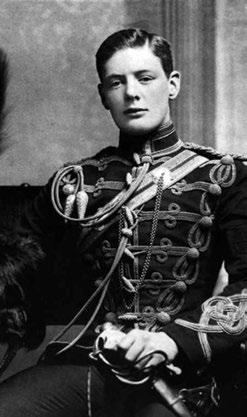
Churchill’s wonderful sense of humor was formed at that time. Once his teacher publicly scolded him: “Winston, I am very dissatisfied with you!” and immediately received a witty (and brazen) reply: "Sir, I was going to say exactly the same thing about you!”
CHURCHILL, WINSTON CHURCHILL!
Ian Fleming could easily name his agent 007 Churchill. Judge for yourself: he began his military career in a regiment but soon travelled to Cuba in search of adventure. He helped the Spaniards deal with the riots and was awarded the Red Cross. In addition, young Winston was talented and prepared a series of articles for “The Daily Mail” which were reprinted in the "New York Times". The soldier-correspondent spent next two years in India and fought there too - this time with the Pashtuns. He later described this period in his book "The Story of the Malakand Field Force".
Some 8,500 copies were sold and the author became popular. Sudan followed India, where Churchill represented "Morning Star" and wrote his bestseller, “The River War”. According to legend, he personally killed four men and even smashed one of their skulls in! That same year he moved to fight the Boers in South Africa, was captured, escaped, and then presented the Victoria Cross by General Hamilton.
LITERARY WORK
His literary activity peaked in 1953 when the Swedish Academy awarded him the Nobel Prize over Ernest Hemingway!
WOMEN
Although Churchill is believed to have had several affairs, his relationship with Clementine Hozier was the main one. They met in 1908 and married on September 12 in St Margaret's, Westminster; they did not part until his death. Edward VII presented him with a cane with the inscription “to my youngest minister" as a wedding gift. Churchill carried the cane throughout his life. This following example illustrates his attitude towards Clementine: when he was asked, "who would you be in another life?" Churchill replied: "Mrs. Churchill's second husband!"

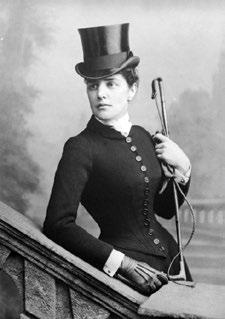
He was not such a gentleman with other ladies. When Bessie Braddock gushed during 1946: "Sir, you are drunk!" Churchill replied: “My dear you are ugly, but tomorrow I shall be sober and you will still be ugly”. Later, this episode became the base of a number of jokes.
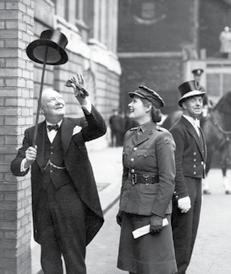
He had an even wittier response for the angry Lady Astor who said: “If I were your wife, I would certainly poison you tea”. His reply: “If you were my wife, I would drink it with pleasure!"
However, there was another woman who was friends with him – the charming Odette, the wife of champagne producer PolRoger. She was introduced to the Prime Minister by Mr. Cooper Dap, in 1944, at a reception in Paris. Churchill remembered the company address for the rest of his life, for Odette’s sake: PolRoger, 44 Avenue de Champagne, Epernay, and called it the best champagne in the world. In response, Odette named their new champagne Cuvée Winston Churchill in 1984.
POLITICS
"The greatest Briton” did not express party loyalty. He made his the first steps in politics in 1899 with the Conservatives and a year later was accepted to Parliament in frames of their quota, but in five years was an independent non-party member. In 1906, he became deputy minister of the colonies and a member of the Labour Party; he worked as Finance Minister for the same party. He worked so effectively that a position that was considered of secondary importance was granted the same salary as the elite. In 1910, he moved to the Ministry of Interior. The next year he led the maritime field, and immediately modernized it and replaced coal fuel with oil. For this purpose, he began cooperation with Iran and raised the UK’s geopolitical interests in the Persian Gulf. He also authored a number of air carrier initiatives; were it not for
1. Winston Churchill the Royal Military Academy Sandhurst
2. Mother - Baroness Jenny Jerome
3. Wife - Clementine Hozier
73 VOYAGER 4/2016
4. Daughter - Mary Churchill
the 1915 failure to capture the Dardanelles, who knows what else he could have done! Instead he had to leave the service and his colonel position in the Scottish regiment.
Churchill’s popularity is associated with amusing episodes. When he was preparing for the 1900 parliamentary elections, one person told him: “I’d rather vote for the devil than you!” “That is clear”, said Churchill, “but if your friend gives up the candidacy, can we at least count on you?”
In 1922, the Labour Party lost the election and two years later Churchill joined the Conservatives again! One former party member responded: “I would probably be upset if I were slightly interested in my colleagues’ opinion”.
He was received coldly in the new team and clearly failed to form favorable relations with Prime Minister Chamberlain. Hence, Churchill had to move into the background. He spent his time speaking up against India and Germany and was mostly active in the literary arena and in the refinement of his witty mind.
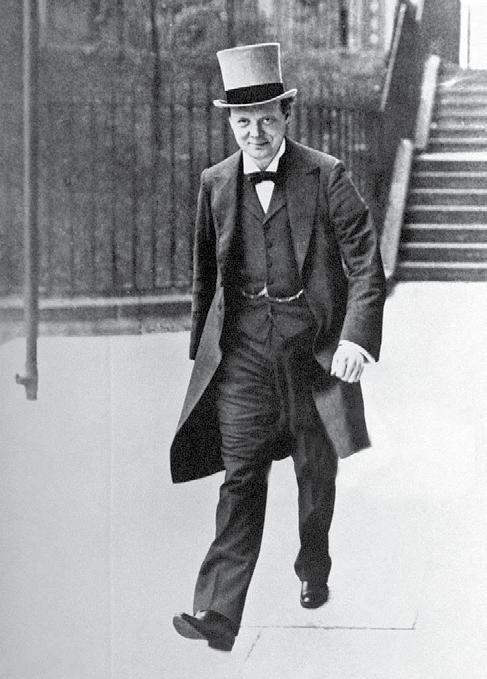
In 1931, Bernard Shaw, famous for his humor, sent Churchill a telegram: “I am enclosing two tickets for the first night of my new play; bring a friend, if you have one". The answer was: “Cannot possibly attend first night; will attend second – if there is one”.
Churchill managed to charm the young audiences and was always regarded as an exceptional speaker. Consider his reaction in 1938, when Neville Chamberlain signed an agreement in favor of Hitler's Germany: "You were given the choice between war and disgrace, and you chose disgrace, so you will get the war" or his appeal to the nation during the first war days (as PM): "I cannot offer anything but work, sweat and tears! We have to fight on land, at sea and in the sky, by all means, in order to spare humanity from the tyranny of a kind we have not seen yet! What is our goal? Only to win, at all costs, despite all the troubles! Otherwise we cannot survive, all the things there are precious will perish! We should not allow nor tolerate that!"
According to opposing myths, he was not a good public speaker, was extremely hesitant, and had difficulty talking; actors made radio speeches in his place. So, what’s the truth? He did not really have a speech impediment, but just like his father he pronounced “s” as “sh”. Practicing with Sir Felix Semen almost eliminated this manner of speech, though he always talked nasally. As for the backup actor, that is just a myth. Many monographs claim that Churchill refused to repeat his passionate speech to the House of Commons on June 4, 1940 and that the actor Norman Shelley performed it on the radio for him. In fact, there was no evening broadcast on that date and the radio host read parts of Churchill’s speech.
In the early years of the war, Churchill worked 18 hours a day and, in addition, retained his cheerfulness. When the Germans started bombing during his live radio broadcast, he told the listeners: "I have good news for you, they missed the Parliament building again!"
The Prime Minister hated the Communists and wanted to destroy them in 1917. Nevertheless, during the war years he cooperated
with Stalin and ironically explained it: "I have only one objective: to destroy Hitler! If he’d attack hell, I’d probably declare my loyalty to Satan”.
The press over-exaggerated his fondness for Stalin—no such expression is documented or confirmed, as well as the myth of his love towards Armenian brandy. You may often read that after Stalin offered “Dvin” to Churchill in Tehran, the PM only drank this brand. When the brandy quality was spoiled, Stalin had to free the brandy technologist Margar Sardakian from the Gulag. In fact, Sardakian had never been taken into exile. He worked in the Yerevan Brandy Factory in 1948-73 and the "Dvin" label was only released in 1945. Thus Churchill could not have tasted it in Tehran. His favorite brandy was HINE.
Churchill’s friendship with the Soviet Union did not last long anyway. The retired Prime Minister made a historic speech in 1948, during his visit to America, in Fulton College. He coined the term “the Cold War”. That's when he first used the term "Iron Curtain", which social scientists use to this day. According to another myth, Churchill was preparing a nuclear attack on the 25 cities in the Soviet Union, including Tbilisi. Churchill's "cruelty” is a topic for a separate conversation.
Various rumors surround his decisions during the war. Some say that Churchill knew about the planned Pearl Harbor attack and did not tell the USA, to engage them in the war. In fact, the British decoded only 5-20% of the Japanese data and accurate information simply did not exist.
HISTORY 74 VOYAGER 4/2016
Churchill is also said to have known about the Coventry air attack, and let the Germans destroy the English town, sacrificing 507 people to continue using the "Enigma" code in future. In fact, on the night of November 14, 1940, the British were expecting five alleged attacks. Churchill ordered five times more canons for Coventry than for London but still could not keep the city safe.
Others say that Churchill was responsible for the "Bengali Holocaust". Seven million Indians died of hunger in 1943-45 but the reason was the Japanese occupation of Burma and the closed border, as well as a devastating cyclone. Britain could not split its forces on three fronts, though Churchill tried to diffuse the tension. In general, India has legitimate reasons to dislike Churchill – he strongly opposed granting independence to India, just as he opposed the independence of other colonies. None of the colonies left the Empire while Churchill was PM. It is believed that he made a number of racist remarks.
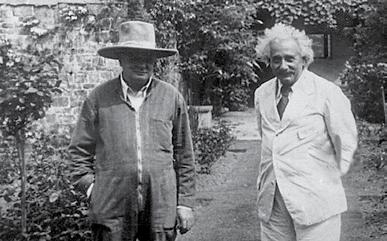

It is interesting that Churchill created some myths himself. He was perpetually late; for example, he was late to Princess (now Queen) Elizabeth's wedding dinner. The "guilty" PM admitted that he was doing so to draw attention to his own persona. Churchill smoked a lot. His classic stereotypical portraits always depict him with a cigar in his hand. They say that he smoked 7-15 cigars a day and kept 3,000 pieces in reserve and as soon as this number
dwindled slightly, he contacted Cuba. In fact, Churchill only smoked half a cigar at a time and abstained for two weeks in 1947 due to a hernia operation. According to a witness, he asked his driver to stop the car and lit a cigar demonstratively before his famous Fulton speech—he claimed that the audience would not recognize him without the trademark.

When journalists asked the elderly Prime Minister what the secret of his virility was (despite his obviously unhealthy lifestyle) he answered: "Conservation of energy. Never stand up when you can sit down. And never sit down when you can lie down. So, eat, drink and smoke as much as you want and, most importantly, do not engage in sports!” However, Churchill was a great athlete: he played polo until he was 52 years old, rode horses until he was 73 years old, swam a lot and took care of his health. That’s why he lived to the age of 90 despite suffering two strokes. It should be noted that the BBC hired five men for Churchill’s 80th birthday; they were tasked to film his " last days", including his burial. However, only two of them lived long enough to see his death!
Sir Winston Churchill suffered a third stroke in the winter of 1965 and passed away on January 24th, exactly on the 70th anniversary of his father’s death. Shortly before, he joked: "I am ready to meet my Maker. Whether my Maker is prepared for the great ordeal of meeting me is another matter”.
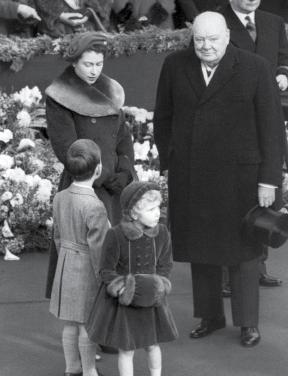
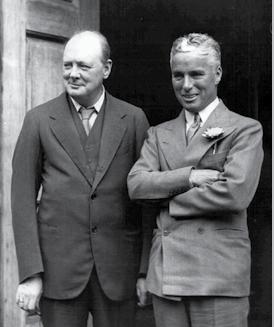
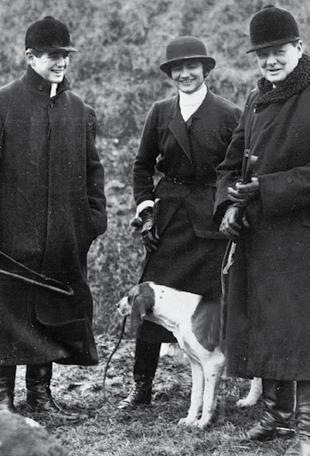 1. Aristotle Onassis
2. Maria Callas
3. Queen Elizabeth II
4. Son and Coco Chanel
5. Charlie Chaplin
1. Aristotle Onassis
2. Maria Callas
3. Queen Elizabeth II
4. Son and Coco Chanel
5. Charlie Chaplin
75 VOYAGER 4/2016
6. Albert Einstein.
ALL HAIL THE QUEEN!
They say that she has delicate, pink, almost clear skin, and her eyes are green and lively. They also say that her appearance brings the unforgettable lightness and smell of children’s soap.
So they say. I don’t know. How could I? I haven’t met the Queen of England yet.
This summer, right before the Brexit vote, the island was getting ready to celebrate their queen’s 90th birthday. Fortnum and Mason produced a commemorative collection of fine bone china to mark Her Majesty the Queen’s 90th Birthday. Tourists were happy. They could now drink tea with the Queen! The tea set was well sold.
This woman, who has spent most of her time on the British throne since she was born on April, 21, 1926, is Her Majesty the Queen of the United Kingdom, Canada, Australia and New Zealand.

Her subjects from Jamaica, Barbados, Solomon Islands, Bahamas, Papua New Guinea, Grenada, Tuvalu, Saint Lucia and Saint Vincent
left her. Belize, Antigua and Barbuda also gained independence. The world has changed since 1952 – the year when Elizabeth II was crowned. The empire exists no longer but she does. She is unaffected, with her tiaras and smiles, rubber boots and “Hermes” scarfs tied under her chin, riding a horse just like she did when she was young, when she was “the queen of hearts”.
The island, weakened by World War II, desperately required her courage and smile. She was needed. Brave and beautiful, she always held an important place.
Here she is on a high tribune right to Winston Churchill, or in her military uniform by a Red Cross car – she is always smiling, she is always elegant, with dark, shiny hair and a broad English smile. Later, her wonderful wedding was broadcast on BBC radio; 200 million people listened to it around the world. It was a real fairy tale. The groom was just the right type: tall, handsome and in love. Philip Mountbatten, today Prince Philip, Duke of Edinburgh, was Prince of Greece and Denmark. An Orthodox Christian prince who had no kingdom, nor financial wealth, carried one big privi-
MONARCHY 76 VOYAGER 4/2016
SALOME DADUNASHVILI
lege: the future queen loved him. He remains calm and masculine to this day – an enduring shoulder for the Queen.
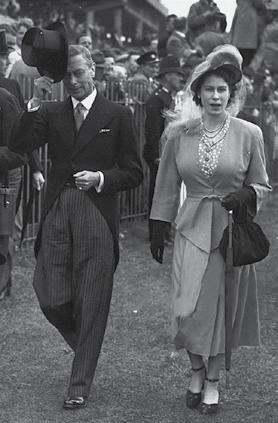
The royal wedding took place in front of all nations, but without the groom’s German relatives (who were connected to the Nazis) and the royal uncle, Edward (who had severed all ties with the royal family). The royal wedding was held right after the war in 1947 (Elizabeth had to use special coupons to buy the material for her dress).
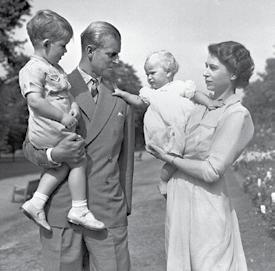
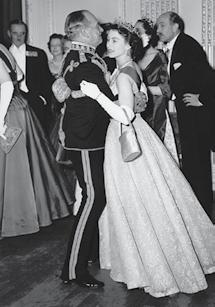
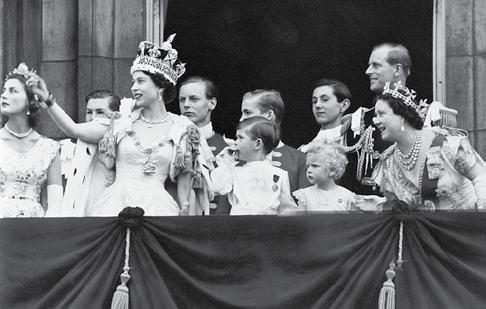
Elizabeth II would not be the Queen of England were it not for the great love story of her uncle, Eduard VIII, meeting a strange, elegant, brave (and divorced) American woman.
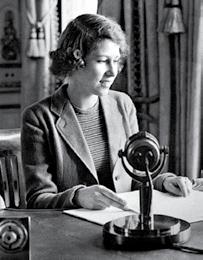

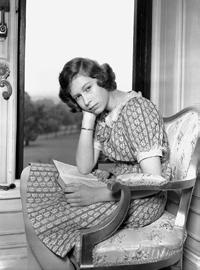
Had Edward not swapped the British throne for a comfortable life in the Bois de Boulogne with the woman he loved, Britain would probably have a completely different queen. However, he went away. He spent the rest of his life with the woman he loved, surrounded by her Chinese ceramic dogs and Cartier broches. He lived happily ever after. An Arab millionaire, Mohamed Al-Fayed, bought the Boulogne love-nest afterwards. He was the father of Dodi, the ill-fated lover of Elizabeth’s former daughter-in-law, Diana. The world of aristocrats and millionaires is a small world after all!
Diana was a big crisis that the royal court had to endure. The young girl, in the confection of material that was her wedding dress, with a confused smile and eyes full of love. Diana instantly became a queen. She was the queen of hearts now. The queen who is constantly mourned.
Elizabeth endured this crises calmly; she belatedly expressed unemotional condolences. Her country could not forgive her for a long time. She endured the blame and Helen Mirren’s impersonation. Elizabeth hung on and slowly became into the beloved grandmother and queen who is always happy and dresses in bright colors. That’s how she is now. The whole of Britain chatted about her choice of a bright green for her birthday outfit.
The queen is patient with the people that design her hats, broches and tiaras, her lethargic son and her indolent grandchildren. Another royal wedding puts everything back to its place. Even the harshest critics can’t resist the cuteness of her great-grandchildren.
Queen Elizabeth is everywhere. She attends charity events, the Chelsea Flower Show and Ascot. And again, people discuss the number of diamonds on her shoulder, while nobody thinks of what the 21st century would be without her family’s fairy-tale appeal. For example, Royal Ascot would cease to be an important event on the British calendar.

This horse race, establish by Queen Anne in 1711, attracts the whole world. However, the beautiful horses and high stakes are not the main lure – instead attendants come to see the royal carriage that comes from Windsor Palace.
Royal etiquette has not changed for years: to get the coveted Royal Ascot badge (to access the race), one should get a recommendation from a person who has attended the event for four prior consecutive years. The badge is a different color every day so peo-
77 VOYAGER 4/2016
ple who only have a one-day pass only have one opportunity to approach the royal family and the aristocracy. Whether or not you have permission to approach the royal family space, you cannot attend the race without the proper dress and a hat. Men adhere to a strict dress code as well – one must take a trip to Savile Row and buy a top hat.
The Queen sets a fine example to her subjects and dons dresses and hats of different colors of the rainbow.


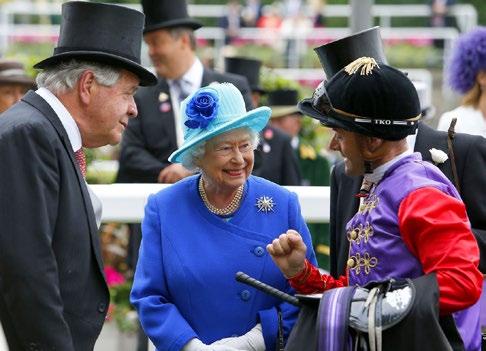
The royal family is featured in soap operas, criticized in the press, loved or hated, but the fact is that only a few characters of the fairy tales of our childhood are present in modern life. The existence of a distant but real queen, future kings, princes and princesses is a source of pleasant euphoria for the majority of the planet.

People are attracted to the royal court not for its authority, since it has no real governing power, and does not exercise even the opportunities granted it by the constitution. The Queen could not save the UK from “Brexit”, though supposedly she could have. The unanswered question on everyone’s mind is: “what is the purpose of a Queen who can’t save us from Brexit?”
She probably has a purpose.
This is not simply for the fireworks that her appearance causes, or for the extravagant hats and her bright smile, but probably because she is the stable constant in our continually changing world; without her, the world would be very dull.
MONARCHY 78 VOYAGER 4/2016
BEFORE A BILL BECOMES LAW,
HER MAJESTY THE QUEEN OF GREAT BRITAIN HAS TO IMPOSE THE SOCALLED ROYAL ASSENT.
THE QUEEN STILL HAS THE RIGHT TO CONFIRM, VETO OR DELAY THE BILL, BUT THIS HAS NOT BEEN ENFORCED SINCE 1708; NO BRITISH MONARCHS HAS EVER VETOED A BILL PROPOSED BY PARLIAMENT.
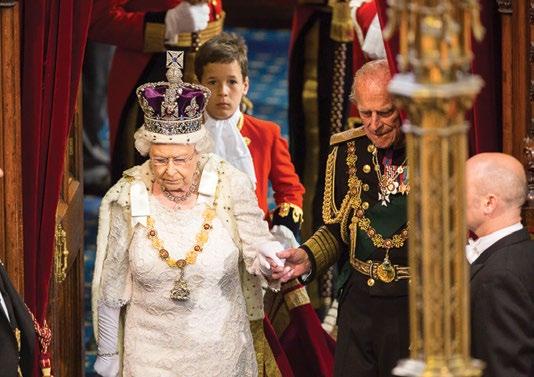
The British parliamentary system is one of the most well-thought-out and coherent political systems in the world. Although the British template is the basis of many other countries’ parliamentary order, the British Parliament still retains a number of idiosyncrasies.
Let's start with the fact that the UK does not have a constitution! Or rather, there is no single document establishing the principles of government rule. Instead, it is based on a multitude of separate laws and traditions.
UK citizens do not elect the prime minister; they vote for their preferred political party and the party members choose who to appoint to the parliament. After the general elections, official results are published, and the leader of the party with the most members in parliament visits Buckingham Palace; the monarch grants them permission to form a new government. Fortunately, according to another ancient tradition, the monarch has always responded positively to this request.
The British Parliament has two houses: the House of Commons (lower) and the House of Lords (upper). Members of the House of Lords are appointed by the Queen upon recommendations from the government and the 26 most influential Anglican bishops.
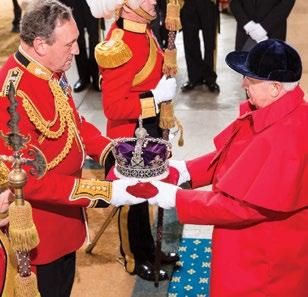
The lords have the right (which they often use) to veto a bill, though the House of Commons, in line with the 1911 and 1949 Acts of Parliament, may still ratify it.
Since 1911, the House of Commons has used this power as a last resort seven times. The last time this happened was in 2004 when the Commons banned hunting with dogs.
During House of Commons parliamentary sessions, a golden scepter – symbol of the Queen’s power – lies in the center of the ceremonial hall. Without it, the parliamentary session is void.

BRITISH PARLIAMENTARY TRADITIONS
Voting in the House of Commons uses quite an old and intriguing method: after the voting is announced, members of parliament have eight minutes to enter one of the two rooms: a "yes" room or a “no" room. After the time is up, the door is closed and the number of MPs is counted in each room.
Great Britain's lower house sessions begin with a prayer; the Speaker’s Chaplain leads the prayer and MPs stand up to pray. This tradition has been upheld since 1558.
A hat was for a long time part of parliamentary etiquette, and MPs had to don hats in the session hall. They took their hats off when entering or leaving the session. A hat also served as a good method of securing its owner’s chair. Today all male MPs have to wear a hat when they are addressing the Speaker. The wearing of medals or badges carrying the monarch's image or expressing gratitude is forbidden.
Snuff is another vestige of the past. A snuff box is placed at the entrance to the House of Commons, but very few make use of it nowadays. Snuffing tobacco is the only tobacco allowed in the House of Commons and the committees. Smoking was banned in British parliament as early as in 1693.
The Lord Speaker sits on a bag full of wool, which is a symbol of national wealth. This custom comes from the medieval period, when English wool and wool products were its main exports to Europe. Now the bag is filled with wool not only from the UK but from other countries of the Commonwealth also, thus expressing the unity of this countries.
79 VOYAGER 4/2016
ENGLISH MUSIC
The UK, along with the USA, is one of the capitals of modern show-business, just like Paris is the capital of fashion, while Hollywood is the capital of cinematography. British music’s domination began in the 1960s with the “British Invasion” into the USA and the rest of the world. British (not only English) music attacked the world from vinyls, radios, record players, TVs and movies. This successful British outbreak reached the most remote places of the planet. American charts are usually pretty strict when it comes to foreign performers (even today, it is very hard for foreigners to make it into the American charts), but in the 1960s they surrendered to The Beatles, The Rolling Stones, The Who, Cream and other Brits. This process was and remains less difficult in Europe.

Musical art had always been conducted at a high level in Great Britain; however, compared to other European countries, fewer famous classical music composers originated there. The 17th century was a time of important social and political changes in England and Great Britain. The monarchy was overthrown and a republic took its place. The governing Protestants (Puritans) did not permit church music; they burned sheet music and destroyed musical instruments. Poetry was deemed a sin. Nevertheless, when Charles II ascended the throne in 1660, he decreed to revive art and music; the Chapel Royal was formed and Italian opera performers were invited to court. This is the period when musicians, singers and instrumentalist started giving concerts. Music was therefore alive in the country and musicians were able to learn the works of foreign composers. English composers are among the world-renowned classical music masters: Henri Purcell (1659 – 1695), George Fredrick Handel (1685 – 1759), William Boyce (1711 – 1779), John Stanley (1712 – 1786), Sir Edward Elgar (1857 – 1934), Ralph Vaughan Williams (1872 – 1958), Gustav Holst (1874 – 1934) and Edward Benjamin Britten (1913 – 1976). We must not forget the minstrels – travelling poets and musicians
(including women) and their art that prospered all over Europe, including Britain. The names of such musicians are lost today, though they greatly influenced the folk music that remains popular in Britain to this day.
The great British musical wave of the 1950s originated and was based on a fusion of classical music, folk, jazz and the new American style – rock and roll. It covered every city and town. The electric guitar became the main symbol of the movement, purchased by youths and adults alike. Performance of rock and roll and blues was an indicator of “coolness“. A police chief of one of the cities in 1960s claimed in an interview: “If it were up to me, I would distribute guitars among all youngsters of the county, since with the appearance of the music, the crime rate went down drastically”.
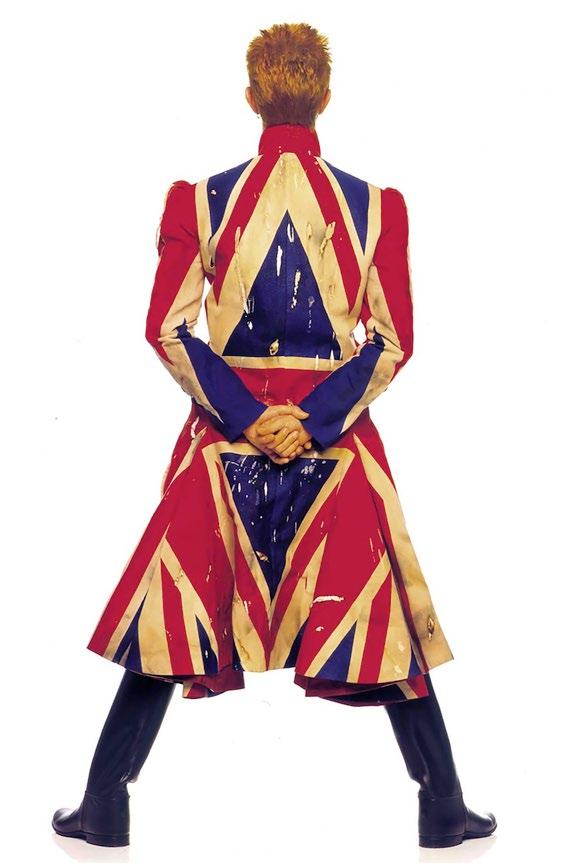
New music was more than entertainment for young people. It was a lifestyle and a protest against the generation that could not prevent World War II. 1950-60s London became the capital of the European youths that had experienced the war. Youngsters enjoyed peace. However, the musical event that caused a revolution in modern music at the beginning of the 1960s happened away from London, in one of the country’s provincial seaside towns – Liverpool. This revolution was called was The Beatles.
As the saying goes, no man is a prophet in his hometown, and the citizens of Hamburg, rather than Englishmen, were the ones who first appreciated The Beatles. British acceptance followed the group’s German success. I’d also like to mention The Rolling Stones alongside The Beatles, since the rise of British music started with these two completely different bands. By the way, “The Stones” are Londoners. The Beatles were formed a bit earlier. These two bands changed the world; they altered culture and thought; they influenced the development of modern music –rock, pop, metal, punk, etc. Their work, whether intentionally or not, united almost everything.
80 VOYAGER 4/2016
LASHA GABUNIA
Both bands had a pretty well-defined image in the beginning. Listeners adored The Beatles and fangirls screamed at their performances, while “The Stones” were anti-heroes. Hence, The Beatles became media favorites who were always praised; “The Stones” were “the bad boys” of the time; they became a symbol of anti-heroes who were loved in their own way, but were never praised.
We all know how important tea time is for the British. One of the newspapers organized an opinion poll “Who would you invite for tea, The Beatles or The Rolling Stones”? The majority of readers chose The Beatles. An average British citizen would never let his daughter go to the movies with one of The Rolling Stones members. Such stupid opinion polls always demonstrated that the “beloved” Lennon, McCartney, Ringo Star and Harrison always won the popularity contest.
The overwhelming success that these two bands found across the ocean in the USA gave birth to the cultural phenomenon known as the British Invasion. In addition to The Beatles and The Rolling Stones, North American charts and concert halls, followed by the European ones, surrendered to legendary groups such as: The Who, The Kinks, The Yardbirds, Cream, The Animals, The Zombies and others. I will not describe these wonderful bands in detail, but I’d like to note that the first rock opera, “Tommy” was composed by The Who in 1969. Afterwards, one of the most outstanding modern composers (also from Britain), Andrew Lloyd Webber, created the classic example of a rock opera “Jesus Christ Superstar”. It became the art piece of the era.

Several musical styles were developed in Britain in the following years. Great performers took the stage and influenced modern music, such as: Pink Floyd, Led Zeppelin, Black Sabbath, Queen, Jethro Tull, David Bowie, King Crimson, Emerson Lake and Palmer, Alan Price, Yes, Genesis, Uriah Heep, Deep Purple, Iron Maiden, Judas Priest, Brian Eno, Elton John, Rod Stewart, Electric Light Orchestra, Nick Drake, Slade, Sweet, The Police, Depeche Mode, The Buggles, The Smiths, Kate Bush, Eurythmics, Talk, Joy Division (later, New Order), The Clash, The Stranglers, The Cure, Nick Cave And The Bad Seeds, Pet Shop Boys, Gary Numan, Duran Duran, Radiohead, Underworld, Chemical Brothers, Massive Attack, Coldplay, Muse, PJ Harvey, Blur, The Verve and many others, who formed the foundation of modern music. Several musical styles were created in England: heavy metal, progressive rock, hard rock, psychedelic rock, synth-pop, trip hop, new wave, post rock, Britpop, types of electronic music, and many more.
The second wave of protest music covered the world in the 1970s; it originated in the USA but was unleashed upon the world by the producer Malcolm McLaren. This was one of the most radical movements (later recognized as a culture) called punk. It opposed the existing musical styles with the beginning of the Sex Pistols. Punk came in conflict with the older generation, including the monarchy. It did not possess great musical aptitude but carried enormous drive. The second British Invasion started in 1981 with the launch of the international music channel MTV.
In general, English music influenced people’s behavior, fashion and culture all over the world. The punk outfits of the 1970s
were created for a reason. The famous British designer Vivienne Westwood designed these garments; she was married to the above-mentioned Malcolm McLaren. Let’s consider the glasses: “Lennons” and” McCartneys”; the turtlenecks that we still call “the rollings”; and much more. Many items of 1980-1990s British music spread to everyday fashion and culture and the British flag became the symbol of quality music.
England is famous for its musical festivals, among them the “British Woodstock” – Glastonbury Festival of Contemporary Performing Arts. This music celebration was founded by a farmer, Michael Evans, in 1970. It takes place on his dairy farm, which is located in the South-West, in the Somerset County, several kilometers from Glastonbury. Concerts take place on several stages. Additionally, folk dance, circus attractions and art exhibition take place during the festival. Despite the fact that festival tickets are quite expensive, the number of visitors increases annually.
Finally, I’d like to add one thing: despite the fact that some of modern music originated in the USA, Britain gave it original and new “pure” form. English jazz created charm, drive, heaviness, experimentation and intellect in dance music.
The high level of British music still carries on today, and this is why the British scene and the Brit Awards remain relevant for the whole world.
81 VOYAGER 4/2016
“INTERESTING PEOPLE CREATE INTERESTING EVENTS!”
DAVID SAKVARELIDZE
I think everyone knows about the commercial West End theatres, where tickets to plays that have been staged daily for 30-40 years are still hard to come by. Also, everyone knows about the worldfamous musicals.
There are several large companies that produce the musicals and get rich from the ticket sales. For instance, "Cameron Mackintosh" is named after its producer. Apart from the musicals it owns, the company also owns eight theater buildings (www. cameronmackintosh.com). The composer Andrew Lloyd Webber owns a famous company called "Really Useful Theatre" (www. reallyuseful.com).
The third such company is "Walt Disney", which is the only one in London that produces "The Lion King" (www.lionking.com) – its revenues are equal to those of the other companies.
The Globe theatre on the south bank of the River Thames is a favorite stop for London travelers. It is a replica of Shakespeare's original "Globe" theater and was built using exactly the same technology as was available in his time. Not a single nail was used in the construction of this theater of such magnitude.
On the same south coast you will find a concrete building: the Royal National Theatre, a source of pride and dignity for all British people. It was pioneered by Sir Laurence Olivier, the great English actor, using money donated by HM The Queen.
London's Royal Opera House stands at Covent Garden, in the center of London. The English National Opera is located nearby in the London Coliseum building. Any England-bound traveler can easily obtain this information; consequently, I would like to
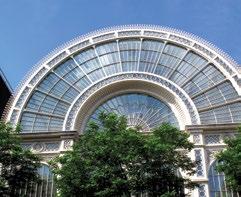
ROYAL OPERA HOUSE
The most famous Covent Garden theatre is the Royal Opera House, famed for its traditional opera performances, as well as for its collaborations with leading contemporary opera composers such as Harrison Birtwistle, Mark-Anthony Turnage and Thomas Adès. Its stage hosts world opera stars, such as Joyce DiDonato, Placido Domingo, Renée Fleming, Juan Diego Flores, Angela Gheorghiu, Jonas Kaufmann, Anna Netrebko and Bryn Terfel.
Bow St, Covent Garden, London
draw your attention to the things that interest and excite me most personally.
Once, the young William Davenant accidentally crashed into an old, respected Oxford man; he gasped and apologized. The old man asked why he was in such a great hurry. William, who could not hide his joy, replied: "My godfather has arrived and I want to see him!" The old man reprimanded him with typical British sarcasm: ‘Young man, you should leave the word “god” out and use only “father”’.
ROYAL ALBERT HALL
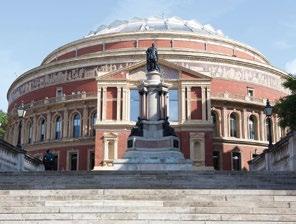
The Royal Albert Hall, which opened in 1871, is one of London’s most prestigious historical buildings. It has hosted more than 150,000 productions and events.

You will hear the story of its architecture, the royal patronage, and the performances that were staged here in this extraordinary and distinctive building.
Kensington Gore, London
82 VOYAGER 4/2016
OPERA
The catch is that word was out around the Oxford community of the time that William Davenant's godfather was in fact his biological father. Little William was believed to be his illegitimate son. Officially though, William Shakespeare was William Davenant’s godfather. Yes, the William Shakespeare! It is rumored that on his way to London, William Shakespeare often spent a night in Oxford. Some nine months after one of those "overnight stays", an Oxford lady, Jane Shepherd, had a son. In 1606, the local church ledger recorded: "Baptized and set on a rightful path to god, servant of God, William Davenant".
Davenant was the last name of the lady’s husband. The rumors were confirmed by the fact that William’s parents did not try to dispel them in their lifetime. A strong a physical resemblance also upheld the gossip. Researchers say that William Shakespeare and William Davenant had features so similar that they could only have been possessed by carriers of the same genes. Ben Johnson even dedicated a phrase to these similarities: "What is a thing hidden from the parent that cannot come out in the child's features."
Davenant adored Shakespeare, loving him unconsciously with a kind of childish delight. He had dedicated a tragic ode to Shakespeare's death. From the very beginning it was obvious to many that great talent and unlimited opportunities were nesting in little William. They were not wrong; today the world knows him as one of the greatest British poets, writers and playwrights.
For me personally, he is one of the most interesting figures of British history, as, aside from his other talents, he was a very gifted opera producer and impresario. He is the author of the first British opera libretto. He was also the first person in British history to build a theater designed especially for opera.
His biography is very interesting: William Davenant moved from Oxford to London, where he enjoyed the patronage of King Charles I. With the help of the king, he gained a license for an opera but was later unable to construct it due to the outbreak of the Civil War, Oliver Cromwell's puritan rule, the beheading of Charles I and the installation of a new regime. Oliver Cromwell banned theaters throughout England but Davenant still managed to get a license. He called opera "music with recital
SHAKESPEARE'S GLOBE

The Royal Shakespeare Theatre is an open-air drama theater.
It is a reconstruction of the Royal Shakespeare Theatre, where many of Shakespeare's plays were staged on a large open stage.
accompaniment". This ingenious move had proved effective. William already owned the Ruthland palace and built his opera on its so-called tennis court. This is where he premiered an opera in 1656 using his own libretto - "The Siege of Rhodes”. Five different composers had worked on it.
One can say that many contradictory events occurred in his life. Davenant was imprisoned and survived death by pure accident; he moved to France as a refugee and contracted syphilis. The illness damaged his nose and he lost a nostril, as can be seen in an engraving of his portrait. He struggled with his health and ultimately died.

Nobody knows for sure whether he was Shakespeare's illegitimate son, but one thing is true - William Davenant was the great poet, fanatically in love with opera, who had founded British opera and had authored the first English operatic work.
Yes, it’s true that only interesting people have the ability to create interesting events!
LONDON TOP MUSICALS
1. "ALADDIN" at the Prince Edward Theatre
Following its unprecedented success on Broadway, Disney's “Aladdin” conquers the stage at London's West End.
2. „THE LION KING" at the Lyceum Theatre
An adapted version of Disney’s animated film, the multi-award-winning "The Lion King" features music by Elton John. The musical stands out for its distinctive costumes and excellent special effects..
3."LES MISERABLES" at the Queen's Theatre
Cameron Mackintosh’s "Les Miserables" has been seen by more than 70 million viewers in 44 countries in 22 languages; ticket sales are still beating records.
4. "MATILDA" at the Cambridge Theatre
A little girl, Matilda, the main protagonist of Roald Dahl's eponymous novel, rushes onto the stage in Dennis Kelly and Tim Minchin’s musical to amaze you with her unusual abilities.
83 VOYAGER 4/2016
21 New Globe Walk, Bankside
DAVID KOMA
I am meeting David Koma in Shoreditch, a young, hip, crazy district. Movement is everywhere here, every pedestrian is either a celebrity or a genius. I am expecting a real celebrity. Koma works in this district. However, he does not spend much time in any one place due to his crazy schedule – he has his own clothing line and is a creative director at Thierry Mugler, so he is always on the move.
A very energetic person with fun in his blue is rushing towards me.
”I’m starving, can we eat and talk?“ He grabs me and leads me to the rooftop of a neighboring house, which hosts a private club. Young people sip cocktails by a pool, in the shade of lemon trees. It is paradise. “I have to tell you that I hate giving interviews. I am always anxious. The most important thing for me is to make clothing. I know designers that can promote their product very well. They convince others that their work is the best. They appear everywhere. I can’t do that. I am leading two houses, David Koma and French firm Thierry Mugler. Nobody teaches us at school that most of our duties are not associated with art at all. Those are the skills of a good manager and I need them every day. You have to be a leader and manage people. You can deal with art only if you are a mid-level designer in a fashion house. As you start advancing in your career, you have to develop another set of skills”.
And how much time is left to create something new?
Not enough (laughs). Whatever you see is the result of a collective effort. I come up with a concept, make draft sketches, set the direction and explain what my inspiration is. Then I distribute responsibilities and the team starts working. Finally, I select new ideas and move on.
Have you ever thought that striving in a career which allows such little space for creative process is not worth the effort?
No, never. I have always dreamed of leadership and owning a business. It is natural to accept responsibilities. This is the business of fashion. It is a business and not art, and if the business fails, it is worthless. Do I want to leave everything behind and go to L.A. to sketch? Yes, I do, but I am very ambitious and I don’t often think that way.
What is your wildest dream?
I’ve achieved everything I’ve dreamed of. I was a strange kid, and thought about my future very intently. I saw my future. I sent these thoughts into the cosmos, and have achieved everything that I wanted. This last year I’ve been thinking about what else I can dream of (laughs).

Maybe you should just be happy?
Yes, of course. That’s how it is. I want everything to grow and develop. I set goals, but they are not crazy dreams anymore. They are real wishes that I know will come true. When I closed my eyes in my childhood, I saw how I’d live in London, owning a fashion house. Now I want everyone to be healthy.
What is a source of inspiration for you? Small or big? Especially when you have to divide your mind between the two companies?
I love London. This is my city. It carries a thousand emotions, something fresh is always in the air. Traditions and novelties combine. They exist simultaneously; balance and novelty and craziness. Nobody likes the old-fashioned or tasteless here, and not only in fashion. Nobody here likes to repeat traditional art. This city has accepted me. I studied here for seven years. I was always winning, everyone loved me and this seemed unnatural. Here, locals help foreigners more than we help each other in Georgia. I have built my
FASHION
SALOME DADUNASHVILI
84 VOYAGER 4/2016
whole business based on grants and winning contests. I could not have achieved that anywhere else. I’ve studied hard, I’ve won several awards for collection of the year, and the British Fashion Council funded and supported me. I received that grant annually. Without them no one would have come to my first runway. They arranged my showrooms everywhere around the world. I could never have done that alone.
Why did you choose Britain? Why not France
I was 12 years old and thought constantly about fashion and sketching designs. My mother gave me a book called “100 Years of Fashion”. It contained list of designers and schools that they had attended. That’s when I said that I want to study only at Saint Martins. As for the startup, Britain is the best choice in that regard. No other country provides better conditions.
What do you have to do for it?
Set up a successful business. Work with a good team. Think constantly about how to create clothing that is desirable for everyone.
So that Jenifer Lopes would want to wear your dress?
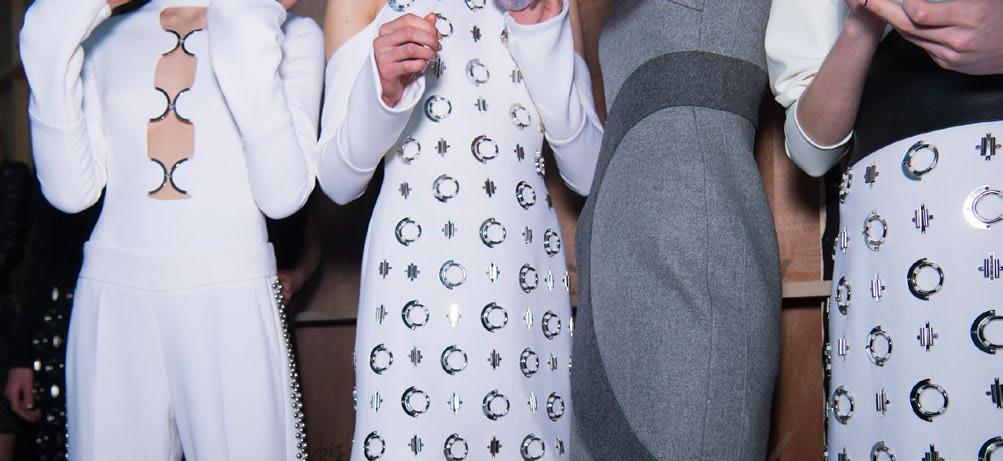
That’s not that difficult. The stores have to carry your designs, and the women that visit those stores have to purchase your clothing. New designers often do not consider which department stores would carry their clothes or which brands do they see alongside their designs. That’s the key point. I know my strengths – I know how to create pretty, feminine, sexual and structured clothing that sells. A woman should look feminine and at the same time, dignified, despite where the cut is placed or how short it is. We used to have anatomy lessons at Saint Petersburg’s Stieglitz academy. The classes helped me learn about a woman’s body. You can’t draw a naked body if you don’t know anatomy.
What makes British fashion special?
Although I received my education here, my clothing is not typical of British fashion. British fashion means variety, a bit of kitsch, expression, texture and prints. Proportion and limitless freedom. Also, openness to foreign designers. Look at London Fashion Week, it is full of designers from every country, Greeks, Swiss…this makes British fashion very diverse. You don’t have to be from Britain to create British fashion.
Thierry Mugler’s first appearance was remarkable, with its theatric collection. We will probably never forget it. How difficult is it to continue such a well-defined image?
That is very difficult indeed, but this is my dream job. I know and love this brand. Nobody would turn down such an offer, and I really wanted it. When I got the position, I asked myself this very question; I could not find an answer, and decided to just go with the flow. It is also important to bear in mind that when people hear Thierry Mugler, they remember haute couture shows, while I work with pret a porter. This is a different time. This time demands new clothing that you understand and desire. I want to give new meaning to this cult brand, while respecting its past. I am trusting my intuition, and it is working.
Please name several places in London which inspire you. My bedroom will always remain number one place for inspiration.
That’s great, but tourists can’t go there; could you name a public place?
(Laughs) I will tell you about my favorite walking tour: Saint Paul’s to the Millennium Bridge and on to the Tate. It always helps me clear my mind.
I go to the Tate, look and deliberate. Then I proceed to the balcony of the bookstore and deliberate again. I’ve been in this habit since school. I also love our college library. I haven’t been a student for a while, but I still like to visit the library to work and rest. It made a great impression on me. I had never seen so many books before.
Are structural changes important in fashion?
Fashion has accelerated unbelievably. The tempo is very fast. New faces and generations come to fashion and rewrite it. Everything develops so fast that seasonality is no longer important. The way houses select clothing has also changed. Everyone has been showing four collections per year for the last five years. There’s a multitude of clothing. I feel that something is changing. Designers long for change. This rhythm can’t go on forever. I spend a week in London, then a week in Paris, then travel around the world. I don’t know what and how, but something has to change. That’s a fact.
85 VOYAGER 4/2016
Dandyism is a XIX century socio-cultural type: men who pay particular attention to the aesthetics of their behavior, appearance and speech. Dandies originated in XVIII-XIX century England as a reaction to the increasing presence of rich bourgeoisie in social and cultural life; the movement then spread throughout Europe.
Dandyism is a protest against vulgarity, stereotypical thinking and behavior. A dandy must be non trivial, not paying attention to rules and conventions; he dictates the rules, and, moreover, sets the trends in fashion.
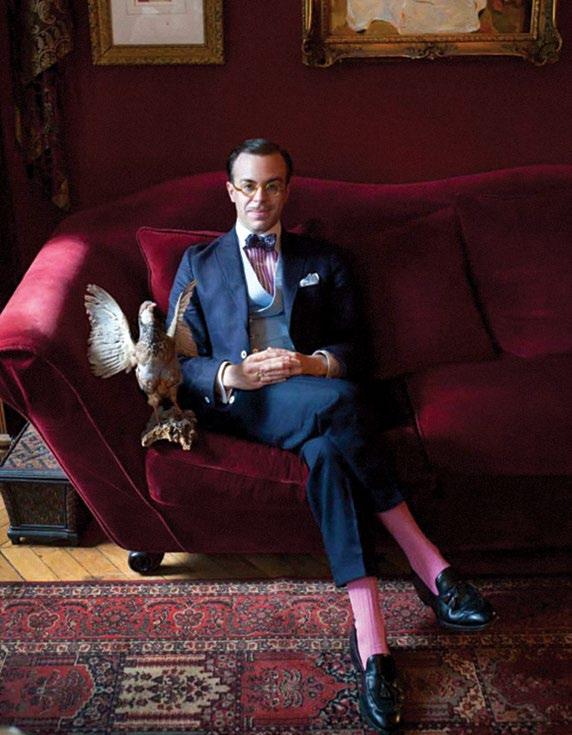
British dandyism included two movements that competed with each other: ’athletes’ (bucks) and ’handsomes’ (beau; the French for ‘beautiful’). ’Handsomes’ did not like sports, and spent considerable time grooming. Their favorite entertainment was an unhurried stroll in the city, or a visit to the antique store or the tailor. They hated foxhunting and overcoming obstacles, riding and other such ’rough’ rural pursuits. Dandy athletes, on the contrary, were involved in riding, hunting and boxing. They were sponsored by the aristocrats, and took boxing lessons from them, as did Byron, for example.
The dandy manner of speech favors minimalism. A dandy’s favorite genre is aphorism, a short, smart saying. A dandy’s conversation should not be monotonous and tiring: he swiftly states his ’bons mots’ (witticism), which is immediately caught up and cited. A true dandy never repeats anything. Dandy culture produced the notion of ’flaner’ (the French ‘flâner’ means a slow stroll in the city). Graceful walking played an es-
THREE RULES OF DANDYISM:
NEVER ACT SURPRISED (EXTERNAL SELF-CONTROL IS IMPERATIVE);
MAINTAIN INDIFFERENCE WHEN YOU UNEXPECTEDLY SURPRISE OTHERS (IT IS NECESSARY TO IMPRESS THOSE AROUND YOU, TO BE REMEMBERED. NEVER BE BORING);
GET OUT OF THE PUBLIC EYE AS SOON AS THE IMPRESSION IS MADE (A DANDY CLEARLY DEFINES THE ‘DOSAGE’ OF HIS PRESENCE IN THE SOCIETY).
sential role. А great walk was (it was then believed) analogous to a face that displayed no emotion.
George Brummell was a preeminent representative of the movement; he received the nickname ’the prime minister of elegance’. Brummell’s flawless taste made him so influential so that he became the future King George's friend and fashion consultant. He was author of the book ’Men and Women’s Suits’. He symbolized a stark contrast to the high-society imitators who attracted attention with their extravagance. Brummell’s principle was conspicuous inconspicuousness, which became the basis of men's suit aesthetics.
The principle of minimalism is manifested in clothing as well the dandy chooses to adorn his immaculately sewn suit with only subtle visual detail (versus crowded luxury) as a sign of his extreme expression of aristocracy. The importance of Brummell’s personality was demonstrated with a phrase attributed to Byron: "It is better to be Brummell than to be Napoleon."
A dandy is a man who creates his own destiny in romantic scenarios, implementing his personal omnipotence (consider Brummell and Byron's fates. Dandyism is unthinkable without the romantic individualism which often reveals itself in the most inconvenient moment). In some ways, it centers itself as a life goal.
Many writers were known to be dandies. In England these included Byron, Bulwer-Lytton, Disraeli, Dickens and Thackeray, Oscar Wilde and Sir Max Berbohm; in France they included Balzac, Stendhal, Baudelaire, Marcel Proust and Pierre Loti. Dandies’ novels are very autobiographical.
STYLE
86 VOYAGER 4/2016
WHO IS THE DANDY?
IS HE SIMPLY AN ELEGANT MAN, AN ARISTOCRAT, A MAN OF REFINED TASTE, WHO LOOKS FOR ONLY THE BEST, OR IS DANDYISM A PHILOSOPHY?
Few women know much about dandies. They are familiar with them, study them, write books and prepare exhibitions. Anyone who’s anyone in London knows Alice Cicolini, and she is acquainted with everyone who is worth knowing. Let’s get to know her too.
British men are amazingly extravagant. Men's suits are much more diverse than we can imagine. You can wear a vest, don a single- or double-breasted jacket, and leave or omit trouser lines
Everything is in the detail; ‘the dandy is in the detail’. Be it with velvet and satin, special or excessive extravagance are unnecessary.
This is a gentleman who is elegantly, but not aggressively, extravagant. If you look at the details, you’ll notice that his socks have a particular pattern, or that his jacket lining has an unusual color. Such details reveal a dandy. He has something that no one else has. The unchanging behavior code passes from father to son. Aristocratic families have their own tailors, many of whom have been serving the family for several generations. This distinguishes them.
This is the Savile Row style. Of course, over time, new men's suit tailors and designers appear, such as: Spencer Hart, Richard James and Oswald Boateng; they bring new details to a dandy’s clothing. Spencer Hart is a highly modern designer, while at the same time following all of the Savile Row traditions.
Only a gentleman could allow himself a lifestyle where he wears crisp white shirts and white leather gloves, which have to be changed at least six times per day, in order always to have a clean pair. This was a man who could order the main part of a glove at one tailor, but a thumb at another, because the other tailor sewed the thumbs better. The type of perfume he’d use in public was of a paramount importance.
There is an assumption that the more affordable and widespread high-class clothing becomes, the greater are the chances for dandies to appear. This is not true.
So, you believe that a true dandy needs large sums of money to keep up appearances?
Yes, it is absolutely necessary. We must distinguish between the merely interesting and tastefully dressed man and the dandy. No mass market can provide you with the dandy’s exclusiveness: it's your favorite color for the thread around the buttonhole; the suit material of superb quality; and, most importantly,
it has to fit perfectly. Mere mortals do not have enough money to acquire clothing of this quality. The mass market is the exact antithesis of dandyism.
Alternatively, you must have an amazing sense of style and an experienced eye to find special items in vintage stores. Alternatively, you may be a poor aristocrat, who has the legacy of his father's exclusive wardrobe, which fits you like a glove. Then, you must either have ample money with which to buy these things, plenty of time to devote to searching for them at low prices, or social access, which means that you were born into high-class society and received its legacy.
Can a dandy buy a suit in Italy, or is Britain the only place where his clothes are made?
Britain, of course. The biggest betrayal of the tradition was that James Bond wore an Italian suit. It was the deepest and most significant error, so the answer is: "no". Italy created outfits with a completely different message: loose clothing for free men who value comfort.
The British suit is only one part of the broader dandyism concept. It has its own philosophy. The British suit expresses strength and masculine beauty.
The British tailor molds a man’s body like a sculptor. He creates Adonis. The Italian tailor just provides Adonis with something to put on.
BRITISH TAILORS HELP YOU PRESENT THE ’BEST VERSION’ OF YOUR BODY TO THE PUBLIC. IF THE SHOULDER-LINE IS INCLINED, IT MUST BE LIFTED UP; IF THE ABDOMEN IS RELAXED, THE TIGHT-FITTED VEST HIDES IT. IT IS LIKE A CORSET FOR MEN. MEANWHILE, BRIONI IS AWAITING A PERFECT BODY.
That's why some consider British suits to be a little uncomfortable, but I see the extraordinary freedom in them. These clothes give you the chance to have a much better look with your body.
87 VOYAGER 4/2016
ENGLISH SUIT
The traditional English suit is cut closer to the body than Italian or US suits, with narrow sleeves. The back of the jacket often has two vents while the shoulders are narrower, but higher compared to the Italian suit. British tailors often use strengthening fabric layers for a more structured jacket, which may be single or double breasted. Highwaisted pants have two or three folds around the waist line. The pattern is looser, but not wide. The fabric is hard and tough. Lapels are made rough with a hardened extra layer.
The English suit is meant to sit perfectly on a man with an average body. The suit corrects the body.
Savile Row is the traditional home of the English suit maker. This street is located in the upmarket Mayfair district of London where the nobility lived. It has always attracted the best UK tailors.

The bespoke tradition originated on Savile Row: this involves tailoring all of the details according to the client’s demands and adjusting the clothing to fit the body. This service is, of course, only for the wealthy.
Thus, since the English suit is traditionally based on individual tailoring, it fits the figure perfectly.
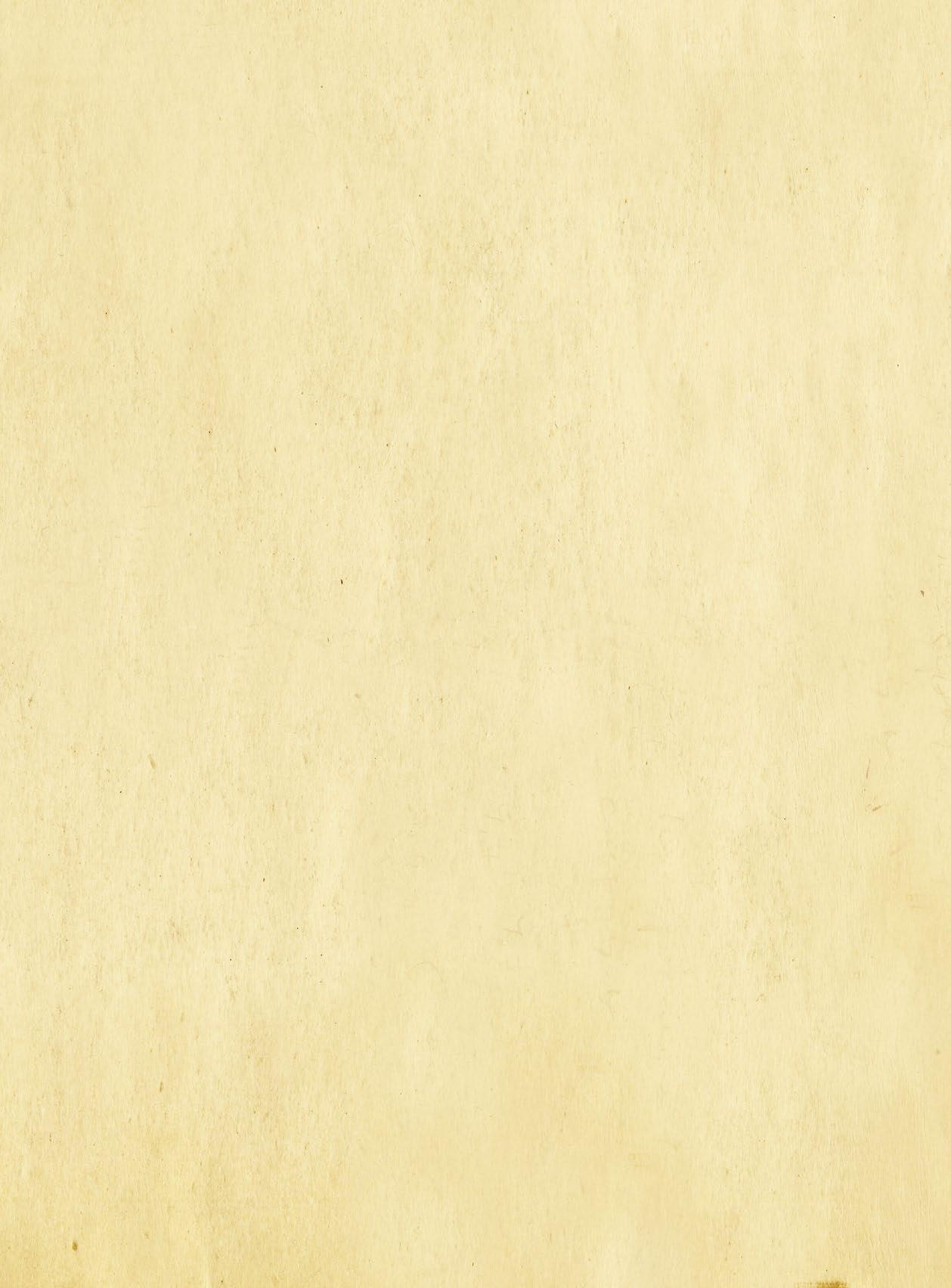
The many small details, body-fitting tailoring, narrow sleeves, high shoulders and high-waist pants are based on British military clothing. This is not surprising, since aristocrats served in the army. Vents
at the back of the jacket pay homage to the equestrian sport of riding. This tailoring style is much more expensive.
Aristocratic clothing followed a rather strict etiquette in the 19th century. During the day, the men wore velvet or satin smoking jackets; for visits during the day, especially outside London, they wore tailcoats, and in the evening, at dinner, they changed into black tie (or dinner jackets).
All that changed when the Prince of Wales ordered a Savile Row tailor to construct a jacket made with tailcoat fabric but tailored like a smoking jacket. This was much more comfortable than the ones the etiquette required.
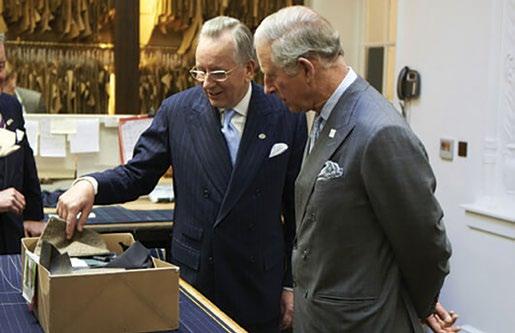
Interestingly, in the United States (where black tie was called tuxedos) the Prince's "scandalous" clothing was accepted much faster than in conservative England, where the nobility came down to dinner dressed in a black tailcoat.
THE ENGLISH SUIT IS CHARACTERIZED BY ADDITIONAL BUTTONS ON THE SLEEVE, WITH ONE DIFFERENTCOLORED BUTTONHOLE, SIDE CUTOUTS ON THE BACK OF THE COAT, AND A LITTLE EXTRA POCKET FOR TICKETS, USUALLY ON THE TOP. THE WAISTCOAT IS AN INTEGRAL PART OF THE ENGLISH SUIT AND SERVES THE PURPOSE OF A CORSET.
No country has made such a contribution to the development of men's suits like England. The Savile Row tradition began in 1860, but the great revolution in men's clothing began at the end of the century.
88 VOYAGER 4/2016
FOR SPECIAL OCCASIONS
Dressing properly can be like walking through a mine field, to some extent, and should be treated carefully. For the morning suit, you have to dress in full compliance with etiquette. This requires a selection of clothing.
The jacket is usually single-breasted, with one (rarely two) buttons and calls for a pointed-collared shirt.
The waistcoat may be gray, yellow or light-blue, if you prefer a black jacket.
Pants may be gray or black with pin stripes. Strips may be of different width and brightness. A small checkered fabric is advisable sometimes.
A shirt with a long collar requires a tie; in this case, a double cuff is better, and the collar should be either pointed or round.
A single-colored or even striped silk handkerchief can be placed in the breast pocket. It should be properly folded.
The shoes can have laces or be slip on, and whether low or high, must be black.
DEGE& SKINNER
Dege & Skinner holds a royal patent; the firm has been making suits since 1865. Here you may also purchase accessories and ready-made shirts.
Customers are measured at home if they cannot visit Savile Row whether they live in the US, Europe or the United Kingdom. Customers are measured at home if they cannot visit Savile Row whether they live in the US, Europe or the United Kingdom.
FABRIC IS TAILORED
ACCORDING TO INDIVIDUAL SCHEMES AND PATTERNS, FOLLOWING SET STANDARDS. SKILLED SEAMSTRESSES AND TAILORS DEDICATE AT LEAST 60 DAYS TO MAKE A THREE-PIECE SUIT, 55 FOR A TWO-PIECE SUIT AND 40 FOR A HIGHQUALITY JACKET.
MORNING SUIT ETIQUETTE
The suits are especially sought after for quintessential British events such as Royal Ascot, Wimbledon, the Henley Royal Regatta and cricket Test matches.

Dege & Skinner are the renowned experts of civil and sportswear, and have been providing suits for the royal family, wellknown businessmen and senior military officials for more than a century. Based on 150 years of experience, the tailors
often visit the Royal Military Academy at Sandhurst to come up with new ideas for British officers' clothing. Dege & Skinner was chosen to tailor Prince William and Prince Harry’s military uniforms for their service. The world-famous Victoria and Albert Museum has honored Dege & Skinner’s work by exhibiting their various military clothing.
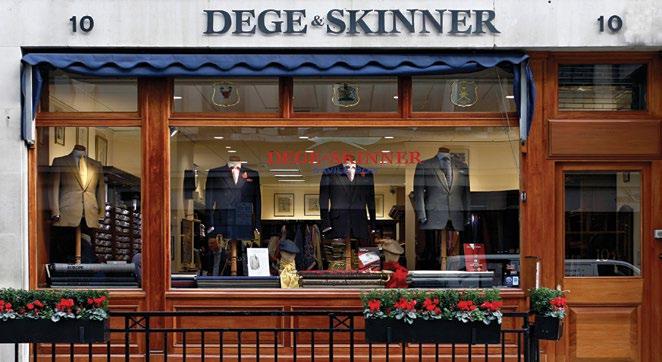
89 VOYAGER 4/2016 FOR MEN
10 Savile Row, London
GREAT BRITAIN SETS THE BAR FOR MEN’S FASHION. HERE YOU WILL SEE THE BOLDEST DESIGNERS AND WILL BE ASTONISHED BY THE ARTISTRY AND PROFESSIONALISM OF THE TAILORS.
TURNBULL & ASSER

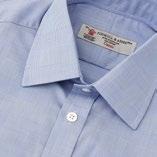
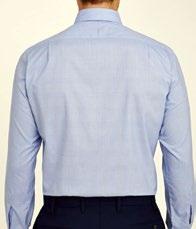
Turnbull and Asser (T&A), located on Jermyn Street, has attracted male attention since 1885, although the now-famous shirts produced here became popular in the 20th century.


These tailors have serviced such prestigious customers as Winston Churchill, Charlie Chaplin, Picasso, Ian Fleming, all of the James Bond leading men, and even Prince Charles. He was the one that granted this place its first royal warrant in 1981.
Turnbull and Asser’s collections are full of colors and ornaments. Some shirts have a plain single color, some come with stripes, while others are checked. The ornaments are truly original.
EDWARD SEXTON
It is impossible to miss the suits by Edward Sexton, at least on the front cover of the famous Beatles album, Abbey Road. He is known for being the main designer of rock and roll costumes all over the world. Not only musicians but many other clients choose his classic and original outfits.
26 Beauchamp Place, London
KENT, HASTE & LACHTER
Legendary tailor Jon Kent has his own distinguished style. He doesn’t try to create anything for his clients but rather his suits are a continuation of his clients’ individualism.
His partner, Terry Haste, is the complete opposite. The same atelier also hosts Steven Lachter, the best shirt tailor in London. His 30 years of experience prove that he is able to create best-fit shirts, dressing gowns and pajamas, which are truly English, elegant and best for the client’s wardrobe.
The price to order a suit starts at £2,000.
7 Sackville St, London
RBJ SIMPSON
If you are planning to order leather wallets, briefcases, or bags, RBJ Simpson should be your main stop in London. It is worth investing in the products created here as they will last for a lifetime.
Unit 33, Cremer Business Centre, Cremer St, London
SAVILE ROW AND JERMYN STREET HAVE BECOME SYNONYMS FOR EXQUISITE TAILORING AND HAND-STITCHING; THE MOST MODERN AND DESIRED OUTFITS FOR MEN HAVE BEEN CREATED ON THIS STREET FOR A LONG TIME. THAT IS WHY ITS REGULARS HAVE INCLUDED SIR WINSTON CHURCHILL AND PRINCE CHARLES.
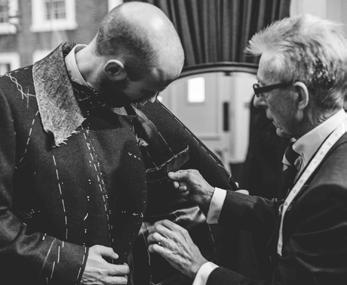
RICHARD JAMES
Trousers made by Richard James are cut from a wrinkle-free cotton. The fabric is sleek to the touch and light. His trousers are created in a modern English style with a high waist and hidden fastening, and a slim but not close fit. There are no folds at the belt loops, and belts are always classic. Trousers have four pockets: two at the front and two in the back. The back pockets are sewn from the inside and one pocket is fastened by a button.

Bespoke Shop 19, Clifford St, London
IF YOU WANT TO BUY TRAVEL BAGS, SUITCASES AND ACCESSORIES, RBJ SIMPSON IS YOUR BEST CHOICE.
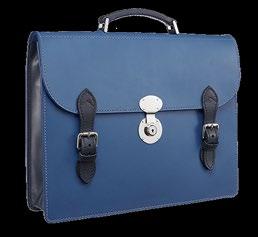
90 VOYAGER 4/2016
71-72 Jermyn St, St James’s, London
The English school of tailoring is characterized by a pattern comprising four parts, a solid collar and cuffs – Turnbull & Asser is a classic example of a beautiful English shirt. The price for a shirt ranges from £150–220.
The price for Richard James trousers ranges from £204–246.
JOHN LOBB


This company is one of the most renowned shoemakers in England. However, there are two “Lobbs”: one is from London, which creates handmade and customdesigned shoes; another is the property of Hermes, offering clients tailored products in addition to conventional ones.
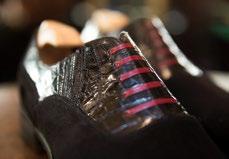
The prices for John Lobb’s classic shoes start at £795.
88 Jermyn St, London
CROCKETT & JONES

GEORGE CLEVERLEY
George Cleverley is known to be the best shoemaker of the 20th century. He is famous for inventing chisel-toed shoes that combine square and semi-circular forms. This design is still a trademark of the atelier. The small shop accepts orders and the shoes are sewn by hand on the second floor in the workshop. If you are interested, you can watch the sewing process.
13 The Royal Arcade, 28 Old Bond St, London
MALE FASHION IN GREAT BRITAIN IS SET IN ITS ROYAL CITY. ALL THE RULES OF FASHION ARE CREATED AND DESTROYED HERE. FROM SAVILE ROW TO THE EAST END AND THE BOLDEST NEW DESIGNER SHOPS, YOU WILL ALWAYS FIND A PLACE WHERE A GENTLEMAN MAY REASONABLY SPEND HIS MONEY.
SEAN O’FLYNN
DRAKES
It is difficult to find more English ties than those of Drake’s. The silk patterns are produced in Britain and the ties themselves in the center of London. The prints are handmade. They accept bespoke orders as well as offer their own collection. Prices for ties start at £100.
The best shirts in London can be individually tailored here. Sean O’Flynn creates his own fabrics and supervises the work of his tailors himself. The modesty of the famous master is a prerequisite of his commitment to his customers. Here you can also buy shirts for women’s formal suits.
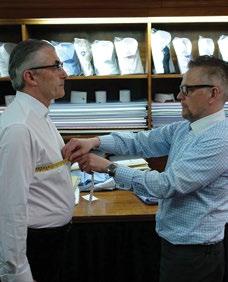
6 Sackville St, London
Crocket & Jones was established in 1987 in Northampton, a central city of England, and is famous for its high-quality, Goodyear-welted footwear production. Men can choose from three collections: Hand Grade, Main Line and Shell Cordovan. Low-heeled shoes and a new collection of boots are also of-
The fifth generation of this family is successfully managing the business and maintains traditional handicraft quality and the highest level of service, which has been attracting customers for almost 135 years.
92


PANTHERELLA
Woolen socks prevail in Pantherella’s collection, however, the socks always contain some nylon (70% Merino wool and 30% nylon).
Pantherella has distinguished classic designs, which can be simple or catchy, serious or ironic – the choices are vast. The end of the sock – where
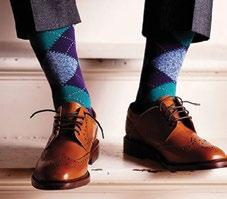
JOHNSTONS OF ELGIN
Known for its goat fur, this Scottish company opened its first shop in London in 1915. Johnstons of Elgin produces goat wool fabric, knitted clothing and various accessories.
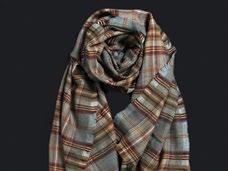
You can be assured that its collection is produced in Scotland from a company that was established in 1797, and represents the company’s highest quality standards. Skilled craftsmen manage to retain the brand’s previously recognized charm in its contemporary collections.
COMMENT:
IN BIG CITIES, ESPECIALLY IN LONDON, THE SHOPS ARE OPEN UNTIL 19.00 THROUGHOUT THE WEEK. IN RELATIVELY SMALL CITIES AND TOWNS, SHOPS OPERATE ACCORDING TO THE FOLLOWING SCHEDULE: FROM 9.00 OR 10.00 AM TO 17.00 OR 17.30 AND ON THURSDAYS MAY STAY OPEN LATER. VERY OFTEN, SHOPS ARE CLOSED ON SUNDAYS.
VOYAGER FOR MEN
3 Clifford St, London
Jermyn St, St James, London
77 New Bond St, London
one’s toes fit – is stitched by hand. Pantherella’s socks are produced in England and the price per pair starts at £15.
SWAINE & ADENEY
Thomas Briggs first manufactured umbrellas in 1836; he received his first order from the royal court in 1893, after Her Majesty Queen Victoria became interested in his work. No umbrella craftsman had received such an honor before.
King Edward VII and all subsequent monarchs have enjoyed Briggs’ handicrafts. In 1943, the company Thomas Brigg & Sons merged with other company, Swaine & Adeney, to form Swaine, Adeney, and Brigg & Sons. “Briggs” high-quality umbrellas are purchased by the royal family, various international leaders, and other famous persons.
Thomas Briggs’ umbrellas are an example of a true British style: they are made from excellent materials and require exceptional mastery. The axis and handle are carved from a rare species of walnut; the tip is silver-plated; and black nylon or hand-woven silk is used as the fabric, stretched over a highly durable frame.
7 Piccadilly Arcade, Off Jermyn St, London
MACKINTOSH
Waterproof, rubber-like fabric used for raincoats or men’s summer coats of the same style became popular in the XIX century.
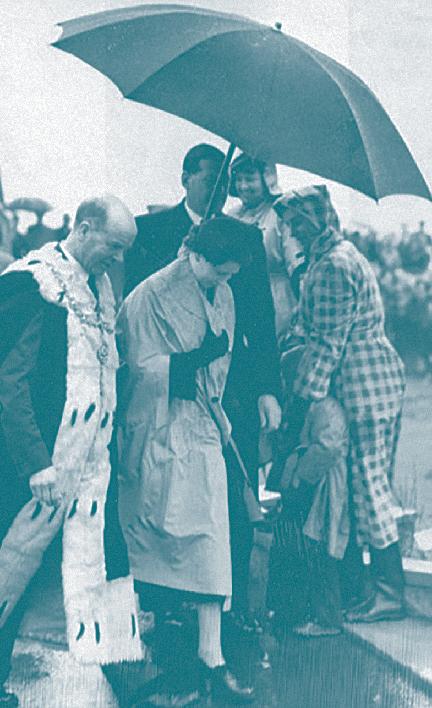

The Scottish chemist Charles Mackintosh was conducting yet another experiment when he spilled a rubber solution on his sleeves in 1823. After a while, he noticed that the sleeves no longer got wet. He patented this discovery and founded his company, Mackintosh, producing its eponymous waterproof coats. These coats do not aspire to be elegant or graceful.
The Japanese firm Yagi Tsusho purchased Mackintosh in 2007. Mackintosh overcoats are especially popular in Japan, but are no less successful in their home country, the UK.
The original Mackintosh products only used natural rubber from Malaysia. Stitches were covered with rubber and were therefore waterproof, and buttons were made using a special machine. Original Mackintosh products – both men and women’s overcoats – are handmade in Scotland.
You can buy them at specialty stores, Harrods, Lissom & Muster, and End Clothing. The prices start at £550.
THE UK IS THE WETTEST COUNTRY IN EUROPE DUE TO ITS LOW ATMOSPHERIC PRESSURE, WHICH EXTENDS EASTWARD INTO THE ATLANTIC.
THE DRIEST PART OF THE YEAR HERE LASTS FROM MARCH TO JUNE; THE MOST PRECIPITATION COMES IN SEPTEMBER THROUGH JANUARY.
THE SURROUNDING SEAS FORM A RELATIVELY MILD CLIMATE, AND THE GULF STREAM ESTABLISHES A MODERATE OCEAN TEMPERATURE. THE UK IS OFTEN MISTY; THE SKY IS ALMOST ALWAYS CLOUDY AND THE SUN RARELY SHINES.
JAMES SMITH & SONS
James Smith & Sons studio has been making the best umbrellas in London for 180 years. The most popular model to date is the Malacca Cane. It is Europe's oldest umbrella shop with a workshop.
A lubricated steel frame was used for the first time in the James Smith studio. It guarantees that no wind or rain anywhere in the world will blow your umbrella inside out.
A handmade red wood or cane umbrella is still the best choice for men. Sunscreen umbrellas can also be purchased.
53 New Oxford St, London
IT SEEMS LIKE IT IS ALWAYS RAINING THOUGH DOWNPOURS ARE RARE. TYPICALLY, THE TEMPERATURE NEVER EXCEEDS 30C IN THE SUMMER OR DROPS BELOW -7 C IN WINTER. HISTORICALLY, +38 C AND -18C ARE THE HOTTEST AND COLDEST TEMPERATURES RECORDED HERE.
19 Conduit St, London
WHAT DOES THE ROYAL WARRANT SIGNIFY?
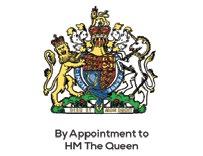

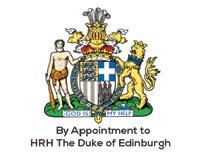
Walk along St James's Street in London and you will see coats of arms on the exterior of the alcohol shop Berry Bros & Rudd; Dr. Harris Pharmacy, which looks like it was imported from the world of Harry Potter; shoemaker John Lobb; and barbershop Trufitt & Hill.
LAUNER
The Queen of England is never without a handbag, and usually she prefers Launer's creations. Launer presents more than forty handbags for various occasions, sewn entirely by hand in a small town in Walsall, near Birmingham. Each item is decorated with golden fasteners.

Launer’s collection includes leather wallets and iPhone cases; despite the high price, they stand out for their amazing simplicity. They can be purchased in Fortnum & Mason.
www.launer.com
BARBOUR
This three-warrant company supplies the Queen, the Duke of Edinburgh and Prince Charles with its distinctive, waterproof jackets.
JAN CONSTANTINE
Jan Constantine makes beautiful hand-embroidered garments, pillows with coats of arms and cosmetics bags with the inscription "God Save the Queen."

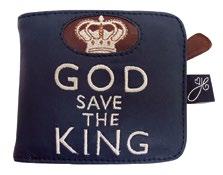
87-135 Brompton Road, Knightsbridge London
Sometimes a single distinctive sign hangs on the door – and sometimes two or three. This means that this institution has a warrant granted by the Royal Family, and has a business relationship with the Queen, the Duke of Edinburgh, the Prince of Wales, or, in some cases, all three together. The Royal Family has to be served for at least five years to obtain the warrant; however, some of these companies have a much longer history of relations with the crown. For example, Twining Teas has been supplying the royal court for more than 150 years.
The company has been operating in the small town of South Shields in north-east England since its establishment. It is committed to its style and produces high-end and everyday clothes.
www.barbour.com
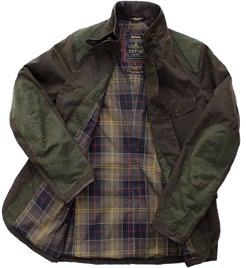
CHARLES OWEN & CO
This company was founded one hundred years ago and is still family-owned. It supplies the Royal Family, as well as the US Cavalry Equestrian Federation, with caps.
Caps are produced in the picturesque market town of Wrexham, located on the border of England and North Wales.
Recently the firm started producing protective equipment; it used to manufacture cork helmets for British soldiers and researchers in the tropics.
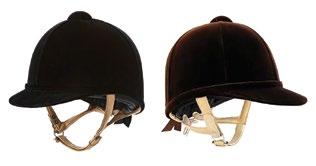
www.charlesowen.co.uk
CORGI
Good shoes require suitable socks. The Prince of Wales showed his appreciation for Corgi products’ superior quality in 1989 when he granted the firm a royal warrant. The company was founded in Wales in 1892 and is still owned by the same family; the current designer Lisa Wood's work has been featured in a number of high-fashion houses. A pair of men and women’s natural cotton thick or thin socks costs £15; cashmere socks start at £49 pounds.
www.corgihosiery.co.uk

93 VOYAGER 4/2016
CARRYING A ROYAL SIGN
THE CHARM OF TRAVELLING IS TO SELECT MEMORABLE GIFTS FOR YOUR FRIENDS OR RELATIVES WHO COULD NOT JOIN YOU ON YOUR TRIP. CHOOSING GIFTS IN BRITAIN IS NOT DIFFICULT: TRADITIONAL BRITISH PRODUCTS HAVE BEEN MARKED WITH NEW IDEAS AND THERE ARE EVEN MORE CHOICES AVAILABLE NOW.
MULBERRY
FOYLES

The same family has been in charge of this bookstore since 1903 when it was founded. It has become a sight to behold. Some 200,000 books are located over six different floors in the shop. A cafe and a gallery are also located here and the bookstore hosts evenings with different authors and live music concerts.
107 Charing Cross Road, London
Mulberry became famous for its unusual handbag designs, such as “Alexa” - taking its name from Alexa Chung, the iconic figure of the British fashion world. The Duchess of Cambridge also favors its posh leather creations. She was spotted carrying a Mulberry Polly Push Lock Tote. Mulberry was founded in 1971 in the south-west of England, in the Somerset countryside, and still produces the most famous leather handbags.
ASPINAL OF LONDON
Numerous UK visitors prefer to buy gifts in places that are somehow connected to the Royal Family. Aspinal of London is the favorite shopping destination of the Duchess of Cambridge and her sister Pippa Middleton, particularly for its amazing leather handbags.
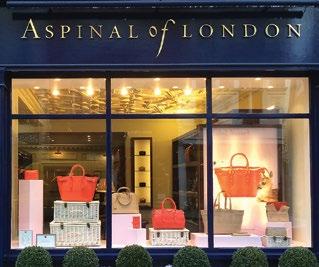
46


RECOMMENDS
WHAT DO THE BRITISH REGARD AS A GOOD GIFT?
Not any old gift can be given to British people. We recommend that you select a valuable book, excellent French wine or Scotch whisky, expensive chocolate (truffles), selected leaf tea or fine African coffee as a gift for your friend or host. Generally, British people make hampers filled with delicacies. These hampers are sent to their recipients at their house or brought along when visiting. Tiny and interesting gifts are placed in them. You will definitely please the host if you fill a hamper with Stilton, chutney, cheesecake, fine red wine, mint chocolates, tea and jelly candies bought in the selected markets. Likewise, potted plants are also appropriate as gifts.
SMYTHSON
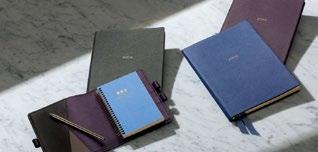
You can purchase Smythson’s handmade diaries for your daily notes in its shop on Bond Street and in large shopping centers such as Harrods, Harvey Nichols and Fortnum and Mason. A range of other stationary and leather accessories are available too.
THE CAMBRIDGE SATCHEL COMPANY
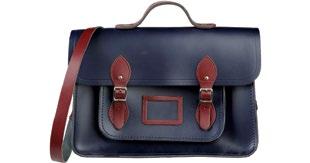
An abundant number of bags and backpacks are waiting for you here, made from the best British leather near Leicester. These bags can be bought in up-market stores across whole country, including in Selfridges, John Lewis and Paperchase. You can even make a special order, or have your initials engraved on selected models.
LONDON BEATLES STORE

If you love “The Beatles”, “The Rolling Stones”, “Pink Floyd”, “Led Zeppelin”, “David Bowie” and “Queen”, then this place is for you!
You will find a number of new and original items, t-shirts, clothes, wallets, bags, accessories, flasks, posters, photos, recordings and DVDs in addition to relics, ad posters, signatures and other interesting things.
231-233 Baker St, London
94 VOYAGER 4/2016
40 New Bond St, London
15 Shorts Gardens, Covent Garden, London
Marylebone High St, London
The legendary producer of fine bone china crockery, Wedgwood features a new collection of china alongside designer Kit Kemp using mythical creature characters. You can purchase them in the Wedgwood store in Stoke-on-Trent and in large shopping centers in London.
CUTLER AND CROSS
Cutler and Gross, a brand of exquisitely fine British eyewear established in 1969, offers incomparable, high-quality sunglasses and accessories. This company gradually became synonymous with refined British style, a creative approach and high craftsmanship. The premium quality frames are made in Italy now, and are regarded as an example of a true fusion of handicraft and design.
Cutler and Gross has been collaborating with fashion stars for years, creating limited editions of luxury glass frames: Erdem, Canadian designer, and Maison Martin Margiela, Comme Des Garcons, Mulberry and Alberta Ferretti.
16 Knightsbridge Green, London
WILLIAM & SON
Here you will not only find board game sets made from natural leather that are ideal gifts but also British-brand clothes and jewelry for men and women, leather bags and travel accessories. It is the best place for buying gloves and winter hats too.
33 Bruton St, London
and selling outstanding enchanted luggage since 1897.
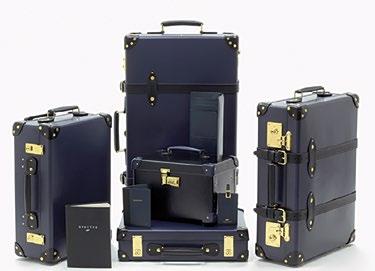
IN 1901, A ONETON ELEPHANT STOOD ON THEIR CASES TO PROVE THEIR STRENGTH. NOBODY WAS HURT DURING THE DEMONSTRATION –NEITHER THE CASE NOR THE ELEPHANT.
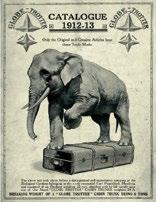
The company is always producing novel products and collaborates with modern well-known designers. These products are still primarily known for their durability.
35 Albemarle St, London

95 VOYAGER 4/2016
MADE IN BRITAIN
HARRODS
In addition to clothing for men, women and children, Harrods offers a paradise for shoe lovers on its fourth floor. Saint Laurent, Celine, Valentino, Kurt Geiger and Stuart Weizmann...you name it, it’s all here. If you would like to literally get drunk on perfume, visit the first floor. Only here will you smell excusive aromas such as Nasomatto, Bond №9, Roja and Byredo. The gastronomic area on the main floor will surprise you most of all. This space, which looks like a feast in an oriental fairy tale, offers an amazing selection of wines, exotic fruits and even black caviar. Because of the fact that the shop has been the property of the Al-Fayed brothers since 1985, you will see Dodi Al-Fayed and Princess Diana’s memorial by the Egyptian escalator. Among the first customers of Harrods were Oscar Wilde, Charlie Chaplin, Laurence Olivier, Vivien Leigh, Sigmund Freud…and of course members of the British royal family.
87-135 Brompton Road, Knightsbridge, London, SW1X 7XL
HARVEY NICHOLS
Harvey Nichols is a favorite shopping destination among fashion followers. It is a couple of meters walk from Harrods in Knightsbridge. Harvey Nichols has a wide variety of men’s and women’s clothing, shoes and accessories. The men’s department in the basement will remind you of a contemporary fashion museum.
Do you love glasses? Then you have to visit Harvey Nichols and try on the latest collections from Linda Farrow, Mykita, Atelier vin Doux and Cutler Gross. After shopping, do not forget to taste the best Sushi on the top floor, or enjoy the view with a glass of champagne on the open terrace.
Harvey Nichols’ exterior and interior are equally interesting. This department store is outstanding, with beautiful and very creative displays, like Selfridge’s. It becomes a real work of art at Christmas.
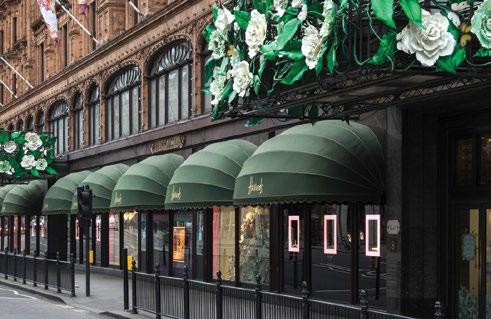
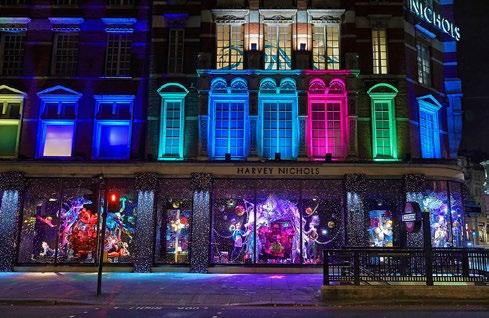

Knightsbridge, 109 - 125 Knightsbridge, London SW1X 7RJ
LIBERTY
This beautiful building in the Tudor architectural style was built in 1875 on Marlborough Street. It was finished in 1924 and soon became popular. Here you can see a collection of popular brands such as Martin Margiela, Ann Demeulemeester, Philip Lim and Jean Muir. Liberty is known for graphic prints, original interior design elements and gifts. It carries jewelry, perfumes and other expensive items. Let me warn you to take a fat wallet to Liberty. However, if you have not planned to buy something in particular, you will enjoy just browsing as well.
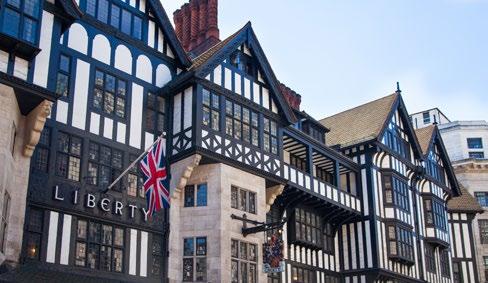
Regent St, London W1B 5AH
SELFRIDGES
More than 500 brands of clothes, bags, shoes and glasses are available in this department store. If you are interested in accessories, this is the place for you. It also offers the best collection of jeans. One floor carries more than 60 brands, starting from Primark and ending with Christopher Kane. Selfridge’s displays are also worth mentioning. They have exhibited works of famous artists on numerous occasions. Selfridge’s installations have been featured in magazines such as Vogue, Dwell, Icon, Frame, Creative Review, Harper’s Bazaar and The New York Times.
400 Oxford St, London W1A 1AB
96 VOYAGER 4/2016
NEW BOND STREET & SLOANE STREET
Visit Bond Street or Sloane Street if you are hesitant to spend your time on the mixed collections at big department stores and you have no problem visiting one shop after another, and there is fine weather as well. These streets and their crossroads house shops of all the famous brands.
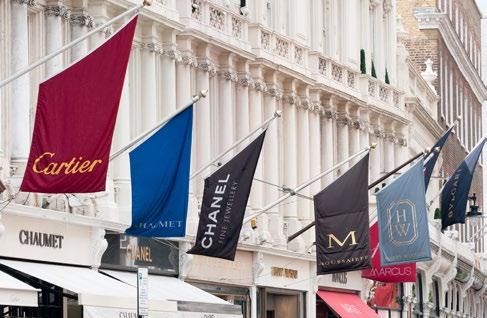
Sloane Street is the best place in summer for men and women to go shopping together. While women can look at Marni, La Perla, YSL, Joseph or Prada, men can (if they are bored with shopping) enjoy amazing car collections. London’s famous Bond Street is famous for its exclusive brands. It houses Chanel, Ralph Lauren, Hermes, Burberry, Rolex, Chopard and De Beers.
The UK’s capital contains shops of brands that other countries’ luxury shopping centers feature limited collections of or none at all. Here, even the smaller Brook Street houses not just one, but two Maison Martin Margiela shops. In the neighborhood you can see clothing from Issey Miyake and Pleats Please, Jo Malone’s Aromas, Pan Ziler’s latest men collection and Sonia Rykiel’s boutique, with its traditional colors.
Jean lovers must visit a couple of addresses, for example: Donna Ida’s boutique in Chelsea. Jeans for women can be found at Acne Studios, Dover Street, starting from skinny, ending with the trendy high-waisted jeans. The Rag & Bone and All Saints shops in Sloane Square contain a variety of jeans for different tastes. You can buy jeans for all occasions at Philipp Plein’s recently opened shop on Bond Street and they will stay comfortable for years.
ASPREY
Asprey, known for its leather goods, jewelry, silverware and home goods, established standards for British luxury goods in 1781. Asprey started working in Surrey in southern England, but moved to New Bond Street in 1847. The company has had a long partnership with the British royal family that started in the 19th century, when Queen Victoria awarded Asprey a royal warrant.
www.asprey.com
DOVER STREET MARKET
DSM is a dream come true for fashion lovers. It includes five stores of clothing and shoes for men and women. This conceptual shop was designed by Rei Kawakubo, founder of Comme des Garçons. Accessory lovers with a weak heart should enter cautiously. Models from Delfina Delettrez, Sophie Bille Brahe, Repossi and other famous jewelry houses will blind you at the entrance.
If you want to look extraordinary and distinguished, you must visit this shop and besides designers’ collections, you will see different installations as well.
In the end, you will find a big surprise there: between stores, under the stairs, you will find copies of Niko Pirosmani paintings. We discovered that Rei Kawakubo was an admirer of the Georgian artist.
Dover Street Market relocated this year to the following address: 18 Haymarket, St. James's, London SW1Y 4DG. London Underground: Piccadilly Circus, Charing Cross, Leicester Square.
Matches is a most prestigious department store with five boutiques including in Wimbledon Village. Matches shops offer the latest men’s and women’s clothing collections.
Collections from Balenciaga and Vetements designed by Demna Gvasalia are probably the most interesting for us. You will also find clothes and shoes from Self-Portrait, The Row and many other famous brands.
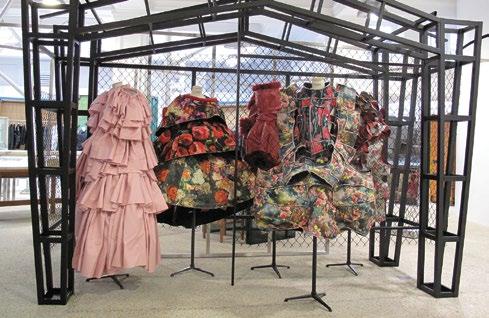
36 High St, Wimbledon Village
GRAFF DIAMONDS
London jeweler Graff Diamonds works with rare gems at all stages of the work starting from carving and ending with the final look. The Peacock necklace was designed here in 2013.
It is an amazing piece with 120-carat colored diamonds. It is priced at $100 million and is among the most expensive items ever created.
www.graffdiamonds.com
97 VOYAGER 4/2016 SHOPPING
SEROTONIN VINTAGE
If you would like to find yourself in a 1980s discotheque, this shop is for you. The revived style of the shops expresses Shoreditch’s mood.
194 Brick Lane, London E1 6SA
CATH KIDSTON
Visit Cath Kidston for its aprons, tablecloths and all the other houseware and souvenirs embroidered and decorated with flowers. 100% British style is guaranteed.
French Railways House
178-180 Piccadilly
London W1J 9ER
KOKON TOZAI
This unique shop not only sells various brands of clothes, but a lifestyle. The business started in Soho and took over London and Paris. Visit this shop for interesting clothes, music and other items.
57 Greek St, London W1D 3DX
RELIGION
If you need something controversial, or want to win the heart of your teenager, Religion is the right shop for you. Here you will find artistically pierced clothing.
154 Brick Lane, London E1 6 RU
FOUN AND VISION
Foun and Vision
This unique vintage clothes shop offers famous brand clothing, which is not only trendy, but also stands out. Drop by if you want to see the most interestingly dressed models.
104 Golborne Rd., London W10 5PS
OLLIE BOW AND SON
Visit Ollie Bow and Son’s shop to make your dreams of Ali Baba’s cave come true. Here you can find old game machines, neon bar signs, toy ships and thousands of other things that will make your house stunning.
69 Golborne Road, London W10 5NP
BOXPARK
BOXPARK is in the middle of trendy Shoreditch. A shopping mall with an original design, it is constructed from containers. BOXPARK is the best place for new businesses and start-ups to create an original environment. Here you will see the latest inventions and a lot of innovations and can buy everything from fashion trends to intriguing presents.
2-10 Bethnal Green Road E1 6GY, UK
London Underground: Shoreditch High St.
LES COUILLES DU CHIEN
This is a perfect place for a special gift. At this strange and antique shop, you can find something that stands out. In addition to its interesting furniture and interior, this shop sells strange and rare breeds of butterflies, insects, shells and minerals. At a glimpse, you cannot believe that these insects really do exist. On request, the staff will arrange butterflies in a beautiful frame.
65 Golborne Rd., London W105NP
ONE NEW CHANGE
One New Change, a new shopping mall on London’s shopping map, hosts independent and chain shops.
Workers mainly visit this center in the middle of the week, which is why on weekends One New Change becomes a calm and cool place and its environment is drastically different from the crowded Oxford Street. Some top restaurants are located here, including Gordon Ramsay’s Bread Street Kitchen.
1 New Change EC4M 9AF Subway: St Paul’s
THE HACKNEY SHOP
This initiative is not oriented towards profit. Hackney gives creative residents and collectives the opportunity to open their pop-up (temporary) shops within The Hackney Shop free of charge. Owing to this initiative, you will see here the future of the fashion as envisioned by east London designers.

99 Morning Lane Train: Hackney Central
CASS ART
The biggest branch of this chain serves the most creative society of London in the Islington district. In this three-story architectural triumph, you can buy affordable art and craft materials. This place helps regular visitors find their inspiration.
66-67 Colebrooke Row N1 8AB London Underground: Angel
ARBON INTERIORS
This is a remarkable shop that sells old architectural elements, fireplaces, doors and other interesting items.
80 Golborne Road, London W10 5PS
98 VOYAGER 4/2016
BEYOND RETRO
This shop opened in 2002 at a former diary farm on Cheshire St and became a flagship for the eclectic fashion stage of London. It is a magnet for experienced travelers and famous people in the east of the city. The store sells various brands, trendy clothes by young designers and vintage accessories in addition to vintage clothing.

58-59 Great Marlborough St., London W1F 7JY
CIRCUS
This store is a beloved place for those who love dress eccentrically. Circus offers young designer clothing and vintage discoveries. Here you will find a lot of things, from artwork for affordable prices, to home accessories to poetry books and contemporary ceramics.
Brixton Village SW9 8PS London Underground: Brixton
UNIVERSAL WORKS
This brand for men is a mix of British heritage, both traditional and modern.
40 Berwick St W1F 8RX London Underground: Tottenham Court Road
WOLF & BADGER
This shops helps to popularize independent fashion for accessory, jewelry and interior design brands. This interesting concept makes it a place where you can find designer brands and the newest creations of the fashion industry.
46 Ledbury Road W11 2AB Notting Hill Gate
THE GOODHOOD STORE
Fashion and lifestyle shop
Goodhood has a distinctive Scandinavian design. Within the interesting interior, men and women’s clothing, shoes and accessories are sold. It also offers houseware and original things for everyday use.
41 Coronet St N1 6HD
London Underground: Old St.
THE HATTON GARDEN
The goldsmiths’ district in the middle of the old city of London is considered to be the heart of the jewelry trade. Nowadays, more than 300 goldsmiths and sellers are located here; thousands of masters and craftsmen work and sell antique and futuristic styles.
www.hatton-garden.net
TK MAXX
Visiting this place will be light on your wallet and can be interesting at the same time. Central London’s TK MAXX shops offer clothing, shoes and accessories for men, women, and children at big discounts. Here you can find Marni, Joseph, Love Moschino, Prada, Rochas...and everything for up to 60% off. TK MAXX has several branches in London. Choose the one closest to you.
ZADIG AND VOLTAIRE
French brand Zadig and Voltaire recently opened an outlet on the Kings Road. Think how many times you have looked through beautiful collections of brands and said “no” because of the prices and then visit this outlet shop in London.
57 King St. Hammersmith W6 9HWLondon
BICESTER VILLAGE
Only 46 minutes by train from London and you will find yourself in this outlet village. Here you will find more than 130 famous brand boutiques and will save up to 60% on each item. The diverse choice of alternatives for restaurants and cafés will make your day at Bicester Village unforgettable.
NOTSOBIG
London houses lots of shops offering cool and “adult” clothing for boys and girls who know the fashion trends. Notsobig, which is named after Roald Dahl’s imaginary crocodile, is in Highgate. Its founder Jane Wills personally selects fashionable, comfortable and funny outfits for children from famous and talented young designers.
31a Highgate High St., London
PAPOUELLI
The lovers of trendy fashionable shoes should visit Papouelli in the Marylebone and Belgravia districts. These children’s shoemakers offer very comfortable and classic-style shoes, which are matched with children’s needs and taste. The company has recently started manufacturing small size clothing as well.
43 Elizabeth St., London
COUVERTURE & THE GARBSTORE
Couverture & The Garbstore’s shop in Notting Hill is a real treasure trove of good taste. The children’s department boasts collections by the most famous British designers.
188 Kensington Park Road Notting Hill, London
99 VOYAGER 4/2016 SHOPPING
ENGLISH FRAGRANCES ARE CHARACTERIZED BY THE TRAITS WHICH DISTINGUISH THE NATION ITSELF: RESERVED, STRICT AND SEQUENTIAL IN NATURE, PROVIDING HAUGHTY ELEGANCE, AN ARISTOCRATIC TOUCH, CONCISENESS AND PRECISION.
PENHALIGON'S
In the Victorian Era, Penhaligon’s products attained immense recognition at the Royal House and has since become a symbol of good taste. All aromas of Penhaligon’s collection are a celebration of style and genuine taste. It is known that their “Bluebell” fragrance, the base note of which is the bluebell’s pure, light and slightly bitter scent, was one of Princess Diana’s favorites.
FLORIS
Perfume house Floris has existed in London since 1730 and is still run by the descendants of the founders, Juan Famenias Floris and his wife.
As the personal suppliers to King George IV, they received the royal warrant in 1820. The Royal Family have been using Floris’ services for years, as well as a number of statesmen and famous figures, including Winston Churchill and Marilyn Monroe.
Nowadays, Floris is famous for its four major collections: “Fragrances for Men”, “Fragrances for Women”, “Classic Collection” and “Private Collection”. Its first branded perfume was made as early as 1786 and the newest in 2016.
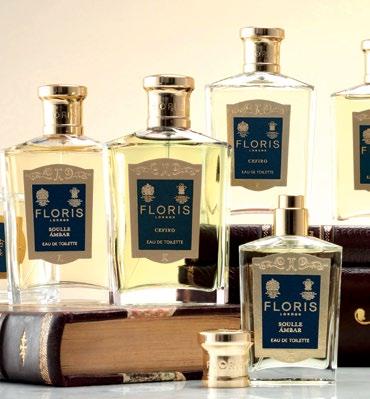
89 Jermyn St, St James's, London
CREED
Creed Perfume was founded in 1760 by James Henry Creed.
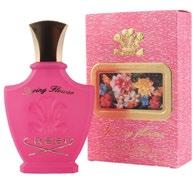
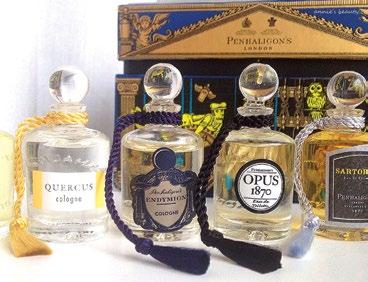
Although the Creed laboratory was moved to Paris in 1856, the aromas of this brand remain truly English: stern, well-defined, elegant and solid, like the classic scent for men “Erolfa”, the masculine and dynamic “Green Irish Tweed”, or even Churchill’s favorite aroma, “Tabarome”. “Love in White” is the favorite perfume of Michelle Obama, current the First Lady of the United States.
“English Fern” is considered a pure English scent, which is composed of traditional components of national perfumery: geranium, lavender, clover, sandalwood drenched with wood scent, oak moss and patchouli. “Black Vetyver Café” is recognized as an essential English aroma for men, characterized by the elegance and sharpness of its heart notes (vetiver and coffee); the blend accentuates British men’s reserved nature.
JO LOVES…
Enjoy the aroma created by the queen of British perfumers, Jo Malone. Find your aroma at their store “Jo Loves”.
42 Elizabeth St, London
JO MALONE
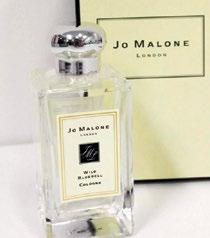
Thanks to its incredible blend of luxury and simplicity, Jo Malone’s perfumes have gained admirers worldwide.
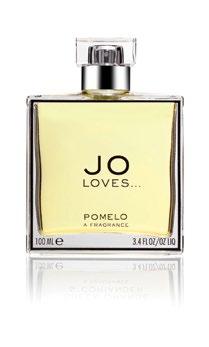
WASHINGTON TREMLETT
The brand was established in 1870 as a producer of elegant dress shirts for men. The brand’s shirts were very popular.
The founder of the firm, Mr. Tremlett, is known for inventing ties, which replaced scarfs and bow ties in men’s outfits at that time.
Washington Tremlett offers exclusive aromas which are highly valued for their high quality and genuine style. The oriental scent “Black Tie” is a unisex cologne, composed of wood, flowers and spice notes, which create an extremely sophisticated and, at the same time, sensual bouquet.
“MPH” (Miles Per Hour) is a strictly masculine scent, and embodies breathtaking speed, adrenaline, drive and courage. This is an aroma of adventure, passion for racing, strength and excellence, with notes of citrus, lavender, pepper, tobacco and oak moss.
The brand has become so sophisticated and valued that even very loyal clients are surprised to learn that it is only 19 years old.
Its founder is the successful London cosmetologist Jo Malone. The brand offers six groups of aromas: citrus, fruits, delicate flowers, flowers, spices and wood.
The whole collection uses 35 aromas in total.
100 VOYAGER 4/2016
MURDOCK
Classic barber services such as wet shaving, trimming or hair styling are based on the trade of the historic Saint James Barbers, which have now adjusted to the needs of modern men. Local barbers create a comfortable environment for gentlemen and help them choose appropriate styles.
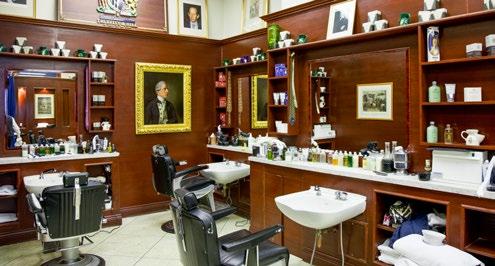

Only five armchairs are placed at the Murdock barber shop, which is outstanding with its stunning design and represents a unique mixture of Victorian style and modern art. Here you can find and purchase an assortment of men’s hygiene products or accessories, as well as a variety of new editions of books to read in London. This barber shop, located in Covent Garden, is a truly luxurious, masculine getaway.
18 Monmouth St, Covent Garden, London
CARTER AND BOND
Here, from Monday through Saturday, you can not only have your hair cut but also get the best shave in London, and a superior after-shave massage with a wet towel. You will also find a huge variety of aftershave lotions – in particular: Agua de Colonia, Baxter of California, Beardsley, Bounder, Czech & Speake, Lucky Tiger, Marvis, Proraso – as well as specially chosen brushes, razors and other accessories. Clients
can request the company’s barber services at their home; in this case, beard trimming starts from 14 pounds, and a wet shave and hair cut start at 34 pounds.
189 Westbourne Grove, London
SWANKY
If you don’t want to limit your grooming routine to visits to barber shops, and you wish to take more care of your appearance, you should visit Swanky. It offers all salon procedures, including brow sculpting, eyelash extensions, manicure, pedicure, etc. Reservations are required.
Be mindful that the majority of such salons require a credit card number in advance. If you miss your appointment and do not cancel the reservation 24 hours in advance, you will have to pay 50% of the fee.
335 Portobello Road, London W10 5 SA; Tel. 020 89697580

26 Chamberlayne Road, London NW10 3 JD; Tel. 020 89 64 2569
MICHAELJOHN
Notwithstanding the ultramodern exterior, Michaeljohn represents old-school luxury salons, located in the district of Mayfair.
The salon is frequently visited by Princess Beatrice, editor-in-chief of Vogue Anna Wintour and Hollywood stars like Cameron Diaz and Drew Barrymore.


25 Albemarle St, London
MW NAILS
The interior resembles the cabins of 70s airliners.
The Captain’s Cockpit is deemed a special service here: the 70-minute procedure includes a manicure, massage and exfoliation; it costs £69. An ordinary manicure will cost you £15.
Old Spitalfields Market, 111B Commercial St, London
101 VOYAGER 4/2016 FRAGRANCES / SALONS
HERE’S YOUR HAT, WHAT’S YOUR HURRY?
The British have used this saying for centuries, and although size, pattern, look and material of hats have been altered many times by the rules of fashion, the proud British never appear hatless in public.
Wearing appropriate head covering conventionally relates to high society. Fortunately, nowadays not only the royal family and aristocracy but ordinary people too tend to choose hats with great care for various events, including horse-racing, auto racing, tennis, cricket, and of course weddings.
The live broadcast and subsequent video footage of the Royal Wedding back in 2011 made familiar to the rest of the world that the mother of the bride in the UK will always wear a fascinating hat, and that guests’ head coverings will display all the colors of the rainbow.
As for materials, you may notice straw hats or silk ones, and large, feather-like embellishments or modest ones, but the groom’s friends have to wear top hats while eagerly waiting in the church for the bride to appear.
Thanks to such royal weddings, hats make us travel back in time. If you wish to own a hat like this, you will certainly need to refer to the famous British hat makers.
LOCK & CO
Charlie Chaplin was astonished by the hats that he was sent and accordingly sent a letter of appreciation to the master.
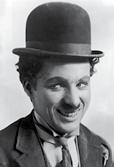
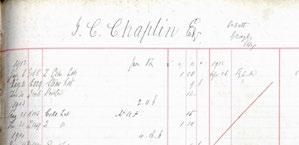
London store Lock & Co has been active for four hundred years. If you are searching for the finest hats, you should visit this place. In 1850, local hatters created the bowler hat, which still remains the symbol of English grace. The Lock & Co fedora hat remains popular because you can give different shapes to it – even the shape of an asymmetric sculpture. In addition to cylinders and jockey hats, you may purchase hat storage boxes and walking sticks here. This company’s hats have become extremely popular through their use in movies.
6 St James’s St, London
STEPHEN JONES
Owing to his inexhaustible, inventive mind and high craftsmanship, Stephen Jones was a hat supplier to Princess Diana. He has organized hat exhibitions at The Victoria and Albert Museum and has made significant contributions to the fashion shows of famous designers such as Vivien Westwood, Jean Paul Gaultier, Galliano and Marc Jacobs. Over the years, the names of his hat collections have been as outstanding as the collections themselves, for example “Murder by Millinery”, “Passport to Pleasure” and “E=mc2”.
Currently you can purchase not only Stephen Jones head coverings but also his perfumes at Covent Garden or Dover Street Market. Prices start from £250.
36 Great Queen St, London
PHILIP TREACY

More than 30 attendants of the Royal Wedding in 2011 wore hats made by Philip Treacy – one of the most famous names in the hat industry. The hats of Princess Beatrice and Victoria Beckham were some of the most outstanding ones.
Lady Gaga is also supplied by Philip Treacy with a huge variety of hats. You can try on his works, which are tantamount to art, at his shop close to Sloane Square.
69 Elizabeth St, London
102 VOYAGER 4/2016
SOTHEBY'S

Sotheby’s is one of the oldest auction houses in the world. This house, together with Christie’s, holds more than 90% of the world market of antiquary and artwork. Sotheby’s was founded in London on March 11, 1744 by a bookseller Samuel Baker. Only aristocrats could work in this closed club. Sotheby’s auctions have therefore been developing for over 250 years. Modern innovations introduced here, including live streaming of auctions or online bidding in real time, enable bidders to participate in the auctions from anywhere in the world.
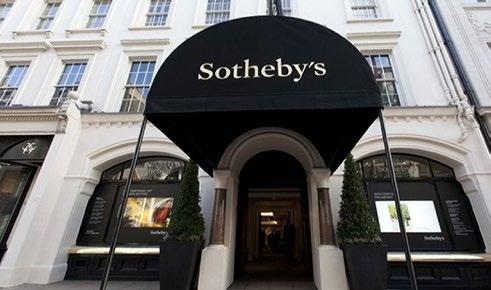
Attendance at all auctions at Sotheby’s is free of charge and open to anyone without the need to participate in a trade. The majority of auctions are held during the daytime, although some are held in the evening as ticketed events. Customarily, artworks, antique and decorative works, books, manuscripts, jewelry and wines are traded at Sotheby’s auctions, but sometimes rare,
ATTENDANCE AT ALL AUCTIONS AT SOTHEBY’S IS FREE OF CHARGE AND OPEN TO ANYONE WITHOUT NECESSARILY HAVING TO PARTICIPATE IN A TRADE. THE MAJORITY OF THE AUCTIONS ARE HELD DURING THE DAYTIME, ALTHOUGH SOME ARE HELD IN THE EVENING AS TICKETED EVENTS.
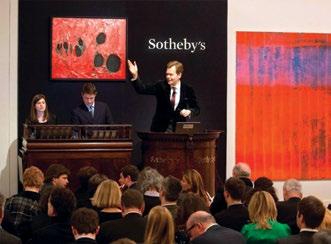
CHRISTIE'S
Christie’s is the oldest auction house in the world. It started trading paintings, furniture, jewelry and rare wines back in 1766.
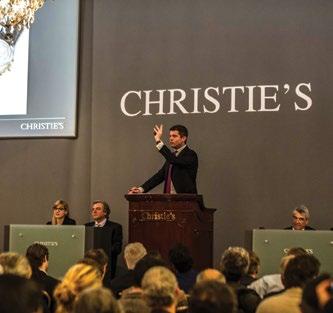
unusual and unique items – like first editions of basketball rules or a well-kept dinosaur skeleton – can be traded as well.
34-35 New Bond St
BONHAMS
Bonhams is one of the oldest and major auction houses in the world for trading fine arts and antiquaries. The company was set up in 1793 by Thomas Dodd.
Modern-day Bonhams was formed in November 2001 through the merger of Brooks with Phillips Son & Neale. In 2002, it purchased American Butterfields. In August 2003, Australian Goodman joined with the company, which owns auction halls in Sydney.
On December 5 of the same year, James Christie held the first auction. He was selling more than 80 categories of items, including paintings, decorative and jewelry works, rare wines and collectibles.
On the basis of formerly sold analogues, Christie’s auction provides free-of-charge valuations of artwork, which are subject to trade at auction. You may request the approximate value of an item via post or internet. The company operates a sliding scale of commission rates based on combined annual sales of property. Commission rates vary in sales places of Christie’s and also accordingly to whether items are being auctioned for trade or for charity.
8 King St, St James's, London
Bonhams is therefore currently one of the largest auction houses in the world.


Bonhams offers more auctions to its clients daily than what its competitors can handle. In particular, Bonhams trades more than 700 items in 70 categories every day, including jewelry, porcelain, furniture and varieties of guns, wine and fine arts.
101 New Bond St, London
103 VOYAGER 4/2016 AUCTIONS
KIDZANIA
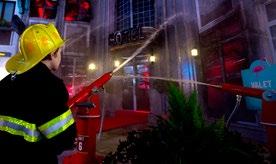

The center, designed by "British Airways", is a brilliant idea for kids and parents alike. It is a children's city – called KidZania – located in a shopping mall in Notting Hill. If the children are sufficiently independent and at least eight or nine years old, they can stay here on their own while their parents go shopping. In order to travel to KidZania, you have to check in at the airport. After buying an “airplane” ticket, you can visit the city. Imagine a city with shops, hospitals, bakeries, fire departments, cafes, cakes and a chocolate factory. All of it is authentic (operated by real firms) but made the right size for little ones, and children work there. The city has its own money, which you will receive along with your ticket, and you can spend in any store.
The child will receive a salary if they start working, for example, as a saleswoman in a store or a supermarket, or in a hospital. Each establishment has its own uniform. Children may also work in a chocolate factory. This service is, of course, very popular.
The chocolate is real and so is the process of its preparation.
It is a unique space. You can visit the city with children, since there are adult zones where you may enjoy a cup of coffee. A separate area is set up for children up to three years of age. They learn how to earn money and spend it afterwards. The game and the city is so great, the only problem is convincing the children to leave.
Tickets can be purchased online: www.london.kidzania.com
Westfield London Shopping Centre, Ariel Way, London
sharks floating in the aquarium. Sea lions and other animals enjoy the perfectly tailored environment. The space is divided into ten thematic areas with about forty attractions for various tastes and ages.
The park offers lots of roller coaster rides too. Selfies taken in the dangerous tunnels, on the back of dinosaurs or on a high-speed pirate ship in the water-filled tunnel will be fun to view later. Everything here is created for the whole family.
SEA LIFE LONDON AQUARIUM
Your children may get tired of the big-city pace, crowded places and gallery visits. Before long, they will start yawning. There’s a better option than returning to the hotel: the London Aquarium. Visit the London Aquarium and enjoy the beauty of the sea.

This is a popular destination so purchase a VIP: Behind the Scenes Tour ticket to avoid the huge queues. The guide will ensure that you avoid queuing and visit the areas that are closed to ordinary ticket-holders.
Children can run excitedly for 40 minutes along all of the huge windows and stare at strange and unusual fish and other sea creatures. The guide will allow them to see how the food is made for more than 5,000 inhabitants of the water and how the aquarium personnel take care of them.
The swordfish’s long nose and saw-like fins will convince you that the visit to the London aquarium was a good idea.
CHESSINGTON WORLD OF ADVENTURES
Chessington World of Adventures is a family resort, located about ten miles away from London. It has its own zoo and aquarium.

Even adults cannot remain indifferent to its silly penguins or the dangerous
If you are planning to take a rest, give the children tokens for the arcade and choose between a variety of restaurants and cafes.
Leatherhead Rd, Chessington
TRANSPORTATION: CHESSINGTON SOUTH RAIL TRAIN, FOLLOWED BY #71 BUS.
PUPPET PLANET
String puppets, marionettes and hand-mounted dolls from around the world are gathered on the shelves of Puppet Planet. This magical shop has its own theater where you can try any of the marionettes and stage funny or interesting scenes.

The collection of puppets and marionettes is beautiful. Start a new adventure with the children that will last for ages.
787 Wandsworth Road, Vauxhall, London
104 VOYAGER 4/2016
County Hall, Westminster Bridge Rd, London
LONDON DUCK TOURS

Book tickets to this fun tour of London's main attractions instead of a long and tiring day trip. Visit London’s main sites in an hour and a half with the children and no one will be left unhappy. The old yellow military bus is a true amphibian: it will first drive you and your little family members ashore, through various wellknown places, and then will pull up its sides and swim into the river like a yellow duck.
Children’s delight is boundless, and the boat has many windows to provide a perfect view. The floating bustour guide is fun and does not allow passengers to get bored.
Another interesting addition is viewing the MI6 building where James Bond works; this is especially interesting for the boys. Every young person knows about the cool "toys" that are made in this building for different agents. The Thames tour is amusing for girls as well.
If your child is a Harry Potter fan, head directly to Kings Cross station. A “9¾" shop has been opened in a corner of the central lobby. The Hogwarts Express leaves from the same platform to take students to the famous school of witchcraft and wizardry. This wonderful store offers everything associated with the magical world of Harry Potter. You can try a magical hat at the entrance to find out which Hogwarts school you belong to.
The store contains magic wands which glow when they are moved, robes, brooms, and even Hogwarts’ acceptance letters. If you take your children, they will love it, but it poses a great threat to your wallet.
„9 ¾“, Kings Cross, Kings Cross Station, London
HAMLEYS TOY STORE
If you are in London with your children, visit Hamleys Toy Store, which is among the oldest in the world. Imagine all of the parents who took their children to Hamleys in 1760.
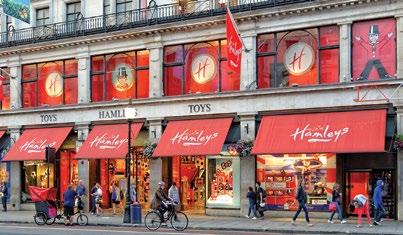
The tradition has continued since then. Seven floors exhibit 50,000 toys for little visitors, ensuring their happiness – and a catastrophe for your wallet. Here you will find lot of visitors from around the world, as the store is a tourist attraction in its own right.
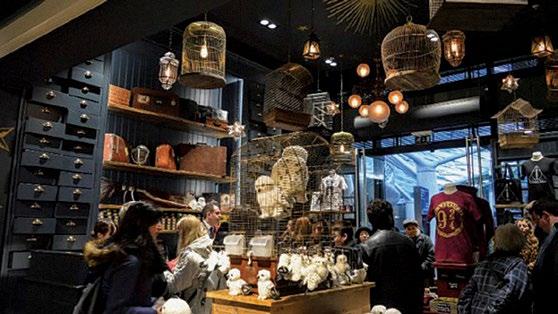
188-196 Regent St, London
WARNER BROS. STUDIO TOUR LONDON - THE MAKING OF HARRY POTTER OFFERS SCENES AND OBJECTS FEATURED IN THE FILMS FOR THE 15TH ANNIVERSARY OF THE FIRST HARRY POTTER FILM. DURING THE EXCURSION, YOU CAN SEE AUTHENTIC PROPS, COSTUMES AND SCENES USED IN ALL EIGHT "HARRY POTTER" FILMS.

KING'S CROSS STATION STAFF WERE SO TIRED OF THE QUESTION, "WHERE IS PLATFORM 9 AND ¾?" THAT THEY PUT A SIGN BETWEEN THE 9TH AND 10TH PLATFORM AND INSTALLED A CART THAT IS PASSING THROUGH THE WALL...

July 22 to September 5, "In Search of the Philosopher's Stone".
October 15 to November 4, the 15th anniversary. On November 19, do not miss "Snow-covered Hogwarts". Ticket price: adults starting at £55.00, children starting at £50.00, families starting at £205.00. Buy tickets in advance.
Studio Tour Drive, Leavesden www.wbstudiotour.co.uk
105 VOYAGER 4/2016 FOR CHILDREN
Great news for parents who are exhausted trying to find the perfect gift for their child!
9¾
TOM STOPPARD’S COLD
LASHA BUGADZE
The British playwright Tom Stoppard had the worst cold of anyone I’ve met in my entire life.
He had a cold – not a flu or a fever; he was not sad or irritated like other people who have a cold. He carried himself as if he had been born and raised with cold, like he wrote all of his works with cold, including “Rosencrantz and Guildenstern Are Dead”; as if he had had a cold when he got married, and had had a cold when he wrote the screenplays for his famous movies (for example “Shakespeare in Love”); and as if that’s how he created his masterpiece “Arcadia”. It seemed like he has never lived a single day cold-less.
He had clearly put some effort into his outfit choice, including his coat, scarf, thin cardigan and messily (but in reality, very aptly) stuck-out shirt. He wore velvet pants and bright orange socks (they say that the British hate dark socks) that pointed towards his delightful cold.
The moment he sat down and greeted us, when it was syntactically important for his monologue, he took out the main tool of his cold – his handkerchief – with great care, reverence and ritualistic calm. He then reservedly blew into it (not like the Germans who neigh into the handkerchiefs). It was more than a cleansing: he stopped, opened the handkerchief with dignity and put it to his nose with the skill of a pianist. The time allocated for nose-cleaning was special, as illustrated by his exquisite movement and mysterious pause:

When an Englishmen cleans his nostrils with a handkerchief, time must stop. Whoever is walking must halt; whoever is opening a door must close it silently; whoever is starting a car must turn the engine off; and whoever is pouring tea must stop – all so the person with a cold can calmly perform their hygienic, therapeutic ritual. Stop the clock! The Englishman with a cold has taken his handkerchief out of his pocket!
It’s no coincidence that Tom Stoppard’s most popular play takes us into the second play of another great British playwright – Shakespeare’s “Hamlet”. However, the handkerchief is the fatal panegyric in “Othello” rather than the tragedy of the Prince of Denmark. Even those who have never had a cold
need their handkerchief in “Othello”. Nobody has the flu in that play but everyone keeps talking about poor Desdemona’s handkerchief. Her physically healthy but mentally unstable husband is especially preoccupied with this item and the Bard makes him holler the islanders’ favorite word: “handkerchief!”
But now I was looking at Stoppard, not Shakespeare. Stoppard sat proudly, weary in the midst of several foreign playwrights, and was folding his handkerchief with great reverence. The nose-cleaning ritual was about to end and he was free to continue his ill-conceived greeting, when he predictably started talking about the weather. It was obvious from his greeting that starting a conversation was always difficult for him; when an Englishman finds chatting difficult, they always talk about the weather (other nationalities take this after the British).
With a melancholic glee, Tom Stoppard noted that the weather was wonderful. We all agreed, though not all of us shared his point of view. For example, I, the Georgian, believed that the weather was positively awful – the rain drizzled against the window and the black clouds wandered back and forth. The forecast had said that there would only be ten percent chance of sunny weather, though even that ten-percent sun was nowhere to be seen.
What if Stoppard really thought that this was good weather and I had an erroneous view about his weather beliefs? What if he held that the ten-percent (yet to appear) sun made a brightly-lit sunny day? Or maybe, he had a cold and benefited from this ten-percent sun, which allowed Londonians to lie down on the grass while he, weary with the English cold, would feel even more uncomfortable and sad than he did now?
Could we compare Georgian and English rain?
English rain falls with academic precision rather than chaotically. The diverse English rain knows how long and in what style it has to come, and the people who will have to get wet (or not) under that rain are also certain of its properties. I have to add that I have never seen a British person get wet against their wishes: the rain can’t drench you if you wish to stay dry. English rain therefore looks highly academic compared to Georgian
106 VOYAGER 4/2016
rain. Unlike the British, we don’t know how to deal with it, and I believe that Georgian rain doesn’t know what it's doing either: it falls as if a bucket has been dumped on our heads, with angry rain dropping mud and disrespecting unprepared men and women. English rain, by contrast, is so intelligent – a dignified drizzle or a proud shower, or kind, non-violent and symmetrical drops. Downpours do occur occasionally, along with the heavenly waters brought by ocean storms, but these are allocated a strict timeframe.
Similar unprofessional rain pours in Greece where no one knows what to do when it rains--it causes anarchy and chaos; the thunder is also deafening in Greece. That’s probably why the ancient Greeks believed that Zeus demonstrated his power and anger through thunder.
Anyway, Tom Stoppard made me realize how delicate English rain is, as the raindrops arranged themselves on the window.
The man with a cold looked out of the window and praised the weather, then turned his head towards us and stared at us with his cold-red face. He seemed so tragic now compared to when he had stuffed the handkerchief into his pocket.
It was apparent that he was uncomfortable, as if he could not remember the English words that he had to use to describe something besides the weather. The coat that he was wearing seemed so well-fitted to his cold a while ago but now enveloped him like a sack, and the handkerchief pocket was weighed down to the ground, making it impossible to elegantly unfold it for a second time.
I was right: Stoppard looked at us with wide, terrified eyes and opened his mouth like he was out of breath. I supposed he was ill and noticed that someone else also looked worried by Stoppard’s vexing pause. That someone stood up and we looked at each other saying “Stoppard is sick, we must do something!”
This is what happened next: something that only an Englishman could perform with such high skill – a sacred tradition, sometimes thunder-like and loud, sometimes short and hushed by the enclosed space, sometimes tragic and cathartic, cleansing and restorative, loud and silent, quick yet prolonged, vocally and catastrophically alarming, a turning point that breathes new life…What was it?!
It was a sneeze.
Stoppard sneezed!
And I understood that he was waiting for this sneeze from this very morning, or maybe even from last night. And everyone in this room was waiting to hear it.
He produced a long and melodious sneeze, coinciding with the appearance of the ten-percent sun. He sneezed with a knowledge and relief, with the experience of a thousand years, with ecstasy and meditation. He sneezed and got his old self back.



A happy man appeared before us.
“So –” said Stoppard, as he ran his hand towards his elegantly protruding handkerchief pocket, to acquire it with a dignified elegance.
Equilibrium had been achieved. He could now start talking. He was finally ready.
107 VOYAGER 4/2016
FOOTBALL PASSIONS ON THE ISLAND
AKA MORCHILADZE
WHAT CAN I TELL YOU ABOUT ENGLISH FOOTBALL?
IT IS A VICTIM OF GLOBALIZATION .
Football was a victim of globalization long before globalization even existed; the English national football team had a hard time in international games. Football’s globalization started with the first World Cup. Football was invented in Britain and the inventor never forgets his/her invention.
Iceland is kicking the UK out today, and everyone who is able to has kicked out this strange, inconceivable, Shakespearean tragedy of a national football team. What can I say about English football?
Rigid people claim that the British cannot play football. Brazilians, Italians and others may be entitled to say that. Countries that have won stuff several times. But not everyone.
The notion that the British can’t play football is silly. Despite the facades that Italian, Chinese and other ball-playing ancient civilizations present, despite all the Aztec deities, it is a fact that the rules of many sports and specifically football were created in the UK.
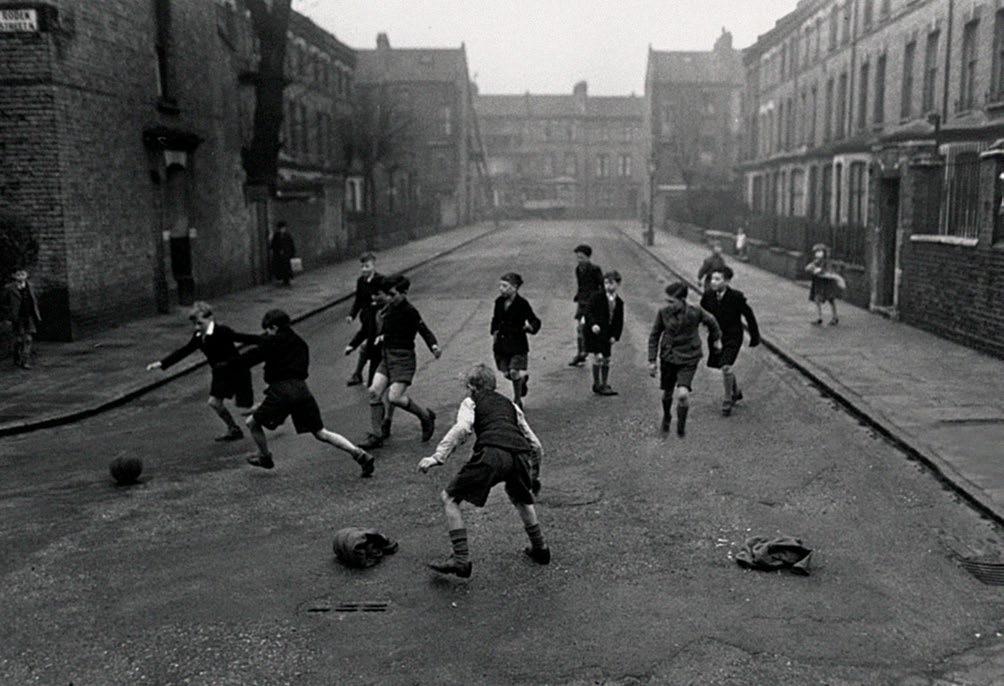
This is what happened: the British decided to make sport a public thing during the Victorian era and drafted rules for everything.
The empire was so vast that the sun never set on it, thus the rules established in England spread across the whole world.
We are not the kind of people who memorize Rudyard Kipling poems about supreme white men and special Englishmen, nonetheless, we are certain that the rules of the game were established in the Freemason Arms pub in Covent Garden, which is located on the street named after the queen 150 years ago. The rules cannot be altered despite multiple attempts to do so.
The debate today concerns the following issue: is the modern Freemason Arms pub located at the same spot where the football rules were drafted in 1863 or was it located 200 yards away.
None of this is important for football, of course. The club that made the rules for this rugby-like game and freed it from school or provincial ball games in that pub established the greatest game on earth.
The only football club from those times still present today is the tiny “Civil Service Football Club”. It plays in the South League as a loving witness to the creation of football’s rules.
The distance from the South League to the billionaire Premier League is enormous, but such ambition is nothing but a dream in Britain... and the dream is dazed.
108 VOYAGER 4/2016 SPORT
In English football, tradition and loyalty are paramount. There are great feelings of love, empathy and eternity with something that has passed. ‘My grandpa was a “Leyton Orient” fan and I slept in the “Leyton” t-shirt’; ‘we used to go to the “Crewe Alexandra” games in our childhood, dad always had tickets’; ‘How can I support anyone else? We have been supporting “Brentford” for more than 100 years. Did you see how far it has gotten?’
This is not unusual here. Why was he a “Crewe” fan when London could offer “Arsenal”, “Tottenham”, “Chelsea”, “West Ham”, “Millwall”, “Queen’s Park, “Crystal Palace” and many more? Because this is our district, our past and our tradition. We are so true and so honest. Not strong or famous. That’s the main event on Saturdays. This is what we did at the weekend. It is strange and old, but that is how it is.
It is often boring to write about such English stories when something new is introduced. The world is different today.
No one cares about the past. No one will remember that “Newcastle United” sent their striped uniforms to “Juventus”. No one will remember that English railway workers established Argentinian teams “Flamengo Rio”, “Milan” and others. The English football pilgrimage often takes only half a page in big books, while this big, forgotten history helps us understand what football means to the British.
You could read many interesting stories in old, charming books. Many of them are unexpected. Brazil is a huge country, but the UK probably prints the most football books in the world. This is amazing. The football in these books is alive, just like on the field.
The authentic football-lover has this quality: no matter how lowclass the game is, even if “Borchalo” (as they used to say in Tbilisi) teams play, he/she will stop what they’re doing and watch. I don’t mean TV games.
TV football is another thing. It is probably the highest class. But some football will never reach TV. It is what we call street football, though street football is almost gone today. That’s the real football in Britain. This real football has many names: pub teams, Sunday morning football, student football, etc.
We have many football schools and academies, so nothing surprising there; however, English student football exists sans sport schools and dreams of becoming millionaires. If you go to school, you can play for your school team, and if you are any good you will want to play for your district too.
Thus, you can play for both teams from your childhood.
Now, someone may claim that none of these teams are at the Copacabana, as the national football team has awful results, but English football and British attitudes towards football are symbolized by these amateur and traditional teams: the district pub team, which plays the other pub team, comprised of pot-bellied men with piercings; the Sunday morning teams: relatively athletic men who do not frequent pubs; the student teams; or all of the district teams.
FOOTBALL WAS ALWAYS A GAME FOR THE ORDINARY MEN IN BRITAIN. FANCY-SHMANCY SCHOOL STUDENTS FOLLOWED RUGBY, SINCE IT WAS FOR AMATEURS (MEANING THAT NO ONE GOT PAID FOR IT). IT WAS EMBARRASSING TO GET AN ALLOWANCE FOR PLAYING RUGBY UP UNTIL THE 1990S.
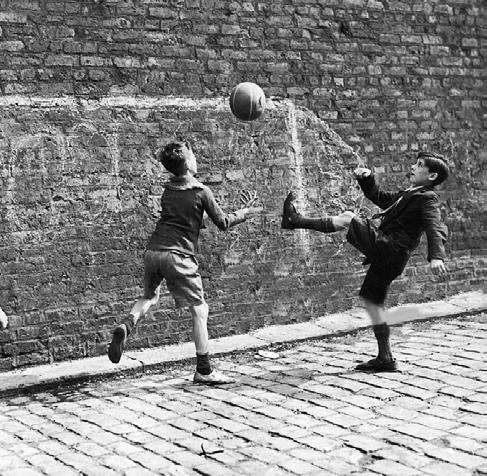
Alternatively, laborers that worked hard all day would meet on Friday, united in their street-workplace-district clubs and play each other for money. That meager income was important for them.
Football is the most democratic and liberal game in the world, where a small person can beat a big one. This is due to the fact that you can’t pick up the ball and run – you can only use your legs. People have sacrificed themselves for these rules and these rules have provided room for development.
The game could not exist otherwise. In any other case, it would be a rough, one-time game that some British schools play today.
National football teams can’t play well because their players get very emotional when they make it to the national team or stop caring about the game altogether. This means that despite the deep love, English football is just a sport.
Just a sport, and that’s it! Even if a man makes a million pounds a week, he will dedicate himself as a sportsmen, but as a human being he will accomplish no more than a smith and his anvil. It is beautiful in a way. It is a losing strategy as well. That’s how it is in England. Selfless and blood-covered Terry Butcher and Paul Ince, Andy Towers, famous for his wounded leg, and selfless Julian Dicks – it is all just a sport, and the amazing soul that’s part of the game.
Thus, Britain loses and Britain hopes. The love for football never ends.
109 VOYAGER 4/2016
SPORTS KINGDOM
A great English football player, Gary Lineker, once joked: “Football is a simple game. Twenty-two men chase a ball for 90 minutes and at the end, the Germans always win.” This expression can be rephrased: THE BRITISH COME UP WITH DIFFERENT SPORTS AND THEN THE OTHERS WIN!
Indeed, the inventors of football have won just one World Cup out of 20 (at home in 1966), none of the 15 European Championships and right now have even lost to Iceland! They have won only one Rugby World Cup out of 8, and have not won any prizes in women's tennis for 30 years. This is a long list …
However, victory is not the point! The crowd in the stadium and the millions of TV viewers owe it to the British that the sport they are watching exists. Let us look at some of the sports invented in misty Albion.
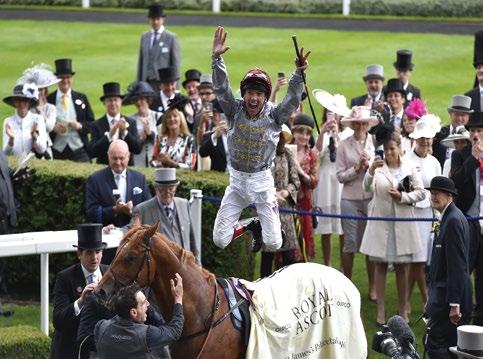

FOOTBALL. People have been kicking a ball with their feet for a long time but England is the birthplace of modern football. Some 30 variations of the game were created in 1324-1667. Rules close to the current rules were written in 1848, in Cambridge and the first football club – "Sheffield" – was founded in 1857.
RUGBY. According to legend, a student named William Web Ellis violated the rules of a football match in 1823 in a school located in Rugby. He picked up the ball in his hands and ran – and in the process invented a completely new type of sport! The school erected a monument in his honor.
TENNIS. . A lot of data show that tennis is a XII-century French game, while its "indoor" version was developed in Britain in the XVI century. As for the modern game, the rules were established in the 1860s in Birmingham Crockett field.
SQUASH. The above-mentioned "indoor"-type games were found worldwide. In the XIX century, squash was first played at Harrow School, derived from a game known as ‘rackets’.
TABLE TENNIS (OR PING PONG). This form of entertainment was invented in the Victorian era using a golf ball, a couple of books and a dining table. The first World Cup was held in London in 1926.
FIELD HOCKEY. English schools introduced the sport in the early XIX century. In 1849 the first club was formed in London. ICE HOCKEY. Although this game is considered to be a sport of Canadian origin, in the 1820s it was first played by British soldiers as an exotic form of grass hockey.
NETBALL. Women's College Basketball. The Swedish teacher Martina Bergman-Osterbergma invented this game in the XIX century and taught it to her students.
110 VOYAGER 4/2016 SPORT
BIDZINA BARATASHVILI
BOWLS. Southampton started throwing balls professionally in 1299. It is said that Sir Francis Drake played in Plymouth in 1588, and so went on to enjoy the destruction of the "invincible armada".
CRICKET. The sport became popular in the Tudor era; however, there are records of other versions, as Edward II was reported to have played the game in 1301. The etymology of the terms come from Old French, Dutch and English.
BASEBALL. Some sources claim that Americans loved playing this game of British origin. John Newbury in the book "A Little Pretty Pocket-Book" (1749) describes a match in Surrey. It is also described in Jane Austen's novel "Northanger Abbey" (1817).
ROUNDERS. Rounders comes from cricket and baseball, and today is mostly played by primary school children.
BADMINTON. XVII-century English soldiers in India were fascinated by these games, known Battledore andShuttlecock.
SNOOKER. It originated in India as the most popular variety of billiards in the XIX century (1874-75). It was invented by encamped soldiers.
DARTS. This was invented by soldiers and archers targeting the bases of beer barrels. It is known to have existed from as early as 1530 as Anna Boleyn – the second wife of Henry VIII – had a dart board.
GOLF. This luxury sport was played in ancient Rome and ancient China, but the birthplace of the modern game is considered to be Scotland in the XV century. The oldest gold course in the world is in East Lothian, called Musselburgh Links. According to legend, Queen Mary (Mary Stuart) played there in 1567.
CURLING. It is another brainchild of the Scots. An ancient club – Kilsyth Curling Club – was founded in 1718.
BOWLING. Nicholas Felix invented the first unit "catapult" (a bowling machine) in 1850.
ANY SPORTS ARE SIMULTANEOUSLY PLAYED
BY MANU PEOPLE IN THE WORLD AND HENCE IT IS DIFFICULT TO PINPOINT THEIR ORIGIN. THE FIRST OFFICIAL TOURNAMENTS OF THE FOLLOWING SPORTS TOOK PLACE IN BRITAIN.
DERBY. Britain claims to be inventor of the horse race and name Kiplinton Derby as a first derby. It was first held in 1519 and marked its 479 anniversary!
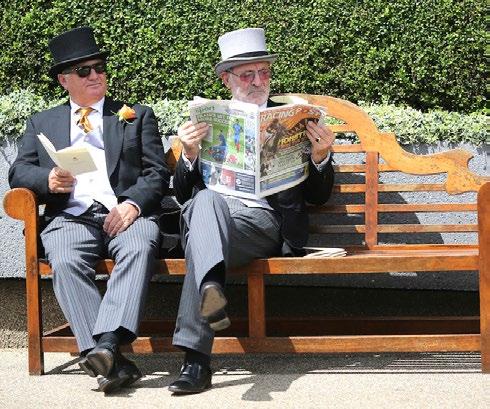


POLO. Ancient Persia and Georgia (isindi) also practiced such sports, though the official rules were drafted in the XIX Britain.
ARCHERY. The first official archery tournament, Scorton Arrow was held in 1673.
BOXING. Men have been fighting each other since the ancient times, though the first official boxing match took place on January 6, 1681. Christopher Monk intiated it.
ROWING. The most popular rowing competition has been held between Cambridge and Oxford since 1829. The first competition was held on the Thames River in 1715. It was called Dogget’s Coat and Badge and is popular to this day.
111 VOYAGER 4/2016
SUMMER SPORT SEASON IS ASSOCIATED WITH FOOD, DRINKS AND FASHION: HATS IN ASCOT AND STRAWBERRIES AND CREAM IN WIMBLEDON.
BRITISH EDUCATION
MARIKA SHALIKASHVILI
A British education is believed to provide a solid foundation for the future, guaranteeing employment and career development. British diplomas and degrees are especially prestigious. This status is due to the distinguished professors, modern teaching methods and constant innovation-oriented educational institutions, furnished with advanced equipment.

The British education system underwent a gradual, multi-century transformation to earn this reputation. Henry VI established Henry VI Kynge's College of Our Ladye of Eton besyde Windesore in an era when the so-called lower classes generally sent their children to work instead of providing them with an education. This is how the Eton College was founded.
Eton has been offering 70 boys – the King's Scholars -- a free education since 1440. These students are then able to continue their education at King’s College, Cambridge. Henry VI endowed the college with substantial land holdings and church rarities. He even persuaded the Pope to grant Eton the incredible privilege of granting indulgences; this right was terminated after the ascension of Edward IV.
Joseph Lancaster opened a free school in 1798; here, upper-class students tutored working-class children. In 1833, the state officially charged the church and charitable institutions with this
mission. In 1891, education became free of charge. The Education Act of 1902 declared that the state would provide primary education.
In the 19th century, the practice of hiring a governesses or tutor became prominent. The rich entrusted them to bring up their children. The stereotypical Victorian English governess was a stern, middle-aged woman dressed in dark clothes, who was exceptionally tough and demanding; later she was replaced by a Mary Poppins-style magical caregiver. This magical nanny was a reference to a transition to a new era. This new governess was a young, tastefully dressed lady who used sorcery and violated strict framework. Mary Poppins used humane methods, and did not practise subordination.
The university education model was established in the UK. Oxford and Cambridge Universities have been occupying the top positions for the last eight centuries.
EDUCATION
112 VOYAGER 4/2016
Eton school is located in Berkshire, in the vicinity of Windsor Palace, with 1,300 13- to 18-year-olds attending. Eton is one of the UK”S four best-known r boys’ schools (the others being Harrow, Radley, and Winchester). Eton education costs on average £32,000 per year. It is called the British business card, and has been the school of choice for the royal family and aristocracy for centuries.
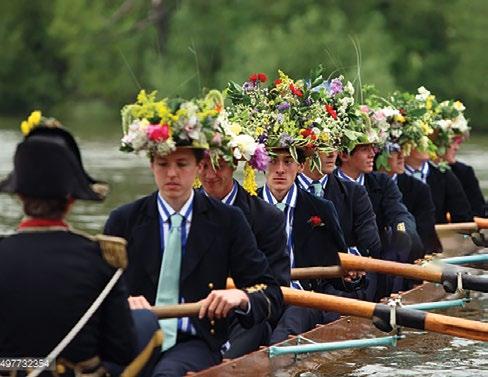
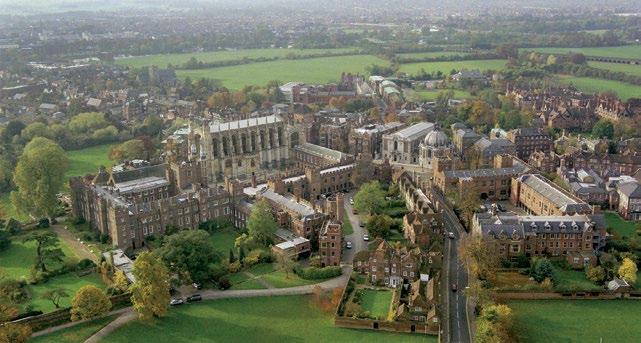
Compulsory Education
Education is compulsory in the UK for children aged 5 to 16. After high school, they can continue their studies or start working. England, Wales and Scotland have different education systems that are guided by a common general model. The British education system features public and private institutions. Enrollment begins at 7 years of age.
Preparing for University
The following is necessary to enroll at a UK University: a high school diploma, and for foreigners, International English Language Test scores such as TOEFL, IELTS, or alternatively a one-year English language learning program (the Foundation).
Bachelor’s and Master’s Degree
More than 180 universities grant Bachelor's and Master's degree in the UK. Undergraduate programs last three years in England and Wales, and four in Scotland.
With the exception of architecture and medicine, which involve five-seven years of education, the Master's program lasts onetwo years.
While higher education is clearly costly in the UK, it has the advantage that undergraduate and graduate programs do not take four and two years, respectively (like in other countries), but rather three and one.
Until the 1960s, aristocratic graduates of Eton would often contact the principal when their sons were born, to reserve a place in advance. Attending this school meant becoming part of a prestigious circle of friends and acquaintances.

Princes William and Harry represent the royal family at Eton. Nineteen British prime ministers have graduated from Eton. The college brought up world-renowned politicians, diplomats, scholars and artists. The British often joke that the Etonians recognize each other on sight. The latest age to start preparing for Eton enrollment is seven. Five difficult entry tests are mandatory for enrollment. Places are limited, with Eton allowing a maximum of 22 students per class.
Twenty-five dormitories provide an individual room for every student. All students have a personal tutor. Eton has a mandatory dress code, and the clothes cost £300. Students’ anonymity is protected: Etonians address each other by the first name, while the last name is kept secret. Eton has fairly strict rules, violation of which has resulted in different punishments in various centuries. Flogging used to be one, with Friday established as ‘flogging day’. This method of punishment was exchanged for warning letters in 1980. Expulsion remains an extreme form of punishment.
ETON
113 VOYAGER 4/2016
BRITISH ROYAL FAMILY EDUCATION
Queen Elizabeth II and her sister Margaret were the last members of the royal family to be tutored at home, according to the old traditions. Marion Crawford, their governess, was entrusted with their education.
As for Prince Charles, he initially attended Hill House School and then Cheam School. Then, at age 13, he was sent to Gordonstoun public school, and in 1970, he graduated from Trinity College, Cambridge. This was the first time in British history when a monarch or heir to the throne obtained a university degree. Prince Charles's eldest son and heir, Prince William, enrolled at Eton in 1995. He went on to graduate from the St. Andrews University in Scotland in 2005.
OXFORD
One of the world's most prestigious universities, Oxford is eight centuries old; it accepts exceptionally talented students with high academic performances. Oxford combines 44 colleges, which are independent, self-governing entities. It focuses on tutor-based, individual education. Last year, its undergraduate programs received 18,000 applications, and only 3,200 students were enrolled; the graduate program accepted only 5,200 of the 24,000 applicants.
Oxford offers students 250 combinations of undergraduate programs. The synthesis of political, economic and philosophical degrees is especially prestigious. Oxford is managed by a chancellor, who is elected for life.
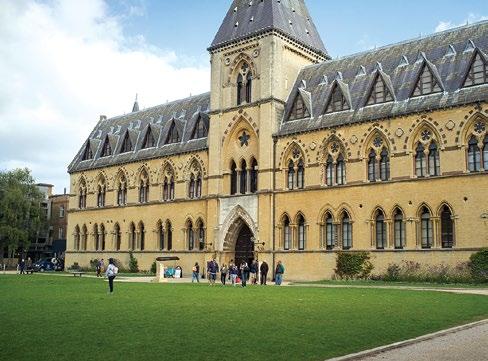
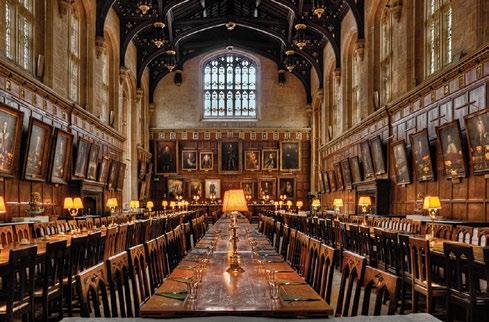
The university unites more than 100 libraries, including the renowned Bodleian, built in 1602. The Oxford Museum of History of Science proudly hosts Albert Einstein's blackboard.. More than 30 world leaders, 26 British prime ministers, 26 Nobel Prize winners, and more than 120 Olympic medalists have graduated from Oxford.
EDUCATION QUALITY
British universities are distinguished by the diversity of their schools and courses. British university graduate degrees are important for employers, as they imply not only theoretical, but also practical abilities.
Britain's best universities prioritize small groups of students in order to allow time for individual work with professors and to provide easy access to the requisite technical equipment
Four British universities are among the world's top eight. The reason is active communication with professors, freedom, creativity, and motivation, as well as leading libraries, science laboratories, art studios, theaters and sports centers.
Famous graduates include Indira Gandhi, Hugh Grant and Stephen Hawking. Ninety-five percent of the Oxford graduates start working upon graduation. Oxford came second in the 2016 world rankings.

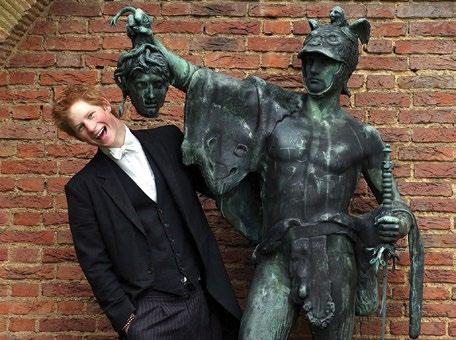
114 VOYAGER 4/2016
Like his brother, Prince Harry is an old Etonian. He does not hold a university degree, but attended a 10-month training at the Royal Military Academy Sandhurst.
EDUCATION
CAMBRIDGE
Cambridge is another of the UK’s oldest and most prestigious universities. Its history begins in 1209; it is the second-oldest university in the English-speaking world. Cambridge city is one hour away from London.

Legend has it that the university was founded by a team of learned men that had left Oxford as a result of an Oxford student killing a woman who resided in Cambridge. University regulations came into force in 1214; the rector governed the university, and the students took examinations at the end of the year.
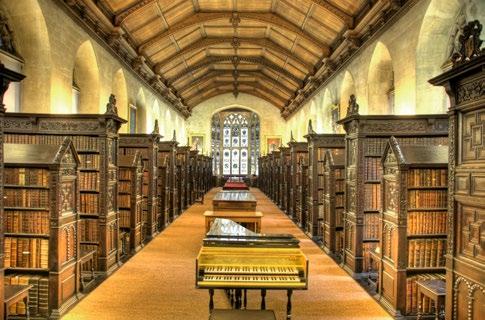
Eighteen thousand students and 9,000 staff live in Cambridge today.
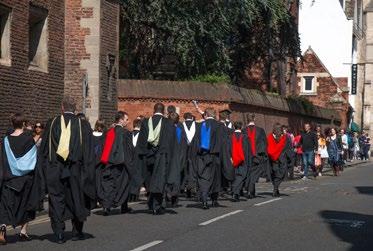
Cambridge University was built in the 13th century; it unites 31 colleges and more than 100 houses. Technical subjects are an exceptionally strong point of the university. Many well-known scientists have graduated from Cambridge, including 92 Nobel Prize winners. Cambridge, like Oxford, is known for its tutorial teaching method.
Tuition fees average £12,000-29,000, according to the selected school; students also donate £5,000 to charity and spend £8,000 on housing annually. The 2016 world rankings placed the university fourth.
BRITAIN'S BEST COLLEGES
THE HIGHER EDUCATION WORLD UNIVERSITY RANKINGS –2015-2016:
THE SURVEY PUTS OXFORD IN THE LEAD, WITH CAMBRIDGE IN SECOND PLACE, FOLLOWED BY IMPERIAL COLLEGE LONDON AND UNIVERSITY COLLEGE LONDON. THE LONDON SCHOOL OF ECONOMICS AND POLITICAL SCIENCE COMES IN FIFTH.
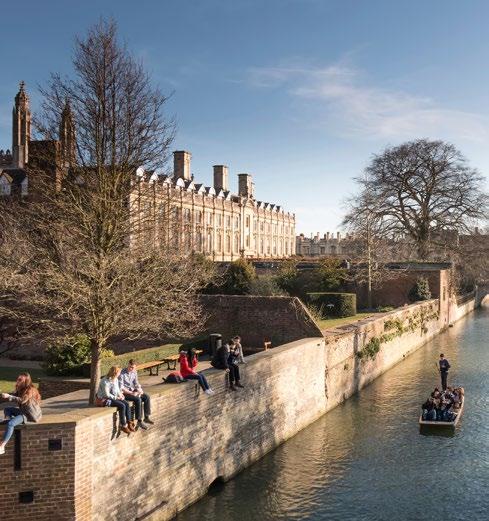
115 VOYAGER 4/2016
TO THE SEA

This is probably what you were missing.
AKA MORCHILADZE
The road through the forest, the hills, the grazing sheep that look like they will never be slaughtered; the rain that does not bother you or your car; the sun that emerges from the eternal clouds to warmly shine; the people along the road who see you heading to the place where every British person goes.
Towns and villages that look as if they’ve been painted by landscape artists, only seen from the roadside. Hares, churches, pop-up railway stations, fishermen returning from an unseen river bank, and seven-year-old girls wearing football or rugby tops of teams you don’t recognize.
AS ONE WRITER SAID, THE GREEN HEART OF OLD ENGLAND; WELL, PERHAPS MORE THE SOUTH OR SOUTH-EAST RATHER THAN THE ACTUAL HEART, BUT GREEN NONETHELESS. YOU CAN WALK UNTIL YOU FIND WHAT MAKES ENGLAND ENGLAND, AND DISCOVER WHAT IT HAS IN SUCH ABUNDANCE THAT FEW OTHERS HAVE
SEASIDE
116 VOYAGER 4/2016
Whichever way you travel from London, you will reach the shore. As Jose Arcadia Buendia once said, “The earth is like an orange, we are surrounded by water”. Ignorant of England and the Brit-ish Isles, he was right nevertheless.
The sea is everywhere. Many have tamed it, but none so much as the British, having beaten the Spaniards, the Dutch and the Portuguese. Others had the sea at their edges too but few had ever dreamt about travelling the world on it.
An old joke, probably coined about the British rather than by them, goes like this:
It was raining. An Englishman went into a pub but could not get dry. He drank a tasteless ale and ate a bland, salt-free meal: fish and chips. He stepped back out into the rain and went home to his ugly wife. She hung her husband’s wet clothes by the fireplace, with no hope of them ever drying; they then lay down but the Englishman did not touch his wife, who wasn’t particularly attracted to him either. They went to sleep wrapped in a wet blanket, together but separately, and when they woke up, it was raining again, even more desperately than the previous evening.
The Englishman’s wife offered him sugar-free oatmeal – the healthiest breakfast there is. He some-how managed to swallow several spoonfuls before he put on his hat and left in the rain without even saying good-bye to her. He arrived at the heart of the city, where stagecoaches stood, pur-chased a ticket and got onto a train bound for Southampton. There he joined a company of sailors, boarded a ship, and one rainy afternoon left on the ocean to find better food, better drink, a better wife and the sun…
However, we’re talking about approaching the sea far from London. We are not following the boats along the Thames but rather the uneven English roads, which, according to Chesterton, were built by some drunk long before the proud Romans approached the land.
The roads are more even today but it is fascinating knowing that all of them, east, south, or south-east, lead to the sea.
We have something similar in Georgia but the feeling is stronger on the island. Moreover, you know that the sea is not the border but instead the beginning of something new. We know that Southampton is on the south coast, an ancient city not tired by the water.
How many ships have sailed from there! The dreams dreamt on this shore! The cargoes unloaded here, the parrots transported… the place of old sailors, still known for its confusing streets.
Then there's Portsmouth, Southampton’s twin and eternal rival in rowing competitions. Havant is to the west, not as famous but with a beautiful shore. This area is all known as Hampshire.
Englishmen left to the sea from these places. They left for war, trade and adventure. Brighton is next – Brighton and Howe, joined to one another – completely different from the other coastlines with a softer shore and sunshine, more pampered, happy, and colorful.
Windy beaches, as if prepared for the vacation, with festivals and people laughing but still somber.
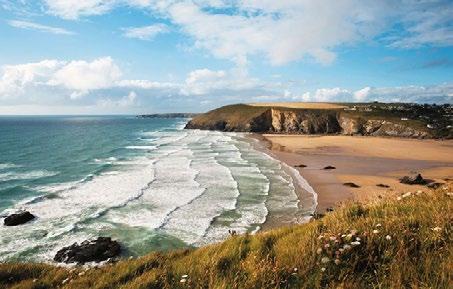
NO SIR, ENGLISH BEACHES WERE NOT CREATED FOR TANNING AND ENJOYING YOURSELF. OTHERS GOT PLENTY OF THOSE BEAUTIFUL BEACHES, NOT BRITAIN THOUGH…NO, BRITAIN GOT SOMETHING ELSE.
You can travel to the sea through Sussex or Kent. It’s a wonderful journey when you think about the countless others who have done the same. Britain is a coastline – Plymouth, Bristol, Liverpool and so on, with boys always ready to jump into the water.
Everything is different today of course; the seafaring way of life is over, and these cities, these places, these old bays and docks, the sun-withered docker hats and tanned, dried-up, tattooed men are no longer what they were.
However, they are still there and you realize that they have survived. Though their centuries-old craft may no longer exist, God has spared these men and places for a reason.
PERHAPS TO REMIND US OF THE CONNECTION BETWEEN THE ENGLISH SHORELINE AND THE SEA; TO REMIND US OF A DIFFICULT, TURBULENT, DANGEROUS HISTORY THAT TURNED OLD, FUN ANGLIA INTO THE QUEEN OF THE SEA. AND THEN, THE SEA APPEARS. YOU WILL SEE IT WITHOUT ENTERING THE TOWN. AND SINCE THIS IS ENGLAND, YOUR STORY WILL BEGIN HERE.
117 VOYAGER 4/2016
SCARBOROUGH
A new life began for a dormant fishing town of Scarborough on the North Sea coastline in XVIII century, when the British discovered mineral water treatments.
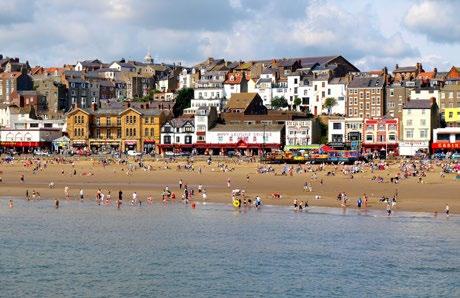
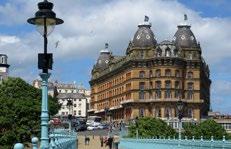

LIVERPOOL
Architecture is the best thing about Liverpool. With the exception of London, Liverpool has more architectural monuments than any other British city. Many of the buildings located in the center of Liverpool are unique. The world-renowned maritime merchant city was added to the UNESCO World Heritage List in 2004.
THE PORT
OF LIVERPOOL
The first spa was established in the XVIII century and became so popular that it soon could not sustain the number of visitors. Consequently, a huge stone spa building was erected at the foot of the rocky coast where two kinds of streams flowed, not far from the shore. Winter gardens and galleries made of glass and metal, and an original stone pool that filled with water during high tide, helped men and women (outfitted in striped swimsuits fitted all the way to their ankles) relax their bodies. The charm of the era is still present. The Victorian era gave Scarborough a new "Grand Hotel", which, at the time of construction, was the largest brick structure in Europe. This 365-suite hotel maintained its title as one of the largest hotels for a long time and upholds the distinctive traditions of a royal resort to this day.
Caring about ones health, and strolling along in the sea air was raised to the level of a cult in Victorian England. For this purpose, a number of walking routes were created in Scarborough, still preserved to this day. These routes will allow you to enjoy the views of the most beautiful rocky shoreline. You can also visit the 11th-century castle and a late-medieval tower.
If you get weary of the royal pathos, you can always walk around the fishing harbor. Here, life goes on as it was before the spa was built and the tourists appeared.
VISITORS AND LOCALS HAVE SHARED THE TWO GULFS OF SCARBOROUGH. IN THE FIRST GULF, THE TOURISTS ANHHHHHHHHHHHHHHHHD SURFERS PLAY IN THE OCEAN ALL YEAR ROUND, WHILE THE OTHER SMALL HARBOR HOSTS TINY YACHTS AND FISHING BOATS. EVEN TODAY, YOU CAN BUY FISH AND CHIPS WRAPPED IN GREASY PAPER AND WATCH THE GULLS WHILE SITTING ON THE HARBOR ROPE.
BUILDING is a symbol of the Liverpool coastline. A skyscraper built in 1911, it dominates the picturesque city skyline. Its purpose was to present Liverpool as the second city in the British Empire. Due to the scale of the central dome, it is compared to such buildings as St. Paul’s Cathedral in London and St. Peter's Basilica in the Vatican.
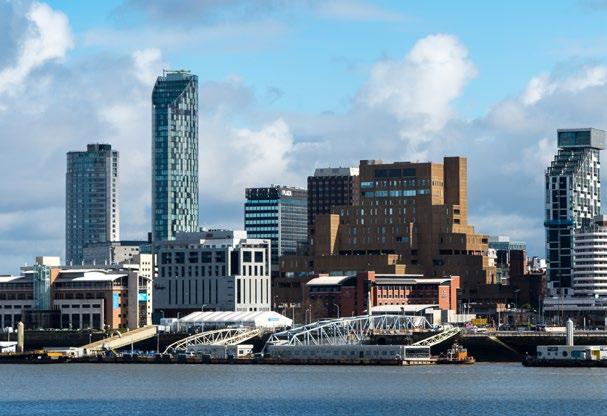
ROYAL LIVER _ is the first building of the famous architectural ensemble, the "Three Graces". The Liverpool birds (Liver Birds) sit atop the building. The face of the clock is directed towards the river. Its diameter is six feet larger than the diameter of Westminster clock tower.
ALBERT DOCK _ located in the Liverpool port, it is also part of the UNESCO World Heritage List. XIX-century ships are preserved in this part of Liverpool. Presently, you will find the Liverpool branch of the Tate Gallery Liverpool Maritime Museum, as well as plenty of restaurants, bars and shops.

The city has two large cathedrals
The Metropolitan Cathedral of Christ the King is an unusual example of religious architecture and rather modern. Is the city's main Catholic church, which due to its peculiar shape was named Paddy's Wigwam or the Pope's launching pad by the locals. The second, Liverpool Cathedral, is one of the best examples of neo-gothic architecture in the world.

118 VOYAGER 4/2016
Liverpool proudly preserves the memories of the ordinary boys who have become known the world over as music stars. The history of Beatlemania starts in the houses of John Lennon and Paul McCartney. They have become museums. New street signs are regularly put up on the walls of Penny Lane, so that fans from around the world have a chance to take home with them some "small debris" of the history. You can listen to new talent and enjoy wonderful beer in the legendary Cavern Club in the evenings.
THE BEATLES STORY
You can listen to a short but detailed story of "The Beatles" in the eponymous museum - The Beatles Story. It is located in the "Albert Dock" and is a must-see for fans of the band.


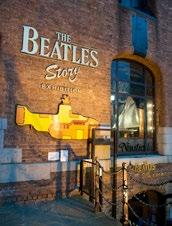
This audio tour will tell you the whole history of "The Beatles" as well as of the solo careers of the band members. The collection of memorial items creates a unique atmosphere. George Harrison's first guitar and John Lennon’s glasses are kept here. Other "Beatles" places of interest include their houses on Penny Lane, sculptural monuments, "Strawberry Fields" and so on.

The ticket price is £12.25 and a screening of a multimedia film - Pier Head – is included in the price.

BRISTOL
A TRAIN JOURNEY FROM LONDON TO BRISTOL TAKES 1.5 HOURS.
For centuries, Bristol was the biggest port city in England. Thanks to its favorable location, Bristol played an important role in England’s trade relations with its colonies, as well as in its exploration of the American continent. The city has since established itself as a large center of science and industry.
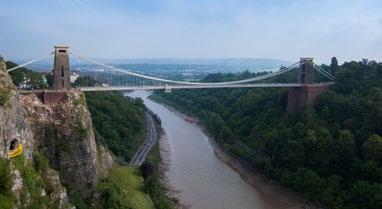
CLIFTON SUSPENSION BRIDGE a masterpiece of British engineering, opened in 1864, it is placed on every postcard with the view of the Bristol landscape, as it has become the city's calling card. The bridge offers a wonderful view of the valley, while the sprawling forest on its slopes is an ideal place for a walk.
SS GREAT BRITAIN SAILED ON THE WATER IN 1843 AND IS CONSIDERED ONE OF THE GREATEST ENGINEERING ACHIEVEMENTS OF THE 19TH CENTURY – IT WAS THE FIRST SHIP WITH A FULL METAL CASE TO CROSS THE ATLANTIC OCEAN. THE AUTHOR OF THE SHIP’S DESIGN IS THE INGENIOUS ISAMBARD KINGDOM BRUNEL. THE MUSEUM SHIP HAS A LONG AND HONORABLE HISTORY, WHICH YOU WILL BE ABLE TO WITNESS WHILE WALKING ABOARD. IF YOU TAKE CHILDREN WITH YOU, THEY WILL BE DELIGHTED TO ROAM THROUGH THE WHOLE SHIP, WHILE YOU WILL BE ABLE TO INSPECT THE SHIP’S HULL.
Parks Bristol is an exceptionally green city. You can find more than 400 parks, gardens and green zones there. Lawns are green even in the winter. You should also visit Ashton Court estate in Bristol City. Here you will see a palace and a huge park with strolling deer and roe.
A vast collection of rare trees and shrubs - a collection started in the Victorian era - is situated in the Westonbirt Arboretum dendrarium. Five different exhibitions present local plants as well as artifacts of exotic flora from around the world.
BRISTOL IS THE HOMETOWN OF THE FAMOUS STREET ARTIST, BANKSY. HIS EARLY WORKS CAN BE FOUND ON THE WALLS OF THE CITY. THE CITY HALL SUPPORTS DEVELOPMENT OF THIS SECTOR OF ART, ORGANIZING LARGE-SCALE STREET ART FESTIVALS, UPFEST BEING AMONG THEM.
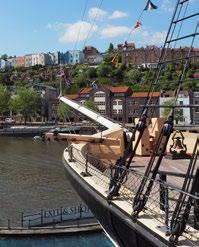
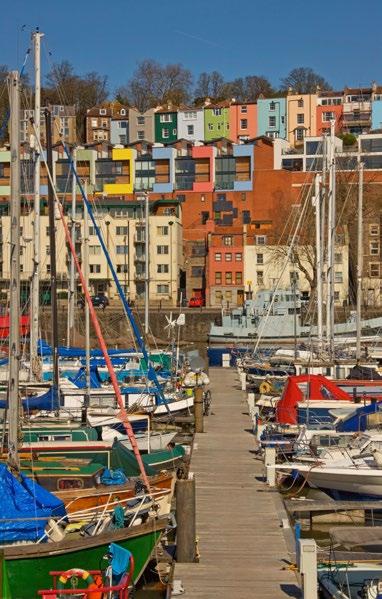

119 VOYAGER 4/2016 SCARBOROUGH / LIVERPOOL / BRISTOL
ბენქსი, გრაფიტი პარკ სთრითზე
SOUTHWEST ENGLAND COMPRISES SEVEN COUNTIES:
DORSET, DEVON, CORNWALL, BRISTOL, GLOUCESTERSHIRE, SOMERSET AND WILTSHIRE. EACH HAS A UNIQUE HISTORY AND ATMOSPHERE.
Visiting Bath is like travelling from ancient times to the present day. This magnificent ancient Roman resort town is remarkable for its spas. It is the homeland of Jane Austen, the first lady of English literature. The city is very easy to reach by train from London, with the journey taking just an hour and a half.
The XVIII-century architecture shapes the appearance of the present-day city streets. Visit buildings that exude a truly European dignity on the city's main street. Also, make sure to visit the Abbey of Bath.
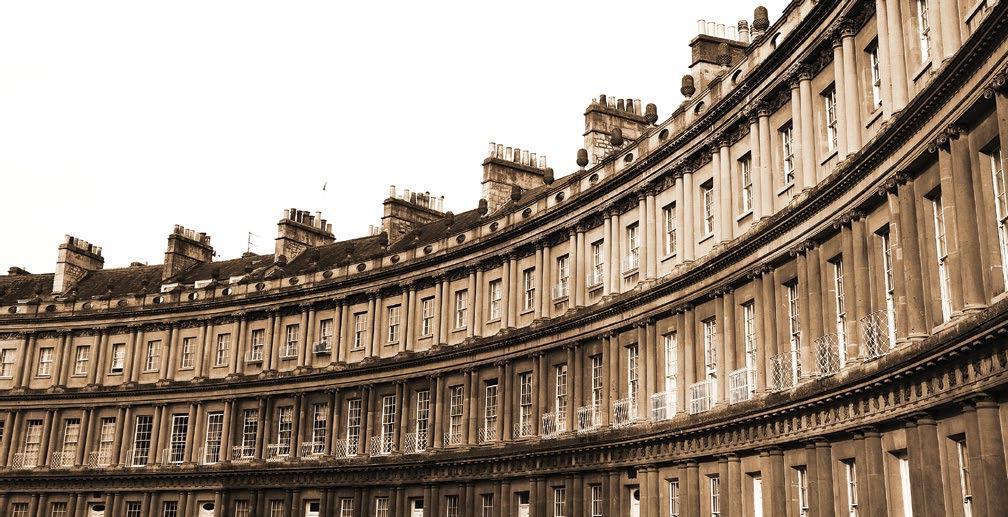
ROYAL CRESCENT
Take a walk to the magnificent Royal Crescent Street and the Circus located on the unique square. The buildings are laid out in a curved formation. House number 1 is a typical Georgian-style building.
Here you can feel the lifestyle of that period, view the excellent interior, furniture, paintings, fabrics, china, and carpets. The buildings were constructed using light-colored stones.
THERMAE BATH SPA
This medical complex was built on the site of the original Roman baths. It is open to visitors who wish to experience a Roman bath. The water in each of the four pools is kept at a constant 33.5 degrees Celsius, and the pool is 1.35 meters deep. The thermal waters contain more than 40 mineral substances, including chlorine and calcium salts. Be sure to visit the spa roof: here you can enjoy the pool and a view of the entire city.
Hetling
NEW ROYAL BATH
The New Royal Bath Spa center houses a swimming pool with Minerva Jacuzzi, a massage shower, a treatment room and relaxation rooms.
The waterfall shower begins with light droplets, which soon turn into something resembling a tropical downpour. The incredibly beautiful outdoor pool is located at the top of the resort complex.
Sessions cost £27 for two hours or £37 for four.
THE ROMAN BATHS
The mineral-rich waters fascinated the Romans 2,000 years ago; they built a temple to the goddess Minerva and a bath complex here. Later, Bath became an extremely popular resort for British royalty and high society.
Actors perform historical tales at the Roman Baths. You can enjoy the natural spring water by the bath entrance, where you will also find a souvenir store.
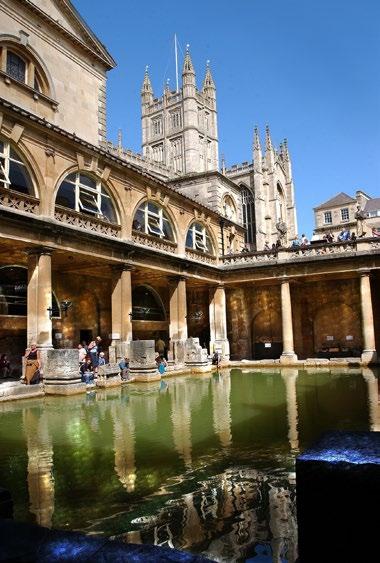
The warm water is said to be good for the health.
TOUR FEES:
Adults – £12.75; Children – £8.50. Admission is free for children under 6 years.
120 VOYAGER 4/2016
Pump Room, Hot Bath St, Bath
1. Royal Crescent
2. The Roman Baths Museum
3. Hotel Macdonald Bath Spa
4. Bath Abbey
5. Park Parade Gardens
6. The view of the city
BATH 1 2
7. The Pump Room Restaurant
MACDONALD BATH SPA HOTEL
This is widely considered to be the city's best spa, and boasts a hydrotherapy pool (free for hotel guests).
This luxurious hotel complex is part of the Macdonald Hotel & Resorts group. Built in 1835, it was for many years the residence of General Andrews, before becoming a boys' college. The building was transformed into a prestigious hotel in 1912.
Built in the classical style of an old palace, it stands amidst a garden adorned with beautiful fountains and springs. Its elegant interior creates the atmosphere of a traditional British estate. The hotel is famous for its exquisite fitness center.
The Macdonald Bath Spa Hotel is widely recognized as the best spa-hotel in the UK.

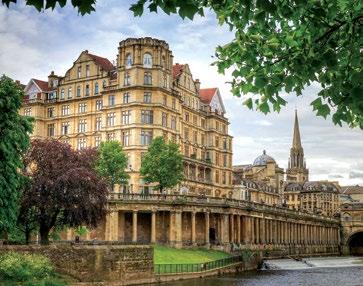
Double rooms start at £270 per night.
Sydney Rd, Bath
THE ROYAL CRESCENT HOTEL & THE BATH HOUSE SPA
This XVIII-century building boasts an impressive chic and splendor. The suites are especially exquisite. Each is named after an historic personality; their design is wonderful, featuring historical paintings, elaborate fireplaces, carpets, and a canopy bed.
The hotel spa center offers a wide range of holistic programs designed to help achieve harmony of body and soul.
The Bath House Treatment is an exclusive program that includes a sauna and steam room, wooden basin, sea-salt peeling and relaxing massage with specially mixed oils.
Double rooms start at £208 per night (spa services included).
PUMP ROOM
Make sure to dine in the Roman Bath’s Pump Room restaurant to experience the Bath atmosphere. The restaurant is located in the room where water was pumped from thermal springs. People came here to drink the healing water. In later years, this building hosted balls and lavish parties.
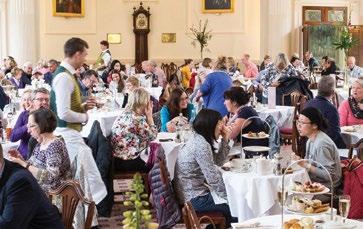
BATH ABBEY
You will notice Bath Abbey's Gothicstyle towers on a hill overlooking the city. The abbey was constructed in the middle ages using light-colored Bath stone.

The first King of England was consecrated in Bath Abbey. After visiting the complex, you may wish to ascend to the square to enjoy the panoramic views of the city; if you are lucky, you will be able to ring the bell.
PARADE GARDENS
This picturesque garden is perfectly manicured and decorated with sculptures. It offers wonderful views of the Pulteney Bridge. The Italian-style bridge was built in 1773 by Robert Adam (shops are located on it).
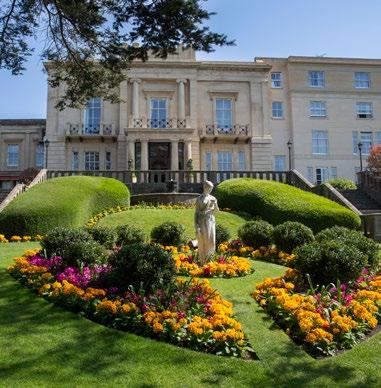
It is in the city center in a very impressive park.
MUSEUMS
Bath hosts 15 museums, including the Jane Austen Museum, designed in Georgian style, for admirers of the author of the famous novel Pride and Prejudice. The writer lived in Bath for several years.
The Fashion Museum exhibits the changes in styles from the XVI century to the present day.

121 VOYAGER 4/2016 BATH
7 3 4 5 6
Abbey Chambers, Church St, Avon, Bath
CAMBRIDGE
Cambridge embodies English ideals. It’s the home of one of the country’s most prestigious universities. Cambridge’s incredible architectural grandeur will impress even the most experienced visitors.
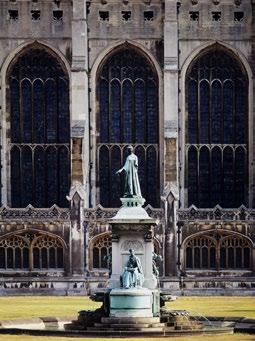

The city attracts 3.5 million curious people annually. Due to its popularity, thirty settlements worldwide carry the same name.
THE CITY'S HEART, OF COURSE, IS CAMBRIDGE UNIVERSITY. CAMBRIDGE HAS SET THE STANDARD FOR HIGH-QUALITY EDUCATION FOR EIGHT CENTURIES.
Cambridge’s idyllic atmosphere sets a quiet holiday mood – riding in Venetian gondola-like boats on the River Cam, walking in the beautiful Botanical Garden, getting to know history in the halls of the local museums…

Numerous cafes, pubs and a restaurants, cozy teahouses, Michelin-starred restaurants, modern gastropubs and small, cozy student cafés will satisfy visitors of all tastes.
Cambridgeshire’s wetlands provide a popular place for relaxing near the water.
CAMBRIDGE IS 90 KILOMETERS FROM LONDON AND IT TAKES ONLY AN HOUR TO TRAVEL BY TRAIN.
MIDSUMMER HOUSE
This restaurant has two Michelin stars and is one of the best in the Cambridge area.Midsummer House offers an excellent menu and a hall for private lunches. In addition, it boasts an amazing river view. The restaurant seats only 55 diners, so I recommend booking a table in advance.
Midsummer Common, Cambridge

ELY CATHEDRAL
The cathedral is the main attraction of the small town of Ely, which is located in the vicinity of Cambridge. It combines Romanesque and Gothic styles elements. Its construction began in 1083 but it has attained different shapes over the centuries.
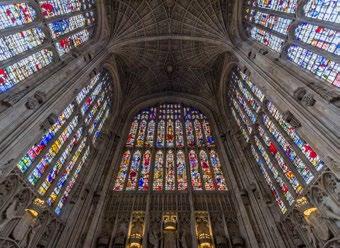

122 VOYAGER 4/2016
Trinity College
Chappel of Kings College
THE COLLEGES ALONG THE RIVER CAM APPEARED IN CAMBRIDGESHIRE COUNTY IN THE XIII CENTURY. THE FIRST OF THE COLLEGE STUDENTS AND PROFESSORS WERE A GROUP OF MEN WHO HAD BEEN DISMISSED FROM OXFORD UNIVERSITY. AFTER SEVERAL CENTURIES, THE SMALL TRADE SETTLEMENT GRADUALLY BECAME ONE OF THE WORLD’S BEST UNIVERSITY CAMPUSES.
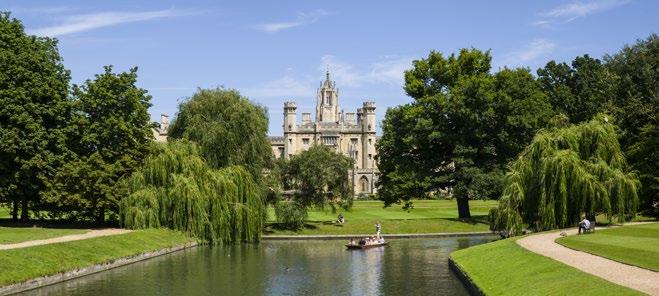
Cambridge is a symbol of British tradition and education. Among its graduates are Isaac Newton, Oliver Cromwell, King Edward VII, King George VI, Francis Bacon, Byron, Prince Charles, and many other notables.
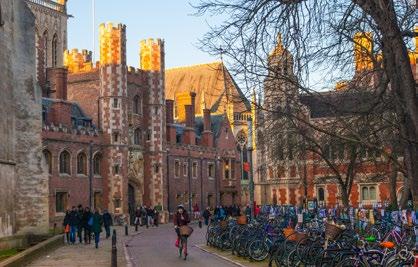
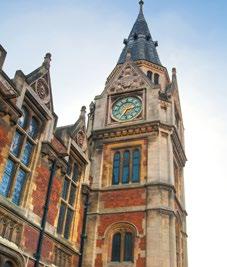
The university is comprised of several college buildings. The most famous of them is King’s College – a grand architectural ensemble built in the Gothic style and adorned with a multitude of towers and
ornamented gates. Its perpendicular Gothic chapel is the college’s focal point. Trinity College is located nearby.
King’s College was established by King Henry VI in 1414; his statue is erected in the courtyard. The perpendicular Gothic-style building was erected in the XV-XVI centuries. The college chapel is decorated with stained glass windows from the XVI century. You can see paintings by Rubens above the altar.
St John’s College is famous for its Bridge of Sighs, built with a different concept than its Venetian predecessor, the Bridge of Sighs, as an embodiment of student exam fears.
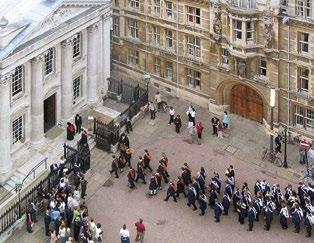
Queеns’ College was founded in the XV century. Erasmus of Rotterdam, a famous writer, linguist, and great Renaissance humanist, taught in the college. It is renowned
not only for its late-Gothic architecture but also for the so-called Mathematical Bridge, which was built without using a single nail.
The Church of the Holy Sepulchre, universally known as The Round Church, is a beautiful circular building in Cambridge and one of England's four oldest churches.
One of the most famous sights of Cambridge is the unusual "time absorber" clock on the corner of Corpus Christi College’s Taylor Library. A dragonfly is seated on a half-meter golden disc, which “eats” the seconds while winking at us, making an unpleasant, screeching sound in the process.
The university made considerable contributions to the development of English football: this is the very place where in 1848 the codification of the rules of the game took place, subsequently adopted by the Football Association.

The Fitzwilliam Museum hosts antiquities from Egypt, Greece and Eastern Asia. In 1816, the Viscount Fitzwilliam presented his personal collection to the university. You can see the works of great French Impressionists and a robust collection of XII-XX century western European art masterpieces. The museum also hosts examples of antique ceramic and glass works, as well as antique coins and medals.
The University Museum of Zoology is famous for its collection, which was started in 1814. There are many unique exhibits, given to the museum by Charles Darwin.
In the Whipple Museum of the History of Science, you can explore a unique collection of scientific instruments; the exhibits range from the medieval period to the present day.
The Museum of Classical Archeology hosts the largest collection of Greek and Roman sculptures in the world. This museum was called an "archeological laboratory" in the Victorian era.
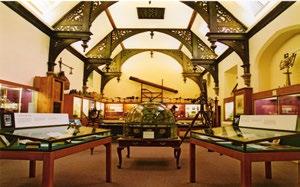
123 VOYAGER 4/2016 CAMBRIDGE
St. John's College
Pembroke College
THE CITY OF DREAMING SPIRES – THIS IS HOW THE POET MATTHEW ARNOLD DESCRIBED OXFORD DUE TO THE DISTINCTIVE ARCHITECTURE OF THE UNIVERSITY AND ITS OTHER BEAUTIFUL BUILDINGS.
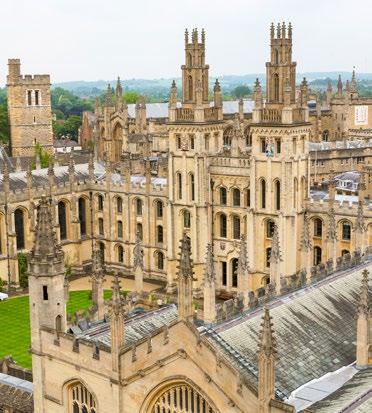

OXFORD (OXENFORDA)
MEANS THE RIVER CROSSING OVER THAMES, WHICH WAS USED FOR CENTURIES TO TRANSPORT OXEN.
THIS ANCIENT CITY IS LOCATED IN COUNTY OXFORDSHIRE; IT’S AN IMPORTANT HUB FOR EDUCATION AND A DISTINCTIVE CULTURAL CENTER.
THE UNIVERSITY OFFERS MANY INTERESTING ATTRACTIONS AS WELL AS THE HEART OF BRITISH EDUCATION.
Oxford is much older than the university. The "city" stands for the non-intellectual population of Oxford, while the "mantle" refers to the university professors, students and every person who has anything to do with the university (a long mantle was inconvenient for physical labor and therefore those one who wore it stood apart from the "manual labor" class).

YOU CAN COMBINE YOUR VISIT TO OXFORD WITH A TRIP TO THE COTSWOLDS OR A JOURNEY TO THE DORMANT FORESTS OF CHILTERN.
OXFORD IS ONLY AN HOUR AWAY FROM LONDON BY TRAIN.
There had been animosity between the city and the university from the beginning. One of prime example of this took place on February 10, 1354, on St. Scholastica of Nursia’s day. Drunken students accused the owner of a pub (public house) of selling bad wine. City residents supported the merchant, resulting in a conflict. The bells of St. Mary's church called the city's dwellers who severely beat the students (63 of them to death) and dispersed to the university buildings.
For 500 years thereafter, the mayor and judges of the city have attended the festivities of St. Scholastica’s Day in honor of the students who died, and pay a symbolic tribute of 63 pennies to the university.
124 VOYAGER 4/2016
OXFORD
ASHMOLEAN
The Ashmolean Museum was founded in 1683. It’s the oldest house of art and archeology in the university. It houses Egyptian mummies, Greek and Roman classical sculptures, works by Raphael, Rembrandt, William Turner and Van Gogh, and the largest collection of Chinese art in the Western world. In 2009, 61 million pounds were spent restoring and expanding the museum, resulting in 39 new galleries. Admission is free.
Beaumont St, Oxford
OXFORD UNIVERSITY MUSEUM OF NATURAL HISTORY

35,000 samples of zoological and paleontological species are kept in the museum. The famous ‘great debates’ on Charles Darwin’s evolutionary theory were held here in 1860. This is the only museum where the soft tissue of dronte (the "Dodo Bird") is kept – make sure to look at the skeleton of an extinct dronte.
Parks Rd
საუნივერსიტეტო პარკი
The park is an oasis in the center of Oxford. The land where the garden is located belonged to Merton College. In 1850, it was acquired by the university and in 1864 a park was established for sports and recreational purposes.


During World War II, parts of the park were divided into 80 small plots, which was used by the locals to grow vegetables. Legend has it that this land saved the people from starvation. Such plots still exist in Oxford
OXFORD’S BODLEIAN LIBRARY IS THE OLDEST IN EUROPE AND ONE OF THE LARGEST IN THE WORLD AFTER THE BRITISH LIBRARY.
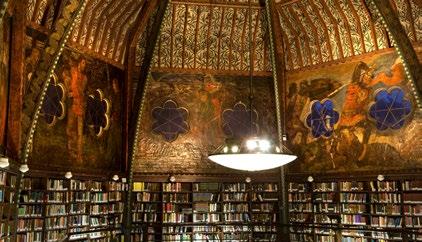
PITT RIVERS MUSEUM
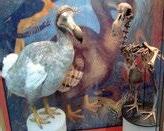
This museum presents exhibits of archeology and anthropology. Apart from ancient artefacts, the museum houses a history of science museum, which features tools from the past, including those used by Elizabeth I, Cardinal Wolsey and Nostradamus.
South Parks Road
THE OXFORD UNIVERSITY MUSEUMS, APART FROM THEIR CULTURAL FUNCTION, ACT AS SCIENTIFIC CENTERS AS WELL. 8.5 MILLION ARTEFACTS ARE KEPT IN THE CITY’S MUSEUM COLLECTION. UP TO 2 MILLION PEOPLE VISIT THE EXHIBITIONS ANNUALLY.
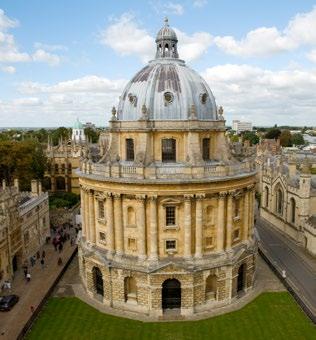
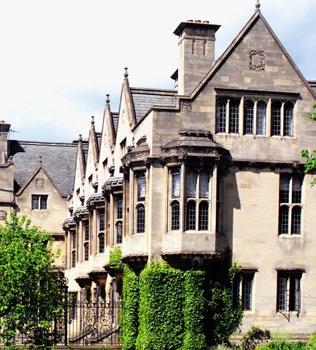
and are used by people who do not have a private yard or garden.
The University Park has a beautiful landscape and peaceful, quiet atmosphere.
PORT MEADOW
An enormous green field near the bay is the largest open area in Oxford. Here you will see freely roaming horses, cattle and geese.
The land at Port Meadow has never been plowed or sown as it has been a pasture from the earliest times; currently it belongs to the city and the locals still use it as a pasture. Parents often buy horses for children as a gift, than pay the city council a fee so that the animal can graze on the field.
125 VOYAGER 4/2016 OXFORD BY MAIA SHARASHIDZE
THIS IS THE BIRD THAT COMES TO LIFE AS THE “DODO” IN “ALICE IN WONDERLAND”.
Merton College
Radcliffe Camera and All Souls College
Christ Church College in Oxford
ASHMOLEAN DINING ROOM
The most popular and comfortable location for an afternoon tea or lunch is the Ashmolean Dining Room - located on the roof of the university’s museum of art and archeology.
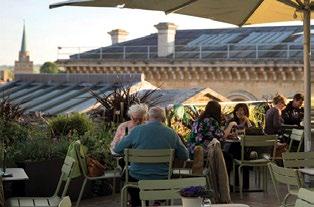
OLD PARSONAGE HOTEL
This hotel features a wonderful and exquisite restaurant, with a diverse selection of dishes. Here you will be able to try conservative English cuisine as well as the most distinctive modern culinary masterpieces and desserts. If you decide to dine here, you will have the chance to see the very hotel where Oscar Wilde used to stay.


1 Banbury Rd, Oxford
BELMOND LE MANOIR AUX QUAT'SAISONS

This restaurant was opened by the renowned chef, Sir Raymond Blanc, a knight of the British Empire. An expensive and highclass restaurant, it is located on the outskirts of Oxford, in a hotel in the picturesque village of Great Milton. Its two Michelin stars are well-earned, thanks to the "brilliant wonders" of Blanc’s cuisine.

High quality ingredients from the restaurant’s own grounds are transformed into specialty meat roulette, mushroom pie, lamb stew and chorizo. Some 60% of its rich wine cellar are French wines.
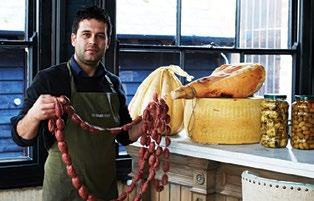
You can enjoy the best views and diverse cuisine and choose from a lavish collection of European wines.
Ashmolean Museum, Beaumont St, Oxford
GEE’S
This restaurant has not lost its reputation as the best in Oxford, which it has held since 1980. You will find the best orangery here, as well as unique and delicious cuisine. Mediterranean dishes are made in the woodfired stove. You can visit Gee's for a morning coffee as well as plan a celebration dinner. The restaurant also offers midday dinner at a fixed price, with weekly menu changes. There is a wonderful wine selection, and they make excellent cocktails at the bar.
61 Banbury Rd, Oxford
THE EAGLE AND CHILD
This old pub was established in 1684. Members of the literary circle "Inklings" used to gather by its fireplace in 1939-62. The meetings were inspired by the author of "The Lord of the Rings" J. R. R. Tolkien. Here, they read excerpts from his works, which would become classics of the fantasy genre.
The pub has an unusual and cozy atmosphere, delicious beer and a choice of traditional dishes. It is owned by St John's College.
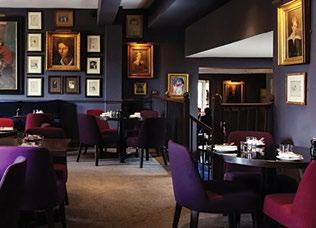
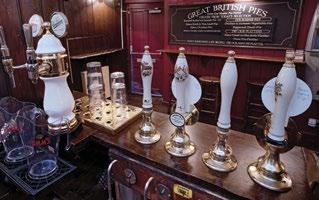
9 St Giles, Oxford
VARSITY CLUB
Currently The Varsity Club is the most prestigious place in Oxford, as it offers a wonderful view from the roof of its fourth floor all year round. You must book a table in advance at the club. You can also enjoy a delicious dinner and champagne on the roof.
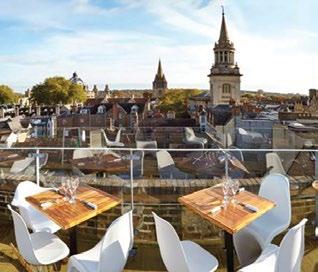
They make the best cocktails in the bar, on the third floor, and you can enjoy dancing on the first floor.
9 High St, Oxford
PIERRE VICTOIRE
The best French bistro in Oxford is always full of guests. Try the chicken liver, seafood braised in wine, Savoy fondue, honey roast duck, crème brûlée, chocolate fondue, and its many other delights.
9 Little Clarendon St, Oxford
126 VOYAGER 4/2016 OXFORD
Church Rd, Oxford






SHELDONIAN THEATRE
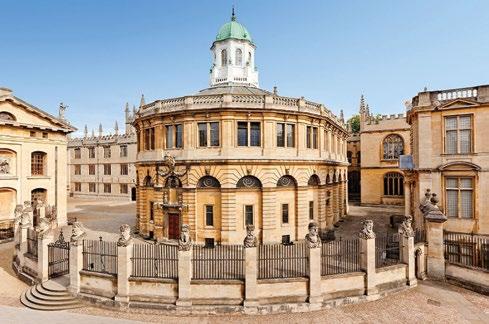
The Sheldonian Theatre (1664-69) was the first structure built in the classical style in Oxford. Its author was the famous English architect Christopher Wren. The theater is located on the university grounds and it is used for graduation ceremonies, lectures, performances, etc. The Sheldonian Theatre also hosts regular classical and contemporary music concerts.
Broad St, Oxford
PHOENIX PICTUREHOUSE
This cinema, which opened in 1913, still boasts the best repertoire; a heated discussion always follows the film screenings, which are always attended by the university elite. Here you can attend screenings of unique and interesting films.
57 Walton St, Oxford
PRODUCTS AND DELICACIES
It is always important where you buy your products. Large supermarkets - Waitrose, Sainsbury, Tesco, Asda, M & S, Co-op – offer you expensive products of the highest quality. Exceptionally tasty meat, fish and delicacies are available in Waitrose. In general, it is considered poor form to bring supermarket products as a present when visiting someone; products bought at Waitrose are the only exception.
Upper and middle-class Englishfolk pay a lot of attention to where others shop for their products and often note what store bags others are carrying. M & S holds second place in terms of prices and quality; Tesco is relatively cheap compared to the two above but carries products of good quality.
You can buy good products at the best price at farmers' markets. Such markets are very popular in the UK and are held on certain days in almost every city. Here, farmers sell their products to the public.
BLACKWELLS
Blackwell’s is the oldest book shop in the center of Oxford, located in the oldest building on Broad Street. It was founded by Benjamin Blackwell in 1879. The shop still belongs to his family.
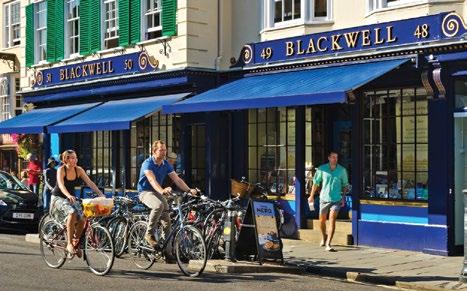
The area of this establishment increased significantly when a tunnel was dug to connect the shop to the Bodleian Library situated next to it. Here you will find the best café for tea and coffee. Oxfordians often arrange to meet their friends in this book oasis.
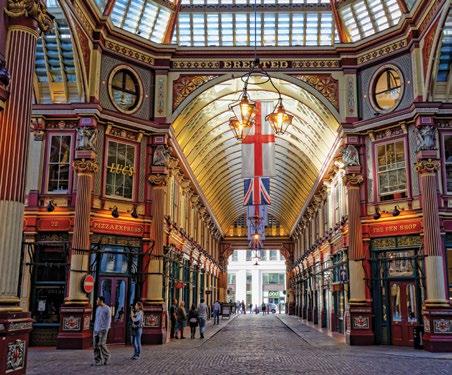
51 Broad St, Oxford
COVERED MARKET
This is an old market located in the center of Oxford, which is full of small shops. Here, everything is of the highest quality. Exceptionally tasty among Oxford’s delicacies are Frank Cooper's Marmalade, Stilton blue and white cheese, and sundried tomatoes. If you like organic products, than direct your attention to the products of Prince Charles's organic food brand Duchy Originals, founded in 1990.
PAYNE AND SON
This is an old silverware shop; it is a must-go for gifts. It still belongs to the family of the original founder. During Christian baptisms, the child receives a small silver spoon, silver cup or silver egg holder, or a silver handkerchief ring with their initials engraved.
A perfect gift would be a silver bookmark with an Oxford illustration. Here you can also buy a silver pen with one’s initials engraved, a wine decanter, a silver bottle stop, etc. Silver, in general, is considered a very good gift.
128 VOYAGER 4/2016 OXFORD
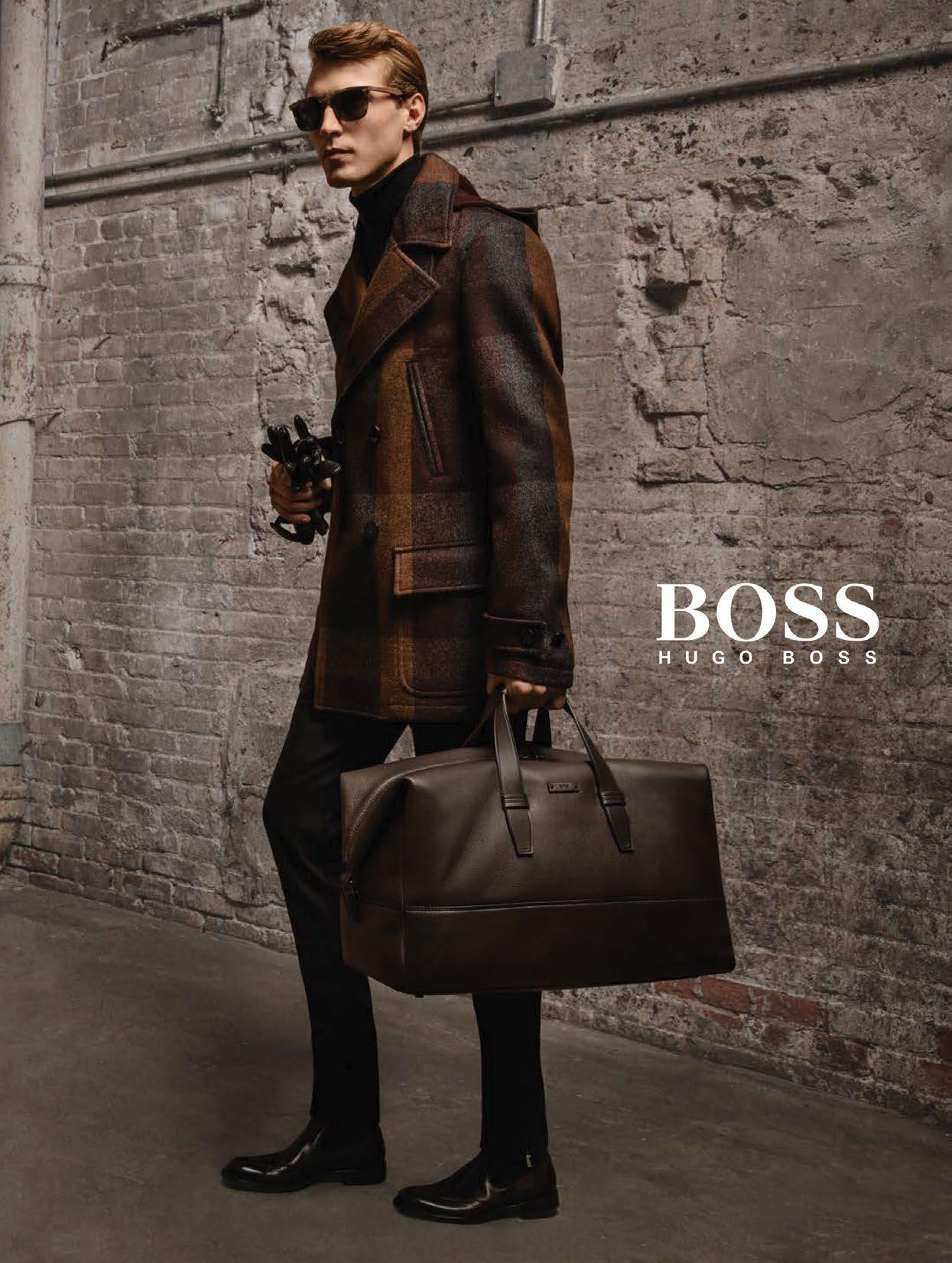



































































































































































































 SALOME DADUNASHVILI
SALOME DADUNASHVILI


























































 AnneHathaway'sCottage,Shottery,Warwickshire
1. "Architect's Dream", Thomas Cole
2. Strawberry Hill, 1747, Twickenham
3. William Shakespeare's wife, Anne Hathaway’s cottage
AnneHathaway'sCottage,Shottery,Warwickshire
1. "Architect's Dream", Thomas Cole
2. Strawberry Hill, 1747, Twickenham
3. William Shakespeare's wife, Anne Hathaway’s cottage

















 1. Aristotle Onassis
2. Maria Callas
3. Queen Elizabeth II
4. Son and Coco Chanel
5. Charlie Chaplin
1. Aristotle Onassis
2. Maria Callas
3. Queen Elizabeth II
4. Son and Coco Chanel
5. Charlie Chaplin

























































































































































































